
RESTATEMENT OF THE MOOG INC. RETIREMENT SAVINGS PLAN Restated Effective October 1, 2016
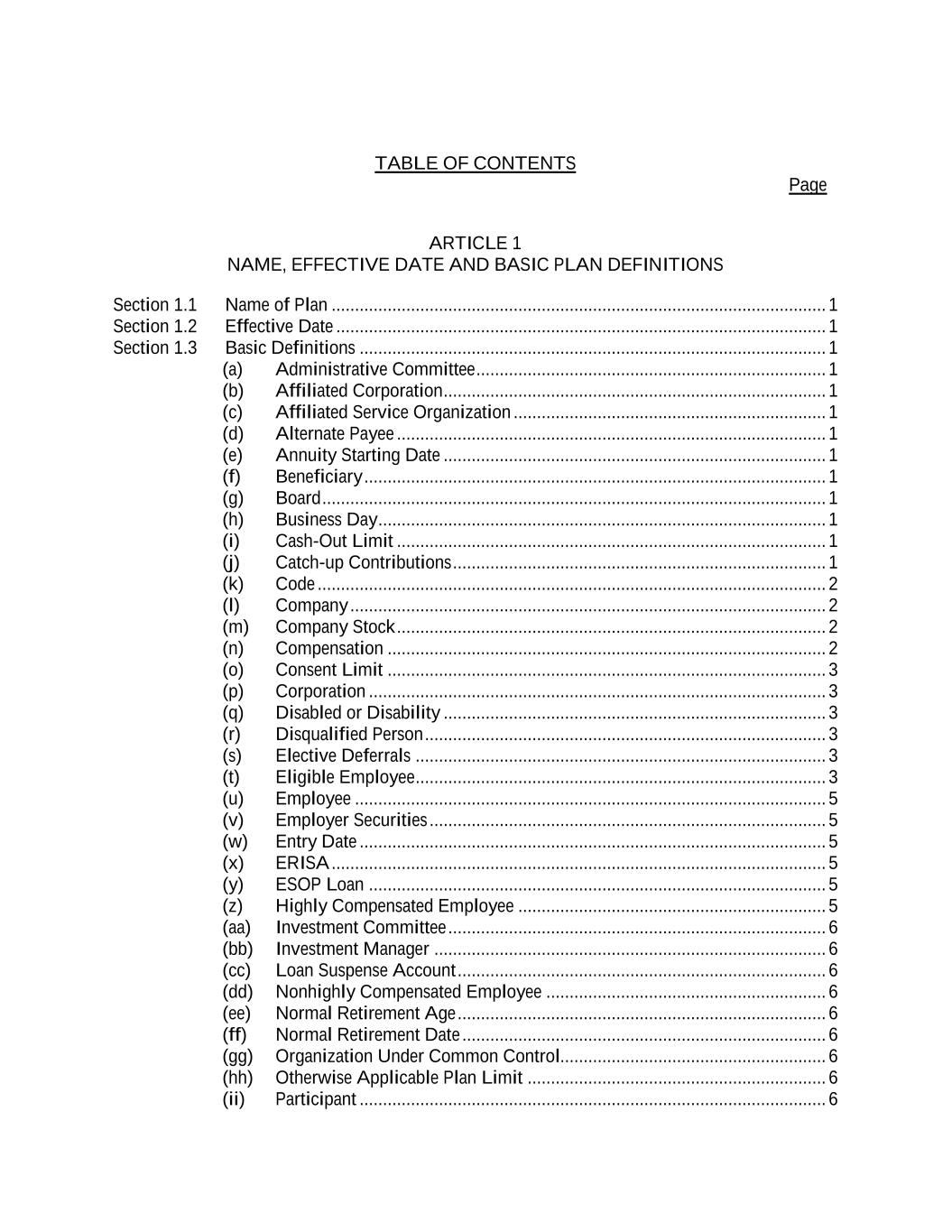
TABLE OF CONTENTS Page ARTICLE 1 NAME, EFFECTIVE DATE AND BASIC PLAN DEFINITIONS Section 1.1 Name of Plan .......................................................................................................... 1 Section 1.2 Effective Date ......................................................................................................... 1 Section 1.3 Basic Definitions .................................................................................................... 1 (a) Administrative Committee ........................................................................... 1 (b) Affiliated Corporation .................................................................................. 1 (c) Affiliated Service Organization ................................................................... 1 (d) Alternate Payee ............................................................................................ 1 (e) Annuity Starting Date .................................................................................. 1 (f) Beneficiary ................................................................................................... 1 (g) Board ............................................................................................................ 1 (h) Business Day ................................................................................................ 1 (i) Cash-Out Limit ............................................................................................ 1 (j) Catch-up Contributions ................................................................................ 1 (k) Code ............................................................................................................. 2 (l) Company ...................................................................................................... 2 (m) Company Stock ............................................................................................ 2 (n) Compensation .............................................................................................. 2 (o) Consent Limit .............................................................................................. 3 (p) Corporation .................................................................................................. 3 (q) Disabled or Disability .................................................................................. 3 (r) Disqualified Person ...................................................................................... 3 (s) Elective Deferrals ........................................................................................ 3 (t) Eligible Employee ........................................................................................ 3 (u) Employee ..................................................................................................... 5 (v) Employer Securities ..................................................................................... 5 (w) Entry Date .................................................................................................... 5 (x) ERISA .......................................................................................................... 5 (y) ESOP Loan .................................................................................................. 5 (z) Highly Compensated Employee .................................................................. 5 (aa) Investment Committee ................................................................................. 6 (bb) Investment Manager .................................................................................... 6 (cc) Loan Suspense Account ............................................................................... 6 (dd) Nonhighly Compensated Employee ............................................................ 6 (ee) Normal Retirement Age ............................................................................... 6 (ff) Normal Retirement Date .............................................................................. 6 (gg) Organization Under Common Control......................................................... 6 (hh) Otherwise Applicable Plan Limit ................................................................ 6 (ii) Participant .................................................................................................... 6
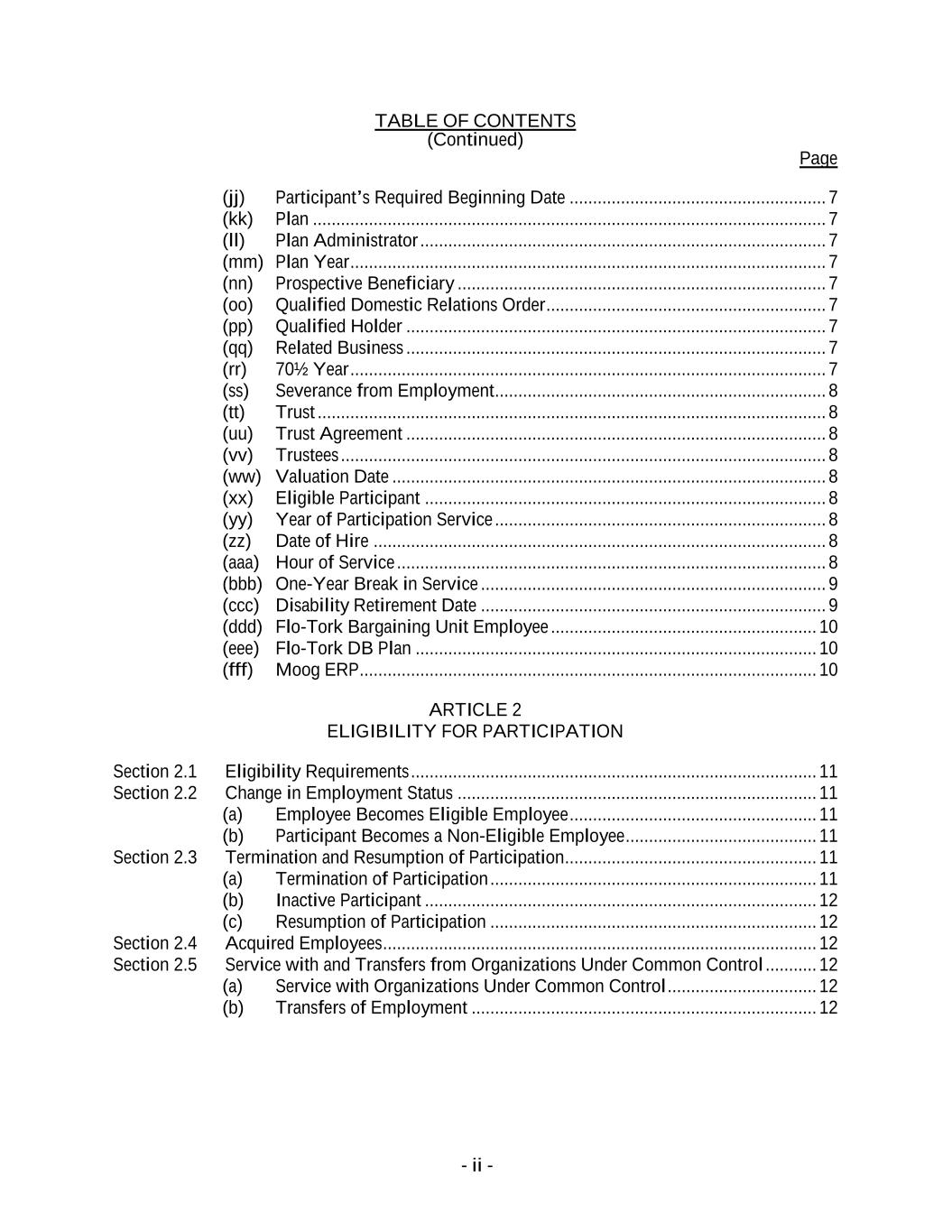
TABLE OF CONTENTS (Continued) Page (jj) Participant’s Required Beginning Date ....................................................... 7 (kk) Plan .............................................................................................................. 7 (ll) Plan Administrator ....................................................................................... 7 (mm) Plan Year ...................................................................................................... 7 (nn) Prospective Beneficiary ............................................................................... 7 (oo) Qualified Domestic Relations Order ............................................................ 7 (pp) Qualified Holder .......................................................................................... 7 (qq) Related Business .......................................................................................... 7 (rr) 70½ Year ...................................................................................................... 7 (ss) Severance from Employment ....................................................................... 8 (tt) Trust ............................................................................................................. 8 (uu) Trust Agreement .......................................................................................... 8 (vv) Trustees ........................................................................................................ 8 (ww) Valuation Date ............................................................................................. 8 (xx) Eligible Participant ...................................................................................... 8 (yy) Year of Participation Service ....................................................................... 8 (zz) Date of Hire ................................................................................................. 8 (aaa) Hour of Service ............................................................................................ 8 (bbb) One-Year Break in Service .......................................................................... 9 (ccc) Disability Retirement Date .......................................................................... 9 (ddd) Flo-Tork Bargaining Unit Employee ......................................................... 10 (eee) Flo-Tork DB Plan ...................................................................................... 10 (fff) Moog ERP .................................................................................................. 10 ARTICLE 2 ELIGIBILITY FOR PARTICIPATION Section 2.1 Eligibility Requirements ....................................................................................... 11 Section 2.2 Change in Employment Status ............................................................................. 11 (a) Employee Becomes Eligible Employee ..................................................... 11 (b) Participant Becomes a Non-Eligible Employee ......................................... 11 Section 2.3 Termination and Resumption of Participation ...................................................... 11 (a) Termination of Participation ...................................................................... 11 (b) Inactive Participant .................................................................................... 12 (c) Resumption of Participation ...................................................................... 12 Section 2.4 Acquired Employees ............................................................................................. 12 Section 2.5 Service with and Transfers from Organizations Under Common Control ........... 12 (a) Service with Organizations Under Common Control ................................ 12 (b) Transfers of Employment .......................................................................... 12 - ii -
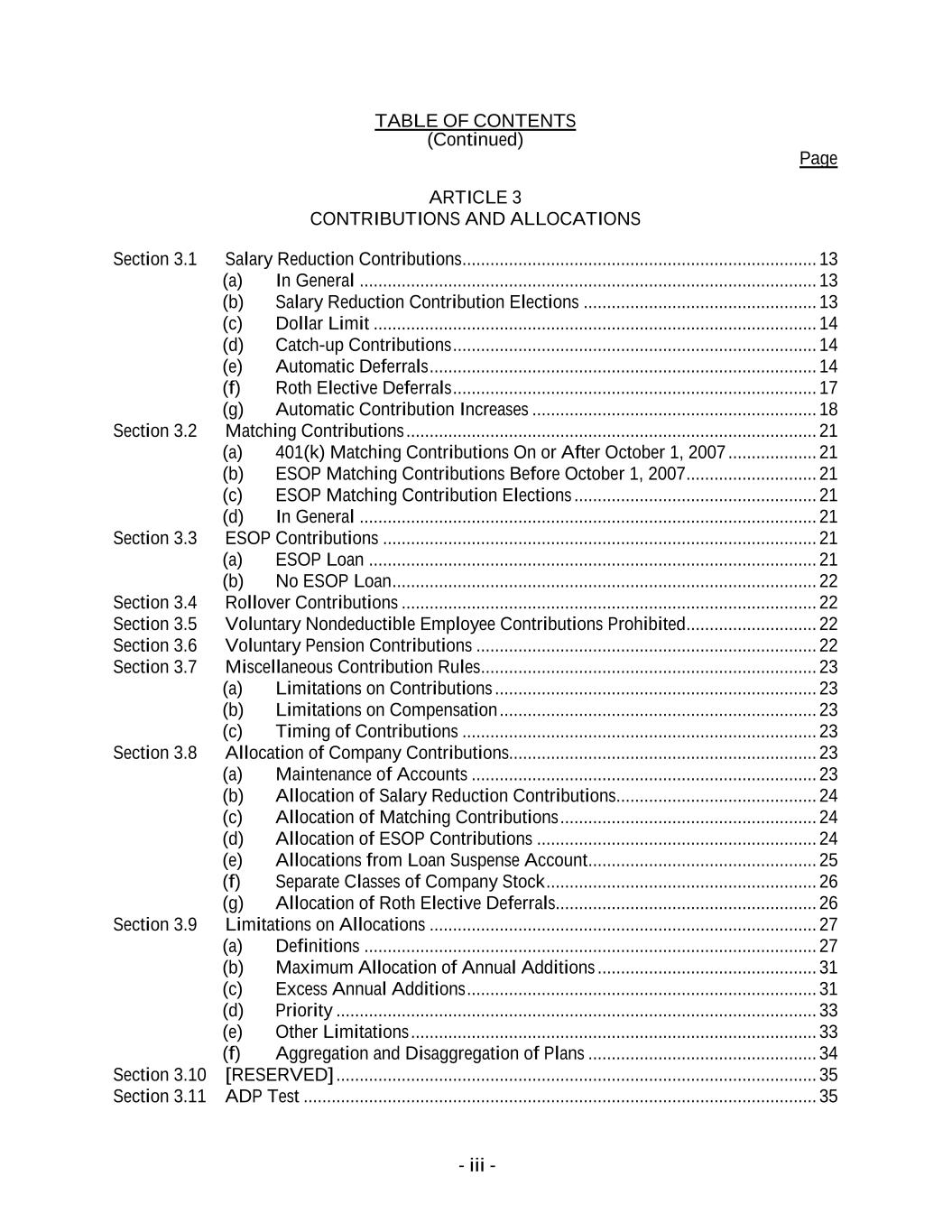
TABLE OF CONTENTS (Continued) Page ARTICLE 3 CONTRIBUTIONS AND ALLOCATIONS Section 3.1 Salary Reduction Contributions ............................................................................ 13 (a) In General .................................................................................................. 13 (b) Salary Reduction Contribution Elections .................................................. 13 (c) Dollar Limit ............................................................................................... 14 (d) Catch-up Contributions .............................................................................. 14 (e) Automatic Deferrals ................................................................................... 14 (f) Roth Elective Deferrals .............................................................................. 17 (g) Automatic Contribution Increases ............................................................. 18 Section 3.2 Matching Contributions ........................................................................................ 21 (a) 401(k) Matching Contributions On or After October 1, 2007 ................... 21 (b) ESOP Matching Contributions Before October 1, 2007 ............................ 21 (c) ESOP Matching Contribution Elections .................................................... 21 (d) In General .................................................................................................. 21 Section 3.3 ESOP Contributions ............................................................................................. 21 (a) ESOP Loan ................................................................................................ 21 (b) No ESOP Loan ........................................................................................... 22 Section 3.4 Rollover Contributions ......................................................................................... 22 Section 3.5 Voluntary Nondeductible Employee Contributions Prohibited ............................ 22 Section 3.6 Voluntary Pension Contributions ......................................................................... 22 Section 3.7 Miscellaneous Contribution Rules ........................................................................ 23 (a) Limitations on Contributions ..................................................................... 23 (b) Limitations on Compensation .................................................................... 23 (c) Timing of Contributions ............................................................................ 23 Section 3.8 Allocation of Company Contributions.................................................................. 23 (a) Maintenance of Accounts .......................................................................... 23 (b) Allocation of Salary Reduction Contributions ........................................... 24 (c) Allocation of Matching Contributions ....................................................... 24 (d) Allocation of ESOP Contributions ............................................................ 24 (e) Allocations from Loan Suspense Account ................................................. 25 (f) Separate Classes of Company Stock .......................................................... 26 (g) Allocation of Roth Elective Deferrals........................................................ 26 Section 3.9 Limitations on Allocations ................................................................................... 27 (a) Definitions ................................................................................................. 27 (b) Maximum Allocation of Annual Additions ............................................... 31 (c) Excess Annual Additions ........................................................................... 31 (d) Priority ....................................................................................................... 33 (e) Other Limitations ....................................................................................... 33 (f) Aggregation and Disaggregation of Plans ................................................. 34 Section 3.10 [RESERVED] ....................................................................................................... 35 Section 3.11 ADP Test .............................................................................................................. 35 - iii -
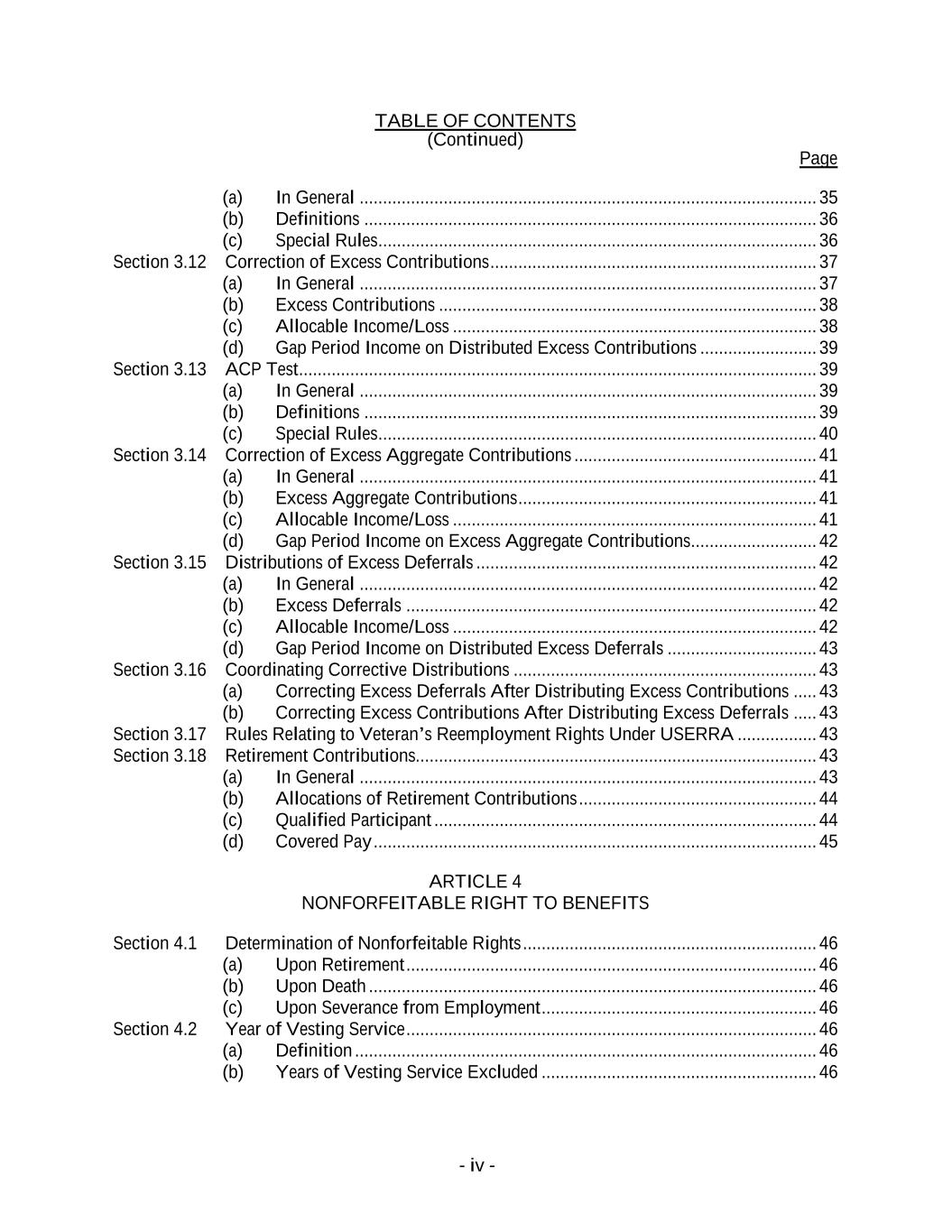
TABLE OF CONTENTS (Continued) Page (a) In General .................................................................................................. 35 (b) Definitions ................................................................................................. 36 (c) Special Rules .............................................................................................. 36 Section 3.12 Correction of Excess Contributions ...................................................................... 37 (a) In General .................................................................................................. 37 (b) Excess Contributions ................................................................................. 38 (c) Allocable Income/Loss .............................................................................. 38 (d) Gap Period Income on Distributed Excess Contributions ......................... 39 Section 3.13 ACP Test ............................................................................................................... 39 (a) In General .................................................................................................. 39 (b) Definitions ................................................................................................. 39 (c) Special Rules .............................................................................................. 40 Section 3.14 Correction of Excess Aggregate Contributions .................................................... 41 (a) In General .................................................................................................. 41 (b) Excess Aggregate Contributions ................................................................ 41 (c) Allocable Income/Loss .............................................................................. 41 (d) Gap Period Income on Excess Aggregate Contributions ........................... 42 Section 3.15 Distributions of Excess Deferrals ......................................................................... 42 (a) In General .................................................................................................. 42 (b) Excess Deferrals ........................................................................................ 42 (c) Allocable Income/Loss .............................................................................. 42 (d) Gap Period Income on Distributed Excess Deferrals ................................ 43 Section 3.16 Coordinating Corrective Distributions ................................................................. 43 (a) Correcting Excess Deferrals After Distributing Excess Contributions ..... 43 (b) Correcting Excess Contributions After Distributing Excess Deferrals ..... 43 Section 3.17 Rules Relating to Veteran’s Reemployment Rights Under USERRA ................. 43 Section 3.18 Retirement Contributions...................................................................................... 43 (a) In General .................................................................................................. 43 (b) Allocations of Retirement Contributions ................................................... 44 (c) Qualified Participant .................................................................................. 44 (d) Covered Pay ............................................................................................... 45 ARTICLE 4 NONFORFEITABLE RIGHT TO BENEFITS Section 4.1 Determination of Nonforfeitable Rights ............................................................... 46 (a) Upon Retirement ........................................................................................ 46 (b) Upon Death ................................................................................................ 46 (c) Upon Severance from Employment ........................................................... 46 Section 4.2 Year of Vesting Service ........................................................................................ 46 (a) Definition ................................................................................................... 46 (b) Years of Vesting Service Excluded ........................................................... 46 - iv -
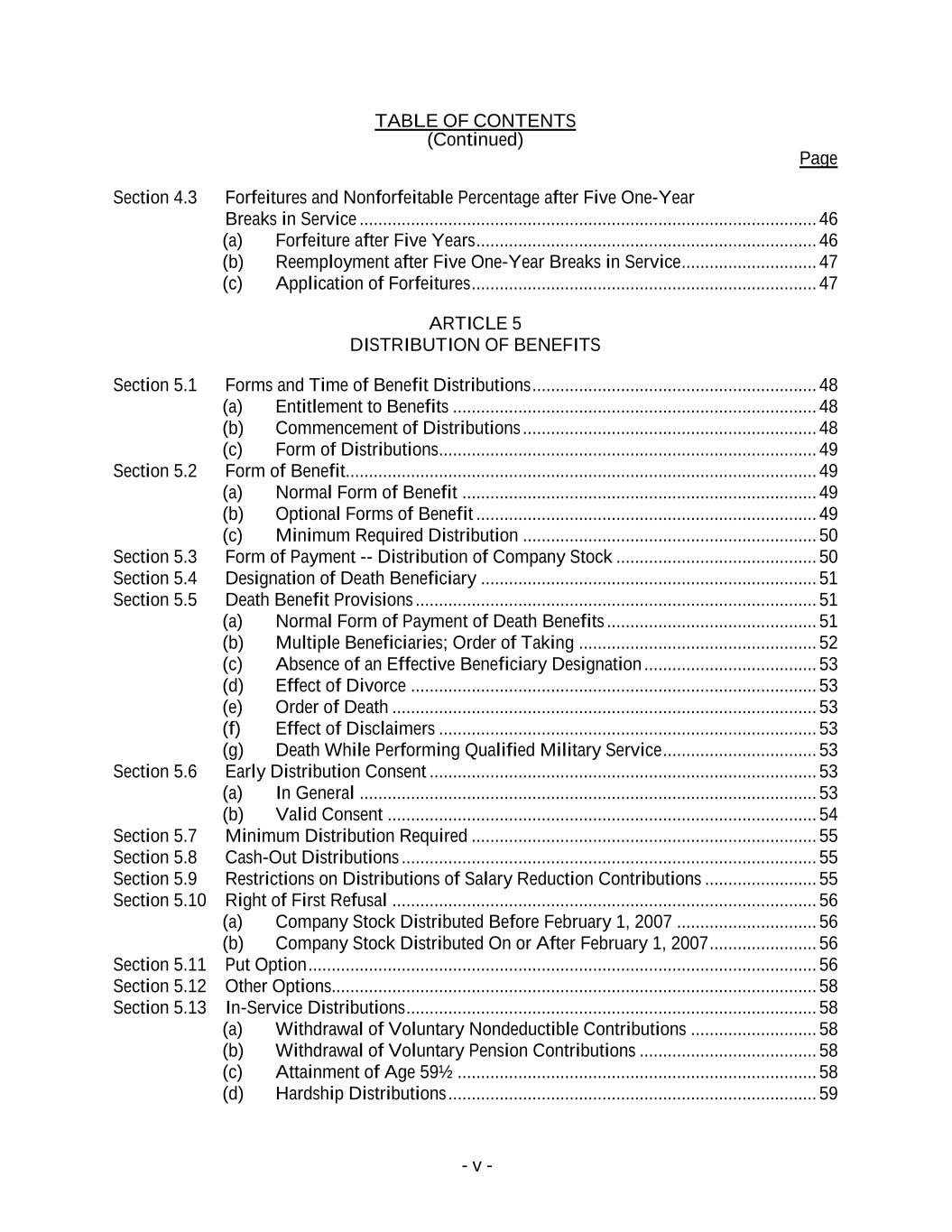
TABLE OF CONTENTS (Continued) Page Section 4.3 Forfeitures and Nonforfeitable Percentage after Five One-Year Breaks in Service .................................................................................................. 46 (a) Forfeiture after Five Years ......................................................................... 46 (b) Reemployment after Five One-Year Breaks in Service ............................. 47 (c) Application of Forfeitures .......................................................................... 47 ARTICLE 5 DISTRIBUTION OF BENEFITS Section 5.1 Forms and Time of Benefit Distributions ............................................................. 48 (a) Entitlement to Benefits .............................................................................. 48 (b) Commencement of Distributions ............................................................... 48 (c) Form of Distributions ................................................................................. 49 Section 5.2 Form of Benefit..................................................................................................... 49 (a) Normal Form of Benefit ............................................................................ 49 (b) Optional Forms of Benefit ......................................................................... 49 (c) Minimum Required Distribution ............................................................... 50 Section 5.3 Form of Payment -- Distribution of Company Stock ........................................... 50 Section 5.4 Designation of Death Beneficiary ........................................................................ 51 Section 5.5 Death Benefit Provisions ...................................................................................... 51 (a) Normal Form of Payment of Death Benefits ............................................. 51 (b) Multiple Beneficiaries; Order of Taking ................................................... 52 (c) Absence of an Effective Beneficiary Designation ..................................... 53 (d) Effect of Divorce ....................................................................................... 53 (e) Order of Death ........................................................................................... 53 (f) Effect of Disclaimers ................................................................................. 53 (g) Death While Performing Qualified Military Service ................................. 53 Section 5.6 Early Distribution Consent ................................................................................... 53 (a) In General .................................................................................................. 53 (b) Valid Consent ............................................................................................ 54 Section 5.7 Minimum Distribution Required .......................................................................... 55 Section 5.8 Cash-Out Distributions ......................................................................................... 55 Section 5.9 Restrictions on Distributions of Salary Reduction Contributions ........................ 55 Section 5.10 Right of First Refusal ........................................................................................... 56 (a) Company Stock Distributed Before February 1, 2007 .............................. 56 (b) Company Stock Distributed On or After February 1, 2007 ....................... 56 Section 5.11 Put Option ............................................................................................................. 56 Section 5.12 Other Options........................................................................................................ 58 Section 5.13 In-Service Distributions ........................................................................................ 58 (a) Withdrawal of Voluntary Nondeductible Contributions ........................... 58 (b) Withdrawal of Voluntary Pension Contributions ...................................... 58 (c) Attainment of Age 59½ ............................................................................. 58 (d) Hardship Distributions ............................................................................... 59 - v -
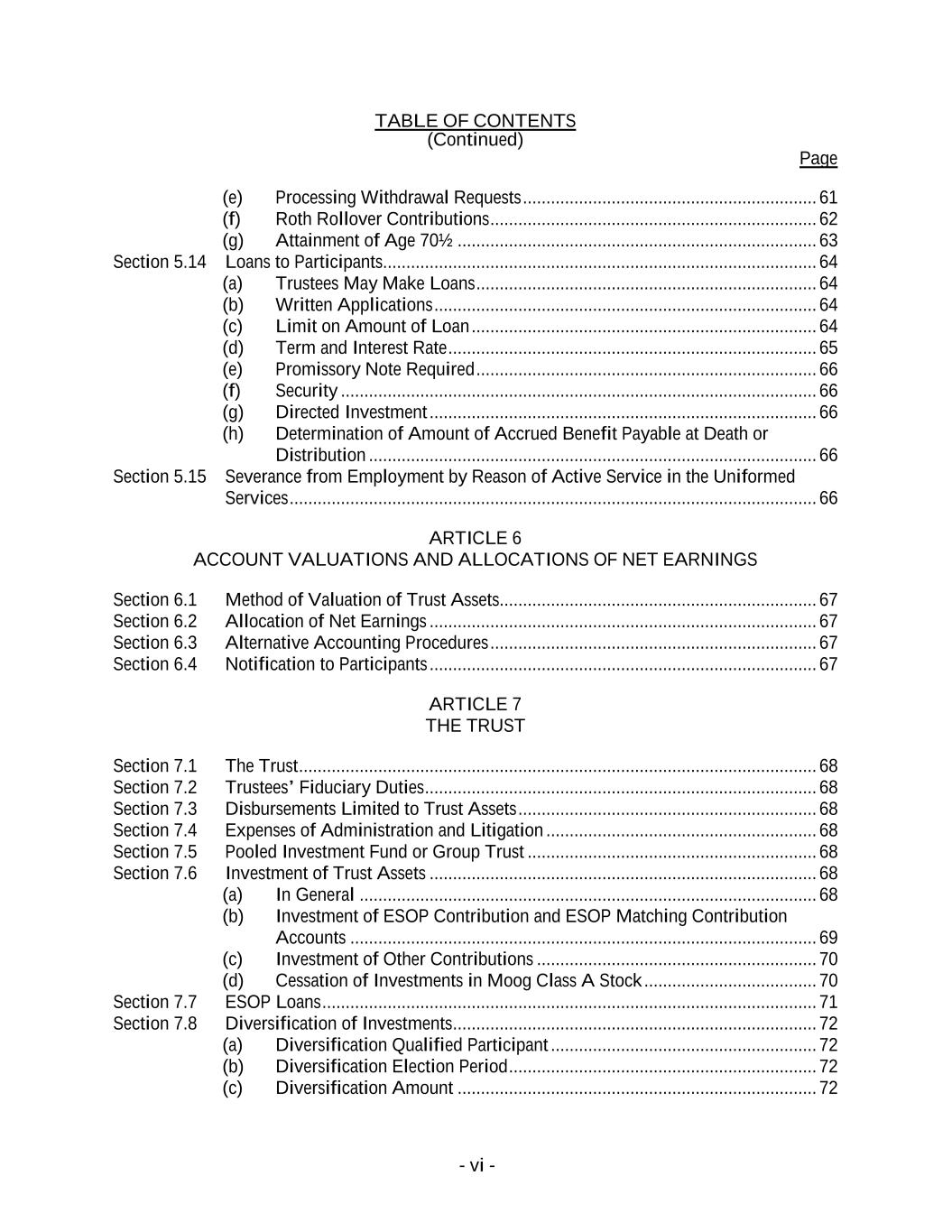
TABLE OF CONTENTS (Continued) Page (e) Processing Withdrawal Requests ............................................................... 61 (f) Roth Rollover Contributions ...................................................................... 62 (g) Attainment of Age 70½ ............................................................................. 63 Section 5.14 Loans to Participants............................................................................................. 64 (a) Trustees May Make Loans ......................................................................... 64 (b) Written Applications .................................................................................. 64 (c) Limit on Amount of Loan .......................................................................... 64 (d) Term and Interest Rate ............................................................................... 65 (e) Promissory Note Required ......................................................................... 66 (f) Security ...................................................................................................... 66 (g) Directed Investment ................................................................................... 66 (h) Determination of Amount of Accrued Benefit Payable at Death or Distribution ................................................................................................ 66 Section 5.15 Severance from Employment by Reason of Active Service in the Uniformed Services ................................................................................................................. 66 ARTICLE 6 ACCOUNT VALUATIONS AND ALLOCATIONS OF NET EARNINGS Section 6.1 Method of Valuation of Trust Assets.................................................................... 67 Section 6.2 Allocation of Net Earnings ................................................................................... 67 Section 6.3 Alternative Accounting Procedures ...................................................................... 67 Section 6.4 Notification to Participants ................................................................................... 67 ARTICLE 7 THE TRUST Section 7.1 The Trust ............................................................................................................... 68 Section 7.2 Trustees’ Fiduciary Duties .................................................................................... 68 Section 7.3 Disbursements Limited to Trust Assets ................................................................ 68 Section 7.4 Expenses of Administration and Litigation .......................................................... 68 Section 7.5 Pooled Investment Fund or Group Trust .............................................................. 68 Section 7.6 Investment of Trust Assets ................................................................................... 68 (a) In General .................................................................................................. 68 (b) Investment of ESOP Contribution and ESOP Matching Contribution Accounts .................................................................................................... 69 (c) Investment of Other Contributions ............................................................ 70 (d) Cessation of Investments in Moog Class A Stock ..................................... 70 Section 7.7 ESOP Loans .......................................................................................................... 71 Section 7.8 Diversification of Investments .............................................................................. 72 (a) Diversification Qualified Participant ......................................................... 72 (b) Diversification Election Period .................................................................. 72 (c) Diversification Amount ............................................................................. 72 - vi -
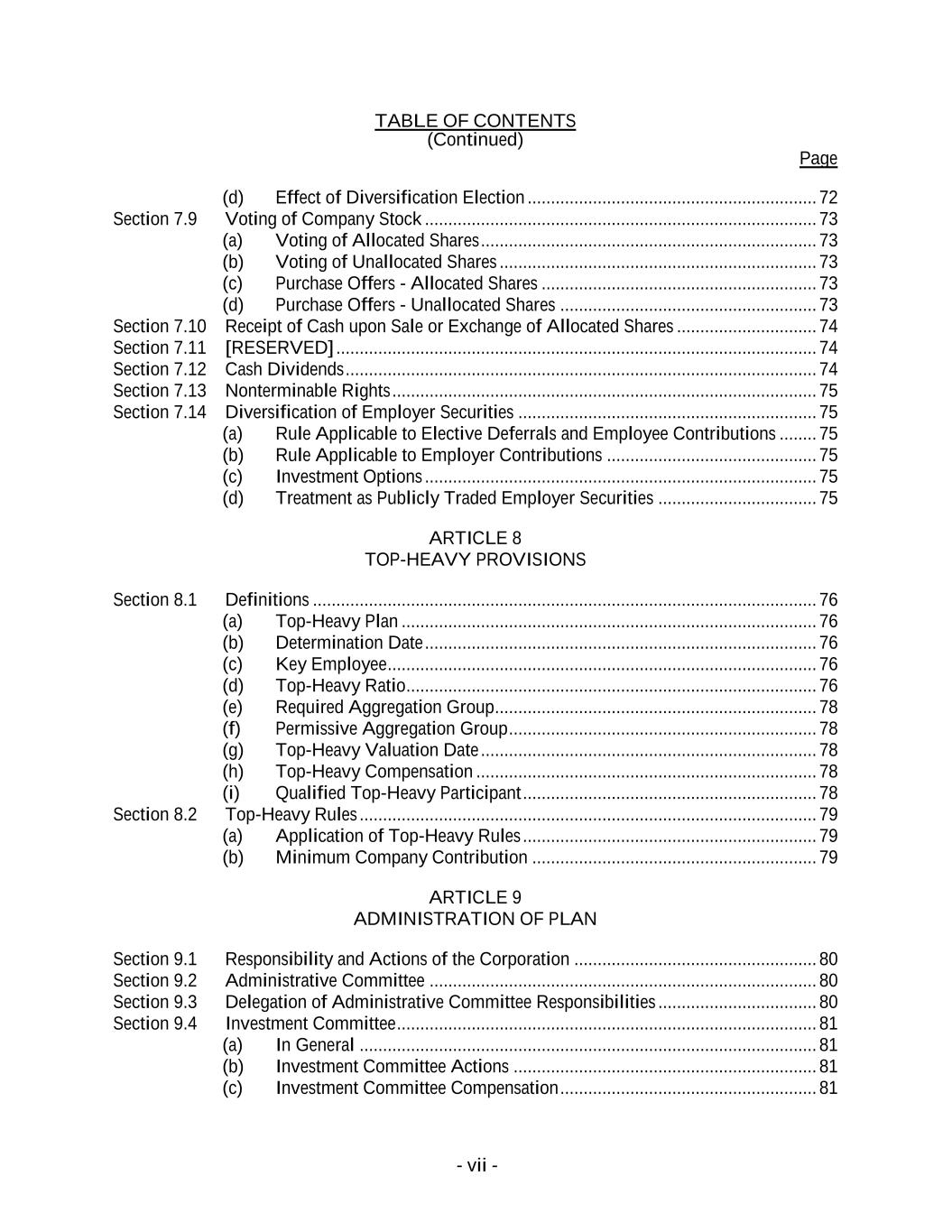
TABLE OF CONTENTS (Continued) Page (d) Effect of Diversification Election .............................................................. 72 Section 7.9 Voting of Company Stock .................................................................................... 73 (a) Voting of Allocated Shares ........................................................................ 73 (b) Voting of Unallocated Shares .................................................................... 73 (c) Purchase Offers - Allocated Shares ........................................................... 73 (d) Purchase Offers - Unallocated Shares ....................................................... 73 Section 7.10 Receipt of Cash upon Sale or Exchange of Allocated Shares .............................. 74 Section 7.11 [RESERVED] ....................................................................................................... 74 Section 7.12 Cash Dividends ..................................................................................................... 74 Section 7.13 Nonterminable Rights ........................................................................................... 75 Section 7.14 Diversification of Employer Securities ................................................................ 75 (a) Rule Applicable to Elective Deferrals and Employee Contributions ........ 75 (b) Rule Applicable to Employer Contributions ............................................. 75 (c) Investment Options .................................................................................... 75 (d) Treatment as Publicly Traded Employer Securities .................................. 75 ARTICLE 8 TOP-HEAVY PROVISIONS Section 8.1 Definitions ............................................................................................................ 76 (a) Top-Heavy Plan ......................................................................................... 76 (b) Determination Date .................................................................................... 76 (c) Key Employee ............................................................................................ 76 (d) Top-Heavy Ratio ........................................................................................ 76 (e) Required Aggregation Group ..................................................................... 78 (f) Permissive Aggregation Group .................................................................. 78 (g) Top-Heavy Valuation Date ........................................................................ 78 (h) Top-Heavy Compensation ......................................................................... 78 (i) Qualified Top-Heavy Participant ............................................................... 78 Section 8.2 Top-Heavy Rules .................................................................................................. 79 (a) Application of Top-Heavy Rules ............................................................... 79 (b) Minimum Company Contribution ............................................................. 79 ARTICLE 9 ADMINISTRATION OF PLAN Section 9.1 Responsibility and Actions of the Corporation .................................................... 80 Section 9.2 Administrative Committee ................................................................................... 80 Section 9.3 Delegation of Administrative Committee Responsibilities .................................. 80 Section 9.4 Investment Committee .......................................................................................... 81 (a) In General .................................................................................................. 81 (b) Investment Committee Actions ................................................................. 81 (c) Investment Committee Compensation ....................................................... 81 - vii -
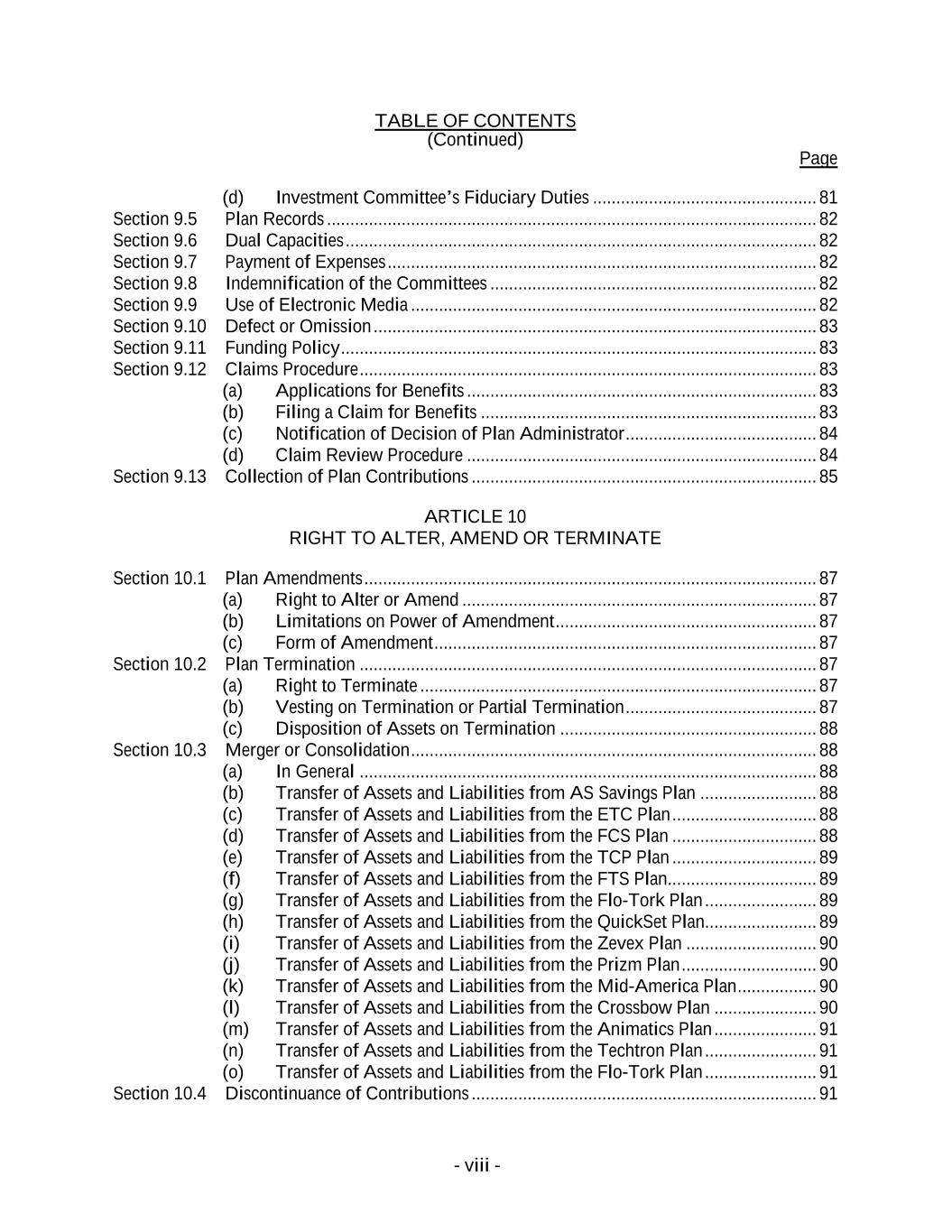
TABLE OF CONTENTS (Continued) Page (d) Investment Committee’s Fiduciary Duties ................................................ 81 Section 9.5 Plan Records ......................................................................................................... 82 Section 9.6 Dual Capacities ..................................................................................................... 82 Section 9.7 Payment of Expenses ............................................................................................ 82 Section 9.8 Indemnification of the Committees ...................................................................... 82 Section 9.9 Use of Electronic Media ....................................................................................... 82 Section 9.10 Defect or Omission ............................................................................................... 83 Section 9.11 Funding Policy ...................................................................................................... 83 Section 9.12 Claims Procedure .................................................................................................. 83 (a) Applications for Benefits ........................................................................... 83 (b) Filing a Claim for Benefits ........................................................................ 83 (c) Notification of Decision of Plan Administrator ......................................... 84 (d) Claim Review Procedure ........................................................................... 84 Section 9.13 Collection of Plan Contributions .......................................................................... 85 ARTICLE 10 RIGHT TO ALTER, AMEND OR TERMINATE Section 10.1 Plan Amendments ................................................................................................. 87 (a) Right to Alter or Amend ............................................................................ 87 (b) Limitations on Power of Amendment ........................................................ 87 (c) Form of Amendment .................................................................................. 87 Section 10.2 Plan Termination .................................................................................................. 87 (a) Right to Terminate ..................................................................................... 87 (b) Vesting on Termination or Partial Termination ......................................... 87 (c) Disposition of Assets on Termination ....................................................... 88 Section 10.3 Merger or Consolidation ....................................................................................... 88 (a) In General .................................................................................................. 88 (b) Transfer of Assets and Liabilities from AS Savings Plan ......................... 88 (c) Transfer of Assets and Liabilities from the ETC Plan ............................... 88 (d) Transfer of Assets and Liabilities from the FCS Plan ............................... 88 (e) Transfer of Assets and Liabilities from the TCP Plan ............................... 89 (f) Transfer of Assets and Liabilities from the FTS Plan................................ 89 (g) Transfer of Assets and Liabilities from the Flo-Tork Plan ........................ 89 (h) Transfer of Assets and Liabilities from the QuickSet Plan........................ 89 (i) Transfer of Assets and Liabilities from the Zevex Plan ............................ 90 (j) Transfer of Assets and Liabilities from the Prizm Plan ............................. 90 (k) Transfer of Assets and Liabilities from the Mid-America Plan ................. 90 (l) Transfer of Assets and Liabilities from the Crossbow Plan ...................... 90 (m) Transfer of Assets and Liabilities from the Animatics Plan ...................... 91 (n) Transfer of Assets and Liabilities from the Techtron Plan ........................ 91 (o) Transfer of Assets and Liabilities from the Flo-Tork Plan ........................ 91 Section 10.4 Discontinuance of Contributions .......................................................................... 91 - viii -

TABLE OF CONTENTS (Continued) Page ARTICLE 11 DIRECT ROLLOVERS Section 11.1 Direct Rollovers .................................................................................................... 93 Section 11.2 Definitions ............................................................................................................ 93 (a) Eligible Rollover Distribution ................................................................... 93 (b) Eligible Retirement Plan ............................................................................ 93 (c) Distributee .................................................................................................. 94 (d) Direct Rollover .......................................................................................... 94 Section 11.3 Direct Rollover of Non-Spousal Distribution ....................................................... 94 (a) Non-Spouse Beneficiary Rollover Right ................................................... 94 (b) Certain Requirements Not Applicable ....................................................... 95 (c) Trust Beneficiary ....................................................................................... 95 (d) Required Minimum Distributions Not Eligible For Rollover .................... 95 ARTICLE 12 MINIMUM DISTRIBUTION REQUIREMENTS Section 12.1 Definitions ............................................................................................................ 96 (a) Designated Beneficiary .............................................................................. 96 (b) Distribution Calendar Year ........................................................................ 96 (c) Life Expectancy ......................................................................................... 96 (d) Participant’s Account Balance ................................................................... 96 (e) Required Beginning Date ........................................................................... 96 Section 12.2 General Rules........................................................................................................ 96 (a) Precedence ................................................................................................. 96 (b) Requirements of Treasury Regulations Incorporated ................................ 96 Section 12.3 Time and Manner of Distribution ......................................................................... 97 (a) Required Beginning Date ........................................................................... 97 (b) Death of Participant before Distributions Begin ........................................ 97 (c) Forms of Distribution ................................................................................. 97 Section 12.4 Required Minimum Distributions During Participant’s Lifetime ........................ 97 (a) Amount of Required Minimum Distribution for Each Distribution Calendar Year ............................................................................................ 97 (b) Lifetime Required Minimum Distributions Continue Through Year of Participant’s Death ..................................................................................... 98 Section 12.5 Required Minimum Distributions After Participant’s Death ............................... 98 (a) Death On or After Date Distributions Begin ............................................. 98 (b) Death before Date Distributions Begin ...................................................... 99 Section 12.6 Transition Rules .................................................................................................... 99 (a) Distributions in 2000 and Before ............................................................... 99 (b) Distributions in 2001 ................................................................................. 99 (c) Distributions in 2002 ............................................................................... 100 - ix -
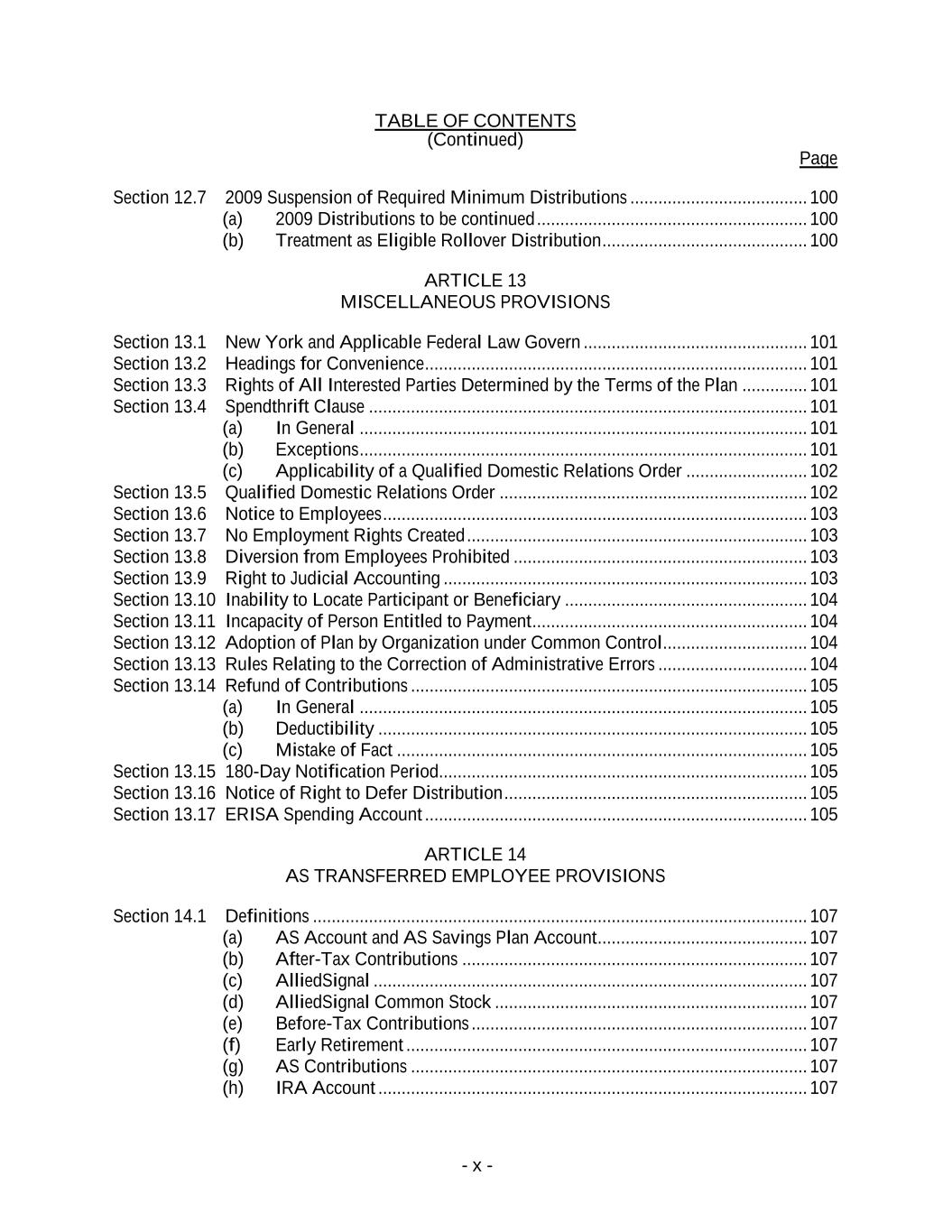
TABLE OF CONTENTS (Continued) Page Section 12.7 2009 Suspension of Required Minimum Distributions ...................................... 100 (a) 2009 Distributions to be continued .......................................................... 100 (b) Treatment as Eligible Rollover Distribution ............................................ 100 ARTICLE 13 MISCELLANEOUS PROVISIONS Section 13.1 New York and Applicable Federal Law Govern ................................................ 101 Section 13.2 Headings for Convenience .................................................................................. 101 Section 13.3 Rights of All Interested Parties Determined by the Terms of the Plan .............. 101 Section 13.4 Spendthrift Clause .............................................................................................. 101 (a) In General ................................................................................................ 101 (b) Exceptions ................................................................................................ 101 (c) Applicability of a Qualified Domestic Relations Order .......................... 102 Section 13.5 Qualified Domestic Relations Order .................................................................. 102 Section 13.6 Notice to Employees ........................................................................................... 103 Section 13.7 No Employment Rights Created ......................................................................... 103 Section 13.8 Diversion from Employees Prohibited ............................................................... 103 Section 13.9 Right to Judicial Accounting .............................................................................. 103 Section 13.10 Inability to Locate Participant or Beneficiary .................................................... 104 Section 13.11 Incapacity of Person Entitled to Payment ........................................................... 104 Section 13.12 Adoption of Plan by Organization under Common Control ............................... 104 Section 13.13 Rules Relating to the Correction of Administrative Errors ................................ 104 Section 13.14 Refund of Contributions ..................................................................................... 105 (a) In General ................................................................................................ 105 (b) Deductibility ............................................................................................ 105 (c) Mistake of Fact ........................................................................................ 105 Section 13.15 180-Day Notification Period............................................................................... 105 Section 13.16 Notice of Right to Defer Distribution ................................................................. 105 Section 13.17 ERISA Spending Account .................................................................................. 105 ARTICLE 14 AS TRANSFERRED EMPLOYEE PROVISIONS Section 14.1 Definitions .......................................................................................................... 107 (a) AS Account and AS Savings Plan Account ............................................. 107 (b) After-Tax Contributions .......................................................................... 107 (c) AlliedSignal ............................................................................................. 107 (d) AlliedSignal Common Stock ................................................................... 107 (e) Before-Tax Contributions ........................................................................ 107 (f) Early Retirement ...................................................................................... 107 (g) AS Contributions ..................................................................................... 107 (h) IRA Account ............................................................................................ 107 - x -
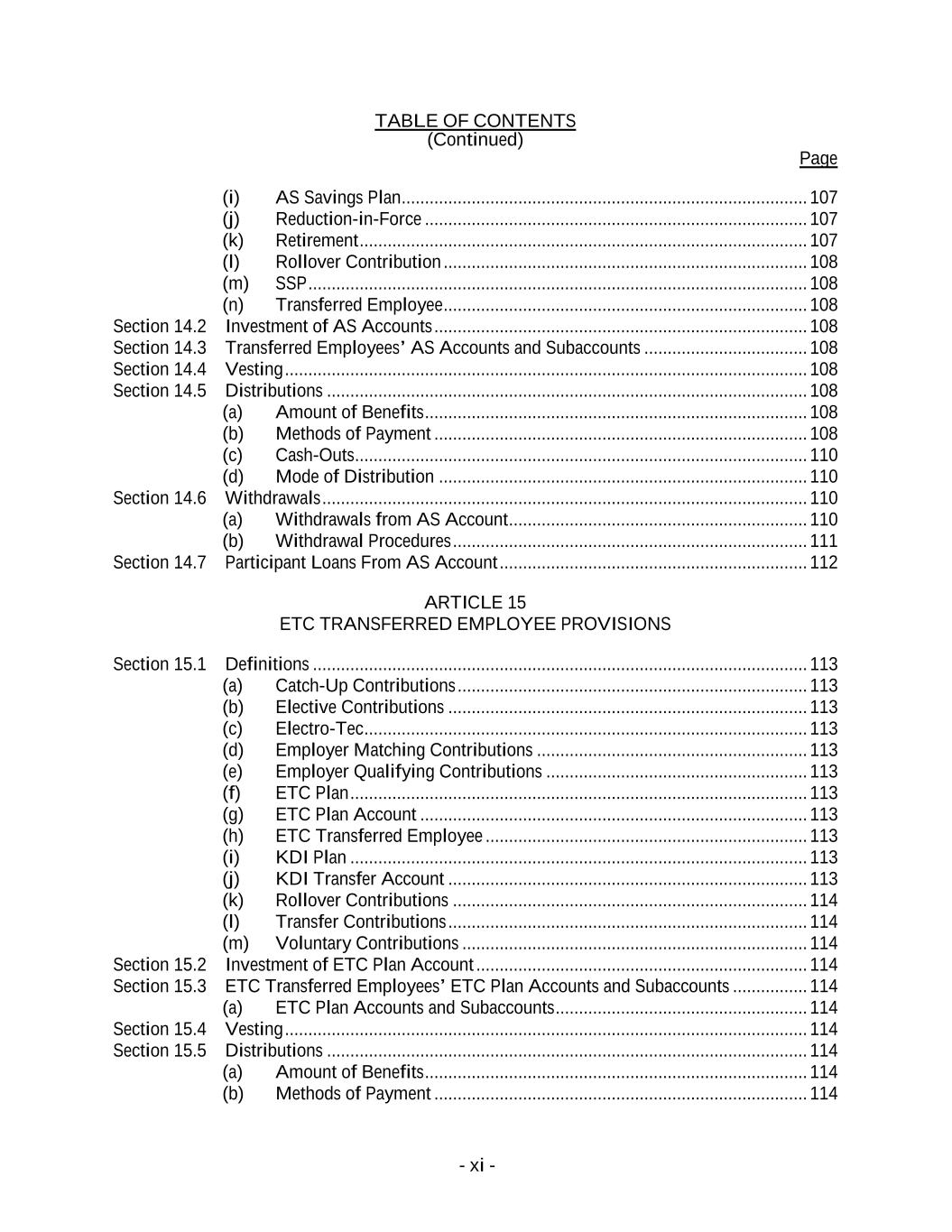
TABLE OF CONTENTS (Continued) Page (i) AS Savings Plan ....................................................................................... 107 (j) Reduction-in-Force .................................................................................. 107 (k) Retirement ................................................................................................ 107 (l) Rollover Contribution .............................................................................. 108 (m) SSP ........................................................................................................... 108 (n) Transferred Employee .............................................................................. 108 Section 14.2 Investment of AS Accounts ................................................................................ 108 Section 14.3 Transferred Employees’ AS Accounts and Subaccounts ................................... 108 Section 14.4 Vesting ................................................................................................................ 108 Section 14.5 Distributions ....................................................................................................... 108 (a) Amount of Benefits .................................................................................. 108 (b) Methods of Payment ................................................................................ 108 (c) Cash-Outs ................................................................................................. 110 (d) Mode of Distribution ............................................................................... 110 Section 14.6 Withdrawals ........................................................................................................ 110 (a) Withdrawals from AS Account ................................................................ 110 (b) Withdrawal Procedures ............................................................................ 111 Section 14.7 Participant Loans From AS Account .................................................................. 112 ARTICLE 15 ETC TRANSFERRED EMPLOYEE PROVISIONS Section 15.1 Definitions .......................................................................................................... 113 (a) Catch-Up Contributions ........................................................................... 113 (b) Elective Contributions ............................................................................. 113 (c) Electro-Tec ............................................................................................... 113 (d) Employer Matching Contributions .......................................................... 113 (e) Employer Qualifying Contributions ........................................................ 113 (f) ETC Plan .................................................................................................. 113 (g) ETC Plan Account ................................................................................... 113 (h) ETC Transferred Employee ..................................................................... 113 (i) KDI Plan .................................................................................................. 113 (j) KDI Transfer Account ............................................................................. 113 (k) Rollover Contributions ............................................................................ 114 (l) Transfer Contributions ............................................................................. 114 (m) Voluntary Contributions .......................................................................... 114 Section 15.2 Investment of ETC Plan Account ....................................................................... 114 Section 15.3 ETC Transferred Employees’ ETC Plan Accounts and Subaccounts ................ 114 (a) ETC Plan Accounts and Subaccounts ...................................................... 114 Section 15.4 Vesting ................................................................................................................ 114 Section 15.5 Distributions ....................................................................................................... 114 (a) Amount of Benefits .................................................................................. 114 (b) Methods of Payment ................................................................................ 114 - xi -
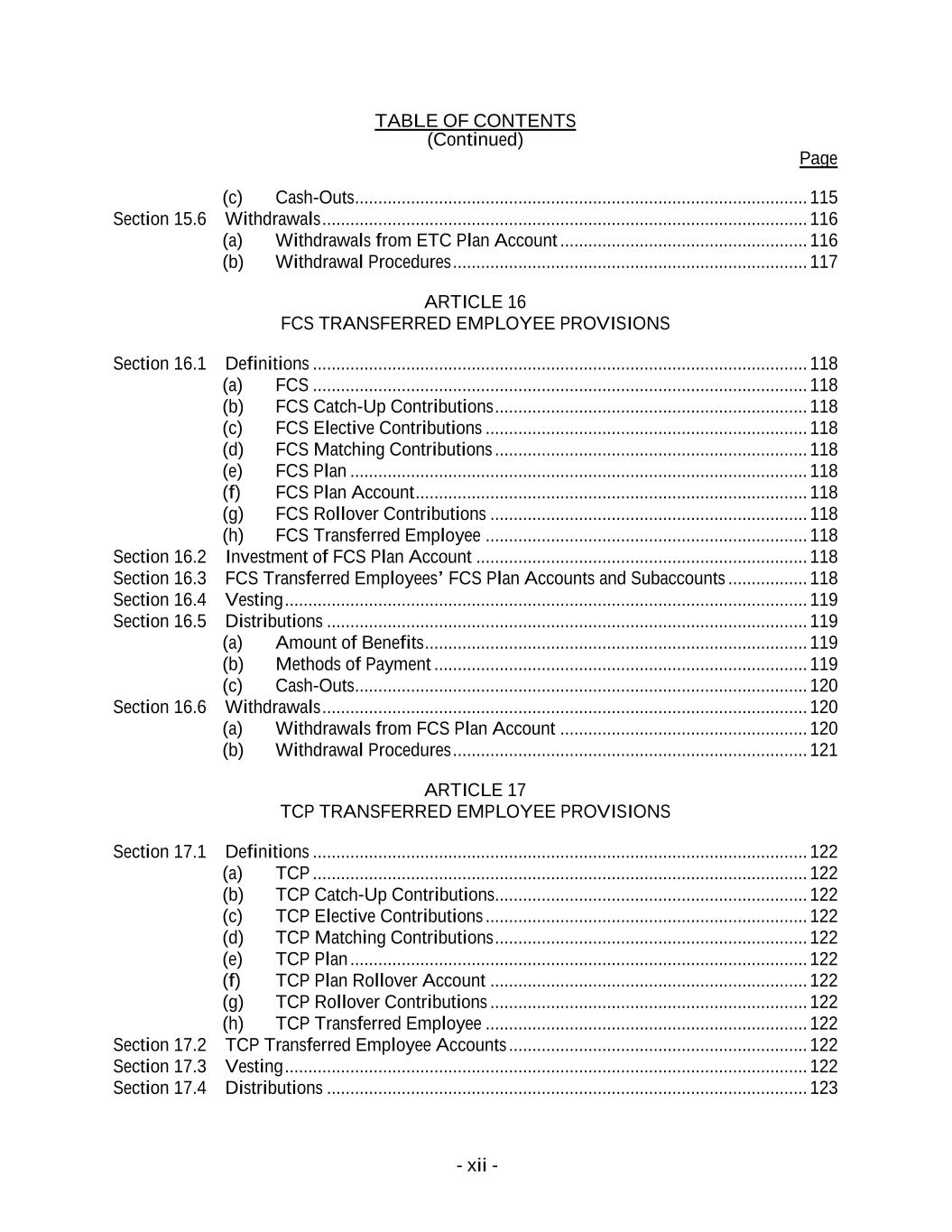
TABLE OF CONTENTS (Continued) Page (c) Cash-Outs ................................................................................................. 115 Section 15.6 Withdrawals ........................................................................................................ 116 (a) Withdrawals from ETC Plan Account ..................................................... 116 (b) Withdrawal Procedures ............................................................................ 117 ARTICLE 16 FCS TRANSFERRED EMPLOYEE PROVISIONS Section 16.1 Definitions .......................................................................................................... 118 (a) FCS .......................................................................................................... 118 (b) FCS Catch-Up Contributions ................................................................... 118 (c) FCS Elective Contributions ..................................................................... 118 (d) FCS Matching Contributions ................................................................... 118 (e) FCS Plan .................................................................................................. 118 (f) FCS Plan Account .................................................................................... 118 (g) FCS Rollover Contributions .................................................................... 118 (h) FCS Transferred Employee ..................................................................... 118 Section 16.2 Investment of FCS Plan Account ....................................................................... 118 Section 16.3 FCS Transferred Employees’ FCS Plan Accounts and Subaccounts ................. 118 Section 16.4 Vesting ................................................................................................................ 119 Section 16.5 Distributions ....................................................................................................... 119 (a) Amount of Benefits .................................................................................. 119 (b) Methods of Payment ................................................................................ 119 (c) Cash-Outs ................................................................................................. 120 Section 16.6 Withdrawals ........................................................................................................ 120 (a) Withdrawals from FCS Plan Account ..................................................... 120 (b) Withdrawal Procedures ............................................................................ 121 ARTICLE 17 TCP TRANSFERRED EMPLOYEE PROVISIONS Section 17.1 Definitions .......................................................................................................... 122 (a) TCP .......................................................................................................... 122 (b) TCP Catch-Up Contributions ................................................................... 122 (c) TCP Elective Contributions ..................................................................... 122 (d) TCP Matching Contributions ................................................................... 122 (e) TCP Plan .................................................................................................. 122 (f) TCP Plan Rollover Account .................................................................... 122 (g) TCP Rollover Contributions .................................................................... 122 (h) TCP Transferred Employee ..................................................................... 122 Section 17.2 TCP Transferred Employee Accounts ................................................................ 122 Section 17.3 Vesting ................................................................................................................ 122 Section 17.4 Distributions ....................................................................................................... 123 - xii -
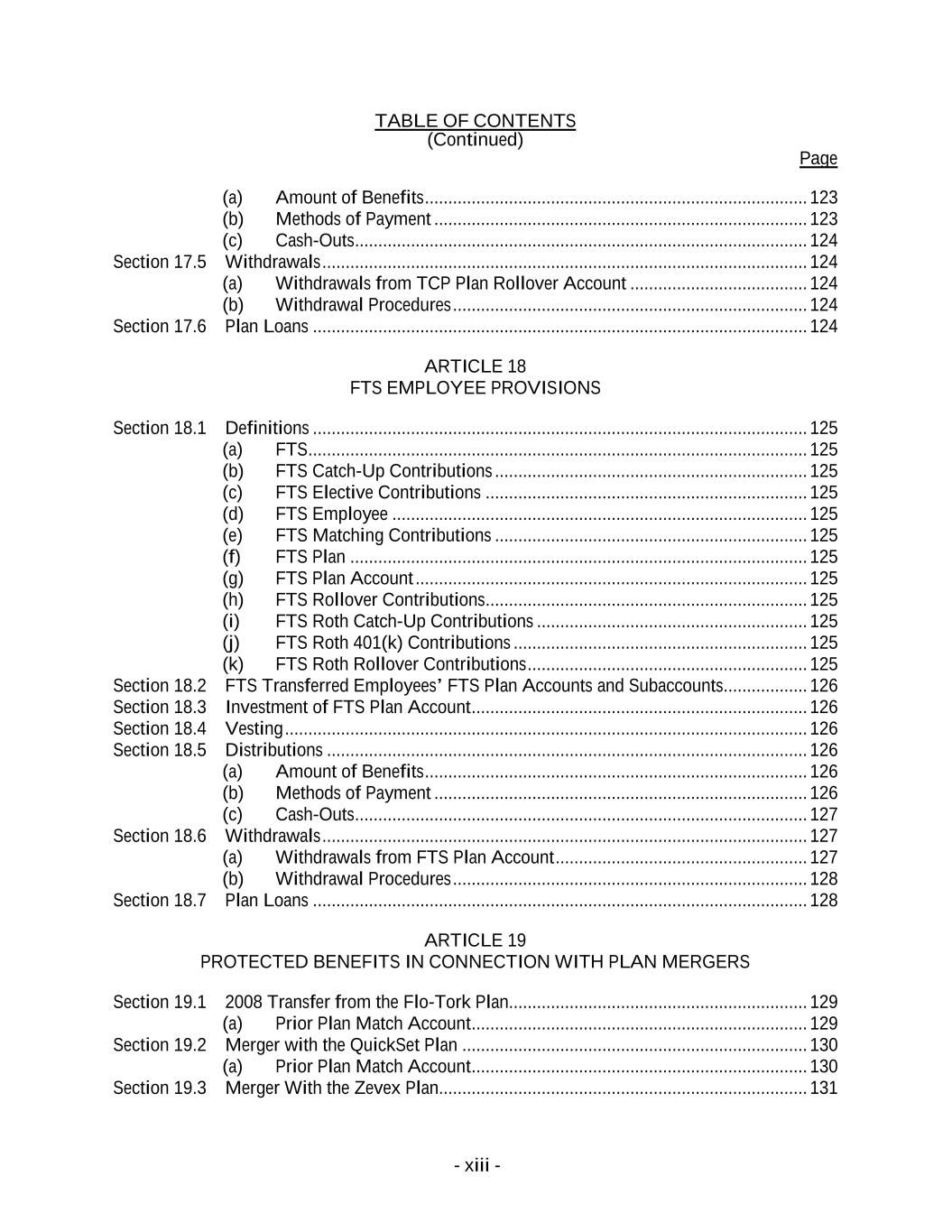
TABLE OF CONTENTS (Continued) Page (a) Amount of Benefits .................................................................................. 123 (b) Methods of Payment ................................................................................ 123 (c) Cash-Outs ................................................................................................. 124 Section 17.5 Withdrawals ........................................................................................................ 124 (a) Withdrawals from TCP Plan Rollover Account ...................................... 124 (b) Withdrawal Procedures ............................................................................ 124 Section 17.6 Plan Loans .......................................................................................................... 124 ARTICLE 18 FTS EMPLOYEE PROVISIONS Section 18.1 Definitions .......................................................................................................... 125 (a) FTS ........................................................................................................... 125 (b) FTS Catch-Up Contributions ................................................................... 125 (c) FTS Elective Contributions ..................................................................... 125 (d) FTS Employee ......................................................................................... 125 (e) FTS Matching Contributions ................................................................... 125 (f) FTS Plan .................................................................................................. 125 (g) FTS Plan Account .................................................................................... 125 (h) FTS Rollover Contributions ..................................................................... 125 (i) FTS Roth Catch-Up Contributions .......................................................... 125 (j) FTS Roth 401(k) Contributions ............................................................... 125 (k) FTS Roth Rollover Contributions ............................................................ 125 Section 18.2 FTS Transferred Employees’ FTS Plan Accounts and Subaccounts.................. 126 Section 18.3 Investment of FTS Plan Account ........................................................................ 126 Section 18.4 Vesting ................................................................................................................ 126 Section 18.5 Distributions ....................................................................................................... 126 (a) Amount of Benefits .................................................................................. 126 (b) Methods of Payment ................................................................................ 126 (c) Cash-Outs ................................................................................................. 127 Section 18.6 Withdrawals ........................................................................................................ 127 (a) Withdrawals from FTS Plan Account ...................................................... 127 (b) Withdrawal Procedures ............................................................................ 128 Section 18.7 Plan Loans .......................................................................................................... 128 ARTICLE 19 PROTECTED BENEFITS IN CONNECTION WITH PLAN MERGERS Section 19.1 2008 Transfer from the Flo-Tork Plan................................................................ 129 (a) Prior Plan Match Account ........................................................................ 129 Section 19.2 Merger with the QuickSet Plan .......................................................................... 130 (a) Prior Plan Match Account ........................................................................ 130 Section 19.3 Merger With the Zevex Plan............................................................................... 131 - xiii -
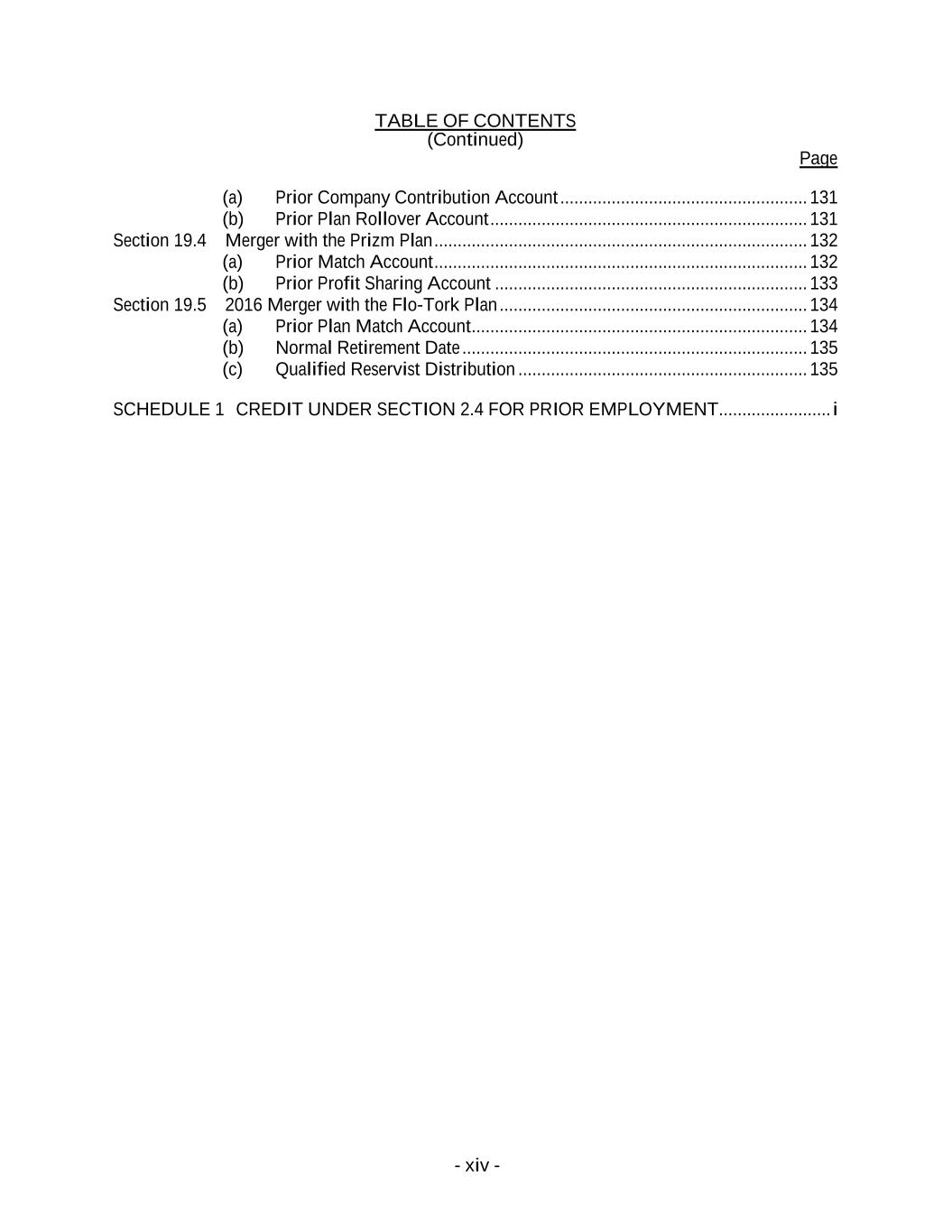
TABLE OF CONTENTS (Continued) Page (a) Prior Company Contribution Account ..................................................... 131 (b) Prior Plan Rollover Account .................................................................... 131 Section 19.4 Merger with the Prizm Plan ................................................................................ 132 (a) Prior Match Account ................................................................................ 132 (b) Prior Profit Sharing Account ................................................................... 133 Section 19.5 2016 Merger with the Flo-Tork Plan .................................................................. 134 (a) Prior Plan Match Account ........................................................................ 134 (b) Normal Retirement Date .......................................................................... 135 (c) Qualified Reservist Distribution .............................................................. 135 SCHEDULE 1 CREDIT UNDER SECTION 2.4 FOR PRIOR EMPLOYMENT........................ i - xiv -
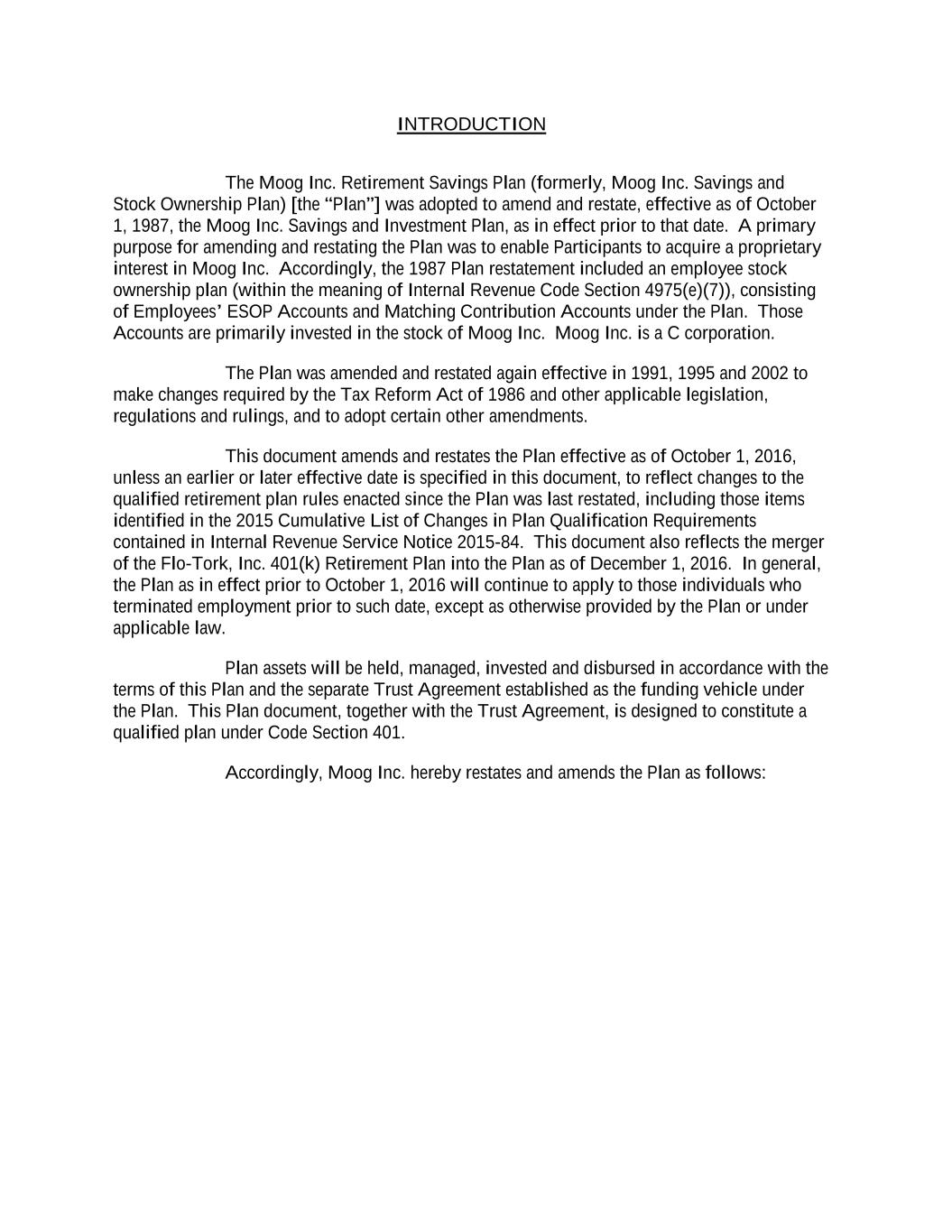
INTRODUCTION The Moog Inc. Retirement Savings Plan (formerly, Moog Inc. Savings and Stock Ownership Plan) [the “Plan”] was adopted to amend and restate, effective as of October 1, 1987, the Moog Inc. Savings and Investment Plan, as in effect prior to that date. A primary purpose for amending and restating the Plan was to enable Participants to acquire a proprietary interest in Moog Inc. Accordingly, the 1987 Plan restatement included an employee stock ownership plan (within the meaning of Internal Revenue Code Section 4975(e)(7)), consisting of Employees’ ESOP Accounts and Matching Contribution Accounts under the Plan. Those Accounts are primarily invested in the stock of Moog Inc. Moog Inc. is a C corporation. The Plan was amended and restated again effective in 1991, 1995 and 2002 to make changes required by the Tax Reform Act of 1986 and other applicable legislation, regulations and rulings, and to adopt certain other amendments. This document amends and restates the Plan effective as of October 1, 2016, unless an earlier or later effective date is specified in this document, to reflect changes to the qualified retirement plan rules enacted since the Plan was last restated, including those items identified in the 2015 Cumulative List of Changes in Plan Qualification Requirements contained in Internal Revenue Service Notice 2015-84. This document also reflects the merger of the Flo-Tork, Inc. 401(k) Retirement Plan into the Plan as of December 1, 2016. In general, the Plan as in effect prior to October 1, 2016 will continue to apply to those individuals who terminated employment prior to such date, except as otherwise provided by the Plan or under applicable law. Plan assets will be held, managed, invested and disbursed in accordance with the terms of this Plan and the separate Trust Agreement established as the funding vehicle under the Plan. This Plan document, together with the Trust Agreement, is designed to constitute a qualified plan under Code Section 401. Accordingly, Moog Inc. hereby restates and amends the Plan as follows:
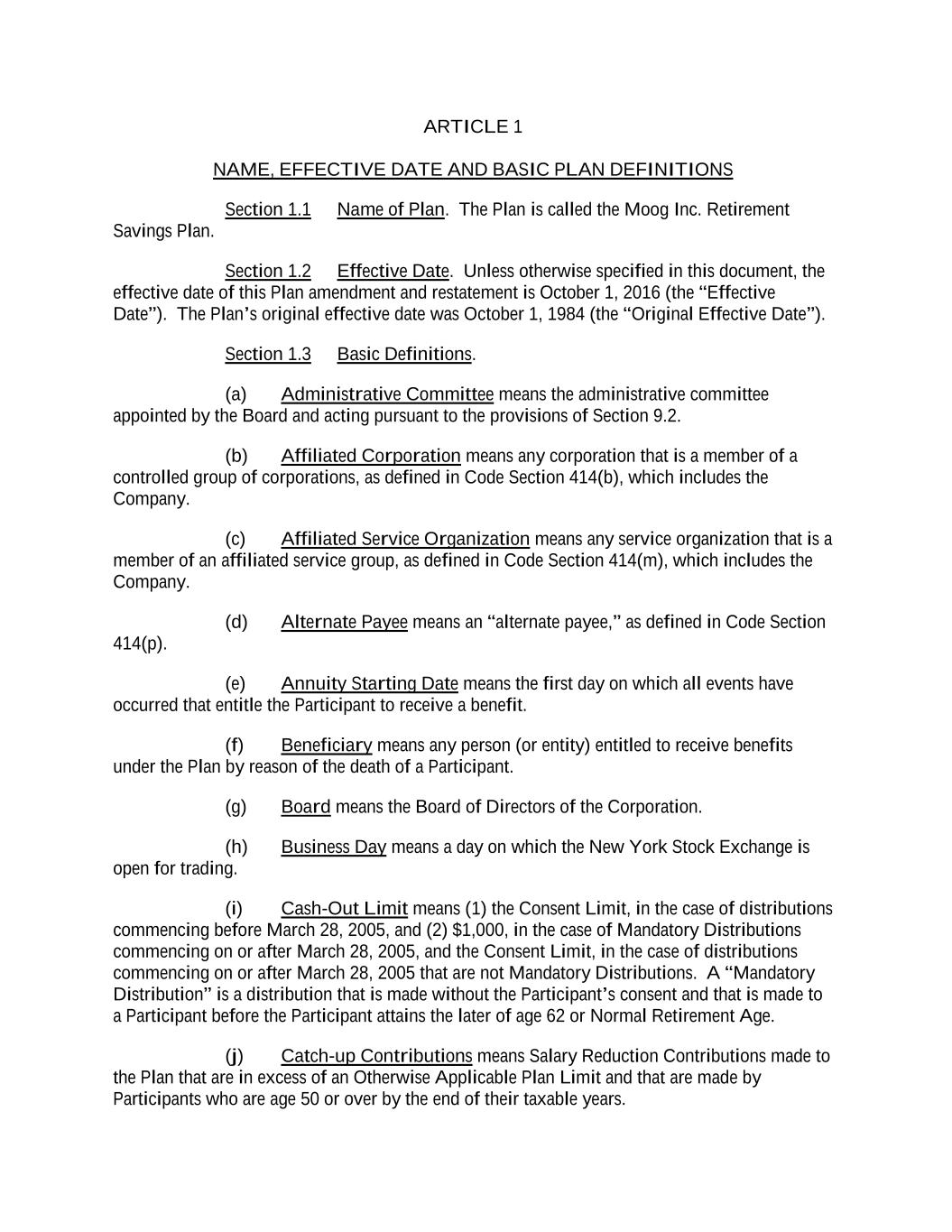
ARTICLE 1 NAME, EFFECTIVE DATE AND BASIC PLAN DEFINITIONS Section 1.1 Name of Plan. The Plan is called the Moog Inc. Retirement Savings Plan. Section 1.2 Effective Date. Unless otherwise specified in this document, the effective date of this Plan amendment and restatement is October 1, 2016 (the “Effective Date”). The Plan’s original effective date was October 1, 1984 (the “Original Effective Date”). Section 1.3 Basic Definitions. (a) Administrative Committee means the administrative committee appointed by the Board and acting pursuant to the provisions of Section 9.2. (b) Affiliated Corporation means any corporation that is a member of a controlled group of corporations, as defined in Code Section 414(b), which includes the Company. (c) Affiliated Service Organization means any service organization that is a member of an affiliated service group, as defined in Code Section 414(m), which includes the Company. (d) Alternate Payee means an “alternate payee,” as defined in Code Section 414(p). (e) Annuity Starting Date means the first day on which all events have occurred that entitle the Participant to receive a benefit. (f) Beneficiary means any person (or entity) entitled to receive benefits under the Plan by reason of the death of a Participant. (g) Board means the Board of Directors of the Corporation. (h) Business Day means a day on which the New York Stock Exchange is open for trading. (i) Cash-Out Limit means (1) the Consent Limit, in the case of distributions commencing before March 28, 2005, and (2) $1,000, in the case of Mandatory Distributions commencing on or after March 28, 2005, and the Consent Limit, in the case of distributions commencing on or after March 28, 2005 that are not Mandatory Distributions. A “Mandatory Distribution” is a distribution that is made without the Participant’s consent and that is made to a Participant before the Participant attains the later of age 62 or Normal Retirement Age. (j) Catch-up Contributions means Salary Reduction Contributions made to the Plan that are in excess of an Otherwise Applicable Plan Limit and that are made by Participants who are age 50 or over by the end of their taxable years.
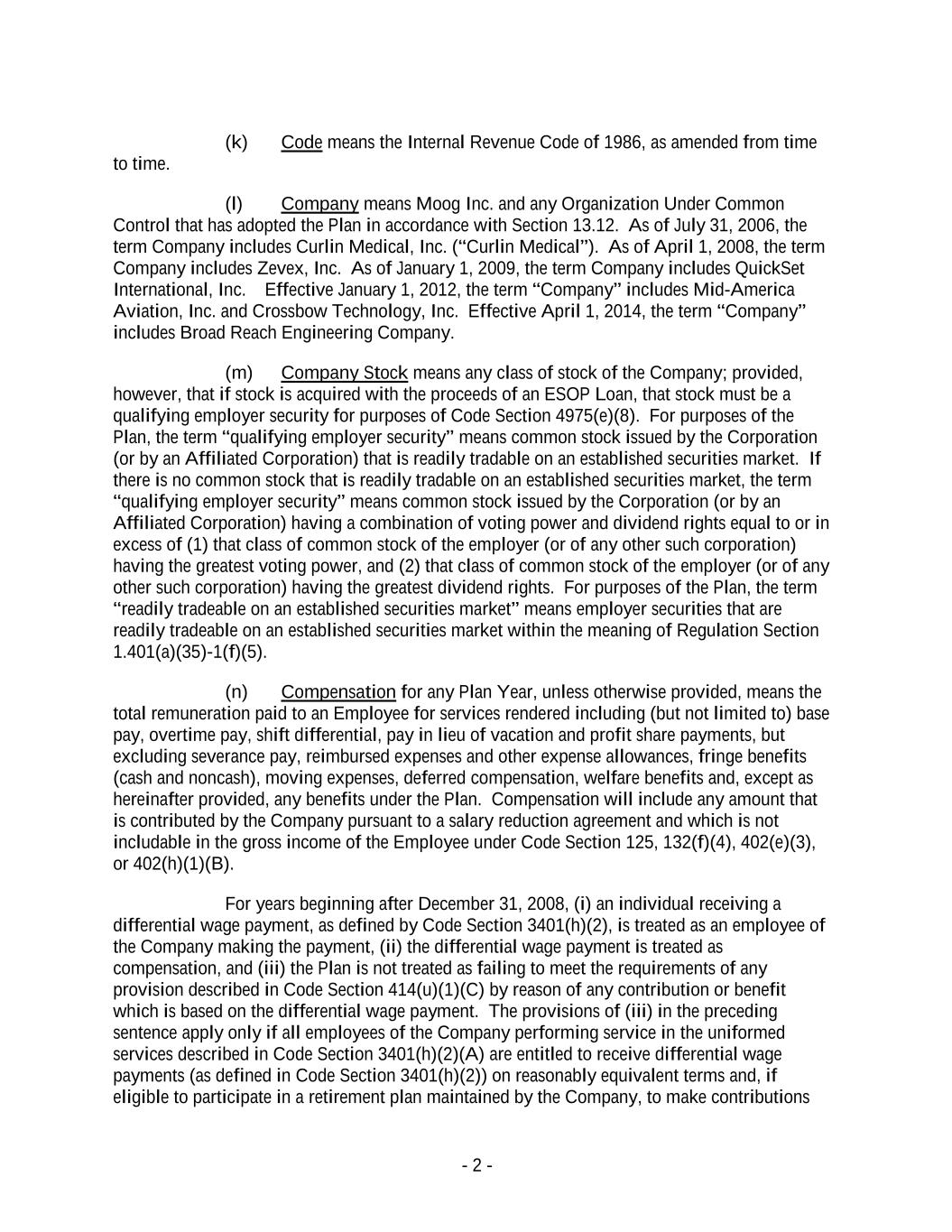
(k) Code means the Internal Revenue Code of 1986, as amended from time to time. (l) Company means Moog Inc. and any Organization Under Common Control that has adopted the Plan in accordance with Section 13.12. As of July 31, 2006, the term Company includes Curlin Medical, Inc. (“Curlin Medical”). As of April 1, 2008, the term Company includes Zevex, Inc. As of January 1, 2009, the term Company includes QuickSet International, Inc. Effective January 1, 2012, the term “Company” includes Mid-America Aviation, Inc. and Crossbow Technology, Inc. Effective April 1, 2014, the term “Company” includes Broad Reach Engineering Company. (m) Company Stock means any class of stock of the Company; provided, however, that if stock is acquired with the proceeds of an ESOP Loan, that stock must be a qualifying employer security for purposes of Code Section 4975(e)(8). For purposes of the Plan, the term “qualifying employer security” means common stock issued by the Corporation (or by an Affiliated Corporation) that is readily tradable on an established securities market. If there is no common stock that is readily tradable on an established securities market, the term “qualifying employer security” means common stock issued by the Corporation (or by an Affiliated Corporation) having a combination of voting power and dividend rights equal to or in excess of (1) that class of common stock of the employer (or of any other such corporation) having the greatest voting power, and (2) that class of common stock of the employer (or of any other such corporation) having the greatest dividend rights. For purposes of the Plan, the term “readily tradeable on an established securities market” means employer securities that are readily tradeable on an established securities market within the meaning of Regulation Section 1.401(a)(35)-1(f)(5). (n) Compensation for any Plan Year, unless otherwise provided, means the total remuneration paid to an Employee for services rendered including (but not limited to) base pay, overtime pay, shift differential, pay in lieu of vacation and profit share payments, but excluding severance pay, reimbursed expenses and other expense allowances, fringe benefits (cash and noncash), moving expenses, deferred compensation, welfare benefits and, except as hereinafter provided, any benefits under the Plan. Compensation will include any amount that is contributed by the Company pursuant to a salary reduction agreement and which is not includable in the gross income of the Employee under Code Section 125, 132(f)(4), 402(e)(3), or 402(h)(1)(B). For years beginning after December 31, 2008, (i) an individual receiving a differential wage payment, as defined by Code Section 3401(h)(2), is treated as an employee of the Company making the payment, (ii) the differential wage payment is treated as compensation, and (iii) the Plan is not treated as failing to meet the requirements of any provision described in Code Section 414(u)(1)(C) by reason of any contribution or benefit which is based on the differential wage payment. The provisions of (iii) in the preceding sentence apply only if all employees of the Company performing service in the uniformed services described in Code Section 3401(h)(2)(A) are entitled to receive differential wage payments (as defined in Code Section 3401(h)(2)) on reasonably equivalent terms and, if eligible to participate in a retirement plan maintained by the Company, to make contributions - 2 -
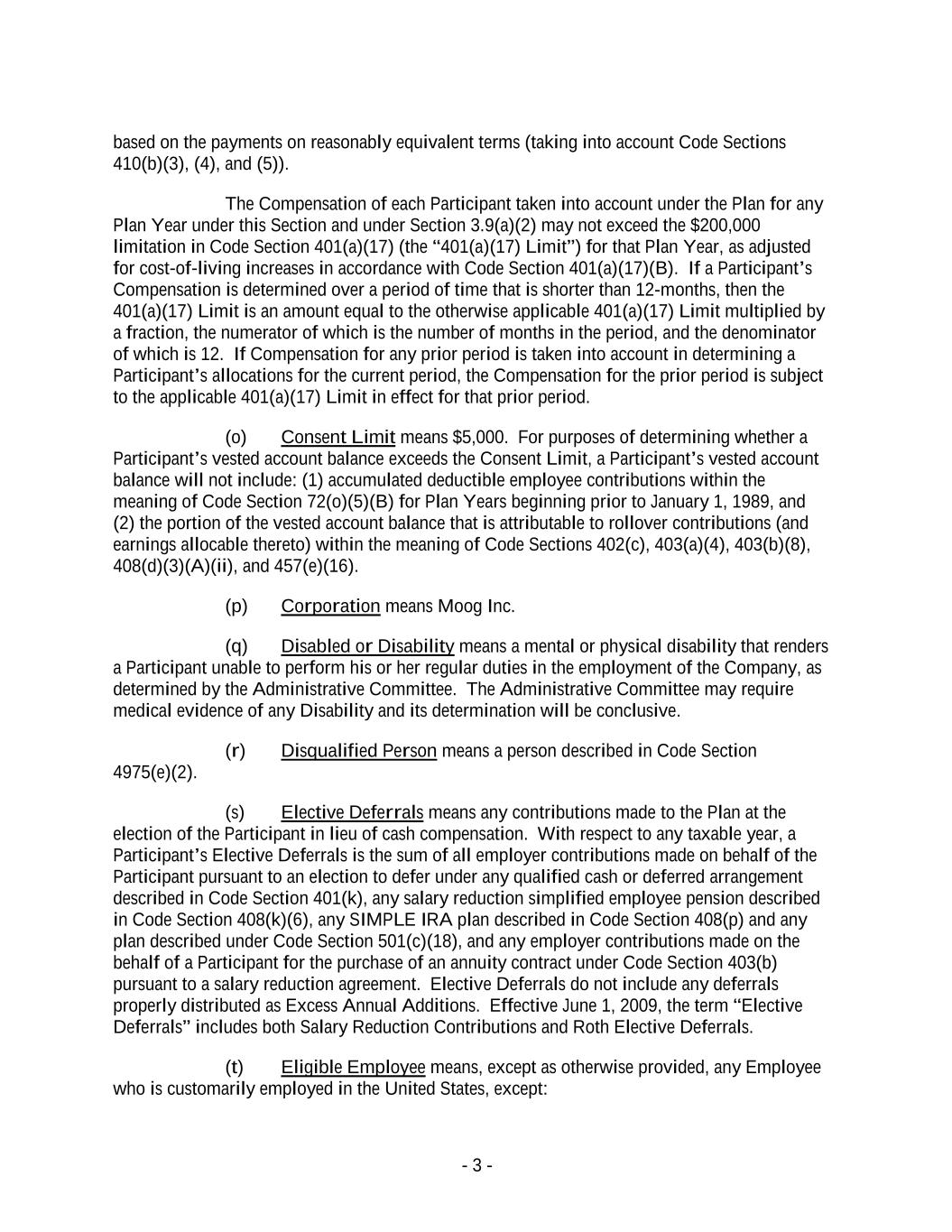
based on the payments on reasonably equivalent terms (taking into account Code Sections 410(b)(3), (4), and (5)). The Compensation of each Participant taken into account under the Plan for any Plan Year under this Section and under Section 3.9(a)(2) may not exceed the $200,000 limitation in Code Section 401(a)(17) (the “401(a)(17) Limit”) for that Plan Year, as adjusted for cost-of-living increases in accordance with Code Section 401(a)(17)(B). If a Participant’s Compensation is determined over a period of time that is shorter than 12-months, then the 401(a)(17) Limit is an amount equal to the otherwise applicable 401(a)(17) Limit multiplied by a fraction, the numerator of which is the number of months in the period, and the denominator of which is 12. If Compensation for any prior period is taken into account in determining a Participant’s allocations for the current period, the Compensation for the prior period is subject to the applicable 401(a)(17) Limit in effect for that prior period. (o) Consent Limit means $5,000. For purposes of determining whether a Participant’s vested account balance exceeds the Consent Limit, a Participant’s vested account balance will not include: (1) accumulated deductible employee contributions within the meaning of Code Section 72(o)(5)(B) for Plan Years beginning prior to January 1, 1989, and (2) the portion of the vested account balance that is attributable to rollover contributions (and earnings allocable thereto) within the meaning of Code Sections 402(c), 403(a)(4), 403(b)(8), 408(d)(3)(A)(ii), and 457(e)(16). (p) Corporation means Moog Inc. (q) Disabled or Disability means a mental or physical disability that renders a Participant unable to perform his or her regular duties in the employment of the Company, as determined by the Administrative Committee. The Administrative Committee may require medical evidence of any Disability and its determination will be conclusive. (r) Disqualified Person means a person described in Code Section 4975(e)(2). (s) Elective Deferrals means any contributions made to the Plan at the election of the Participant in lieu of cash compensation. With respect to any taxable year, a Participant’s Elective Deferrals is the sum of all employer contributions made on behalf of the Participant pursuant to an election to defer under any qualified cash or deferred arrangement described in Code Section 401(k), any salary reduction simplified employee pension described in Code Section 408(k)(6), any SIMPLE IRA plan described in Code Section 408(p) and any plan described under Code Section 501(c)(18), and any employer contributions made on the behalf of a Participant for the purchase of an annuity contract under Code Section 403(b) pursuant to a salary reduction agreement. Elective Deferrals do not include any deferrals properly distributed as Excess Annual Additions. Effective June 1, 2009, the term “Elective Deferrals” includes both Salary Reduction Contributions and Roth Elective Deferrals. (t) Eligible Employee means, except as otherwise provided, any Employee who is customarily employed in the United States, except: - 3 -

(1) Employees Covered by Collective Bargaining Agreement. Employees included in a unit of Employees covered by an agreement that the Secretary of Labor finds to be a collective bargaining agreement between the Company and employee representatives (within the meaning of Code Section 7701(a)(46)) if (i) there is evidence that retirement benefits were the subject of good faith bargaining and (ii) the terms of the collective bargaining agreement do not specifically provide for participation in the Plan. (2) Nonresident Aliens. Employees who are nonresident aliens (within the meaning of Code Section 7701(b)(1)(B)) and who received no earned income (within the meaning of Code Section 911(d)(2)) from the Company that constitutes income from sources within the United States (within the meaning of Code Section 861(a)(3)). (3) Contingent Workers, which means individuals who are workers: (i) Who have signed independent contractor agreements or other personal services contracts with the Company stating that they are not eligible to participate in the Plan; (ii) Who the Company treats as independent contractors; or (iii) Who the Company does not treat as its Employees and who perform services for the Company pursuant to an agreement between the Company and another person. The purpose of this provision is to exclude from participation in the Plan all persons who may actually be Employees, but who are not paid as though they are Employees, regardless of the reason they are excluded from the Company’s payroll, and regardless of whether that classification is correct. If the Company reclassifies an individual as an Employee, he or she may be an Eligible Employee prospectively from the effective date of the reclassification only, and then only if he or she otherwise satisfies the requirements of this Plan. If an individual not classified by the Company as an Employee is retroactively reclassified as an Employee by any governmental or regulatory authority, the individual will nonetheless be deemed to have become an Eligible Employee only prospectively on the event of the reclassification (and not retroactively to the date on which he or she was found to have first become an Employee for any other purpose), and then only if he or she otherwise satisfies the requirement of the Plan. (4) Leased Employees, which means individuals who, under an agreement between the Company and any other person (“Leasing Organization”), performed services for the Company on a substantially full-time - 4 -
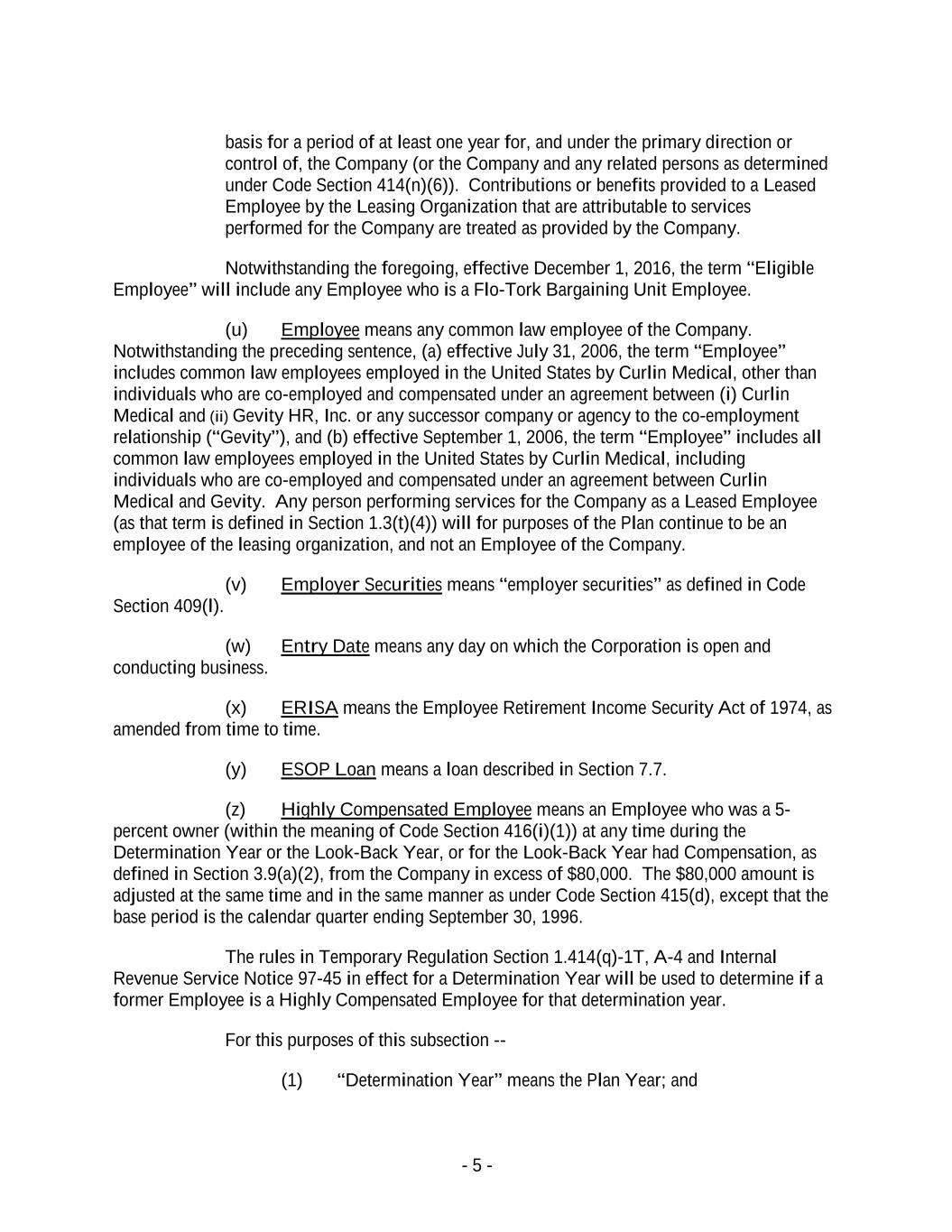
basis for a period of at least one year for, and under the primary direction or control of, the Company (or the Company and any related persons as determined under Code Section 414(n)(6)). Contributions or benefits provided to a Leased Employee by the Leasing Organization that are attributable to services performed for the Company are treated as provided by the Company. Notwithstanding the foregoing, effective December 1, 2016, the term “Eligible Employee” will include any Employee who is a Flo-Tork Bargaining Unit Employee. (u) Employee means any common law employee of the Company. Notwithstanding the preceding sentence, (a) effective July 31, 2006, the term “Employee” includes common law employees employed in the United States by Curlin Medical, other than individuals who are co-employed and compensated under an agreement between (i) Curlin Medical and (ii) Gevity HR, Inc. or any successor company or agency to the co-employment relationship (“Gevity”), and (b) effective September 1, 2006, the term “Employee” includes all common law employees employed in the United States by Curlin Medical, including individuals who are co-employed and compensated under an agreement between Curlin Medical and Gevity. Any person performing services for the Company as a Leased Employee (as that term is defined in Section 1.3(t)(4)) will for purposes of the Plan continue to be an employee of the leasing organization, and not an Employee of the Company. (v) Employer Securities means “employer securities” as defined in Code Section 409(l). (w) Entry Date means any day on which the Corporation is open and conducting business. (x) ERISA means the Employee Retirement Income Security Act of 1974, as amended from time to time. (y) ESOP Loan means a loan described in Section 7.7. (z) Highly Compensated Employee means an Employee who was a 5- percent owner (within the meaning of Code Section 416(i)(1)) at any time during the Determination Year or the Look-Back Year, or for the Look-Back Year had Compensation, as defined in Section 3.9(a)(2), from the Company in excess of $80,000. The $80,000 amount is adjusted at the same time and in the same manner as under Code Section 415(d), except that the base period is the calendar quarter ending September 30, 1996. The rules in Temporary Regulation Section 1.414(q)-1T, A-4 and Internal Revenue Service Notice 97-45 in effect for a Determination Year will be used to determine if a former Employee is a Highly Compensated Employee for that determination year. For this purposes of this subsection -- (1) “Determination Year” means the Plan Year; and - 5 -
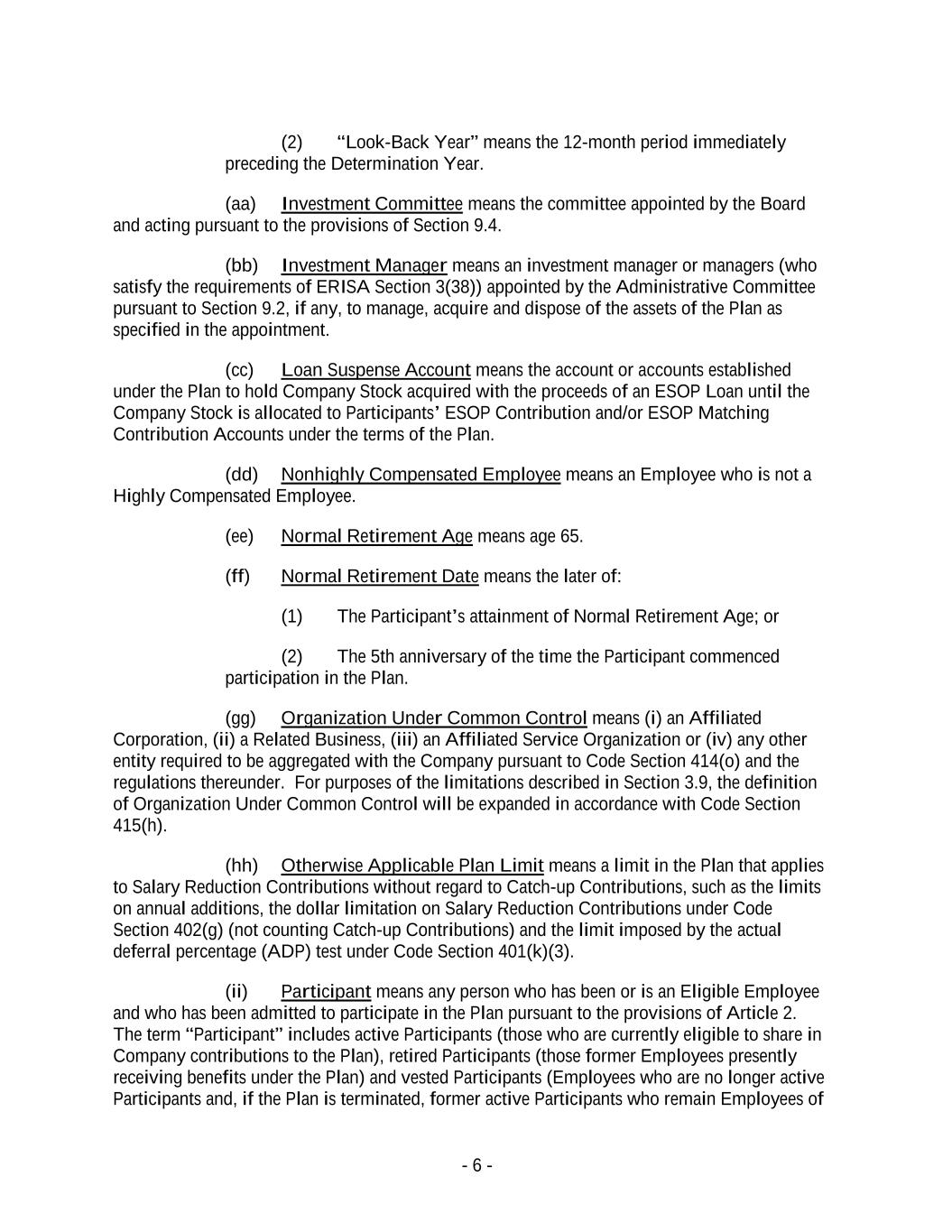
(2) “Look-Back Year” means the 12-month period immediately preceding the Determination Year. (aa) Investment Committee means the committee appointed by the Board and acting pursuant to the provisions of Section 9.4. (bb) Investment Manager means an investment manager or managers (who satisfy the requirements of ERISA Section 3(38)) appointed by the Administrative Committee pursuant to Section 9.2, if any, to manage, acquire and dispose of the assets of the Plan as specified in the appointment. (cc) Loan Suspense Account means the account or accounts established under the Plan to hold Company Stock acquired with the proceeds of an ESOP Loan until the Company Stock is allocated to Participants’ ESOP Contribution and/or ESOP Matching Contribution Accounts under the terms of the Plan. (dd) Nonhighly Compensated Employee means an Employee who is not a Highly Compensated Employee. (ee) Normal Retirement Age means age 65. (ff) Normal Retirement Date means the later of: (1) The Participant’s attainment of Normal Retirement Age; or (2) The 5th anniversary of the time the Participant commenced participation in the Plan. (gg) Organization Under Common Control means (i) an Affiliated Corporation, (ii) a Related Business, (iii) an Affiliated Service Organization or (iv) any other entity required to be aggregated with the Company pursuant to Code Section 414(o) and the regulations thereunder. For purposes of the limitations described in Section 3.9, the definition of Organization Under Common Control will be expanded in accordance with Code Section 415(h). (hh) Otherwise Applicable Plan Limit means a limit in the Plan that applies to Salary Reduction Contributions without regard to Catch-up Contributions, such as the limits on annual additions, the dollar limitation on Salary Reduction Contributions under Code Section 402(g) (not counting Catch-up Contributions) and the limit imposed by the actual deferral percentage (ADP) test under Code Section 401(k)(3). (ii) Participant means any person who has been or is an Eligible Employee and who has been admitted to participate in the Plan pursuant to the provisions of Article 2. The term “Participant” includes active Participants (those who are currently eligible to share in Company contributions to the Plan), retired Participants (those former Employees presently receiving benefits under the Plan) and vested Participants (Employees who are no longer active Participants and, if the Plan is terminated, former active Participants who remain Employees of - 6 -
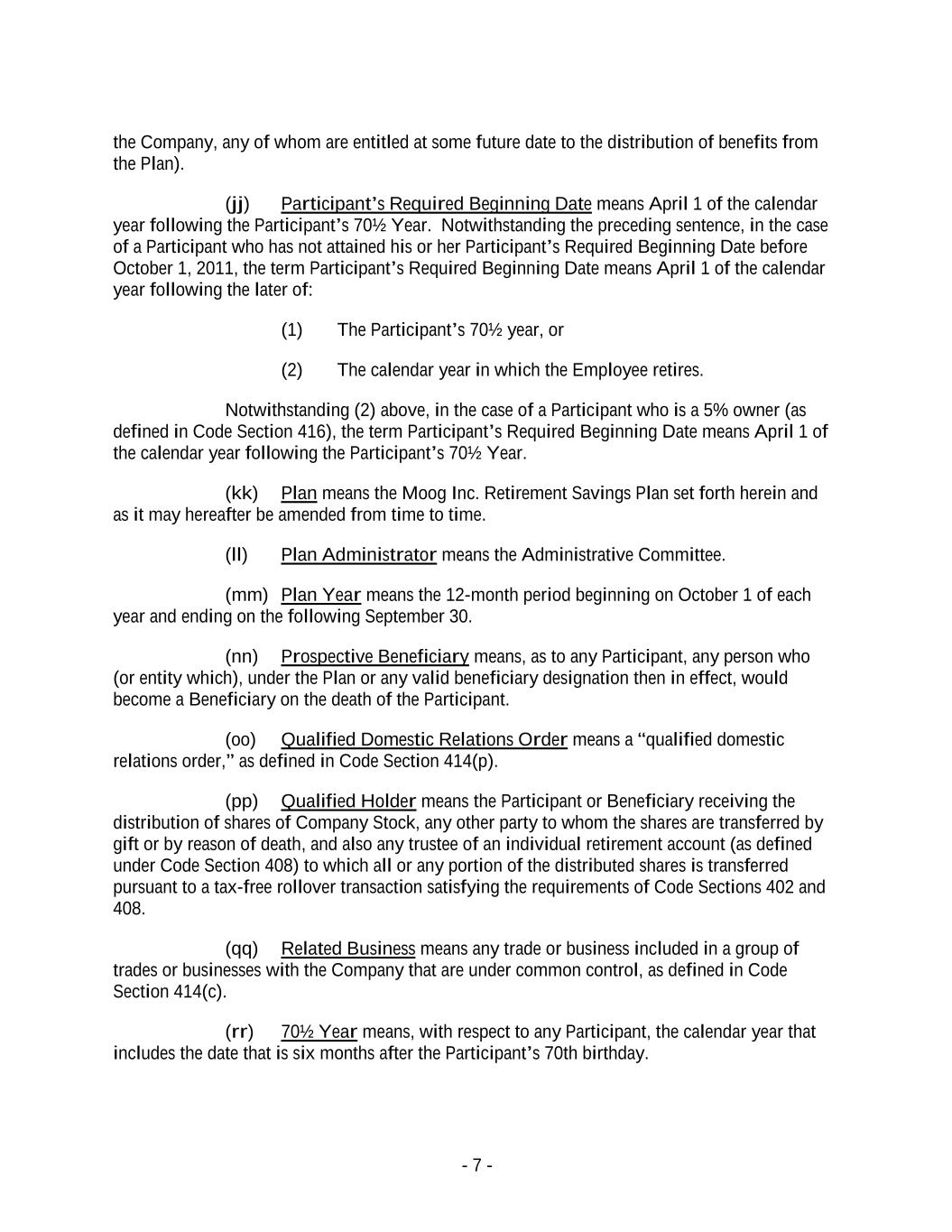
the Company, any of whom are entitled at some future date to the distribution of benefits from the Plan). (jj) Participant’s Required Beginning Date means April 1 of the calendar year following the Participant’s 70½ Year. Notwithstanding the preceding sentence, in the case of a Participant who has not attained his or her Participant’s Required Beginning Date before October 1, 2011, the term Participant’s Required Beginning Date means April 1 of the calendar year following the later of: (1) The Participant’s 70½ year, or (2) The calendar year in which the Employee retires. Notwithstanding (2) above, in the case of a Participant who is a 5% owner (as defined in Code Section 416), the term Participant’s Required Beginning Date means April 1 of the calendar year following the Participant’s 70½ Year. (kk) Plan means the Moog Inc. Retirement Savings Plan set forth herein and as it may hereafter be amended from time to time. (ll) Plan Administrator means the Administrative Committee. (mm) Plan Year means the 12-month period beginning on October 1 of each year and ending on the following September 30. (nn) Prospective Beneficiary means, as to any Participant, any person who (or entity which), under the Plan or any valid beneficiary designation then in effect, would become a Beneficiary on the death of the Participant. (oo) Qualified Domestic Relations Order means a “qualified domestic relations order,” as defined in Code Section 414(p). (pp) Qualified Holder means the Participant or Beneficiary receiving the distribution of shares of Company Stock, any other party to whom the shares are transferred by gift or by reason of death, and also any trustee of an individual retirement account (as defined under Code Section 408) to which all or any portion of the distributed shares is transferred pursuant to a tax-free rollover transaction satisfying the requirements of Code Sections 402 and 408. (qq) Related Business means any trade or business included in a group of trades or businesses with the Company that are under common control, as defined in Code Section 414(c). (rr) 70½ Year means, with respect to any Participant, the calendar year that includes the date that is six months after the Participant’s 70th birthday. - 7 -
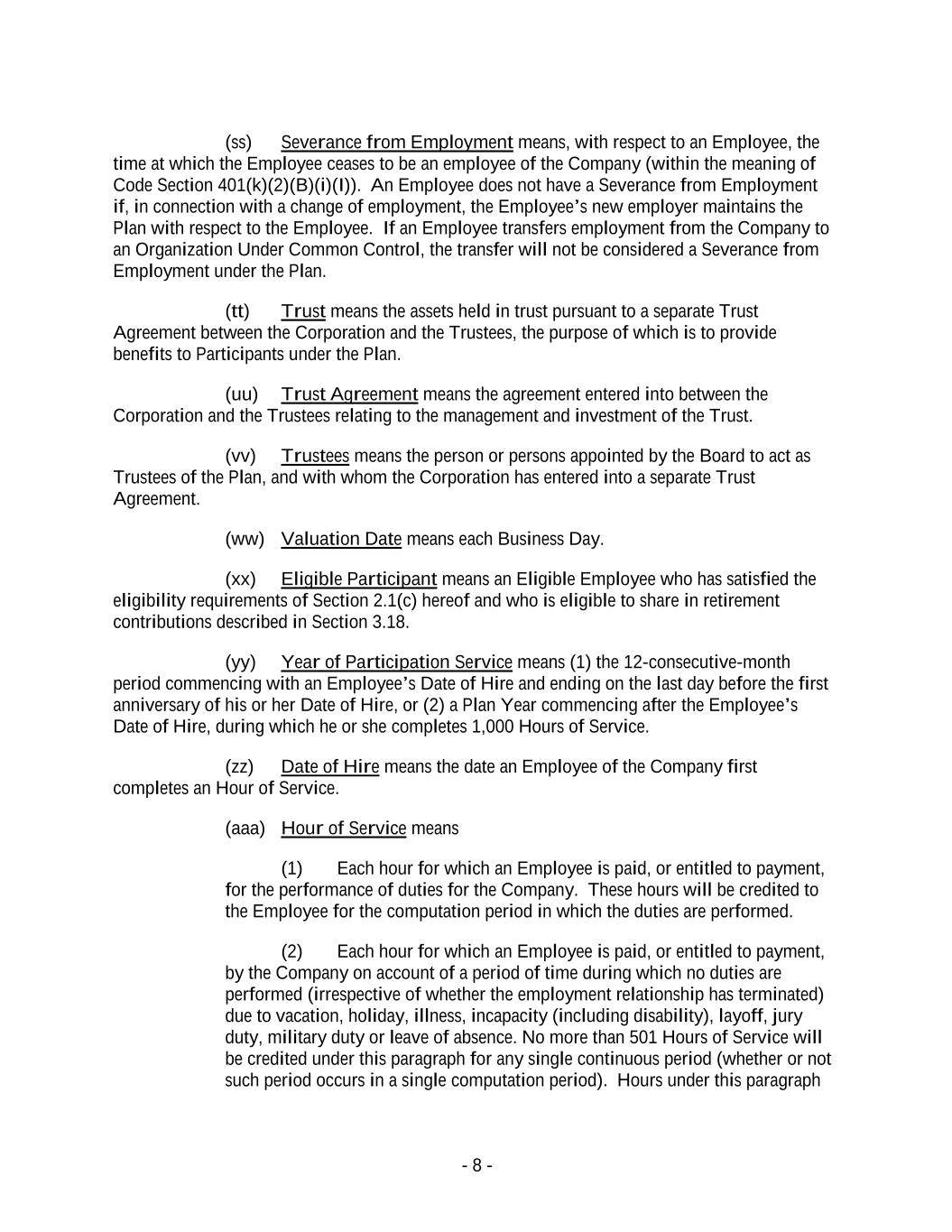
(ss) Severance from Employment means, with respect to an Employee, the time at which the Employee ceases to be an employee of the Company (within the meaning of Code Section 401(k)(2)(B)(i)(I)). An Employee does not have a Severance from Employment if, in connection with a change of employment, the Employee’s new employer maintains the Plan with respect to the Employee. If an Employee transfers employment from the Company to an Organization Under Common Control, the transfer will not be considered a Severance from Employment under the Plan. (tt) Trust means the assets held in trust pursuant to a separate Trust Agreement between the Corporation and the Trustees, the purpose of which is to provide benefits to Participants under the Plan. (uu) Trust Agreement means the agreement entered into between the Corporation and the Trustees relating to the management and investment of the Trust. (vv) Trustees means the person or persons appointed by the Board to act as Trustees of the Plan, and with whom the Corporation has entered into a separate Trust Agreement. (ww) Valuation Date means each Business Day. (xx) Eligible Participant means an Eligible Employee who has satisfied the eligibility requirements of Section 2.1(c) hereof and who is eligible to share in retirement contributions described in Section 3.18. (yy) Year of Participation Service means (1) the 12-consecutive-month period commencing with an Employee’s Date of Hire and ending on the last day before the first anniversary of his or her Date of Hire, or (2) a Plan Year commencing after the Employee’s Date of Hire, during which he or she completes 1,000 Hours of Service. (zz) Date of Hire means the date an Employee of the Company first completes an Hour of Service. (aaa) Hour of Service means (1) Each hour for which an Employee is paid, or entitled to payment, for the performance of duties for the Company. These hours will be credited to the Employee for the computation period in which the duties are performed. (2) Each hour for which an Employee is paid, or entitled to payment, by the Company on account of a period of time during which no duties are performed (irrespective of whether the employment relationship has terminated) due to vacation, holiday, illness, incapacity (including disability), layoff, jury duty, military duty or leave of absence. No more than 501 Hours of Service will be credited under this paragraph for any single continuous period (whether or not such period occurs in a single computation period). Hours under this paragraph - 8 -
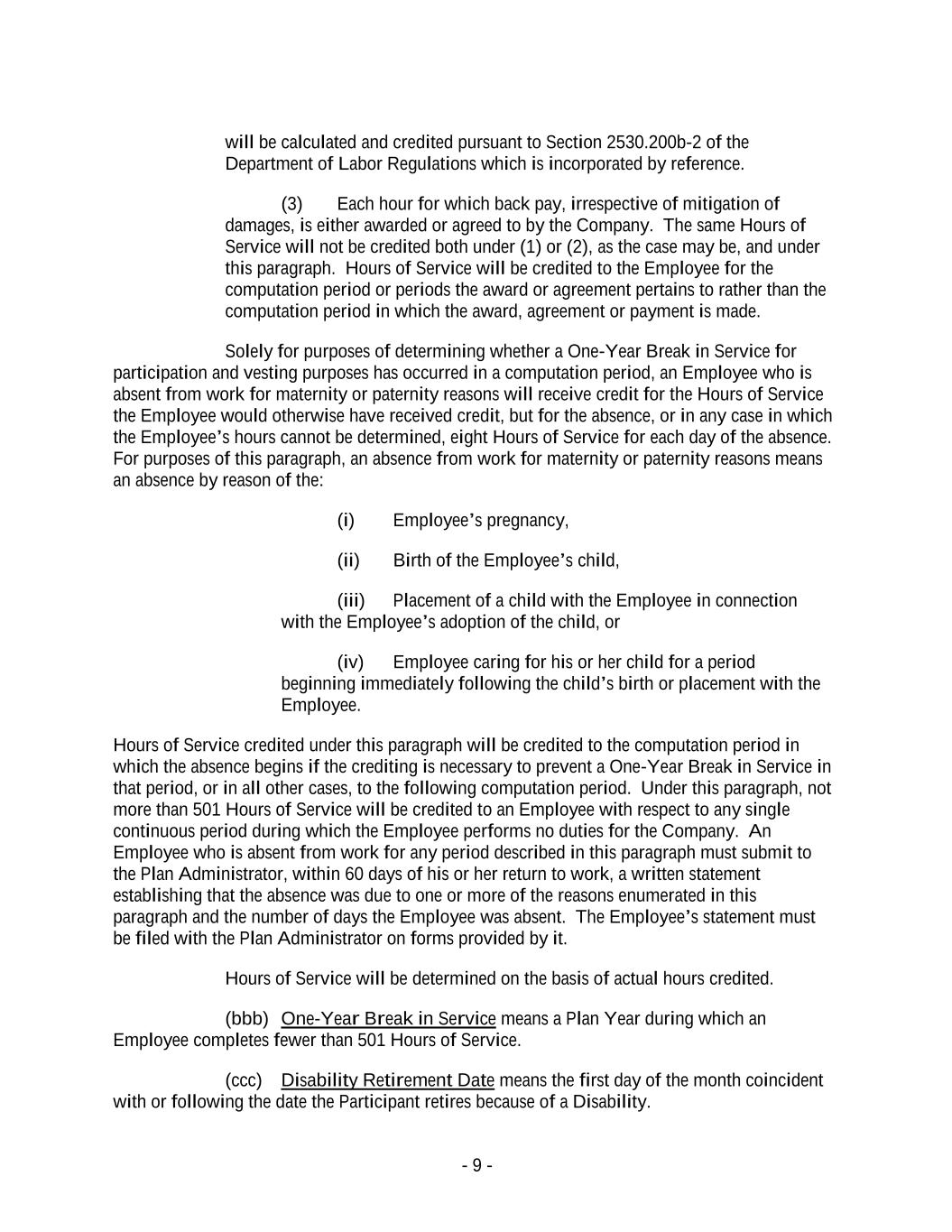
will be calculated and credited pursuant to Section 2530.200b-2 of the Department of Labor Regulations which is incorporated by reference. (3) Each hour for which back pay, irrespective of mitigation of damages, is either awarded or agreed to by the Company. The same Hours of Service will not be credited both under (1) or (2), as the case may be, and under this paragraph. Hours of Service will be credited to the Employee for the computation period or periods the award or agreement pertains to rather than the computation period in which the award, agreement or payment is made. Solely for purposes of determining whether a One-Year Break in Service for participation and vesting purposes has occurred in a computation period, an Employee who is absent from work for maternity or paternity reasons will receive credit for the Hours of Service the Employee would otherwise have received credit, but for the absence, or in any case in which the Employee’s hours cannot be determined, eight Hours of Service for each day of the absence. For purposes of this paragraph, an absence from work for maternity or paternity reasons means an absence by reason of the: (i) Employee’s pregnancy, (ii) Birth of the Employee’s child, (iii) Placement of a child with the Employee in connection with the Employee’s adoption of the child, or (iv) Employee caring for his or her child for a period beginning immediately following the child’s birth or placement with the Employee. Hours of Service credited under this paragraph will be credited to the computation period in which the absence begins if the crediting is necessary to prevent a One-Year Break in Service in that period, or in all other cases, to the following computation period. Under this paragraph, not more than 501 Hours of Service will be credited to an Employee with respect to any single continuous period during which the Employee performs no duties for the Company. An Employee who is absent from work for any period described in this paragraph must submit to the Plan Administrator, within 60 days of his or her return to work, a written statement establishing that the absence was due to one or more of the reasons enumerated in this paragraph and the number of days the Employee was absent. The Employee’s statement must be filed with the Plan Administrator on forms provided by it. Hours of Service will be determined on the basis of actual hours credited. (bbb) One-Year Break in Service means a Plan Year during which an Employee completes fewer than 501 Hours of Service. (ccc) Disability Retirement Date means the first day of the month coincident with or following the date the Participant retires because of a Disability. - 9 -

(ddd) Flo-Tork Bargaining Unit Employee means an Employee who is (i) employed by the Company’s Moog Flo-Tork division, (ii) compensated on an hourly basis, and (iii) included in a unit of employees covered by a collective bargaining agreement between the Company and employee representatives (within the meaning of Code Section 7701(a)(46)), the terms of which provide for participation in the Plan. (eee) Flo-Tork DB Plan means the Flo-Tork, Inc. Defined Benefit Plan and Trust. (fff) Moog ERP means the Moog Inc. Employees’ Retirement Plan. - 10 -

ARTICLE 2 ELIGIBILITY FOR PARTICIPATION Section 2.1 Eligibility Requirements. The requirements for eligibility to participate in the Plan are as follows: (a) Each Eligible Employee who was a Participant in the Plan on March 31, 2008 will continue to be a Participant in the Plan. (b) Each other Eligible Employee will become a Participant and will be eligible to make Salary Reduction Contributions, receive Matching Contributions and to participate in ESOP Contributions, on the first Entry Date after he or she commences employment with the Company. Notwithstanding the foregoing, an Eligible Employee who is a Flo-Tork Bargaining Unit Employee (1) will be eligible to make Salary Reduction Contributions and receive Matching Contributions on the first Entry Date following the later of (x) the date he or she commences employment with the Company or (y) November 30, 2016, and (2) will not be eligible to participate in any ESOP Contributions at any time. (c) Subject to the provisions of Section 3.18, an Eligible Employee is eligible to become an Eligible Participant on the first day of the first administratively practicable payroll period following the later of: (1) his or her completion of one Year of Participation Service or (2) March 31, 2008. Notwithstanding the foregoing, an Eligible Employee who is a Flo-Tork Bargaining Unit Employee is eligible to become an Eligible Participant on the first day of the first administratively practicable payroll period following the later of: (1) his or her completion of one Year of Participation Service, or (2) November 30, 2016. Section 2.2 Change in Employment Status. (a) Employee Becomes Eligible Employee. If an Employee’s status changes so that he or she becomes an Eligible Employee, he or she will become a Participant on the first Entry Date after the status change occurs, and will become an Eligible Participant on the later of the first day of the first administratively practicable payroll period following his or her satisfaction of the service requirements in Section 2.1(c) or the date of the change in status. (b) Participant Becomes a Non-Eligible Employee. If a Participant’s employment status changes so that he or she is no longer an Eligible Employee, the Participant is not entitled to make Salary Reduction Contributions or to share in any ESOP, Matching or Retirement Contributions with respect to any Compensation earned while he or she is not an Eligible Employee. Section 2.3 Termination and Resumption of Participation. (a) Termination of Participation. Except as otherwise provided by this Section, an Eligible Employee who is a Participant will remain a Participant until (1) the date - 11 -
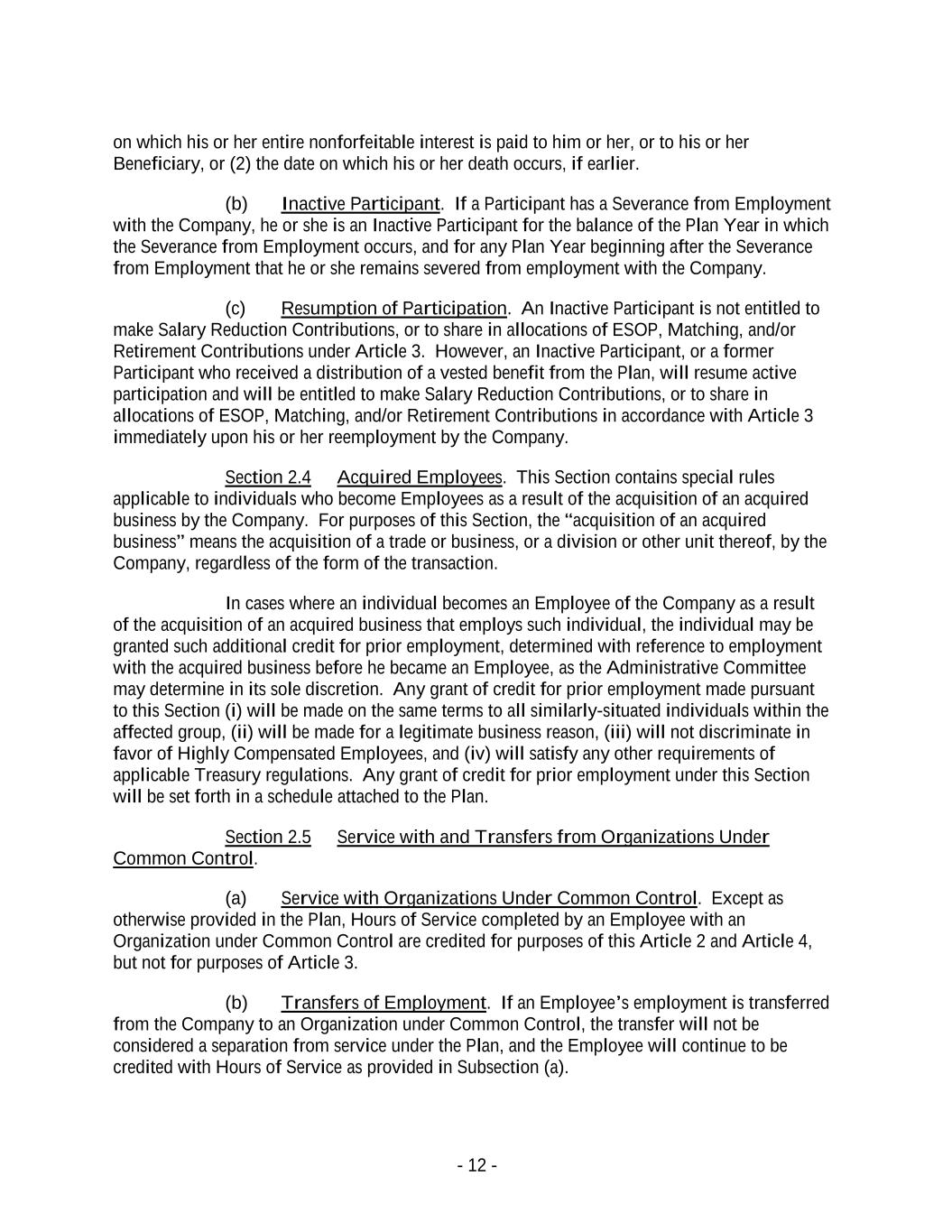
on which his or her entire nonforfeitable interest is paid to him or her, or to his or her Beneficiary, or (2) the date on which his or her death occurs, if earlier. (b) Inactive Participant. If a Participant has a Severance from Employment with the Company, he or she is an Inactive Participant for the balance of the Plan Year in which the Severance from Employment occurs, and for any Plan Year beginning after the Severance from Employment that he or she remains severed from employment with the Company. (c) Resumption of Participation. An Inactive Participant is not entitled to make Salary Reduction Contributions, or to share in allocations of ESOP, Matching, and/or Retirement Contributions under Article 3. However, an Inactive Participant, or a former Participant who received a distribution of a vested benefit from the Plan, will resume active participation and will be entitled to make Salary Reduction Contributions, or to share in allocations of ESOP, Matching, and/or Retirement Contributions in accordance with Article 3 immediately upon his or her reemployment by the Company. Section 2.4 Acquired Employees. This Section contains special rules applicable to individuals who become Employees as a result of the acquisition of an acquired business by the Company. For purposes of this Section, the “acquisition of an acquired business” means the acquisition of a trade or business, or a division or other unit thereof, by the Company, regardless of the form of the transaction. In cases where an individual becomes an Employee of the Company as a result of the acquisition of an acquired business that employs such individual, the individual may be granted such additional credit for prior employment, determined with reference to employment with the acquired business before he became an Employee, as the Administrative Committee may determine in its sole discretion. Any grant of credit for prior employment made pursuant to this Section (i) will be made on the same terms to all similarly-situated individuals within the affected group, (ii) will be made for a legitimate business reason, (iii) will not discriminate in favor of Highly Compensated Employees, and (iv) will satisfy any other requirements of applicable Treasury regulations. Any grant of credit for prior employment under this Section will be set forth in a schedule attached to the Plan. Section 2.5 Service with and Transfers from Organizations Under Common Control. (a) Service with Organizations Under Common Control. Except as otherwise provided in the Plan, Hours of Service completed by an Employee with an Organization under Common Control are credited for purposes of this Article 2 and Article 4, but not for purposes of Article 3. (b) Transfers of Employment. If an Employee’s employment is transferred from the Company to an Organization under Common Control, the transfer will not be considered a separation from service under the Plan, and the Employee will continue to be credited with Hours of Service as provided in Subsection (a). - 12 -
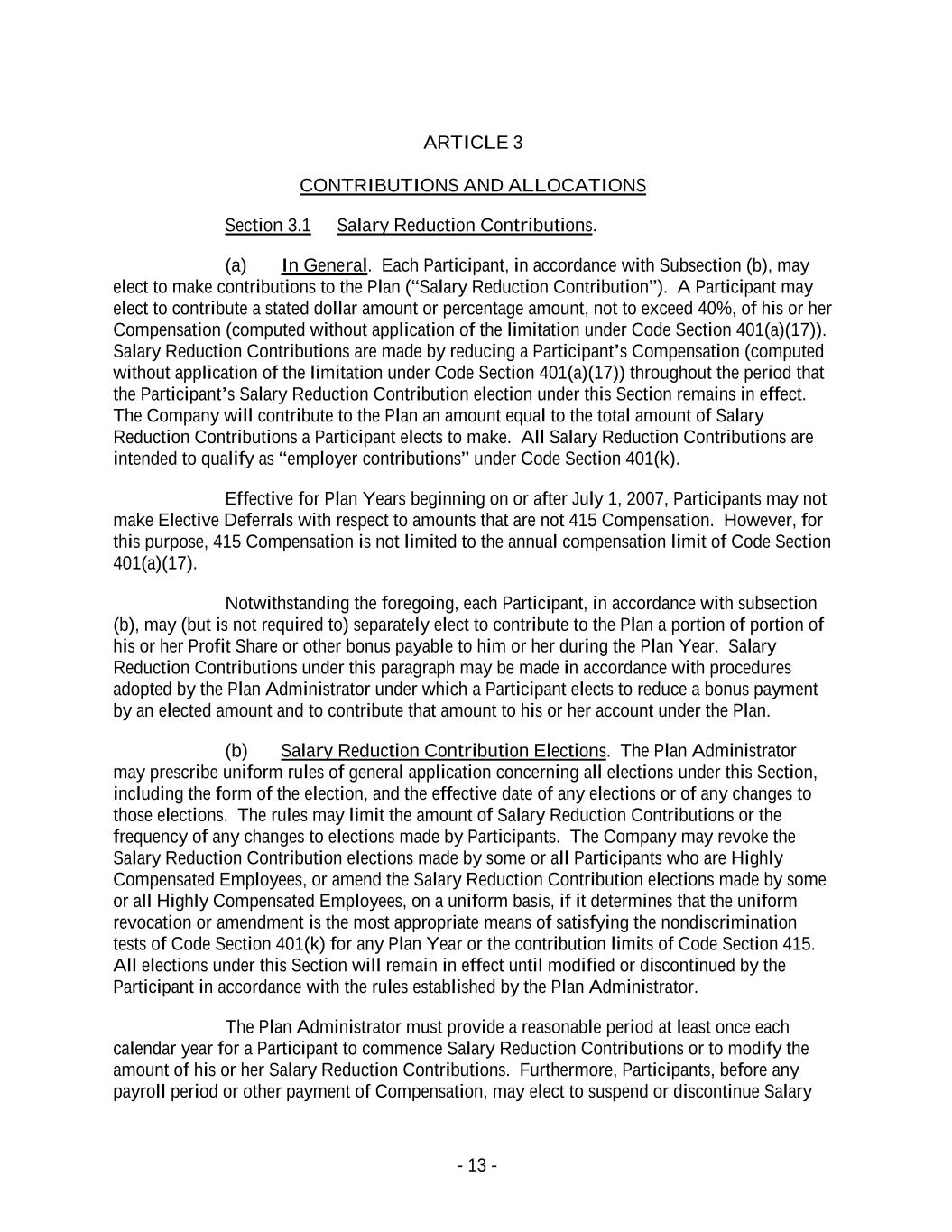
ARTICLE 3 CONTRIBUTIONS AND ALLOCATIONS Section 3.1 Salary Reduction Contributions. (a) In General. Each Participant, in accordance with Subsection (b), may elect to make contributions to the Plan (“Salary Reduction Contribution”). A Participant may elect to contribute a stated dollar amount or percentage amount, not to exceed 40%, of his or her Compensation (computed without application of the limitation under Code Section 401(a)(17)). Salary Reduction Contributions are made by reducing a Participant’s Compensation (computed without application of the limitation under Code Section 401(a)(17)) throughout the period that the Participant’s Salary Reduction Contribution election under this Section remains in effect. The Company will contribute to the Plan an amount equal to the total amount of Salary Reduction Contributions a Participant elects to make. All Salary Reduction Contributions are intended to qualify as “employer contributions” under Code Section 401(k). Effective for Plan Years beginning on or after July 1, 2007, Participants may not make Elective Deferrals with respect to amounts that are not 415 Compensation. However, for this purpose, 415 Compensation is not limited to the annual compensation limit of Code Section 401(a)(17). Notwithstanding the foregoing, each Participant, in accordance with subsection (b), may (but is not required to) separately elect to contribute to the Plan a portion of portion of his or her Profit Share or other bonus payable to him or her during the Plan Year. Salary Reduction Contributions under this paragraph may be made in accordance with procedures adopted by the Plan Administrator under which a Participant elects to reduce a bonus payment by an elected amount and to contribute that amount to his or her account under the Plan. (b) Salary Reduction Contribution Elections. The Plan Administrator may prescribe uniform rules of general application concerning all elections under this Section, including the form of the election, and the effective date of any elections or of any changes to those elections. The rules may limit the amount of Salary Reduction Contributions or the frequency of any changes to elections made by Participants. The Company may revoke the Salary Reduction Contribution elections made by some or all Participants who are Highly Compensated Employees, or amend the Salary Reduction Contribution elections made by some or all Highly Compensated Employees, on a uniform basis, if it determines that the uniform revocation or amendment is the most appropriate means of satisfying the nondiscrimination tests of Code Section 401(k) for any Plan Year or the contribution limits of Code Section 415. All elections under this Section will remain in effect until modified or discontinued by the Participant in accordance with the rules established by the Plan Administrator. The Plan Administrator must provide a reasonable period at least once each calendar year for a Participant to commence Salary Reduction Contributions or to modify the amount of his or her Salary Reduction Contributions. Furthermore, Participants, before any payroll period or other payment of Compensation, may elect to suspend or discontinue Salary - 13 -
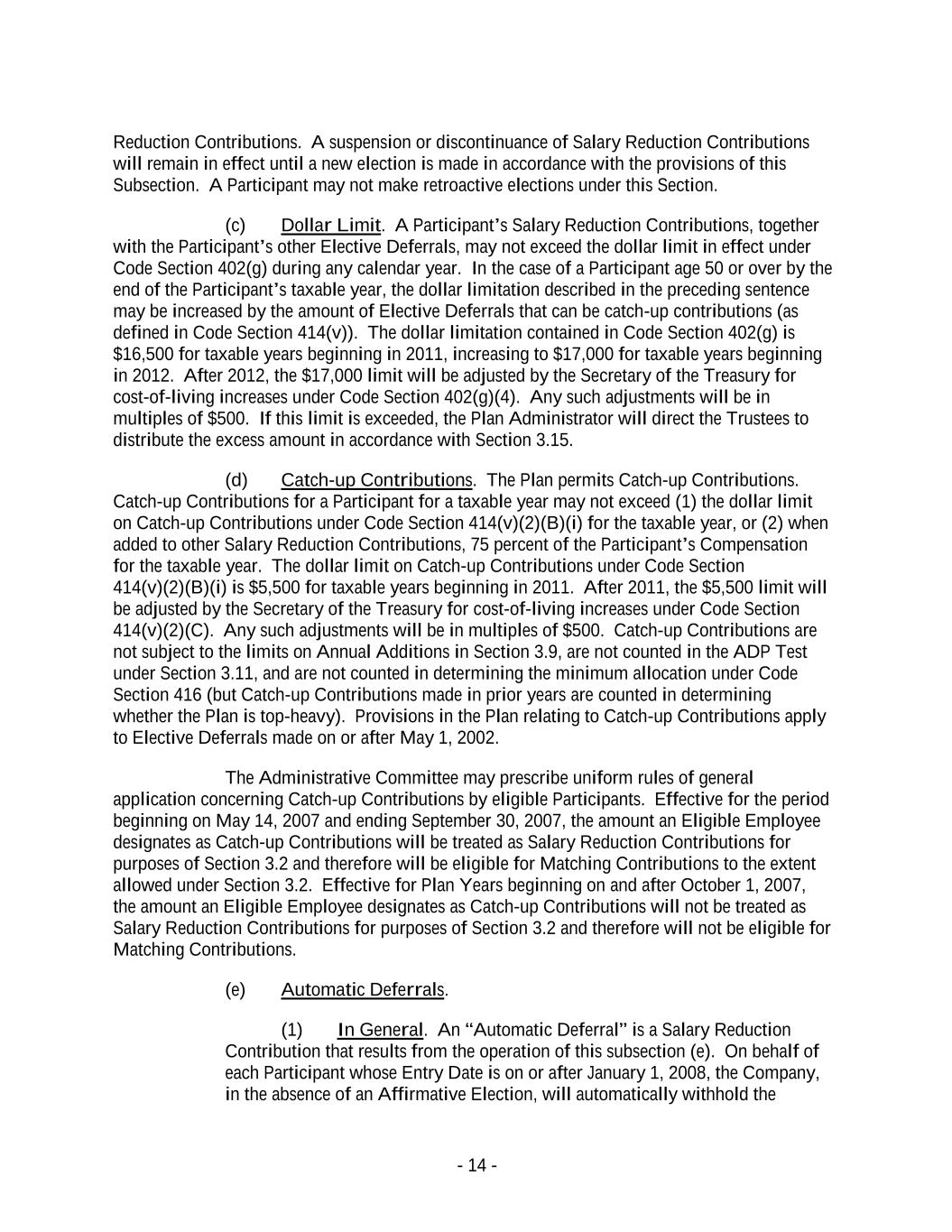
Reduction Contributions. A suspension or discontinuance of Salary Reduction Contributions will remain in effect until a new election is made in accordance with the provisions of this Subsection. A Participant may not make retroactive elections under this Section. (c) Dollar Limit. A Participant’s Salary Reduction Contributions, together with the Participant’s other Elective Deferrals, may not exceed the dollar limit in effect under Code Section 402(g) during any calendar year. In the case of a Participant age 50 or over by the end of the Participant’s taxable year, the dollar limitation described in the preceding sentence may be increased by the amount of Elective Deferrals that can be catch-up contributions (as defined in Code Section 414(v)). The dollar limitation contained in Code Section 402(g) is $16,500 for taxable years beginning in 2011, increasing to $17,000 for taxable years beginning in 2012. After 2012, the $17,000 limit will be adjusted by the Secretary of the Treasury for cost-of-living increases under Code Section 402(g)(4). Any such adjustments will be in multiples of $500. If this limit is exceeded, the Plan Administrator will direct the Trustees to distribute the excess amount in accordance with Section 3.15. (d) Catch-up Contributions. The Plan permits Catch-up Contributions. Catch-up Contributions for a Participant for a taxable year may not exceed (1) the dollar limit on Catch-up Contributions under Code Section 414(v)(2)(B)(i) for the taxable year, or (2) when added to other Salary Reduction Contributions, 75 percent of the Participant’s Compensation for the taxable year. The dollar limit on Catch-up Contributions under Code Section 414(v)(2)(B)(i) is $5,500 for taxable years beginning in 2011. After 2011, the $5,500 limit will be adjusted by the Secretary of the Treasury for cost-of-living increases under Code Section 414(v)(2)(C). Any such adjustments will be in multiples of $500. Catch-up Contributions are not subject to the limits on Annual Additions in Section 3.9, are not counted in the ADP Test under Section 3.11, and are not counted in determining the minimum allocation under Code Section 416 (but Catch-up Contributions made in prior years are counted in determining whether the Plan is top-heavy). Provisions in the Plan relating to Catch-up Contributions apply to Elective Deferrals made on or after May 1, 2002. The Administrative Committee may prescribe uniform rules of general application concerning Catch-up Contributions by eligible Participants. Effective for the period beginning on May 14, 2007 and ending September 30, 2007, the amount an Eligible Employee designates as Catch-up Contributions will be treated as Salary Reduction Contributions for purposes of Section 3.2 and therefore will be eligible for Matching Contributions to the extent allowed under Section 3.2. Effective for Plan Years beginning on and after October 1, 2007, the amount an Eligible Employee designates as Catch-up Contributions will not be treated as Salary Reduction Contributions for purposes of Section 3.2 and therefore will not be eligible for Matching Contributions. (e) Automatic Deferrals. (1) In General. An “Automatic Deferral” is a Salary Reduction Contribution that results from the operation of this subsection (e). On behalf of each Participant whose Entry Date is on or after January 1, 2008, the Company, in the absence of an Affirmative Election, will automatically withhold the - 14 -
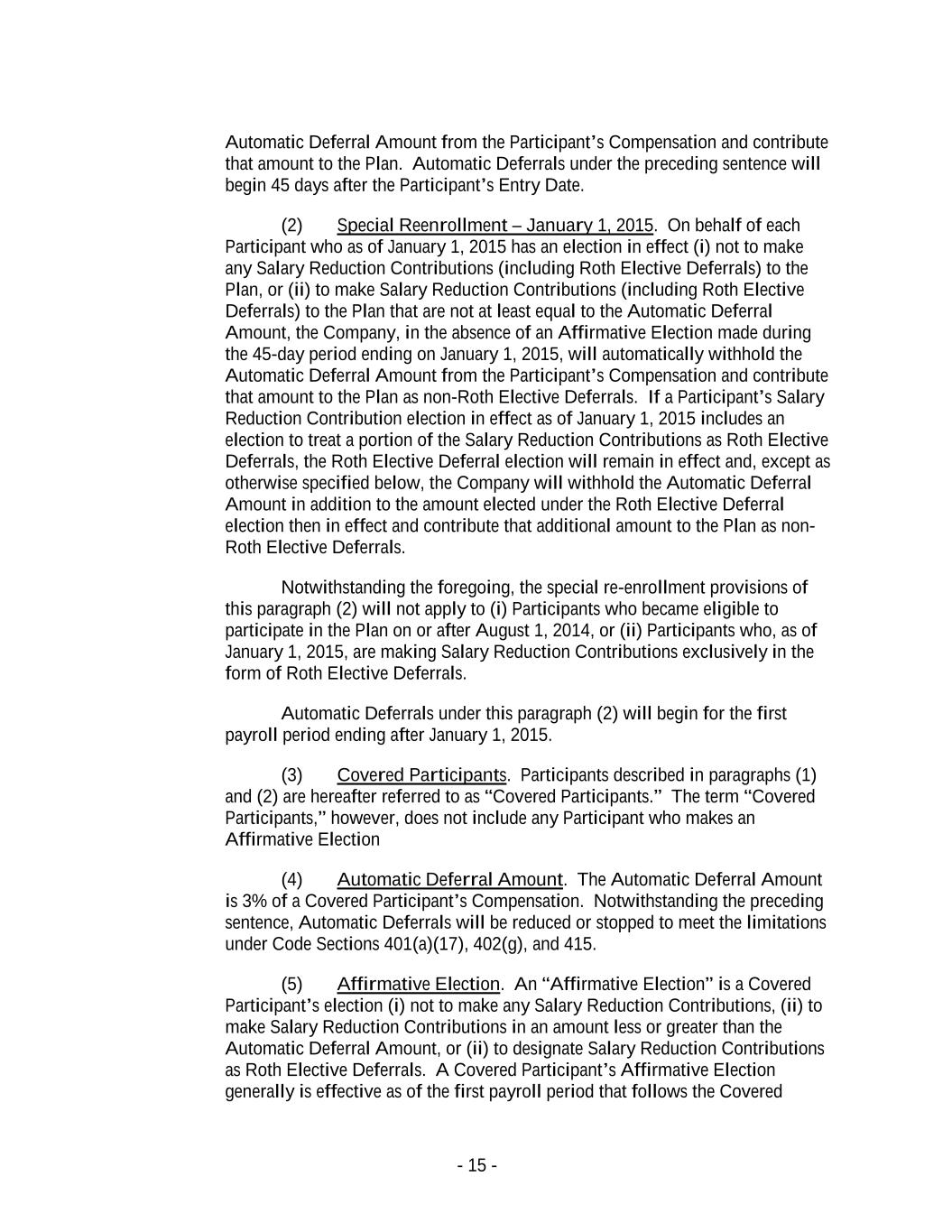
Automatic Deferral Amount from the Participant’s Compensation and contribute that amount to the Plan. Automatic Deferrals under the preceding sentence will begin 45 days after the Participant’s Entry Date. (2) Special Reenrollment – January 1, 2015. On behalf of each Participant who as of January 1, 2015 has an election in effect (i) not to make any Salary Reduction Contributions (including Roth Elective Deferrals) to the Plan, or (ii) to make Salary Reduction Contributions (including Roth Elective Deferrals) to the Plan that are not at least equal to the Automatic Deferral Amount, the Company, in the absence of an Affirmative Election made during the 45-day period ending on January 1, 2015, will automatically withhold the Automatic Deferral Amount from the Participant’s Compensation and contribute that amount to the Plan as non-Roth Elective Deferrals. If a Participant’s Salary Reduction Contribution election in effect as of January 1, 2015 includes an election to treat a portion of the Salary Reduction Contributions as Roth Elective Deferrals, the Roth Elective Deferral election will remain in effect and, except as otherwise specified below, the Company will withhold the Automatic Deferral Amount in addition to the amount elected under the Roth Elective Deferral election then in effect and contribute that additional amount to the Plan as non- Roth Elective Deferrals. Notwithstanding the foregoing, the special re-enrollment provisions of this paragraph (2) will not apply to (i) Participants who became eligible to participate in the Plan on or after August 1, 2014, or (ii) Participants who, as of January 1, 2015, are making Salary Reduction Contributions exclusively in the form of Roth Elective Deferrals. Automatic Deferrals under this paragraph (2) will begin for the first payroll period ending after January 1, 2015. (3) Covered Participants. Participants described in paragraphs (1) and (2) are hereafter referred to as “Covered Participants.” The term “Covered Participants,” however, does not include any Participant who makes an Affirmative Election (4) Automatic Deferral Amount. The Automatic Deferral Amount is 3% of a Covered Participant’s Compensation. Notwithstanding the preceding sentence, Automatic Deferrals will be reduced or stopped to meet the limitations under Code Sections 401(a)(17), 402(g), and 415. (5) Affirmative Election. An “Affirmative Election” is a Covered Participant’s election (i) not to make any Salary Reduction Contributions, (ii) to make Salary Reduction Contributions in an amount less or greater than the Automatic Deferral Amount, or (ii) to designate Salary Reduction Contributions as Roth Elective Deferrals. A Covered Participant’s Affirmative Election generally is effective as of the first payroll period that follows the Covered - 15 -
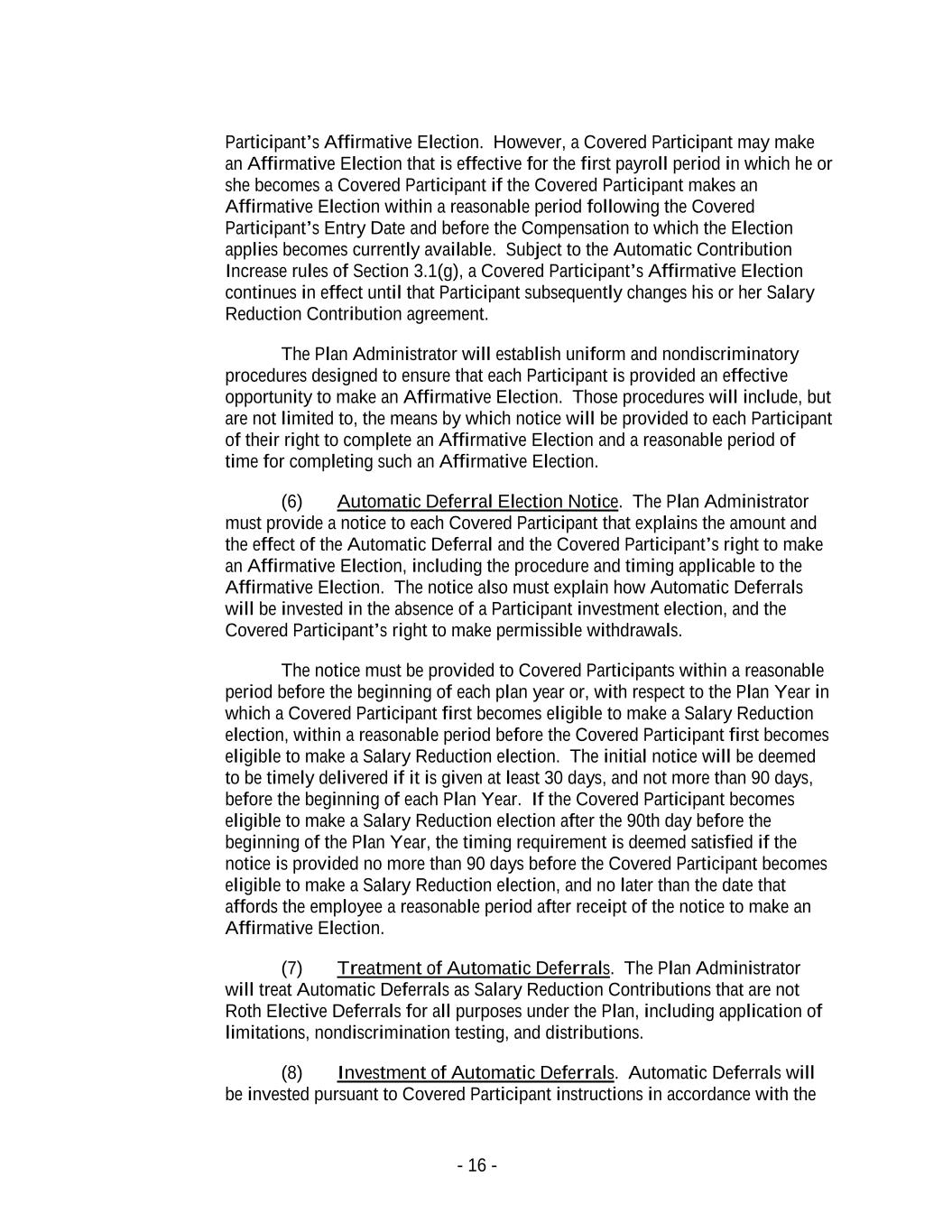
Participant’s Affirmative Election. However, a Covered Participant may make an Affirmative Election that is effective for the first payroll period in which he or she becomes a Covered Participant if the Covered Participant makes an Affirmative Election within a reasonable period following the Covered Participant’s Entry Date and before the Compensation to which the Election applies becomes currently available. Subject to the Automatic Contribution Increase rules of Section 3.1(g), a Covered Participant’s Affirmative Election continues in effect until that Participant subsequently changes his or her Salary Reduction Contribution agreement. The Plan Administrator will establish uniform and nondiscriminatory procedures designed to ensure that each Participant is provided an effective opportunity to make an Affirmative Election. Those procedures will include, but are not limited to, the means by which notice will be provided to each Participant of their right to complete an Affirmative Election and a reasonable period of time for completing such an Affirmative Election. (6) Automatic Deferral Election Notice. The Plan Administrator must provide a notice to each Covered Participant that explains the amount and the effect of the Automatic Deferral and the Covered Participant’s right to make an Affirmative Election, including the procedure and timing applicable to the Affirmative Election. The notice also must explain how Automatic Deferrals will be invested in the absence of a Participant investment election, and the Covered Participant’s right to make permissible withdrawals. The notice must be provided to Covered Participants within a reasonable period before the beginning of each plan year or, with respect to the Plan Year in which a Covered Participant first becomes eligible to make a Salary Reduction election, within a reasonable period before the Covered Participant first becomes eligible to make a Salary Reduction election. The initial notice will be deemed to be timely delivered if it is given at least 30 days, and not more than 90 days, before the beginning of each Plan Year. If the Covered Participant becomes eligible to make a Salary Reduction election after the 90th day before the beginning of the Plan Year, the timing requirement is deemed satisfied if the notice is provided no more than 90 days before the Covered Participant becomes eligible to make a Salary Reduction election, and no later than the date that affords the employee a reasonable period after receipt of the notice to make an Affirmative Election. (7) Treatment of Automatic Deferrals. The Plan Administrator will treat Automatic Deferrals as Salary Reduction Contributions that are not Roth Elective Deferrals for all purposes under the Plan, including application of limitations, nondiscrimination testing, and distributions. (8) Investment of Automatic Deferrals. Automatic Deferrals will be invested pursuant to Covered Participant instructions in accordance with the - 16 -
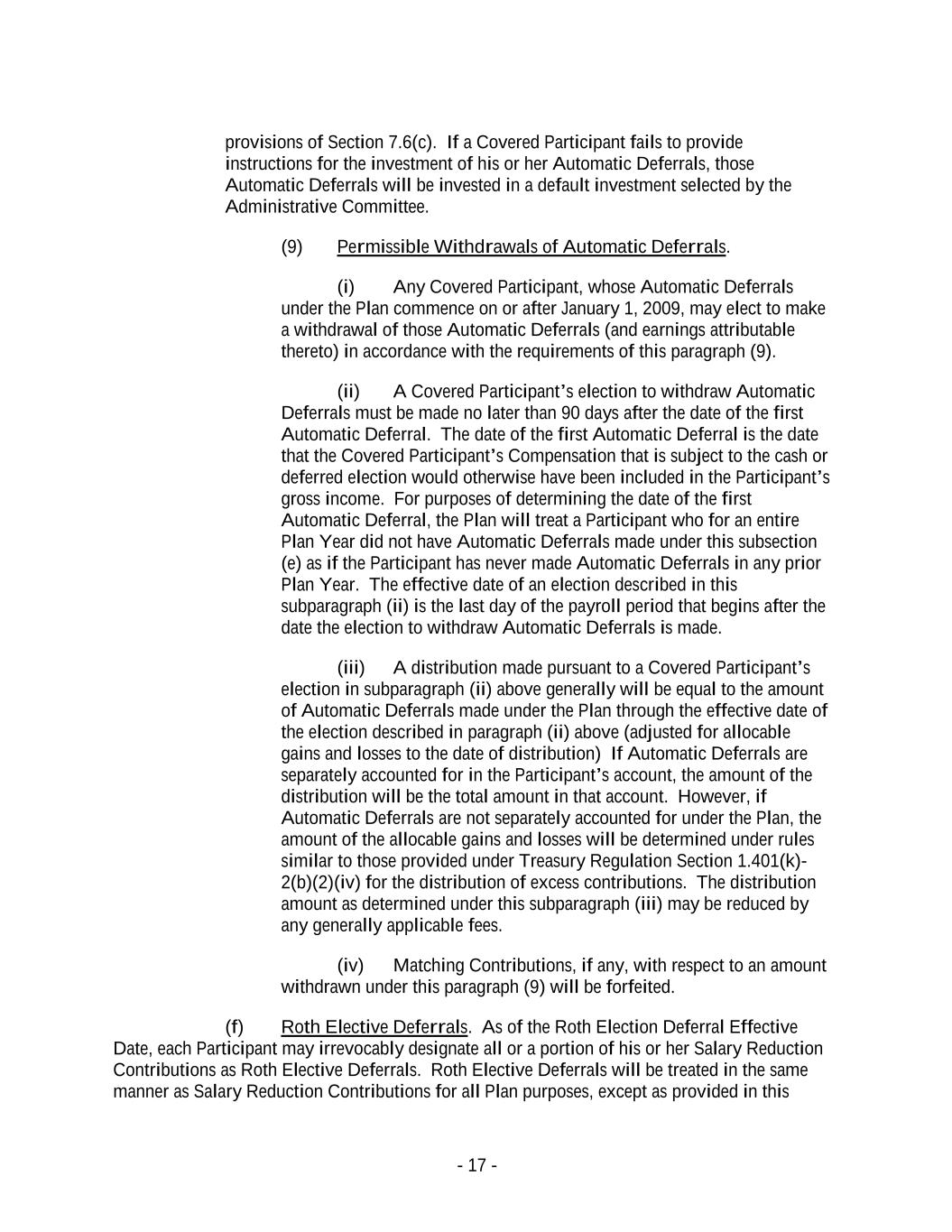
provisions of Section 7.6(c). If a Covered Participant fails to provide instructions for the investment of his or her Automatic Deferrals, those Automatic Deferrals will be invested in a default investment selected by the Administrative Committee. (9) Permissible Withdrawals of Automatic Deferrals. (i) Any Covered Participant, whose Automatic Deferrals under the Plan commence on or after January 1, 2009, may elect to make a withdrawal of those Automatic Deferrals (and earnings attributable thereto) in accordance with the requirements of this paragraph (9). (ii) A Covered Participant’s election to withdraw Automatic Deferrals must be made no later than 90 days after the date of the first Automatic Deferral. The date of the first Automatic Deferral is the date that the Covered Participant’s Compensation that is subject to the cash or deferred election would otherwise have been included in the Participant’s gross income. For purposes of determining the date of the first Automatic Deferral, the Plan will treat a Participant who for an entire Plan Year did not have Automatic Deferrals made under this subsection (e) as if the Participant has never made Automatic Deferrals in any prior Plan Year. The effective date of an election described in this subparagraph (ii) is the last day of the payroll period that begins after the date the election to withdraw Automatic Deferrals is made. (iii) A distribution made pursuant to a Covered Participant’s election in subparagraph (ii) above generally will be equal to the amount of Automatic Deferrals made under the Plan through the effective date of the election described in paragraph (ii) above (adjusted for allocable gains and losses to the date of distribution) If Automatic Deferrals are separately accounted for in the Participant’s account, the amount of the distribution will be the total amount in that account. However, if Automatic Deferrals are not separately accounted for under the Plan, the amount of the allocable gains and losses will be determined under rules similar to those provided under Treasury Regulation Section 1.401(k)- 2(b)(2)(iv) for the distribution of excess contributions. The distribution amount as determined under this subparagraph (iii) may be reduced by any generally applicable fees. (iv) Matching Contributions, if any, with respect to an amount withdrawn under this paragraph (9) will be forfeited. (f) Roth Elective Deferrals. As of the Roth Election Deferral Effective Date, each Participant may irrevocably designate all or a portion of his or her Salary Reduction Contributions as Roth Elective Deferrals. Roth Elective Deferrals will be treated in the same manner as Salary Reduction Contributions for all Plan purposes, except as provided in this - 17 -
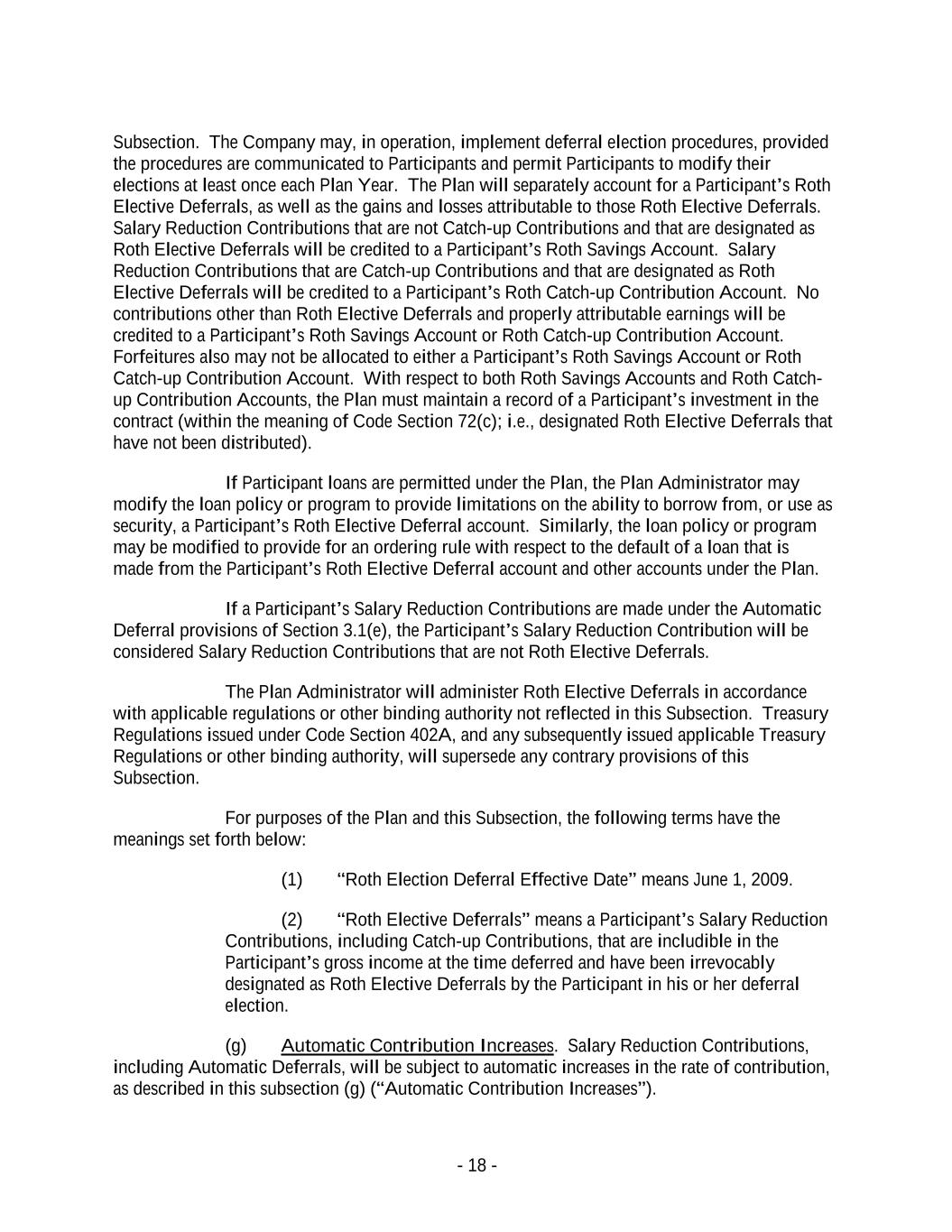
Subsection. The Company may, in operation, implement deferral election procedures, provided the procedures are communicated to Participants and permit Participants to modify their elections at least once each Plan Year. The Plan will separately account for a Participant’s Roth Elective Deferrals, as well as the gains and losses attributable to those Roth Elective Deferrals. Salary Reduction Contributions that are not Catch-up Contributions and that are designated as Roth Elective Deferrals will be credited to a Participant’s Roth Savings Account. Salary Reduction Contributions that are Catch-up Contributions and that are designated as Roth Elective Deferrals will be credited to a Participant’s Roth Catch-up Contribution Account. No contributions other than Roth Elective Deferrals and properly attributable earnings will be credited to a Participant’s Roth Savings Account or Roth Catch-up Contribution Account. Forfeitures also may not be allocated to either a Participant’s Roth Savings Account or Roth Catch-up Contribution Account. With respect to both Roth Savings Accounts and Roth Catch- up Contribution Accounts, the Plan must maintain a record of a Participant’s investment in the contract (within the meaning of Code Section 72(c); i.e., designated Roth Elective Deferrals that have not been distributed). If Participant loans are permitted under the Plan, the Plan Administrator may modify the loan policy or program to provide limitations on the ability to borrow from, or use as security, a Participant’s Roth Elective Deferral account. Similarly, the loan policy or program may be modified to provide for an ordering rule with respect to the default of a loan that is made from the Participant’s Roth Elective Deferral account and other accounts under the Plan. If a Participant’s Salary Reduction Contributions are made under the Automatic Deferral provisions of Section 3.1(e), the Participant’s Salary Reduction Contribution will be considered Salary Reduction Contributions that are not Roth Elective Deferrals. The Plan Administrator will administer Roth Elective Deferrals in accordance with applicable regulations or other binding authority not reflected in this Subsection. Treasury Regulations issued under Code Section 402A, and any subsequently issued applicable Treasury Regulations or other binding authority, will supersede any contrary provisions of this Subsection. For purposes of the Plan and this Subsection, the following terms have the meanings set forth below: (1) “Roth Election Deferral Effective Date” means June 1, 2009. (2) “Roth Elective Deferrals” means a Participant’s Salary Reduction Contributions, including Catch-up Contributions, that are includible in the Participant’s gross income at the time deferred and have been irrevocably designated as Roth Elective Deferrals by the Participant in his or her deferral election. (g) Automatic Contribution Increases. Salary Reduction Contributions, including Automatic Deferrals, will be subject to automatic increases in the rate of contribution, as described in this subsection (g) (“Automatic Contribution Increases”). - 18 -
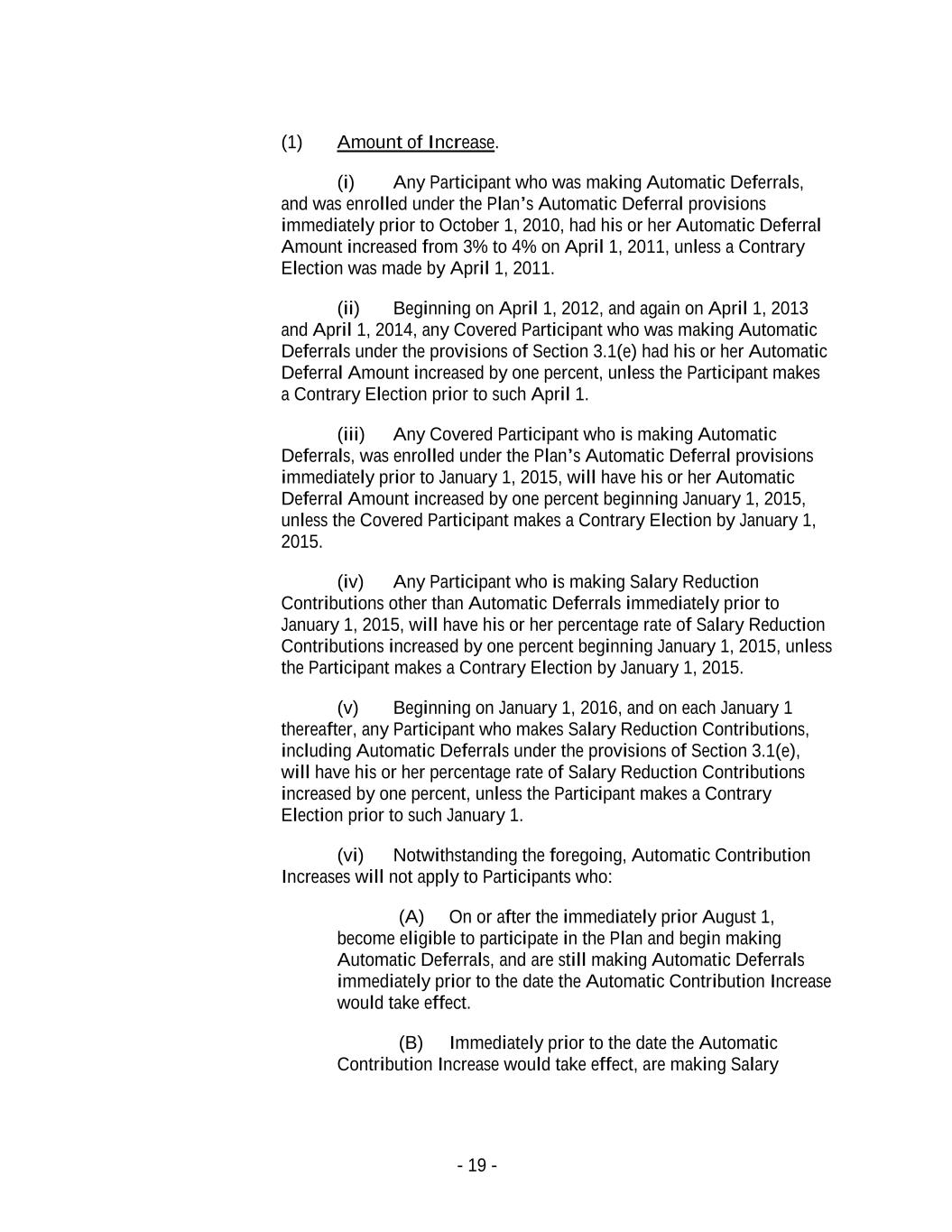
(1) Amount of Increase. (i) Any Participant who was making Automatic Deferrals, and was enrolled under the Plan’s Automatic Deferral provisions immediately prior to October 1, 2010, had his or her Automatic Deferral Amount increased from 3% to 4% on April 1, 2011, unless a Contrary Election was made by April 1, 2011. (ii) Beginning on April 1, 2012, and again on April 1, 2013 and April 1, 2014, any Covered Participant who was making Automatic Deferrals under the provisions of Section 3.1(e) had his or her Automatic Deferral Amount increased by one percent, unless the Participant makes a Contrary Election prior to such April 1. (iii) Any Covered Participant who is making Automatic Deferrals, was enrolled under the Plan’s Automatic Deferral provisions immediately prior to January 1, 2015, will have his or her Automatic Deferral Amount increased by one percent beginning January 1, 2015, unless the Covered Participant makes a Contrary Election by January 1, 2015. (iv) Any Participant who is making Salary Reduction Contributions other than Automatic Deferrals immediately prior to January 1, 2015, will have his or her percentage rate of Salary Reduction Contributions increased by one percent beginning January 1, 2015, unless the Participant makes a Contrary Election by January 1, 2015. (v) Beginning on January 1, 2016, and on each January 1 thereafter, any Participant who makes Salary Reduction Contributions, including Automatic Deferrals under the provisions of Section 3.1(e), will have his or her percentage rate of Salary Reduction Contributions increased by one percent, unless the Participant makes a Contrary Election prior to such January 1. (vi) Notwithstanding the foregoing, Automatic Contribution Increases will not apply to Participants who: (A) On or after the immediately prior August 1, become eligible to participate in the Plan and begin making Automatic Deferrals, and are still making Automatic Deferrals immediately prior to the date the Automatic Contribution Increase would take effect. (B) Immediately prior to the date the Automatic Contribution Increase would take effect, are making Salary - 19 -
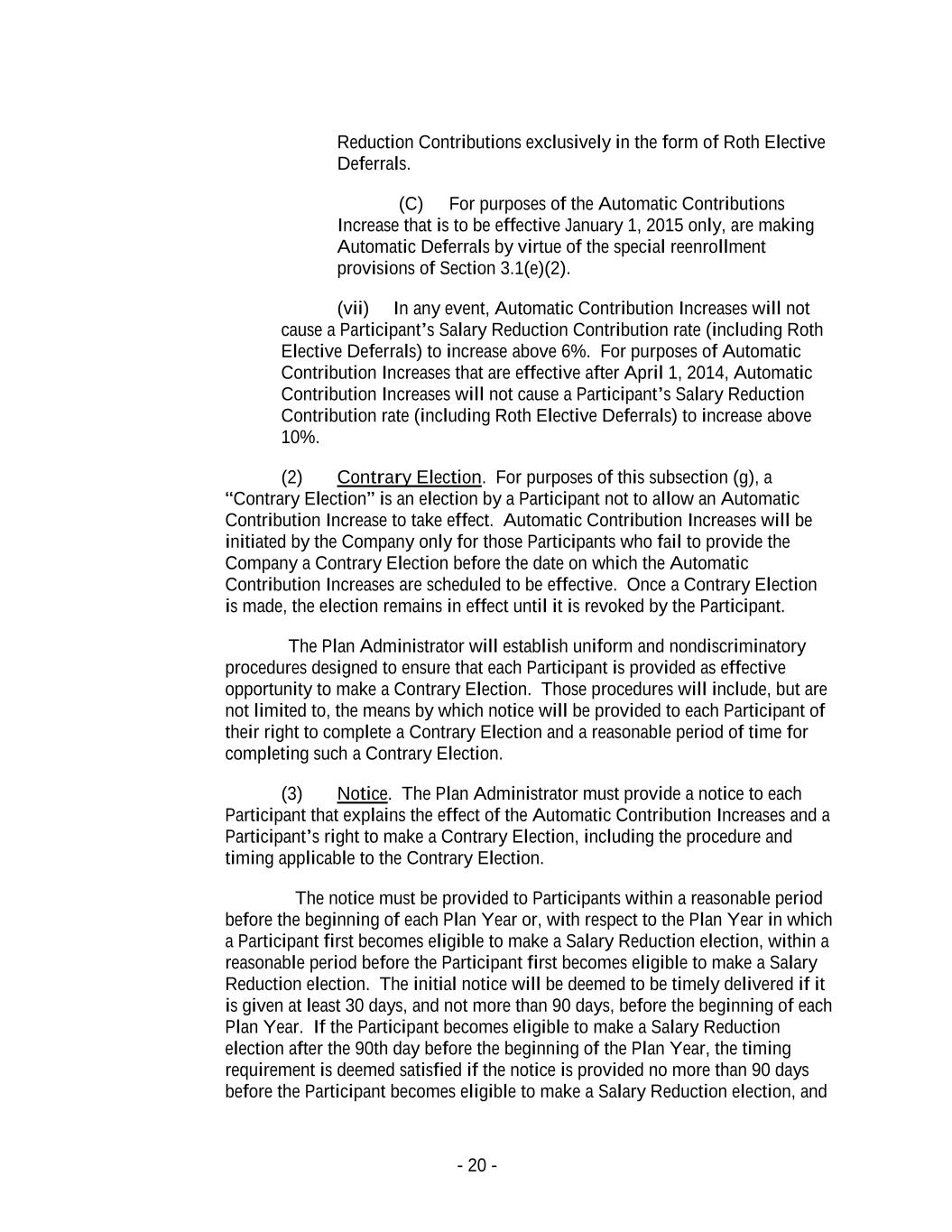
Reduction Contributions exclusively in the form of Roth Elective Deferrals. (C) For purposes of the Automatic Contributions Increase that is to be effective January 1, 2015 only, are making Automatic Deferrals by virtue of the special reenrollment provisions of Section 3.1(e)(2). (vii) In any event, Automatic Contribution Increases will not cause a Participant’s Salary Reduction Contribution rate (including Roth Elective Deferrals) to increase above 6%. For purposes of Automatic Contribution Increases that are effective after April 1, 2014, Automatic Contribution Increases will not cause a Participant’s Salary Reduction Contribution rate (including Roth Elective Deferrals) to increase above 10%. (2) Contrary Election. For purposes of this subsection (g), a “Contrary Election” is an election by a Participant not to allow an Automatic Contribution Increase to take effect. Automatic Contribution Increases will be initiated by the Company only for those Participants who fail to provide the Company a Contrary Election before the date on which the Automatic Contribution Increases are scheduled to be effective. Once a Contrary Election is made, the election remains in effect until it is revoked by the Participant. The Plan Administrator will establish uniform and nondiscriminatory procedures designed to ensure that each Participant is provided as effective opportunity to make a Contrary Election. Those procedures will include, but are not limited to, the means by which notice will be provided to each Participant of their right to complete a Contrary Election and a reasonable period of time for completing such a Contrary Election. (3) Notice. The Plan Administrator must provide a notice to each Participant that explains the effect of the Automatic Contribution Increases and a Participant’s right to make a Contrary Election, including the procedure and timing applicable to the Contrary Election. The notice must be provided to Participants within a reasonable period before the beginning of each Plan Year or, with respect to the Plan Year in which a Participant first becomes eligible to make a Salary Reduction election, within a reasonable period before the Participant first becomes eligible to make a Salary Reduction election. The initial notice will be deemed to be timely delivered if it is given at least 30 days, and not more than 90 days, before the beginning of each Plan Year. If the Participant becomes eligible to make a Salary Reduction election after the 90th day before the beginning of the Plan Year, the timing requirement is deemed satisfied if the notice is provided no more than 90 days before the Participant becomes eligible to make a Salary Reduction election, and - 20 -
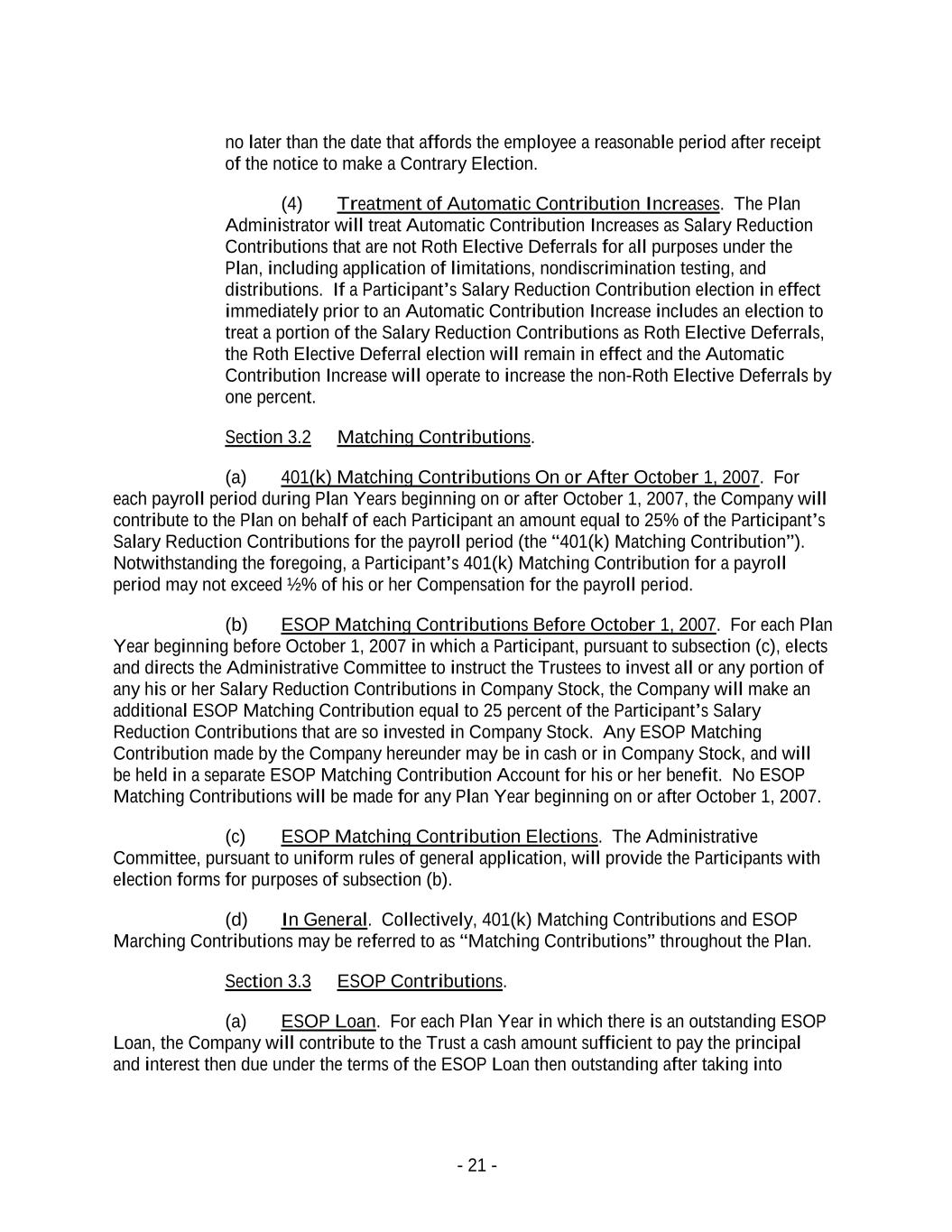
no later than the date that affords the employee a reasonable period after receipt of the notice to make a Contrary Election. (4) Treatment of Automatic Contribution Increases. The Plan Administrator will treat Automatic Contribution Increases as Salary Reduction Contributions that are not Roth Elective Deferrals for all purposes under the Plan, including application of limitations, nondiscrimination testing, and distributions. If a Participant’s Salary Reduction Contribution election in effect immediately prior to an Automatic Contribution Increase includes an election to treat a portion of the Salary Reduction Contributions as Roth Elective Deferrals, the Roth Elective Deferral election will remain in effect and the Automatic Contribution Increase will operate to increase the non-Roth Elective Deferrals by one percent. Section 3.2 Matching Contributions. (a) 401(k) Matching Contributions On or After October 1, 2007. For each payroll period during Plan Years beginning on or after October 1, 2007, the Company will contribute to the Plan on behalf of each Participant an amount equal to 25% of the Participant’s Salary Reduction Contributions for the payroll period (the “401(k) Matching Contribution”). Notwithstanding the foregoing, a Participant’s 401(k) Matching Contribution for a payroll period may not exceed ½% of his or her Compensation for the payroll period. (b) ESOP Matching Contributions Before October 1, 2007. For each Plan Year beginning before October 1, 2007 in which a Participant, pursuant to subsection (c), elects and directs the Administrative Committee to instruct the Trustees to invest all or any portion of any his or her Salary Reduction Contributions in Company Stock, the Company will make an additional ESOP Matching Contribution equal to 25 percent of the Participant’s Salary Reduction Contributions that are so invested in Company Stock. Any ESOP Matching Contribution made by the Company hereunder may be in cash or in Company Stock, and will be held in a separate ESOP Matching Contribution Account for his or her benefit. No ESOP Matching Contributions will be made for any Plan Year beginning on or after October 1, 2007. (c) ESOP Matching Contribution Elections. The Administrative Committee, pursuant to uniform rules of general application, will provide the Participants with election forms for purposes of subsection (b). (d) In General. Collectively, 401(k) Matching Contributions and ESOP Marching Contributions may be referred to as “Matching Contributions” throughout the Plan. Section 3.3 ESOP Contributions. (a) ESOP Loan. For each Plan Year in which there is an outstanding ESOP Loan, the Company will contribute to the Trust a cash amount sufficient to pay the principal and interest then due under the terms of the ESOP Loan then outstanding after taking into - 21 -
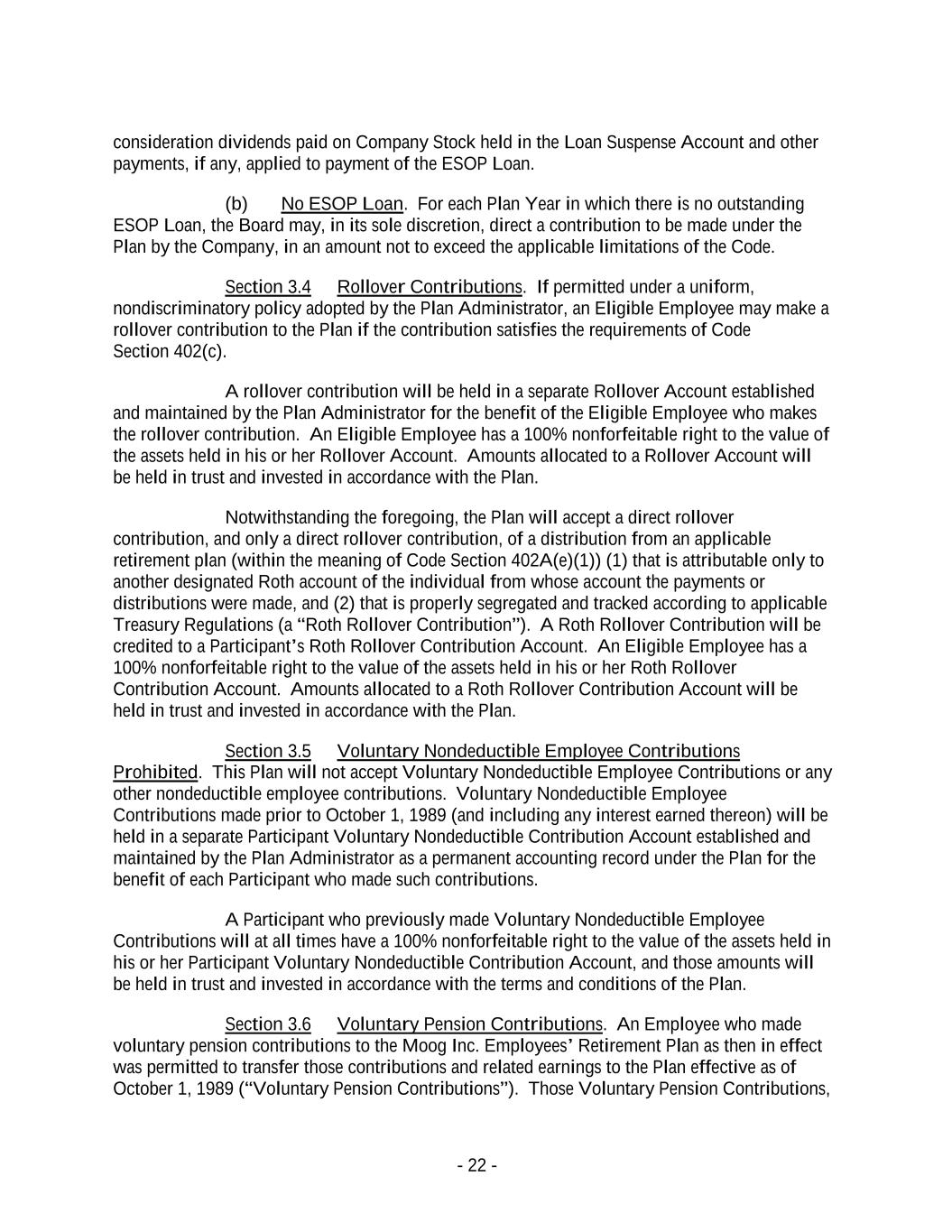
consideration dividends paid on Company Stock held in the Loan Suspense Account and other payments, if any, applied to payment of the ESOP Loan. (b) No ESOP Loan. For each Plan Year in which there is no outstanding ESOP Loan, the Board may, in its sole discretion, direct a contribution to be made under the Plan by the Company, in an amount not to exceed the applicable limitations of the Code. Section 3.4 Rollover Contributions. If permitted under a uniform, nondiscriminatory policy adopted by the Plan Administrator, an Eligible Employee may make a rollover contribution to the Plan if the contribution satisfies the requirements of Code Section 402(c). A rollover contribution will be held in a separate Rollover Account established and maintained by the Plan Administrator for the benefit of the Eligible Employee who makes the rollover contribution. An Eligible Employee has a 100% nonforfeitable right to the value of the assets held in his or her Rollover Account. Amounts allocated to a Rollover Account will be held in trust and invested in accordance with the Plan. Notwithstanding the foregoing, the Plan will accept a direct rollover contribution, and only a direct rollover contribution, of a distribution from an applicable retirement plan (within the meaning of Code Section 402A(e)(1)) (1) that is attributable only to another designated Roth account of the individual from whose account the payments or distributions were made, and (2) that is properly segregated and tracked according to applicable Treasury Regulations (a “Roth Rollover Contribution”). A Roth Rollover Contribution will be credited to a Participant’s Roth Rollover Contribution Account. An Eligible Employee has a 100% nonforfeitable right to the value of the assets held in his or her Roth Rollover Contribution Account. Amounts allocated to a Roth Rollover Contribution Account will be held in trust and invested in accordance with the Plan. Section 3.5 Voluntary Nondeductible Employee Contributions Prohibited. This Plan will not accept Voluntary Nondeductible Employee Contributions or any other nondeductible employee contributions. Voluntary Nondeductible Employee Contributions made prior to October 1, 1989 (and including any interest earned thereon) will be held in a separate Participant Voluntary Nondeductible Contribution Account established and maintained by the Plan Administrator as a permanent accounting record under the Plan for the benefit of each Participant who made such contributions. A Participant who previously made Voluntary Nondeductible Employee Contributions will at all times have a 100% nonforfeitable right to the value of the assets held in his or her Participant Voluntary Nondeductible Contribution Account, and those amounts will be held in trust and invested in accordance with the terms and conditions of the Plan. Section 3.6 Voluntary Pension Contributions. An Employee who made voluntary pension contributions to the Moog Inc. Employees’ Retirement Plan as then in effect was permitted to transfer those contributions and related earnings to the Plan effective as of October 1, 1989 (“Voluntary Pension Contributions”). Those Voluntary Pension Contributions, - 22 -
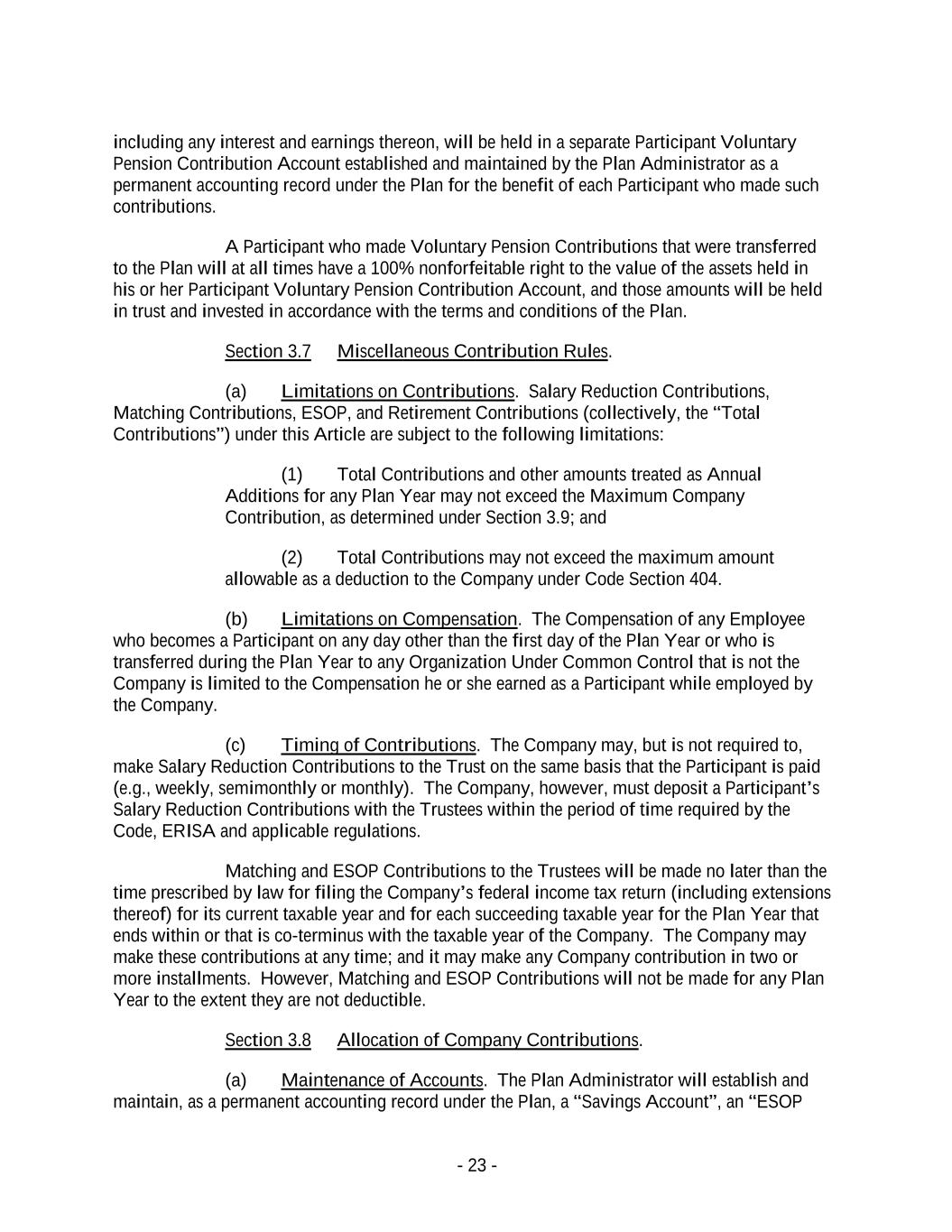
including any interest and earnings thereon, will be held in a separate Participant Voluntary Pension Contribution Account established and maintained by the Plan Administrator as a permanent accounting record under the Plan for the benefit of each Participant who made such contributions. A Participant who made Voluntary Pension Contributions that were transferred to the Plan will at all times have a 100% nonforfeitable right to the value of the assets held in his or her Participant Voluntary Pension Contribution Account, and those amounts will be held in trust and invested in accordance with the terms and conditions of the Plan. Section 3.7 Miscellaneous Contribution Rules. (a) Limitations on Contributions. Salary Reduction Contributions, Matching Contributions, ESOP, and Retirement Contributions (collectively, the “Total Contributions”) under this Article are subject to the following limitations: (1) Total Contributions and other amounts treated as Annual Additions for any Plan Year may not exceed the Maximum Company Contribution, as determined under Section 3.9; and (2) Total Contributions may not exceed the maximum amount allowable as a deduction to the Company under Code Section 404. (b) Limitations on Compensation. The Compensation of any Employee who becomes a Participant on any day other than the first day of the Plan Year or who is transferred during the Plan Year to any Organization Under Common Control that is not the Company is limited to the Compensation he or she earned as a Participant while employed by the Company. (c) Timing of Contributions. The Company may, but is not required to, make Salary Reduction Contributions to the Trust on the same basis that the Participant is paid (e.g., weekly, semimonthly or monthly). The Company, however, must deposit a Participant’s Salary Reduction Contributions with the Trustees within the period of time required by the Code, ERISA and applicable regulations. Matching and ESOP Contributions to the Trustees will be made no later than the time prescribed by law for filing the Company’s federal income tax return (including extensions thereof) for its current taxable year and for each succeeding taxable year for the Plan Year that ends within or that is co-terminus with the taxable year of the Company. The Company may make these contributions at any time; and it may make any Company contribution in two or more installments. However, Matching and ESOP Contributions will not be made for any Plan Year to the extent they are not deductible. Section 3.8 Allocation of Company Contributions. (a) Maintenance of Accounts. The Plan Administrator will establish and maintain, as a permanent accounting record under the Plan, a “Savings Account”, an “ESOP - 23 -

Matching Contribution Account”, a “401(k) Matching Contribution Account,” an “ESOP Contribution Account,” a “Retirement Contribution Account,” a “Roth Savings Account,” and a “Roth Catch-up Contribution Account” (collectively, “Accounts”) in the name of each Participant. (b) Allocation of Salary Reduction Contributions. The Plan Administrator will allocate to each Participant’s Savings Account the Participant’s Salary Reduction Contributions that are not designated as Roth Elective Deferrals, if any, for each Plan Year as of a date or dates determined by the Plan Administrator, but no later than the last day of the Plan Year. (c) Allocation of Matching Contributions. For each payroll period during Plan Years beginning on or after October 1, 2007, the Plan Administrator will allocate so much of the total 401(k) Matching Contributions for the payroll period as of a date or the dates determined by the Plan Administrator, but no later than the last day of the Plan year to the 401(k) Matching Contribution Account of each Participant as will equal 25% of the Participant’s Salary Reduction Contributions for the payroll period. Notwithstanding the foregoing, the allocation under this Section with respect to any Participant during any payroll period will not exceed ½% of his or her Compensation for the payroll period. For each Plan Year beginning before October 1, 2007, the Plan Administrator will allocate so much of the total ESOP Matching Contributions for the Plan Year as of a date or the dates determined by the Plan Administrator, but in any event not later than the last day of the Plan Year, to the ESOP Matching Contribution Account of each Participant as will equal 25 percent of the Participant’s Salary Reduction Contributions for the Plan year that the Participant elects to invest in Company Stock pursuant to Section 3.2. (d) Allocation of ESOP Contributions. (1) ESOP Loan. For each Plan Year in which the Company makes a contribution under the Plan pursuant to Section 3.3(a), all shares of Company Stock withdrawn from a Loan Suspense Account during the Plan Year in accordance with Section 3.8(e) (other than shares allocated to ESOP Matching Contribution Accounts) will be allocated to each Participant’s ESOP Contribution Account, by allocating the total contribution made by the Company in the same proportion that the Participant’s Compensation for the Plan Year bears to the total Compensation of all Participants for the Plan Year. The Plan Administrator will allocate the contribution under Section 3.3(a) as of a date or the dates determined by the Plan Administrator, but in any event not later than the last day of the Plan Year. (2) No ESOP Loan. For each Plan Year in which the Company makes a contribution under the Plan pursuant to Section 3.3(b), the contribution will be allocated to each Participant for the Plan Year by allocating the total contribution made by the Company in the same proportion that the Participant’s Compensation for the Plan Year bears to the total Compensation of all - 24 -
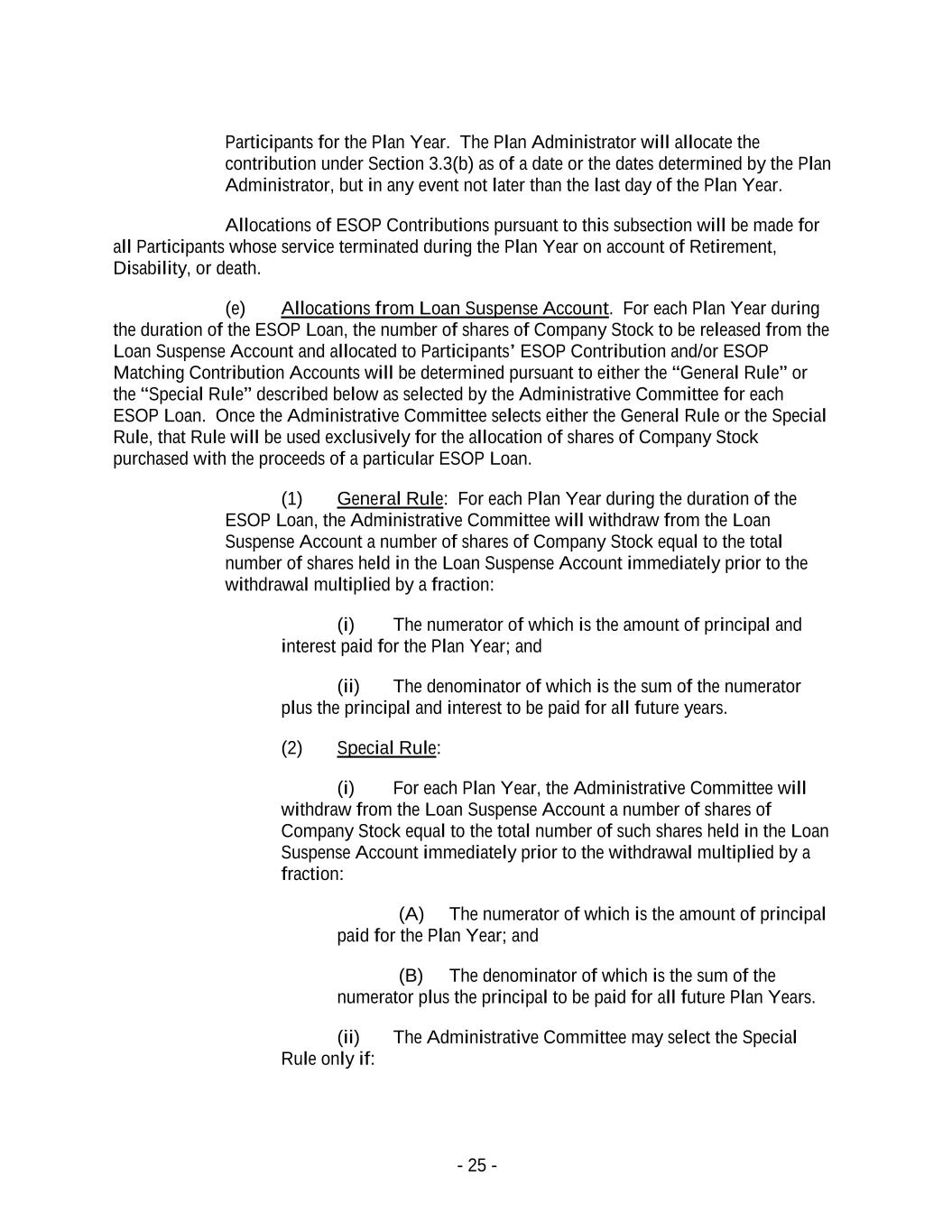
Participants for the Plan Year. The Plan Administrator will allocate the contribution under Section 3.3(b) as of a date or the dates determined by the Plan Administrator, but in any event not later than the last day of the Plan Year. Allocations of ESOP Contributions pursuant to this subsection will be made for all Participants whose service terminated during the Plan Year on account of Retirement, Disability, or death. (e) Allocations from Loan Suspense Account. For each Plan Year during the duration of the ESOP Loan, the number of shares of Company Stock to be released from the Loan Suspense Account and allocated to Participants’ ESOP Contribution and/or ESOP Matching Contribution Accounts will be determined pursuant to either the “General Rule” or the “Special Rule” described below as selected by the Administrative Committee for each ESOP Loan. Once the Administrative Committee selects either the General Rule or the Special Rule, that Rule will be used exclusively for the allocation of shares of Company Stock purchased with the proceeds of a particular ESOP Loan. (1) General Rule: For each Plan Year during the duration of the ESOP Loan, the Administrative Committee will withdraw from the Loan Suspense Account a number of shares of Company Stock equal to the total number of shares held in the Loan Suspense Account immediately prior to the withdrawal multiplied by a fraction: (i) The numerator of which is the amount of principal and interest paid for the Plan Year; and (ii) The denominator of which is the sum of the numerator plus the principal and interest to be paid for all future years. (2) Special Rule: (i) For each Plan Year, the Administrative Committee will withdraw from the Loan Suspense Account a number of shares of Company Stock equal to the total number of such shares held in the Loan Suspense Account immediately prior to the withdrawal multiplied by a fraction: (A) The numerator of which is the amount of principal paid for the Plan Year; and (B) The denominator of which is the sum of the numerator plus the principal to be paid for all future Plan Years. (ii) The Administrative Committee may select the Special Rule only if: - 25 -
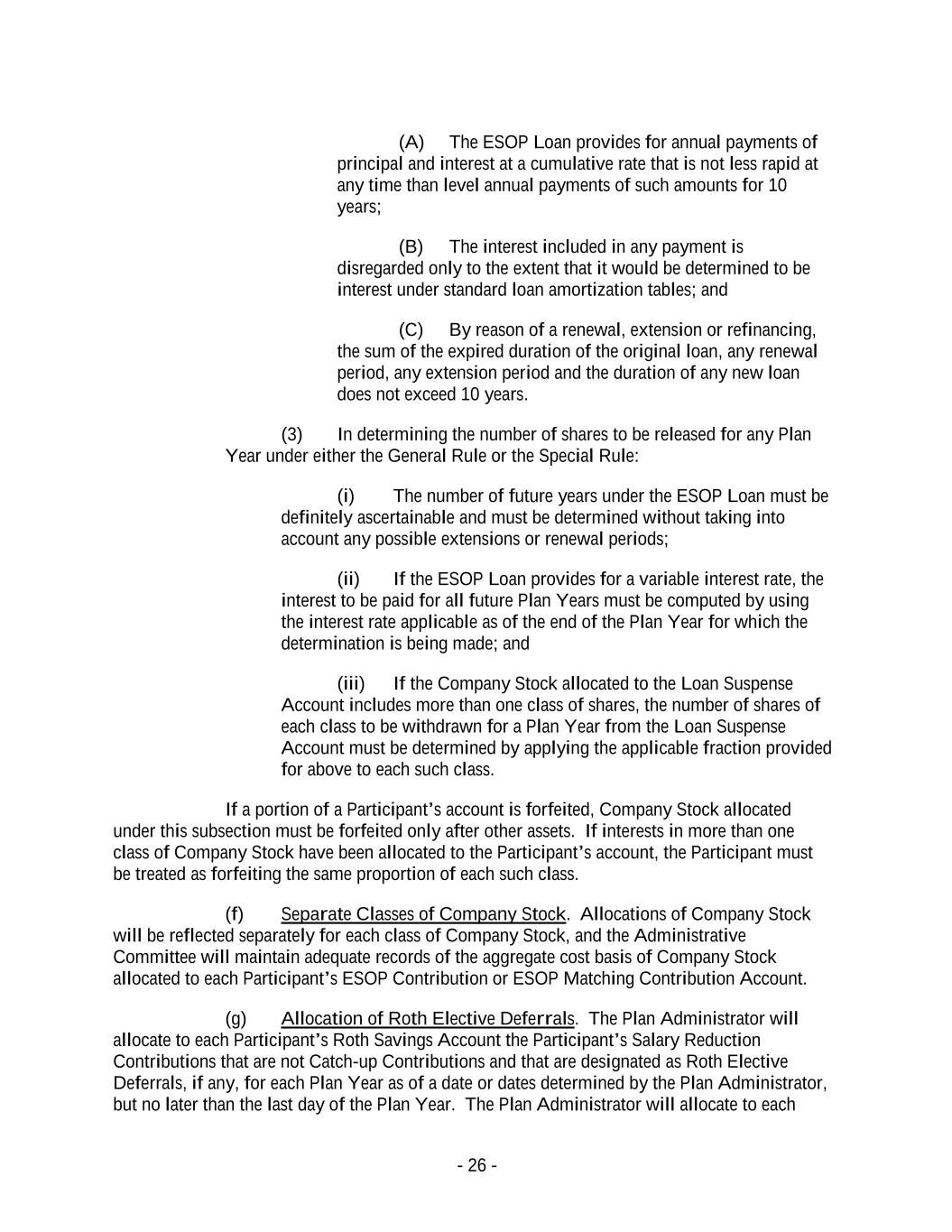
(A) The ESOP Loan provides for annual payments of principal and interest at a cumulative rate that is not less rapid at any time than level annual payments of such amounts for 10 years; (B) The interest included in any payment is disregarded only to the extent that it would be determined to be interest under standard loan amortization tables; and (C) By reason of a renewal, extension or refinancing, the sum of the expired duration of the original loan, any renewal period, any extension period and the duration of any new loan does not exceed 10 years. (3) In determining the number of shares to be released for any Plan Year under either the General Rule or the Special Rule: (i) The number of future years under the ESOP Loan must be definitely ascertainable and must be determined without taking into account any possible extensions or renewal periods; (ii) If the ESOP Loan provides for a variable interest rate, the interest to be paid for all future Plan Years must be computed by using the interest rate applicable as of the end of the Plan Year for which the determination is being made; and (iii) If the Company Stock allocated to the Loan Suspense Account includes more than one class of shares, the number of shares of each class to be withdrawn for a Plan Year from the Loan Suspense Account must be determined by applying the applicable fraction provided for above to each such class. If a portion of a Participant’s account is forfeited, Company Stock allocated under this subsection must be forfeited only after other assets. If interests in more than one class of Company Stock have been allocated to the Participant’s account, the Participant must be treated as forfeiting the same proportion of each such class. (f) Separate Classes of Company Stock. Allocations of Company Stock will be reflected separately for each class of Company Stock, and the Administrative Committee will maintain adequate records of the aggregate cost basis of Company Stock allocated to each Participant’s ESOP Contribution or ESOP Matching Contribution Account. (g) Allocation of Roth Elective Deferrals. The Plan Administrator will allocate to each Participant’s Roth Savings Account the Participant’s Salary Reduction Contributions that are not Catch-up Contributions and that are designated as Roth Elective Deferrals, if any, for each Plan Year as of a date or dates determined by the Plan Administrator, but no later than the last day of the Plan Year. The Plan Administrator will allocate to each - 26 -

Participant’s Roth Catch-up Contribution Account the Participant’s Salary Reduction Contributions that are Catch-up Contributions and that are designated as Roth Elective Deferrals, if any, for each Plan Year as of a date or dates determined by the Plan Administrator, but no later than the last day of the Plan Year. Section 3.9 Limitations on Allocations. (a) Definitions. The following definitions apply for purposes of this Section: (1) Annual Addition will have the same meaning as defined under Code Section 415(c)(2) and the regulations thereunder. Notwithstanding the foregoing, Annual Additions with respect to Company Stock released from the Loan Suspense Account (by reason of Company contributions used for payments on an ESOP Loan) and allocated to Participants’ Accounts will be based upon the lesser of (A) the amount of such Company contributions, or (B) the fair market value of the Company Stock as of the allocation date. For Limitation Years and Plan Years beginning on or after July 1, 2007, the definition of Annual Additions is modified as follows: (i) Restorative Payments. Annual Additions for purposes of Code Section 415 will not include restorative payments. A restorative payment is a payment made to restore losses to a Plan resulting from actions by a fiduciary for which there is reasonable risk of liability for breach of a fiduciary duty under ERISA or under other applicable federal or state law, where Participants who are similarly situated are treated similarly with respect to the payments. Generally, payments are restorative payments only if the payments are made in order to restore some or all of the plan’s losses due to an action (or a failure to act) that creates a reasonable risk of liability for such a breach of fiduciary duty (other than a breach of fiduciary duty arising from failure to remit contributions to the Plan). This includes payments to a plan made pursuant to a Department of Labor order, the Department of Labor’s Voluntary Fiduciary Correction Program, or a court approved settlement, to restore losses to a qualified defined contribution plan on account of the breach of fiduciary duty (other than a breach of fiduciary duty arising from failure to remit contributions to the Plan). Payments made to the Plan to make up for losses due merely to market fluctuations and other payments that are not made on account of a reasonable risk of liability for breach of a fiduciary duty under ERISA are not restorative payments and generally constitute contributions that are considered Annual Additions. (ii) Other Amounts. Annual Additions for purposes of Code Section 415 of the Code will not include: (1) The direct transfer of a benefit or employee contributions from a qualified plan to this Plan; (2) - 27 -
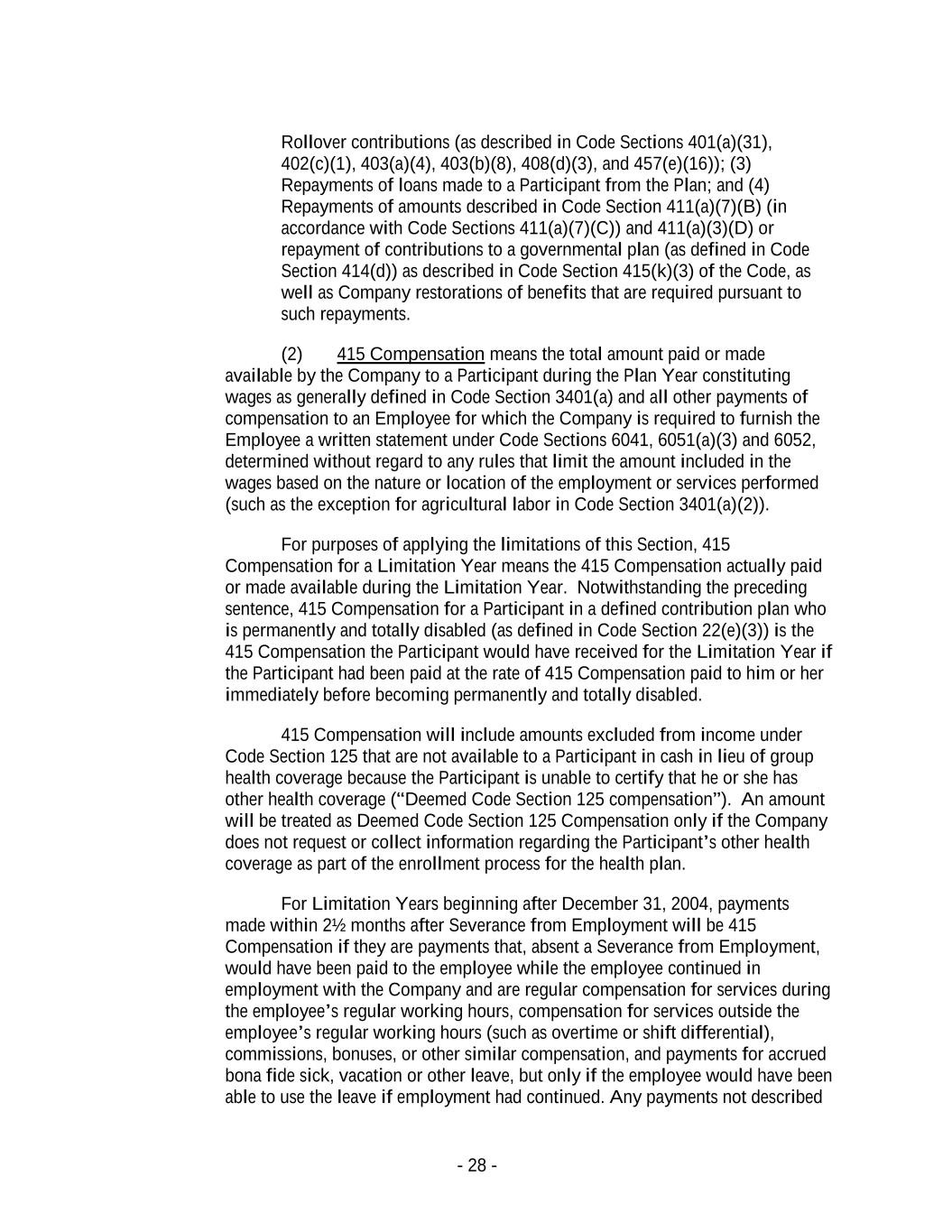
Rollover contributions (as described in Code Sections 401(a)(31), 402(c)(1), 403(a)(4), 403(b)(8), 408(d)(3), and 457(e)(16)); (3) Repayments of loans made to a Participant from the Plan; and (4) Repayments of amounts described in Code Section 411(a)(7)(B) (in accordance with Code Sections 411(a)(7)(C)) and 411(a)(3)(D) or repayment of contributions to a governmental plan (as defined in Code Section 414(d)) as described in Code Section 415(k)(3) of the Code, as well as Company restorations of benefits that are required pursuant to such repayments. (2) 415 Compensation means the total amount paid or made available by the Company to a Participant during the Plan Year constituting wages as generally defined in Code Section 3401(a) and all other payments of compensation to an Employee for which the Company is required to furnish the Employee a written statement under Code Sections 6041, 6051(a)(3) and 6052, determined without regard to any rules that limit the amount included in the wages based on the nature or location of the employment or services performed (such as the exception for agricultural labor in Code Section 3401(a)(2)). For purposes of applying the limitations of this Section, 415 Compensation for a Limitation Year means the 415 Compensation actually paid or made available during the Limitation Year. Notwithstanding the preceding sentence, 415 Compensation for a Participant in a defined contribution plan who is permanently and totally disabled (as defined in Code Section 22(e)(3)) is the 415 Compensation the Participant would have received for the Limitation Year if the Participant had been paid at the rate of 415 Compensation paid to him or her immediately before becoming permanently and totally disabled. 415 Compensation will include amounts excluded from income under Code Section 125 that are not available to a Participant in cash in lieu of group health coverage because the Participant is unable to certify that he or she has other health coverage (“Deemed Code Section 125 compensation”). An amount will be treated as Deemed Code Section 125 Compensation only if the Company does not request or collect information regarding the Participant’s other health coverage as part of the enrollment process for the health plan. For Limitation Years beginning after December 31, 2004, payments made within 2½ months after Severance from Employment will be 415 Compensation if they are payments that, absent a Severance from Employment, would have been paid to the employee while the employee continued in employment with the Company and are regular compensation for services during the employee’s regular working hours, compensation for services outside the employee’s regular working hours (such as overtime or shift differential), commissions, bonuses, or other similar compensation, and payments for accrued bona fide sick, vacation or other leave, but only if the employee would have been able to use the leave if employment had continued. Any payments not described - 28 -
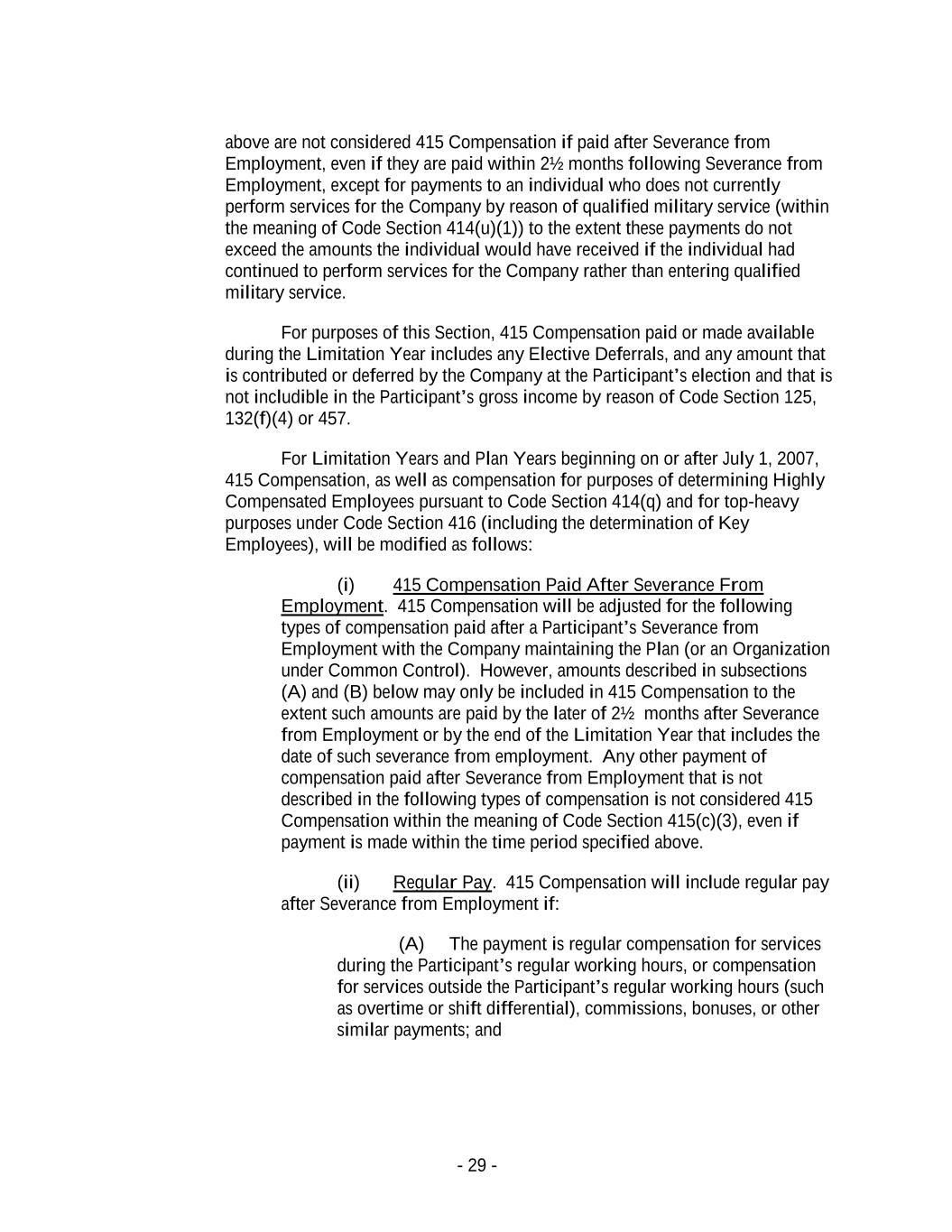
above are not considered 415 Compensation if paid after Severance from Employment, even if they are paid within 2½ months following Severance from Employment, except for payments to an individual who does not currently perform services for the Company by reason of qualified military service (within the meaning of Code Section 414(u)(1)) to the extent these payments do not exceed the amounts the individual would have received if the individual had continued to perform services for the Company rather than entering qualified military service. For purposes of this Section, 415 Compensation paid or made available during the Limitation Year includes any Elective Deferrals, and any amount that is contributed or deferred by the Company at the Participant’s election and that is not includible in the Participant’s gross income by reason of Code Section 125, 132(f)(4) or 457. For Limitation Years and Plan Years beginning on or after July 1, 2007, 415 Compensation, as well as compensation for purposes of determining Highly Compensated Employees pursuant to Code Section 414(q) and for top-heavy purposes under Code Section 416 (including the determination of Key Employees), will be modified as follows: (i) 415 Compensation Paid After Severance From Employment. 415 Compensation will be adjusted for the following types of compensation paid after a Participant’s Severance from Employment with the Company maintaining the Plan (or an Organization under Common Control). However, amounts described in subsections (A) and (B) below may only be included in 415 Compensation to the extent such amounts are paid by the later of 2½ months after Severance from Employment or by the end of the Limitation Year that includes the date of such severance from employment. Any other payment of compensation paid after Severance from Employment that is not described in the following types of compensation is not considered 415 Compensation within the meaning of Code Section 415(c)(3), even if payment is made within the time period specified above. (ii) Regular Pay. 415 Compensation will include regular pay after Severance from Employment if: (A) The payment is regular compensation for services during the Participant’s regular working hours, or compensation for services outside the Participant’s regular working hours (such as overtime or shift differential), commissions, bonuses, or other similar payments; and - 29 -

(B) The payment would have been paid to the Participant prior to a Severance from Employment if the Participant had continued in employment with the Company. (iii) Leave Cashouts and Deferred Compensation. Leave cashouts will be included in 415 Compensation if those amounts would have been included in the definition of 415 Compensation if they were paid prior to the Participant’s Severance from Employment, and the amounts are payment for unused accrued bona fide sick, vacation, or other leave, but only if the Participant would have been able to use the leave if employment had continued. In addition, deferred compensation will be included in 415 Compensation if the compensation would have been included in the definition of 415 Compensation if it had been paid prior to the Participant’s Severance from Employment, and the compensation is received pursuant to a nonqualified unfunded deferred compensation plan, but only if the payment would have been paid at the same time if the Participant had continued in employment with the Company and only to the extent that the payment is includible in the Participant’s gross income. (iv) Salary Continuation Payments for Military Service Participants. 415 Compensation will include payments to an individual who does not currently perform services for the Company by reason of qualified military service (as that term is used in Code Section 414(u)(1)) to the extent those payments do not exceed the amounts the individual would have received if the individual had continued to perform services for the Company rather than entering qualified military service. (v) Salary Continuation Payments for Disabled Participants. 415 Compensation will include compensation paid to a Participant who is permanently and totally disabled (as defined in Code Section 22(e)(3)). (vi) Administrative Delay (“The First Few Weeks”) Rule. 415 Compensation for a limitation year will not include amounts earned but not paid during the Limitation Year solely because of the timing of pay periods and pay dates. (3) Maximum Annual Addition, for any Limitation Year, means: (i) If the Company (or an Organization under Common Control) does not maintain any other qualified defined contribution plan, the Maximum Permissible Amount; and (ii) If, in addition to the Plan, the Company (or an Organization Under Common Control) maintains another qualified - 30 -
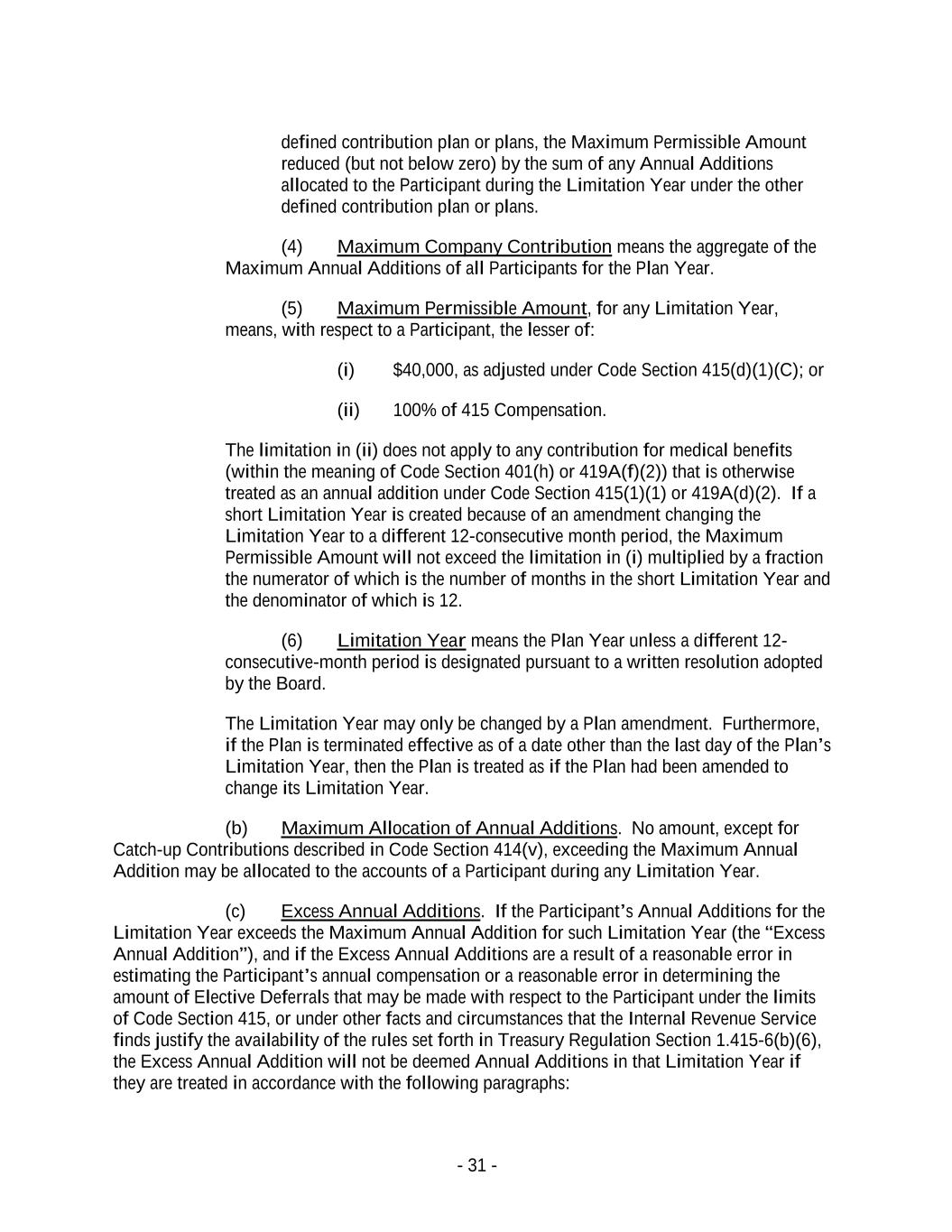
defined contribution plan or plans, the Maximum Permissible Amount reduced (but not below zero) by the sum of any Annual Additions allocated to the Participant during the Limitation Year under the other defined contribution plan or plans. (4) Maximum Company Contribution means the aggregate of the Maximum Annual Additions of all Participants for the Plan Year. (5) Maximum Permissible Amount, for any Limitation Year, means, with respect to a Participant, the lesser of: (i) $40,000, as adjusted under Code Section 415(d)(1)(C); or (ii) 100% of 415 Compensation. The limitation in (ii) does not apply to any contribution for medical benefits (within the meaning of Code Section 401(h) or 419A(f)(2)) that is otherwise treated as an annual addition under Code Section 415(1)(1) or 419A(d)(2). If a short Limitation Year is created because of an amendment changing the Limitation Year to a different 12-consecutive month period, the Maximum Permissible Amount will not exceed the limitation in (i) multiplied by a fraction the numerator of which is the number of months in the short Limitation Year and the denominator of which is 12. (6) Limitation Year means the Plan Year unless a different 12- consecutive-month period is designated pursuant to a written resolution adopted by the Board. The Limitation Year may only be changed by a Plan amendment. Furthermore, if the Plan is terminated effective as of a date other than the last day of the Plan’s Limitation Year, then the Plan is treated as if the Plan had been amended to change its Limitation Year. (b) Maximum Allocation of Annual Additions. No amount, except for Catch-up Contributions described in Code Section 414(v), exceeding the Maximum Annual Addition may be allocated to the accounts of a Participant during any Limitation Year. (c) Excess Annual Additions. If the Participant’s Annual Additions for the Limitation Year exceeds the Maximum Annual Addition for such Limitation Year (the “Excess Annual Addition”), and if the Excess Annual Additions are a result of a reasonable error in estimating the Participant’s annual compensation or a reasonable error in determining the amount of Elective Deferrals that may be made with respect to the Participant under the limits of Code Section 415, or under other facts and circumstances that the Internal Revenue Service finds justify the availability of the rules set forth in Treasury Regulation Section 1.415-6(b)(6), the Excess Annual Addition will not be deemed Annual Additions in that Limitation Year if they are treated in accordance with the following paragraphs: - 31 -
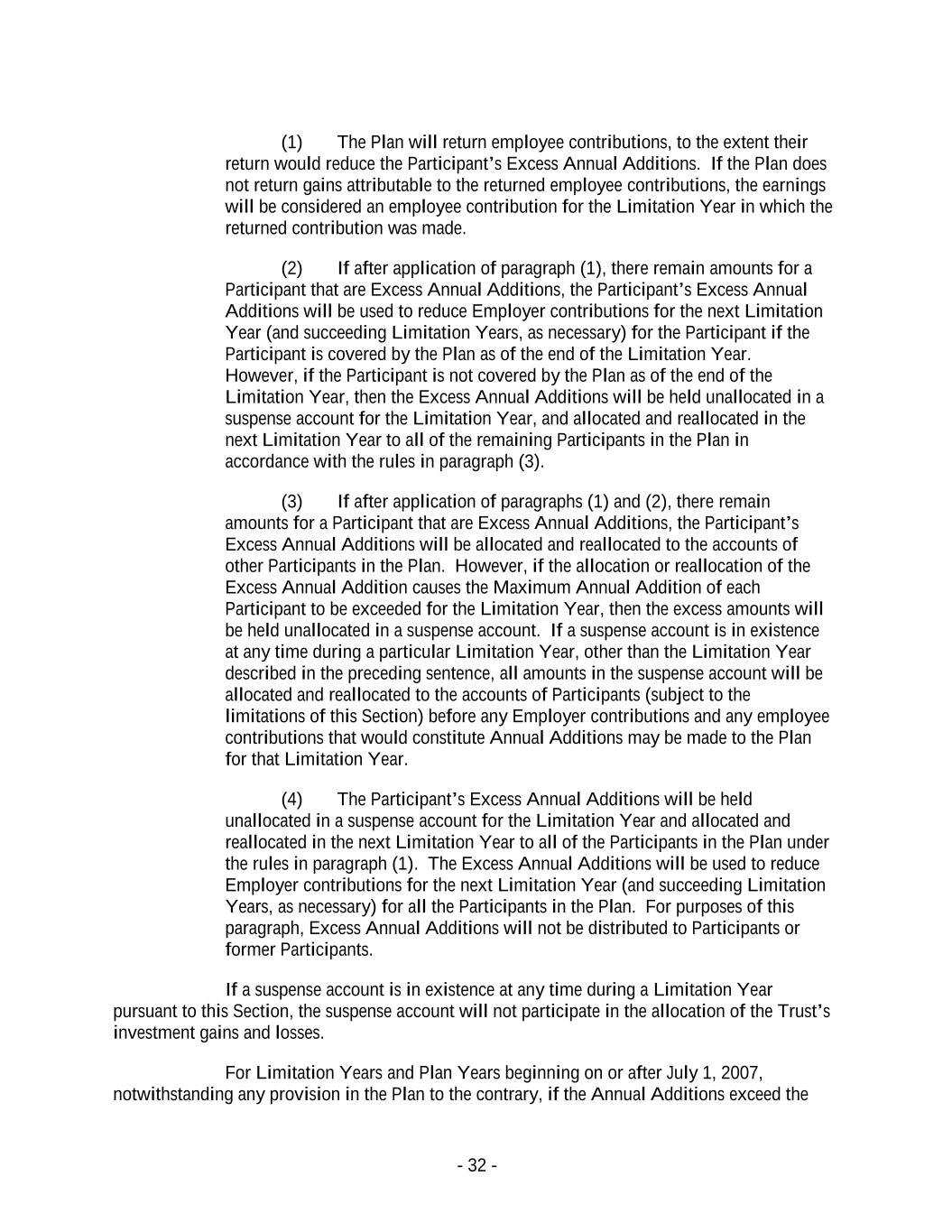
(1) The Plan will return employee contributions, to the extent their return would reduce the Participant’s Excess Annual Additions. If the Plan does not return gains attributable to the returned employee contributions, the earnings will be considered an employee contribution for the Limitation Year in which the returned contribution was made. (2) If after application of paragraph (1), there remain amounts for a Participant that are Excess Annual Additions, the Participant’s Excess Annual Additions will be used to reduce Employer contributions for the next Limitation Year (and succeeding Limitation Years, as necessary) for the Participant if the Participant is covered by the Plan as of the end of the Limitation Year. However, if the Participant is not covered by the Plan as of the end of the Limitation Year, then the Excess Annual Additions will be held unallocated in a suspense account for the Limitation Year, and allocated and reallocated in the next Limitation Year to all of the remaining Participants in the Plan in accordance with the rules in paragraph (3). (3) If after application of paragraphs (1) and (2), there remain amounts for a Participant that are Excess Annual Additions, the Participant’s Excess Annual Additions will be allocated and reallocated to the accounts of other Participants in the Plan. However, if the allocation or reallocation of the Excess Annual Addition causes the Maximum Annual Addition of each Participant to be exceeded for the Limitation Year, then the excess amounts will be held unallocated in a suspense account. If a suspense account is in existence at any time during a particular Limitation Year, other than the Limitation Year described in the preceding sentence, all amounts in the suspense account will be allocated and reallocated to the accounts of Participants (subject to the limitations of this Section) before any Employer contributions and any employee contributions that would constitute Annual Additions may be made to the Plan for that Limitation Year. (4) The Participant’s Excess Annual Additions will be held unallocated in a suspense account for the Limitation Year and allocated and reallocated in the next Limitation Year to all of the Participants in the Plan under the rules in paragraph (1). The Excess Annual Additions will be used to reduce Employer contributions for the next Limitation Year (and succeeding Limitation Years, as necessary) for all the Participants in the Plan. For purposes of this paragraph, Excess Annual Additions will not be distributed to Participants or former Participants. If a suspense account is in existence at any time during a Limitation Year pursuant to this Section, the suspense account will not participate in the allocation of the Trust’s investment gains and losses. For Limitation Years and Plan Years beginning on or after July 1, 2007, notwithstanding any provision in the Plan to the contrary, if the Annual Additions exceed the - 32 -
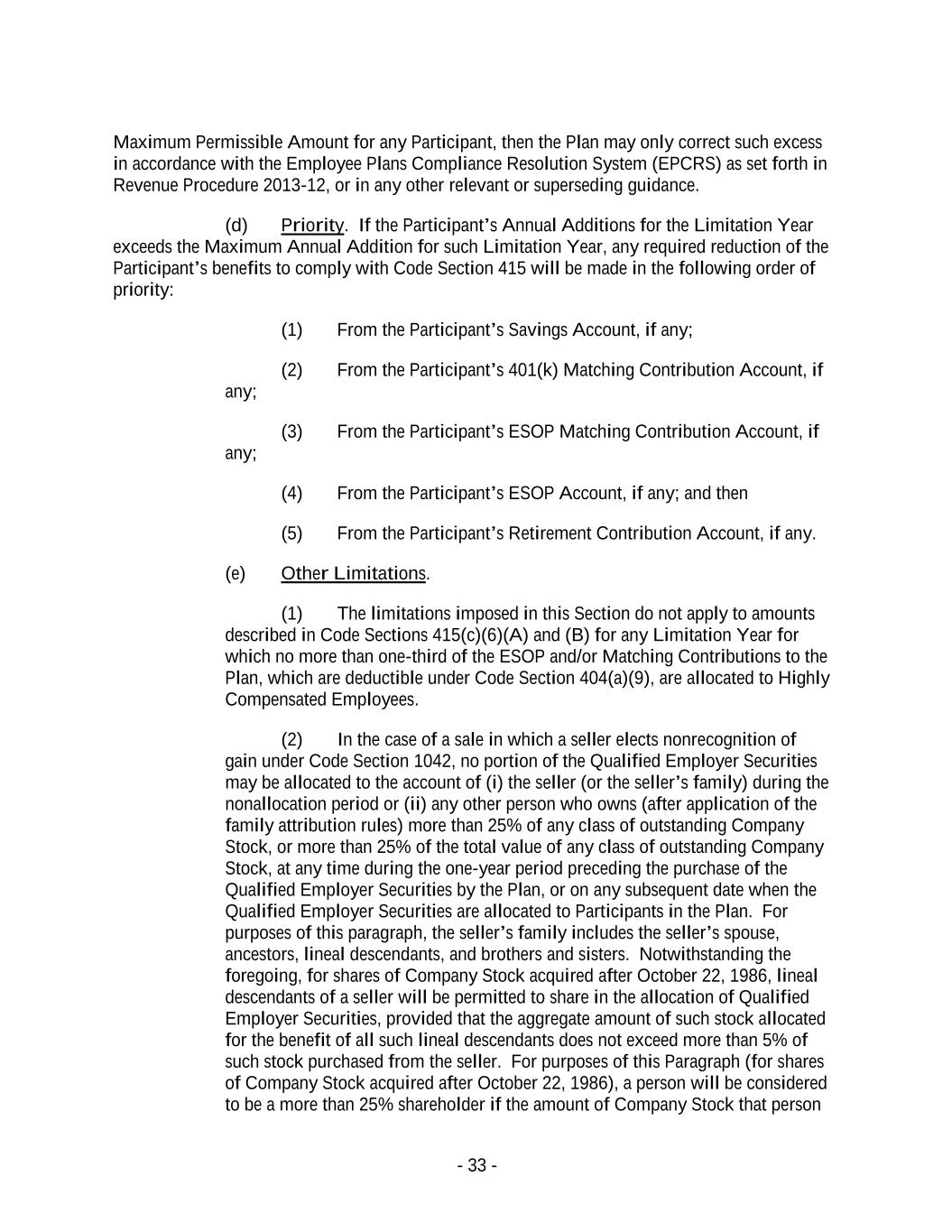
Maximum Permissible Amount for any Participant, then the Plan may only correct such excess in accordance with the Employee Plans Compliance Resolution System (EPCRS) as set forth in Revenue Procedure 2013-12, or in any other relevant or superseding guidance. (d) Priority. If the Participant’s Annual Additions for the Limitation Year exceeds the Maximum Annual Addition for such Limitation Year, any required reduction of the Participant’s benefits to comply with Code Section 415 will be made in the following order of priority: (1) From the Participant’s Savings Account, if any; (2) From the Participant’s 401(k) Matching Contribution Account, if any; (3) From the Participant’s ESOP Matching Contribution Account, if any; (4) From the Participant’s ESOP Account, if any; and then (5) From the Participant’s Retirement Contribution Account, if any. (e) Other Limitations. (1) The limitations imposed in this Section do not apply to amounts described in Code Sections 415(c)(6)(A) and (B) for any Limitation Year for which no more than one-third of the ESOP and/or Matching Contributions to the Plan, which are deductible under Code Section 404(a)(9), are allocated to Highly Compensated Employees. (2) In the case of a sale in which a seller elects nonrecognition of gain under Code Section 1042, no portion of the Qualified Employer Securities may be allocated to the account of (i) the seller (or the seller’s family) during the nonallocation period or (ii) any other person who owns (after application of the family attribution rules) more than 25% of any class of outstanding Company Stock, or more than 25% of the total value of any class of outstanding Company Stock, at any time during the one-year period preceding the purchase of the Qualified Employer Securities by the Plan, or on any subsequent date when the Qualified Employer Securities are allocated to Participants in the Plan. For purposes of this paragraph, the seller’s family includes the seller’s spouse, ancestors, lineal descendants, and brothers and sisters. Notwithstanding the foregoing, for shares of Company Stock acquired after October 22, 1986, lineal descendants of a seller will be permitted to share in the allocation of Qualified Employer Securities, provided that the aggregate amount of such stock allocated for the benefit of all such lineal descendants does not exceed more than 5% of such stock purchased from the seller. For purposes of this Paragraph (for shares of Company Stock acquired after October 22, 1986), a person will be considered to be a more than 25% shareholder if the amount of Company Stock that person - 33 -
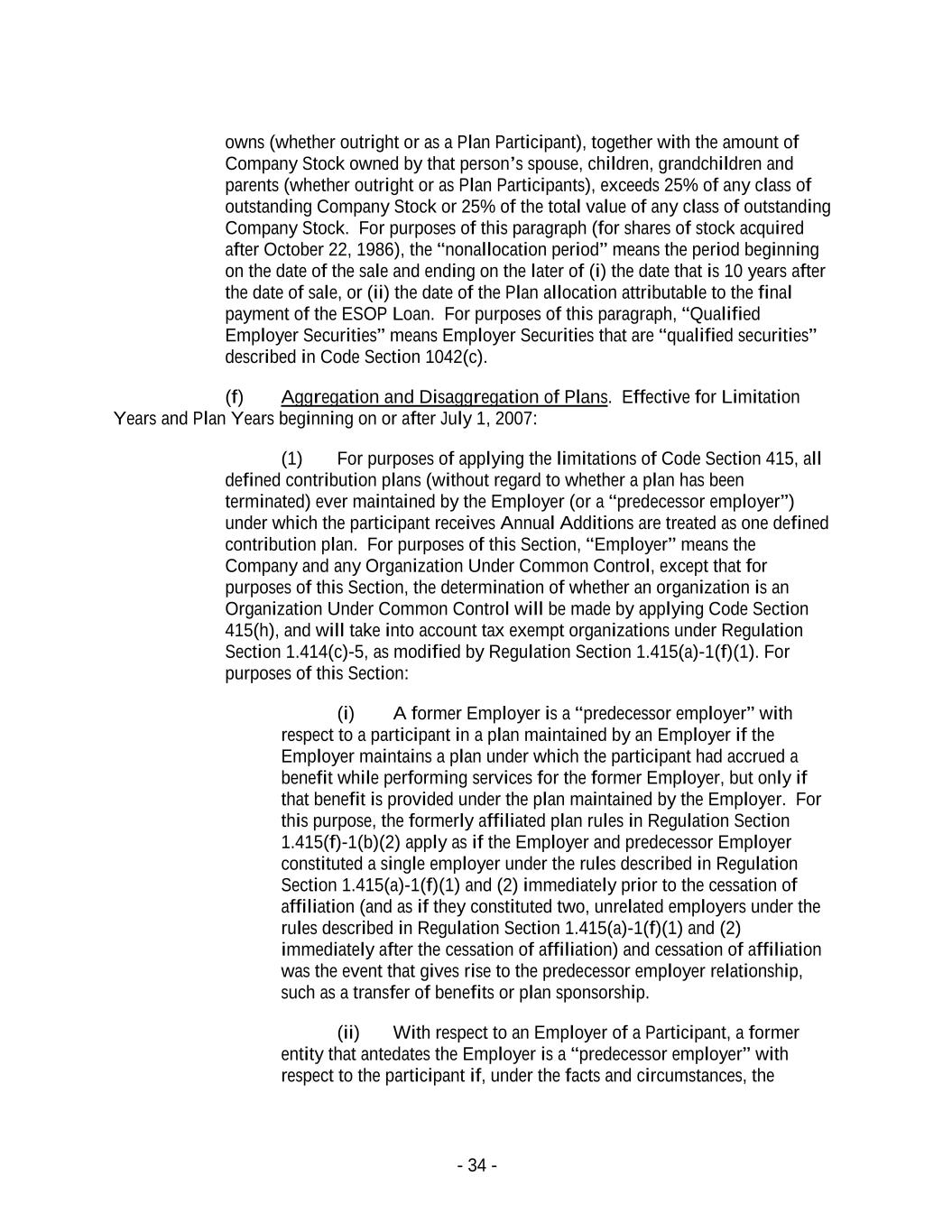
owns (whether outright or as a Plan Participant), together with the amount of Company Stock owned by that person’s spouse, children, grandchildren and parents (whether outright or as Plan Participants), exceeds 25% of any class of outstanding Company Stock or 25% of the total value of any class of outstanding Company Stock. For purposes of this paragraph (for shares of stock acquired after October 22, 1986), the “nonallocation period” means the period beginning on the date of the sale and ending on the later of (i) the date that is 10 years after the date of sale, or (ii) the date of the Plan allocation attributable to the final payment of the ESOP Loan. For purposes of this paragraph, “Qualified Employer Securities” means Employer Securities that are “qualified securities” described in Code Section 1042(c). (f) Aggregation and Disaggregation of Plans. Effective for Limitation Years and Plan Years beginning on or after July 1, 2007: (1) For purposes of applying the limitations of Code Section 415, all defined contribution plans (without regard to whether a plan has been terminated) ever maintained by the Employer (or a “predecessor employer”) under which the participant receives Annual Additions are treated as one defined contribution plan. For purposes of this Section, “Employer” means the Company and any Organization Under Common Control, except that for purposes of this Section, the determination of whether an organization is an Organization Under Common Control will be made by applying Code Section 415(h), and will take into account tax exempt organizations under Regulation Section 1.414(c)-5, as modified by Regulation Section 1.415(a)-1(f)(1). For purposes of this Section: (i) A former Employer is a “predecessor employer” with respect to a participant in a plan maintained by an Employer if the Employer maintains a plan under which the participant had accrued a benefit while performing services for the former Employer, but only if that benefit is provided under the plan maintained by the Employer. For this purpose, the formerly affiliated plan rules in Regulation Section 1.415(f)-1(b)(2) apply as if the Employer and predecessor Employer constituted a single employer under the rules described in Regulation Section 1.415(a)-1(f)(1) and (2) immediately prior to the cessation of affiliation (and as if they constituted two, unrelated employers under the rules described in Regulation Section 1.415(a)-1(f)(1) and (2) immediately after the cessation of affiliation) and cessation of affiliation was the event that gives rise to the predecessor employer relationship, such as a transfer of benefits or plan sponsorship. (ii) With respect to an Employer of a Participant, a former entity that antedates the Employer is a “predecessor employer” with respect to the participant if, under the facts and circumstances, the - 34 -
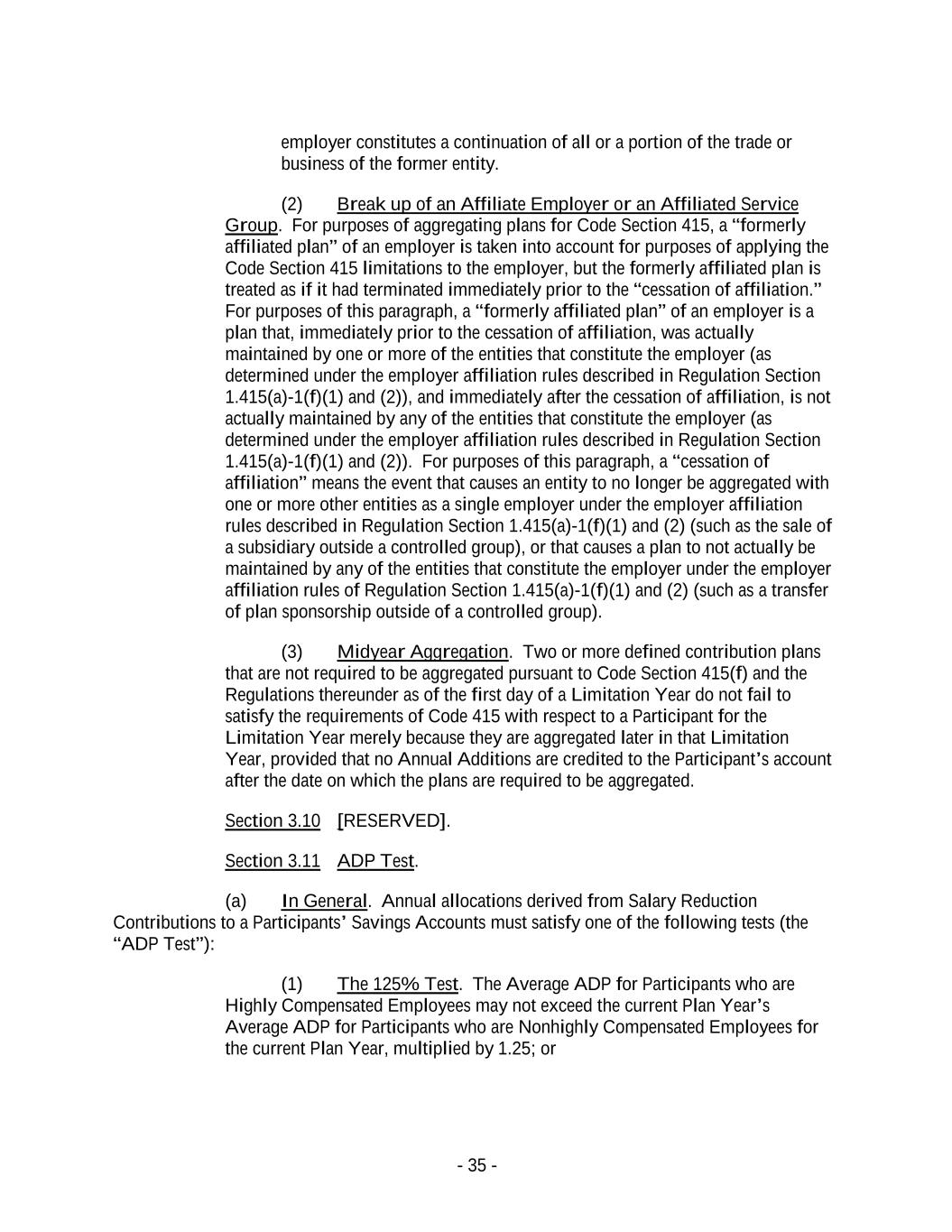
employer constitutes a continuation of all or a portion of the trade or business of the former entity. (2) Break up of an Affiliate Employer or an Affiliated Service Group. For purposes of aggregating plans for Code Section 415, a “formerly affiliated plan” of an employer is taken into account for purposes of applying the Code Section 415 limitations to the employer, but the formerly affiliated plan is treated as if it had terminated immediately prior to the “cessation of affiliation.” For purposes of this paragraph, a “formerly affiliated plan” of an employer is a plan that, immediately prior to the cessation of affiliation, was actually maintained by one or more of the entities that constitute the employer (as determined under the employer affiliation rules described in Regulation Section 1.415(a)-1(f)(1) and (2)), and immediately after the cessation of affiliation, is not actually maintained by any of the entities that constitute the employer (as determined under the employer affiliation rules described in Regulation Section 1.415(a)-1(f)(1) and (2)). For purposes of this paragraph, a “cessation of affiliation” means the event that causes an entity to no longer be aggregated with one or more other entities as a single employer under the employer affiliation rules described in Regulation Section 1.415(a)-1(f)(1) and (2) (such as the sale of a subsidiary outside a controlled group), or that causes a plan to not actually be maintained by any of the entities that constitute the employer under the employer affiliation rules of Regulation Section 1.415(a)-1(f)(1) and (2) (such as a transfer of plan sponsorship outside of a controlled group). (3) Midyear Aggregation. Two or more defined contribution plans that are not required to be aggregated pursuant to Code Section 415(f) and the Regulations thereunder as of the first day of a Limitation Year do not fail to satisfy the requirements of Code 415 with respect to a Participant for the Limitation Year merely because they are aggregated later in that Limitation Year, provided that no Annual Additions are credited to the Participant’s account after the date on which the plans are required to be aggregated. Section 3.10 [RESERVED]. Section 3.11 ADP Test. (a) In General. Annual allocations derived from Salary Reduction Contributions to a Participants’ Savings Accounts must satisfy one of the following tests (the “ADP Test”): (1) The 125% Test. The Average ADP for Participants who are Highly Compensated Employees may not exceed the current Plan Year’s Average ADP for Participants who are Nonhighly Compensated Employees for the current Plan Year, multiplied by 1.25; or - 35 -
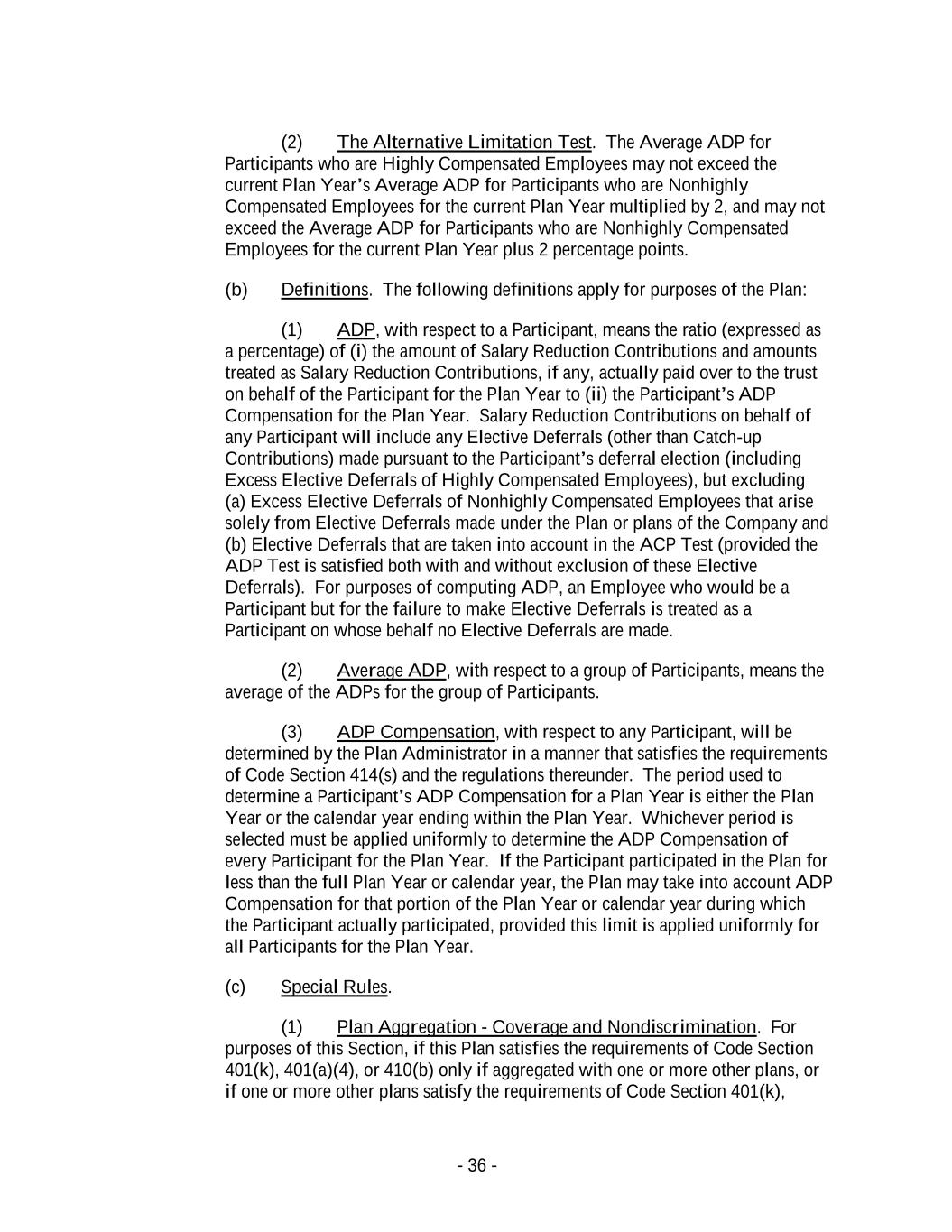
(2) The Alternative Limitation Test. The Average ADP for Participants who are Highly Compensated Employees may not exceed the current Plan Year’s Average ADP for Participants who are Nonhighly Compensated Employees for the current Plan Year multiplied by 2, and may not exceed the Average ADP for Participants who are Nonhighly Compensated Employees for the current Plan Year plus 2 percentage points. (b) Definitions. The following definitions apply for purposes of the Plan: (1) ADP, with respect to a Participant, means the ratio (expressed as a percentage) of (i) the amount of Salary Reduction Contributions and amounts treated as Salary Reduction Contributions, if any, actually paid over to the trust on behalf of the Participant for the Plan Year to (ii) the Participant’s ADP Compensation for the Plan Year. Salary Reduction Contributions on behalf of any Participant will include any Elective Deferrals (other than Catch-up Contributions) made pursuant to the Participant’s deferral election (including Excess Elective Deferrals of Highly Compensated Employees), but excluding (a) Excess Elective Deferrals of Nonhighly Compensated Employees that arise solely from Elective Deferrals made under the Plan or plans of the Company and (b) Elective Deferrals that are taken into account in the ACP Test (provided the ADP Test is satisfied both with and without exclusion of these Elective Deferrals). For purposes of computing ADP, an Employee who would be a Participant but for the failure to make Elective Deferrals is treated as a Participant on whose behalf no Elective Deferrals are made. (2) Average ADP, with respect to a group of Participants, means the average of the ADPs for the group of Participants. (3) ADP Compensation, with respect to any Participant, will be determined by the Plan Administrator in a manner that satisfies the requirements of Code Section 414(s) and the regulations thereunder. The period used to determine a Participant’s ADP Compensation for a Plan Year is either the Plan Year or the calendar year ending within the Plan Year. Whichever period is selected must be applied uniformly to determine the ADP Compensation of every Participant for the Plan Year. If the Participant participated in the Plan for less than the full Plan Year or calendar year, the Plan may take into account ADP Compensation for that portion of the Plan Year or calendar year during which the Participant actually participated, provided this limit is applied uniformly for all Participants for the Plan Year. (c) Special Rules. (1) Plan Aggregation - Coverage and Nondiscrimination. For purposes of this Section, if this Plan satisfies the requirements of Code Section 401(k), 401(a)(4), or 410(b) only if aggregated with one or more other plans, or if one or more other plans satisfy the requirements of Code Section 401(k), - 36 -

401(a)(4), or 410(b) only if aggregated with this Plan, then this Section will be applied by determining the ADP of Participants as if all the plans were a single plan. Plans may be aggregated under this paragraph only if they have the same plan year and use the same ADP testing method. (2) Plan Aggregation - Highly Compensated Employee. For purposes of this Section, the ADP for any Participant who is a Highly Compensated Employee for the Plan Year and who is eligible to have Elective Deferrals allocated to his or her accounts under two or more arrangements described in Code Section 401(k), that are maintained by the Company, will be determined as if the Elective Deferrals were made under a single arrangement. If a Highly Compensated Employee participates in two or more cash or deferred arrangements that have different plan years, all Elective Deferrals during the Plan Year will be aggregated. For Plan Years beginning before October 1, 2006, all such cash or deferred arrangements ending with or within the same calendar year will be treated as a single arrangement. Notwithstanding the foregoing, certain plans will be treated as separate if mandatorily disaggregated under regulations under Code Section 401(k). (3) Timing of Contributions. For purposes of the ADP Test, Salary Reduction Contributions must be made before the end of the 12-month period immediately following the Plan Year to which the contributions relate. (4) Maintenance of Records. The Plan Administrator will maintain records that demonstrate satisfaction of the ADP Test under this Section, including records indicating the extent to which the Plan used Matching Contributions to satisfy the test. Section 3.12 Correction of Excess Contributions. (a) In General. If for any Plan Year there are any Excess Contributions, then on or before the last day of the 12-month period beginning immediately after the Plan Year, the Excess Contributions, plus any income and minus any loss allocable thereto, will be distributed to Participants to whose accounts such Excess Contributions were allocated for such Plan Year, except to the extent such Excess Contributions are classified as Catch-up Contributions. Excess Contributions are allocated to the Highly Compensated Employees with the largest amounts of employer contributions taken into account in calculating the ADP test for the Plan Year in which the excess arose, beginning with the Highly Compensated Employee with the largest amount of such employer contributions and continuing in descending order until all the Excess Contributions have been allocated. To the extent a Highly Compensated Employee has not reached his or her Catch-up Contribution limit under the Plan, Excess Contributions allocated to such Highly Compensated Employee are Catch-up Contributions and will not be treated as Excess Contributions. Excess Contributions will be treated as Annual Additions under the Plan even if distributed. - 37 -
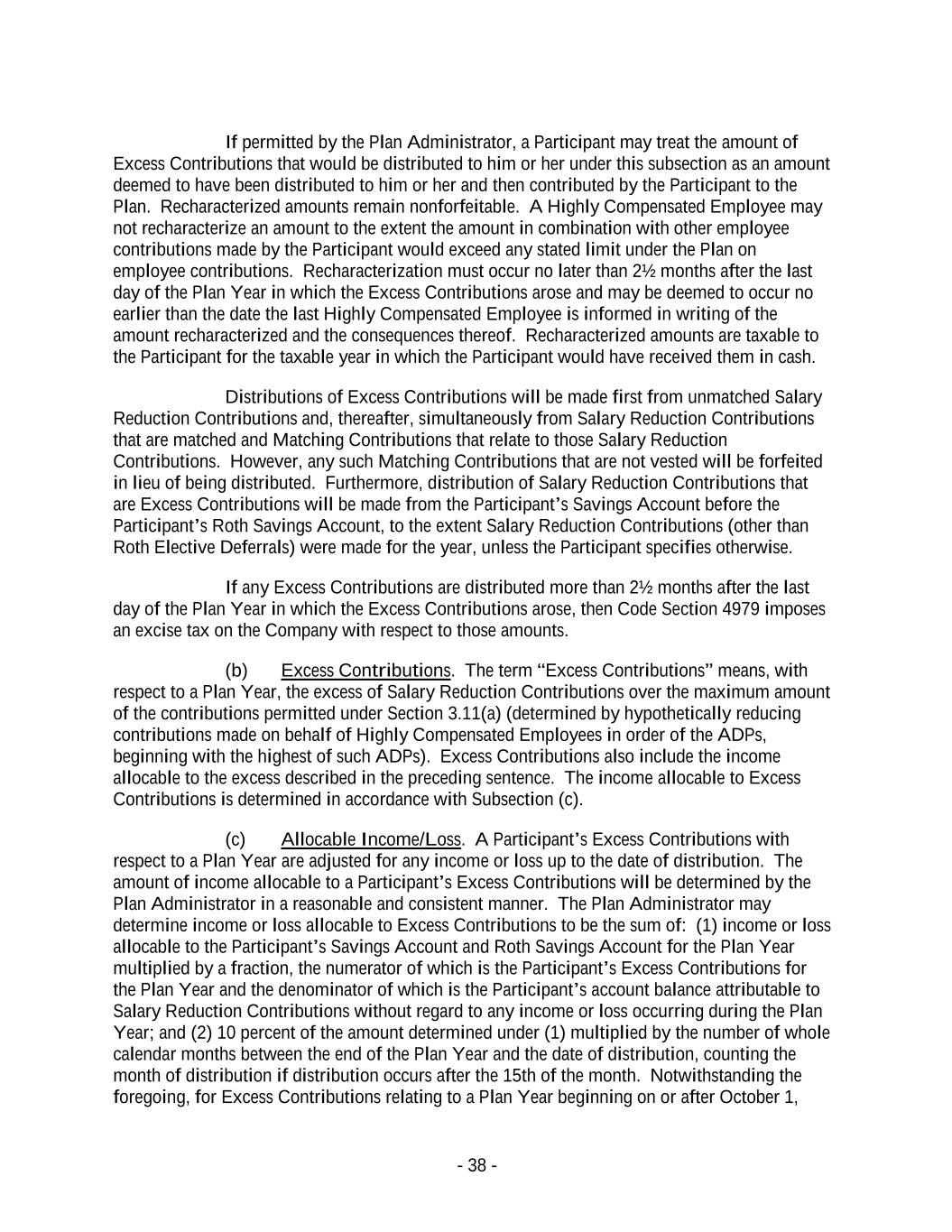
If permitted by the Plan Administrator, a Participant may treat the amount of Excess Contributions that would be distributed to him or her under this subsection as an amount deemed to have been distributed to him or her and then contributed by the Participant to the Plan. Recharacterized amounts remain nonforfeitable. A Highly Compensated Employee may not recharacterize an amount to the extent the amount in combination with other employee contributions made by the Participant would exceed any stated limit under the Plan on employee contributions. Recharacterization must occur no later than 2½ months after the last day of the Plan Year in which the Excess Contributions arose and may be deemed to occur no earlier than the date the last Highly Compensated Employee is informed in writing of the amount recharacterized and the consequences thereof. Recharacterized amounts are taxable to the Participant for the taxable year in which the Participant would have received them in cash. Distributions of Excess Contributions will be made first from unmatched Salary Reduction Contributions and, thereafter, simultaneously from Salary Reduction Contributions that are matched and Matching Contributions that relate to those Salary Reduction Contributions. However, any such Matching Contributions that are not vested will be forfeited in lieu of being distributed. Furthermore, distribution of Salary Reduction Contributions that are Excess Contributions will be made from the Participant’s Savings Account before the Participant’s Roth Savings Account, to the extent Salary Reduction Contributions (other than Roth Elective Deferrals) were made for the year, unless the Participant specifies otherwise. If any Excess Contributions are distributed more than 2½ months after the last day of the Plan Year in which the Excess Contributions arose, then Code Section 4979 imposes an excise tax on the Company with respect to those amounts. (b) Excess Contributions. The term “Excess Contributions” means, with respect to a Plan Year, the excess of Salary Reduction Contributions over the maximum amount of the contributions permitted under Section 3.11(a) (determined by hypothetically reducing contributions made on behalf of Highly Compensated Employees in order of the ADPs, beginning with the highest of such ADPs). Excess Contributions also include the income allocable to the excess described in the preceding sentence. The income allocable to Excess Contributions is determined in accordance with Subsection (c). (c) Allocable Income/Loss. A Participant’s Excess Contributions with respect to a Plan Year are adjusted for any income or loss up to the date of distribution. The amount of income allocable to a Participant’s Excess Contributions will be determined by the Plan Administrator in a reasonable and consistent manner. The Plan Administrator may determine income or loss allocable to Excess Contributions to be the sum of: (1) income or loss allocable to the Participant’s Savings Account and Roth Savings Account for the Plan Year multiplied by a fraction, the numerator of which is the Participant’s Excess Contributions for the Plan Year and the denominator of which is the Participant’s account balance attributable to Salary Reduction Contributions without regard to any income or loss occurring during the Plan Year; and (2) 10 percent of the amount determined under (1) multiplied by the number of whole calendar months between the end of the Plan Year and the date of distribution, counting the month of distribution if distribution occurs after the 15th of the month. Notwithstanding the foregoing, for Excess Contributions relating to a Plan Year beginning on or after October 1, - 38 -

2008, income/loss no longer will include income/loss allocable to Excess Contributions for the Plan Year in which the Excess Contributions are distributed or recharacterized. (d) Gap Period Income on Distributed Excess Contributions. For Plan Years beginning after December 31, 2007, the Plan Administrator will not calculate and distribute income allocable to Excess Contributions for the gap period (i.e., the period after the close of the Plan Year in which the Excess Contribution occurred and prior to the distribution). Section 3.13 ACP Test. (a) In General. Annual allocations derived from Matching Contributions to the Participants’ Matching Contribution Accounts must satisfy one of the following tests (the “ACP Test”): (1) The 125% Test. The Average ACP for Participants who are Highly Compensated Employees may not exceed the current Plan Year’s Average ACP for Participants who are Nonhighly Compensated Employees for the current Plan Year, multiplied by 1.25. (2) The Alternative Limitation Test. The Average ACP for Participants who are Highly Compensated Employees may not exceed the current Plan Year’s Average ACP for Participants who are not Highly Compensated Employees for the current Plan Year multiplied by 2, and may not exceed the Average ACP for Participants who are not Highly Compensated Employees for the current Plan Year plus 2 percentage points. The Plan Administrator may calculate the ACPs of Participants and, thus, determine whether the Plan satisfies the ACP Test under this Section by treating all or part of the Salary Reduction Contributions as Matching Contributions. The Plan Administrator may not treat Salary Reduction Contributions as Matching Contributions unless the Salary Reduction Contributions satisfy the conditions in Treasury Regulation Section 1.401(m)-2(a)(6). The Plan Administrator may not include Salary Reduction Contributions in the ACP Test unless the Plan satisfies the ADP Test both with and without the Salary Reduction Contributions included in the ACP Test. (b) Definitions. The following definitions apply for purposes of the Plan: (1) ACP, with respect to a Participant, means the ratio (expressed as a percentage) of the amount of Matching Contributions and amounts treated as Matching Contributions allocated to the Participant’s account for a Plan Year to the Participant’s ACP Compensation for the Plan Year. Such ACP amounts will not include Matching Contributions that are forfeited either to correct Excess Aggregate Contributions or because the contributions to which they relate are Excess Deferrals, Excess Contributions, or Excess Aggregate Contributions. The Company also may elect to use Elective Deferrals in the ACP amounts so long as the ADP test is met before the Elective Deferrals are used in the ACP - 39 -
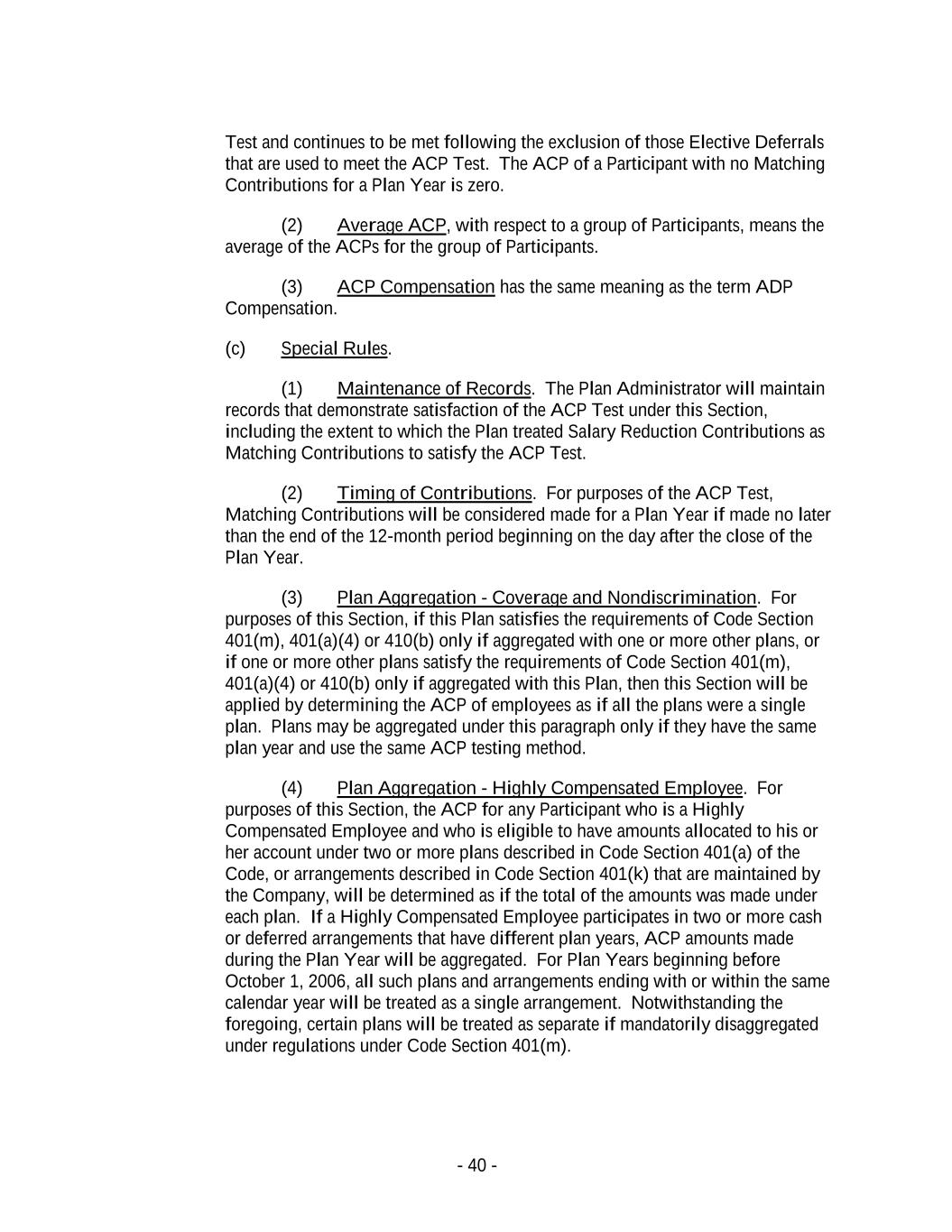
Test and continues to be met following the exclusion of those Elective Deferrals that are used to meet the ACP Test. The ACP of a Participant with no Matching Contributions for a Plan Year is zero. (2) Average ACP, with respect to a group of Participants, means the average of the ACPs for the group of Participants. (3) ACP Compensation has the same meaning as the term ADP Compensation. (c) Special Rules. (1) Maintenance of Records. The Plan Administrator will maintain records that demonstrate satisfaction of the ACP Test under this Section, including the extent to which the Plan treated Salary Reduction Contributions as Matching Contributions to satisfy the ACP Test. (2) Timing of Contributions. For purposes of the ACP Test, Matching Contributions will be considered made for a Plan Year if made no later than the end of the 12-month period beginning on the day after the close of the Plan Year. (3) Plan Aggregation - Coverage and Nondiscrimination. For purposes of this Section, if this Plan satisfies the requirements of Code Section 401(m), 401(a)(4) or 410(b) only if aggregated with one or more other plans, or if one or more other plans satisfy the requirements of Code Section 401(m), 401(a)(4) or 410(b) only if aggregated with this Plan, then this Section will be applied by determining the ACP of employees as if all the plans were a single plan. Plans may be aggregated under this paragraph only if they have the same plan year and use the same ACP testing method. (4) Plan Aggregation - Highly Compensated Employee. For purposes of this Section, the ACP for any Participant who is a Highly Compensated Employee and who is eligible to have amounts allocated to his or her account under two or more plans described in Code Section 401(a) of the Code, or arrangements described in Code Section 401(k) that are maintained by the Company, will be determined as if the total of the amounts was made under each plan. If a Highly Compensated Employee participates in two or more cash or deferred arrangements that have different plan years, ACP amounts made during the Plan Year will be aggregated. For Plan Years beginning before October 1, 2006, all such plans and arrangements ending with or within the same calendar year will be treated as a single arrangement. Notwithstanding the foregoing, certain plans will be treated as separate if mandatorily disaggregated under regulations under Code Section 401(m). - 40 -
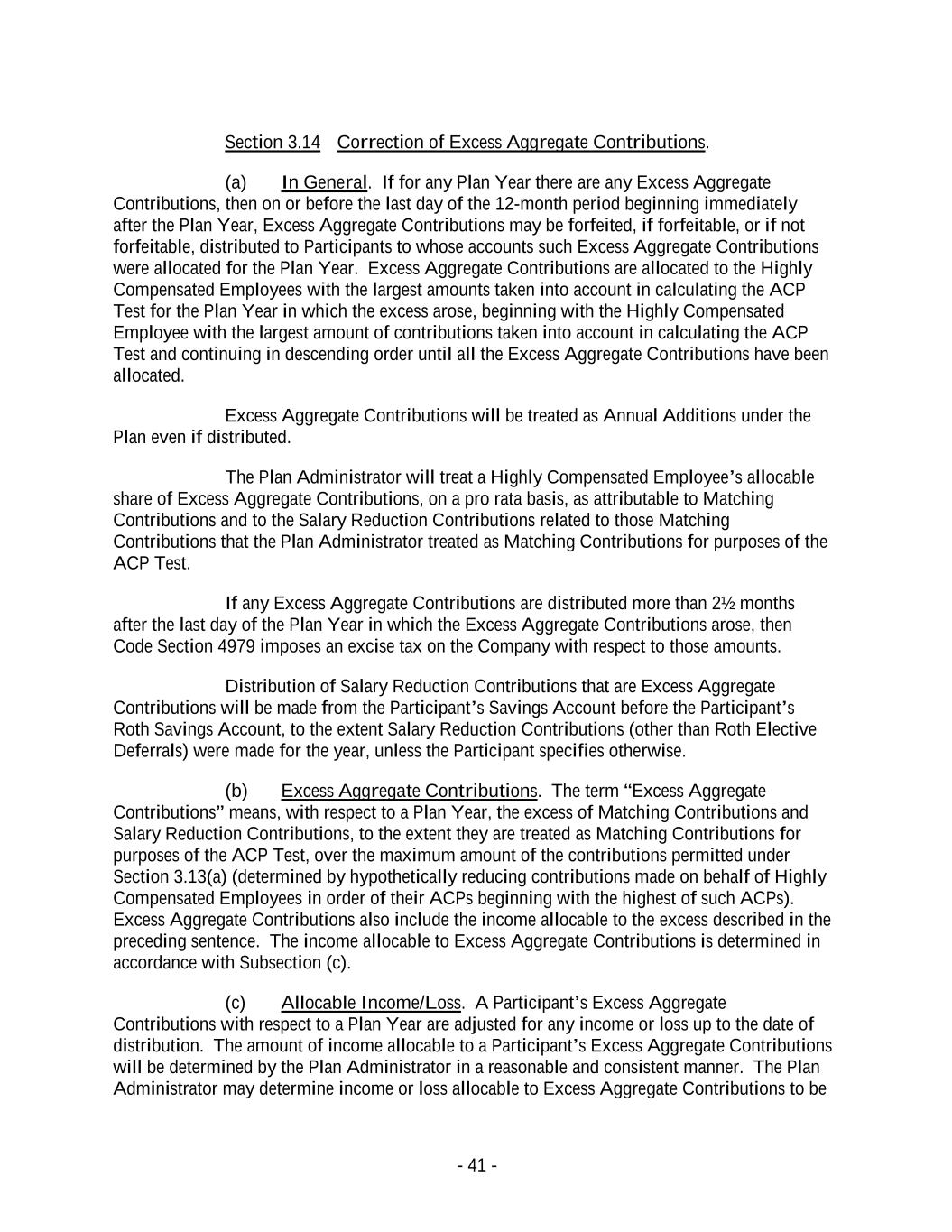
Section 3.14 Correction of Excess Aggregate Contributions. (a) In General. If for any Plan Year there are any Excess Aggregate Contributions, then on or before the last day of the 12-month period beginning immediately after the Plan Year, Excess Aggregate Contributions may be forfeited, if forfeitable, or if not forfeitable, distributed to Participants to whose accounts such Excess Aggregate Contributions were allocated for the Plan Year. Excess Aggregate Contributions are allocated to the Highly Compensated Employees with the largest amounts taken into account in calculating the ACP Test for the Plan Year in which the excess arose, beginning with the Highly Compensated Employee with the largest amount of contributions taken into account in calculating the ACP Test and continuing in descending order until all the Excess Aggregate Contributions have been allocated. Excess Aggregate Contributions will be treated as Annual Additions under the Plan even if distributed. The Plan Administrator will treat a Highly Compensated Employee’s allocable share of Excess Aggregate Contributions, on a pro rata basis, as attributable to Matching Contributions and to the Salary Reduction Contributions related to those Matching Contributions that the Plan Administrator treated as Matching Contributions for purposes of the ACP Test. If any Excess Aggregate Contributions are distributed more than 2½ months after the last day of the Plan Year in which the Excess Aggregate Contributions arose, then Code Section 4979 imposes an excise tax on the Company with respect to those amounts. Distribution of Salary Reduction Contributions that are Excess Aggregate Contributions will be made from the Participant’s Savings Account before the Participant’s Roth Savings Account, to the extent Salary Reduction Contributions (other than Roth Elective Deferrals) were made for the year, unless the Participant specifies otherwise. (b) Excess Aggregate Contributions. The term “Excess Aggregate Contributions” means, with respect to a Plan Year, the excess of Matching Contributions and Salary Reduction Contributions, to the extent they are treated as Matching Contributions for purposes of the ACP Test, over the maximum amount of the contributions permitted under Section 3.13(a) (determined by hypothetically reducing contributions made on behalf of Highly Compensated Employees in order of their ACPs beginning with the highest of such ACPs). Excess Aggregate Contributions also include the income allocable to the excess described in the preceding sentence. The income allocable to Excess Aggregate Contributions is determined in accordance with Subsection (c). (c) Allocable Income/Loss. A Participant’s Excess Aggregate Contributions with respect to a Plan Year are adjusted for any income or loss up to the date of distribution. The amount of income allocable to a Participant’s Excess Aggregate Contributions will be determined by the Plan Administrator in a reasonable and consistent manner. The Plan Administrator may determine income or loss allocable to Excess Aggregate Contributions to be - 41 -
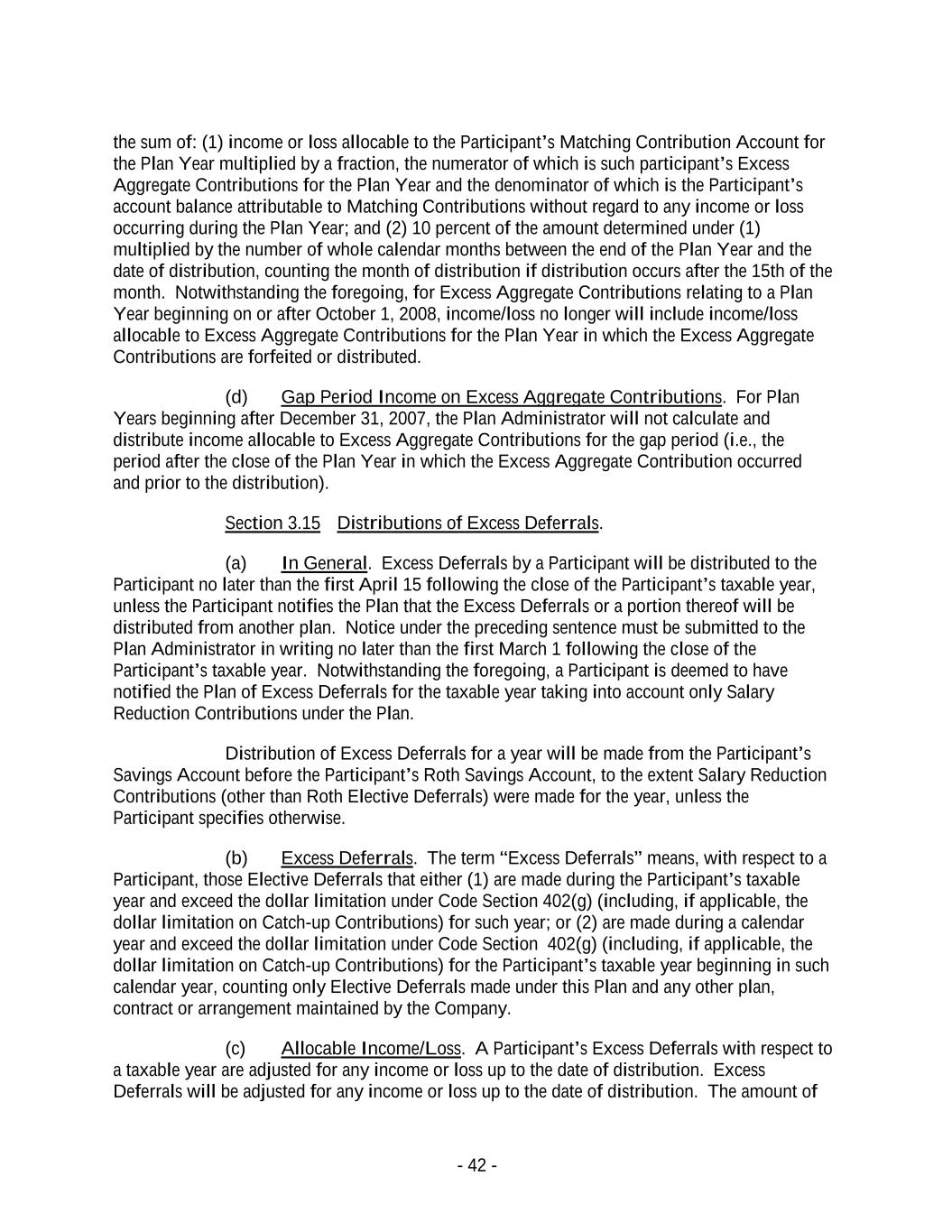
the sum of: (1) income or loss allocable to the Participant’s Matching Contribution Account for the Plan Year multiplied by a fraction, the numerator of which is such participant’s Excess Aggregate Contributions for the Plan Year and the denominator of which is the Participant’s account balance attributable to Matching Contributions without regard to any income or loss occurring during the Plan Year; and (2) 10 percent of the amount determined under (1) multiplied by the number of whole calendar months between the end of the Plan Year and the date of distribution, counting the month of distribution if distribution occurs after the 15th of the month. Notwithstanding the foregoing, for Excess Aggregate Contributions relating to a Plan Year beginning on or after October 1, 2008, income/loss no longer will include income/loss allocable to Excess Aggregate Contributions for the Plan Year in which the Excess Aggregate Contributions are forfeited or distributed. (d) Gap Period Income on Excess Aggregate Contributions. For Plan Years beginning after December 31, 2007, the Plan Administrator will not calculate and distribute income allocable to Excess Aggregate Contributions for the gap period (i.e., the period after the close of the Plan Year in which the Excess Aggregate Contribution occurred and prior to the distribution). Section 3.15 Distributions of Excess Deferrals. (a) In General. Excess Deferrals by a Participant will be distributed to the Participant no later than the first April 15 following the close of the Participant’s taxable year, unless the Participant notifies the Plan that the Excess Deferrals or a portion thereof will be distributed from another plan. Notice under the preceding sentence must be submitted to the Plan Administrator in writing no later than the first March 1 following the close of the Participant’s taxable year. Notwithstanding the foregoing, a Participant is deemed to have notified the Plan of Excess Deferrals for the taxable year taking into account only Salary Reduction Contributions under the Plan. Distribution of Excess Deferrals for a year will be made from the Participant’s Savings Account before the Participant’s Roth Savings Account, to the extent Salary Reduction Contributions (other than Roth Elective Deferrals) were made for the year, unless the Participant specifies otherwise. (b) Excess Deferrals. The term “Excess Deferrals” means, with respect to a Participant, those Elective Deferrals that either (1) are made during the Participant’s taxable year and exceed the dollar limitation under Code Section 402(g) (including, if applicable, the dollar limitation on Catch-up Contributions) for such year; or (2) are made during a calendar year and exceed the dollar limitation under Code Section 402(g) (including, if applicable, the dollar limitation on Catch-up Contributions) for the Participant’s taxable year beginning in such calendar year, counting only Elective Deferrals made under this Plan and any other plan, contract or arrangement maintained by the Company. (c) Allocable Income/Loss. A Participant’s Excess Deferrals with respect to a taxable year are adjusted for any income or loss up to the date of distribution. Excess Deferrals will be adjusted for any income or loss up to the date of distribution. The amount of - 42 -
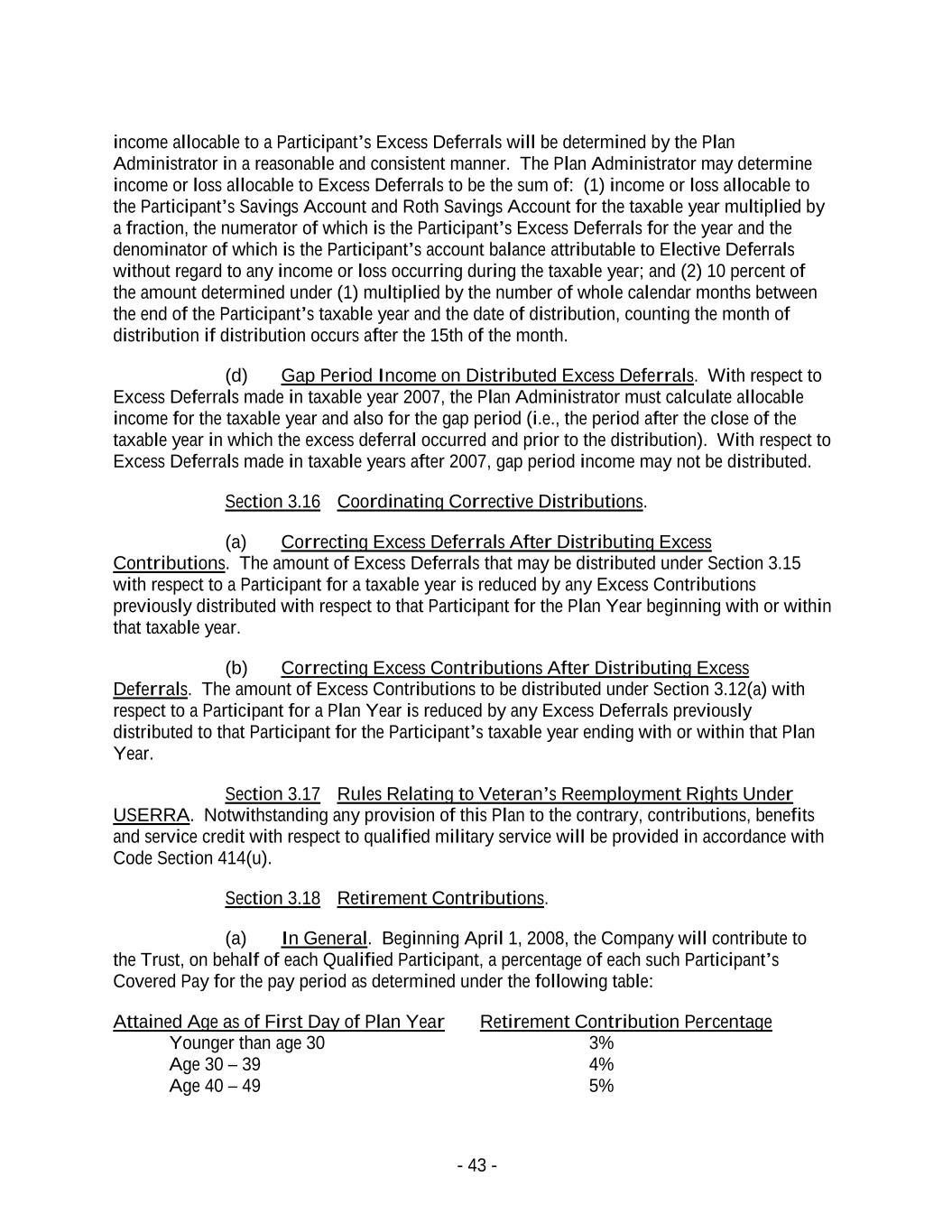
income allocable to a Participant’s Excess Deferrals will be determined by the Plan Administrator in a reasonable and consistent manner. The Plan Administrator may determine income or loss allocable to Excess Deferrals to be the sum of: (1) income or loss allocable to the Participant’s Savings Account and Roth Savings Account for the taxable year multiplied by a fraction, the numerator of which is the Participant’s Excess Deferrals for the year and the denominator of which is the Participant’s account balance attributable to Elective Deferrals without regard to any income or loss occurring during the taxable year; and (2) 10 percent of the amount determined under (1) multiplied by the number of whole calendar months between the end of the Participant’s taxable year and the date of distribution, counting the month of distribution if distribution occurs after the 15th of the month. (d) Gap Period Income on Distributed Excess Deferrals. With respect to Excess Deferrals made in taxable year 2007, the Plan Administrator must calculate allocable income for the taxable year and also for the gap period (i.e., the period after the close of the taxable year in which the excess deferral occurred and prior to the distribution). With respect to Excess Deferrals made in taxable years after 2007, gap period income may not be distributed. Section 3.16 Coordinating Corrective Distributions. (a) Correcting Excess Deferrals After Distributing Excess Contributions. The amount of Excess Deferrals that may be distributed under Section 3.15 with respect to a Participant for a taxable year is reduced by any Excess Contributions previously distributed with respect to that Participant for the Plan Year beginning with or within that taxable year. (b) Correcting Excess Contributions After Distributing Excess Deferrals. The amount of Excess Contributions to be distributed under Section 3.12(a) with respect to a Participant for a Plan Year is reduced by any Excess Deferrals previously distributed to that Participant for the Participant’s taxable year ending with or within that Plan Year. Section 3.17 Rules Relating to Veteran’s Reemployment Rights Under USERRA. Notwithstanding any provision of this Plan to the contrary, contributions, benefits and service credit with respect to qualified military service will be provided in accordance with Code Section 414(u). Section 3.18 Retirement Contributions. (a) In General. Beginning April 1, 2008, the Company will contribute to the Trust, on behalf of each Qualified Participant, a percentage of each such Participant’s Covered Pay for the pay period as determined under the following table: Attained Age as of First Day of Plan Year Retirement Contribution Percentage Younger than age 30 3% Age 30 – 39 4% Age 40 – 49 5% - 43 -

Age 50 – 59 7% Age 60 or older 9% Retirement Contributions for a pay period will be made as soon as practicable after the close of the pay period, but in any event will not be made later than the time prescribed by law for filing the annual federal tax return of the Company (including any extensions that have been granted for the filing of the return) for the Plan Year in which the pay period ends. Retirement Contributions will not be made for any Plan Year to the extent they are not deductible. (b) Allocations of Retirement Contributions. The Plan Administrator will establish and maintain, as a permanent accounting record under the Plan, a “Retirement Contribution Account” in the name of each Qualified Participant. As of the last business day of each pay period during the Plan Year, the Plan Administrator will allocate so much of the total Retirement Contribution for the pay period to the Retirement Contribution Account of each Qualified Participant as will equal the product of such Participant’s Covered Pay for the pay period multiplied by his Retirement Contribution Percentage (determined in accordance with Section 3.18(a) hereof) for the Plan Year in which the pay period ends. (c) Qualified Participant. (1) In General. For purposes of the Retirement Contribution, a “Qualified Participant,” with respect to any Plan Year, is any Eligible Participant who is not a Flo-Tork Bargaining Unit Employee and who either – (i) Was an Election Eligible Employee, as defined in the Moog ERP, and made an election, or is deemed to have made an election, under Section 4.1(o)(ii) of the Moog ERP, to receive post-March 31, 2008 benefit accruals in the form of Retirement Contributions under this Plan; (ii) Never became a participant in the Moog ERP and became an Eligible Participant with respect to this Plan on or after April 1, 2008; (iii) Was a participant in the Moog ERP who (A) terminated employment with the Company before January 1, 2008, (B) was reemployed by the Company during the period beginning on January 1, 2008 and ending March 31, 2008, (C) ceased accruing benefits under the Moog ERP as of March 31, 2008 pursuant to Section 4.1(o)(I), and (II) is deemed to have made the election described in Section 4.1(o)(ii) of the Moog Inc. Employees’ Retirement Plan; or (iv) Was a participant in the Moog ERP who was reemployed by the Company after March 31, 2008. - 44 -
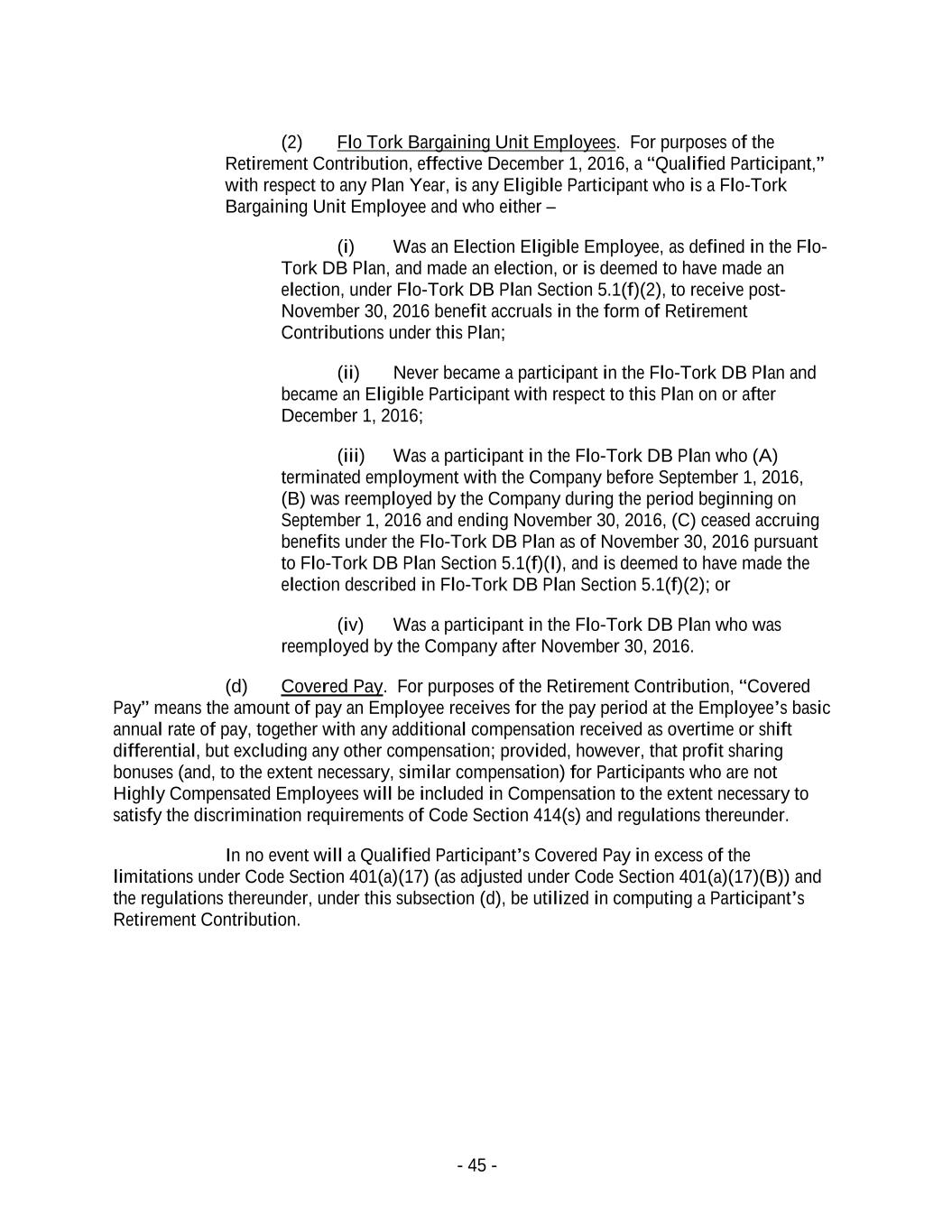
(2) Flo Tork Bargaining Unit Employees. For purposes of the Retirement Contribution, effective December 1, 2016, a “Qualified Participant,” with respect to any Plan Year, is any Eligible Participant who is a Flo-Tork Bargaining Unit Employee and who either – (i) Was an Election Eligible Employee, as defined in the Flo- Tork DB Plan, and made an election, or is deemed to have made an election, under Flo-Tork DB Plan Section 5.1(f)(2), to receive post- November 30, 2016 benefit accruals in the form of Retirement Contributions under this Plan; (ii) Never became a participant in the Flo-Tork DB Plan and became an Eligible Participant with respect to this Plan on or after December 1, 2016; (iii) Was a participant in the Flo-Tork DB Plan who (A) terminated employment with the Company before September 1, 2016, (B) was reemployed by the Company during the period beginning on September 1, 2016 and ending November 30, 2016, (C) ceased accruing benefits under the Flo-Tork DB Plan as of November 30, 2016 pursuant to Flo-Tork DB Plan Section 5.1(f)(I), and is deemed to have made the election described in Flo-Tork DB Plan Section 5.1(f)(2); or (iv) Was a participant in the Flo-Tork DB Plan who was reemployed by the Company after November 30, 2016. (d) Covered Pay. For purposes of the Retirement Contribution, “Covered Pay” means the amount of pay an Employee receives for the pay period at the Employee’s basic annual rate of pay, together with any additional compensation received as overtime or shift differential, but excluding any other compensation; provided, however, that profit sharing bonuses (and, to the extent necessary, similar compensation) for Participants who are not Highly Compensated Employees will be included in Compensation to the extent necessary to satisfy the discrimination requirements of Code Section 414(s) and regulations thereunder. In no event will a Qualified Participant’s Covered Pay in excess of the limitations under Code Section 401(a)(17) (as adjusted under Code Section 401(a)(17)(B)) and the regulations thereunder, under this subsection (d), be utilized in computing a Participant’s Retirement Contribution. - 45 -
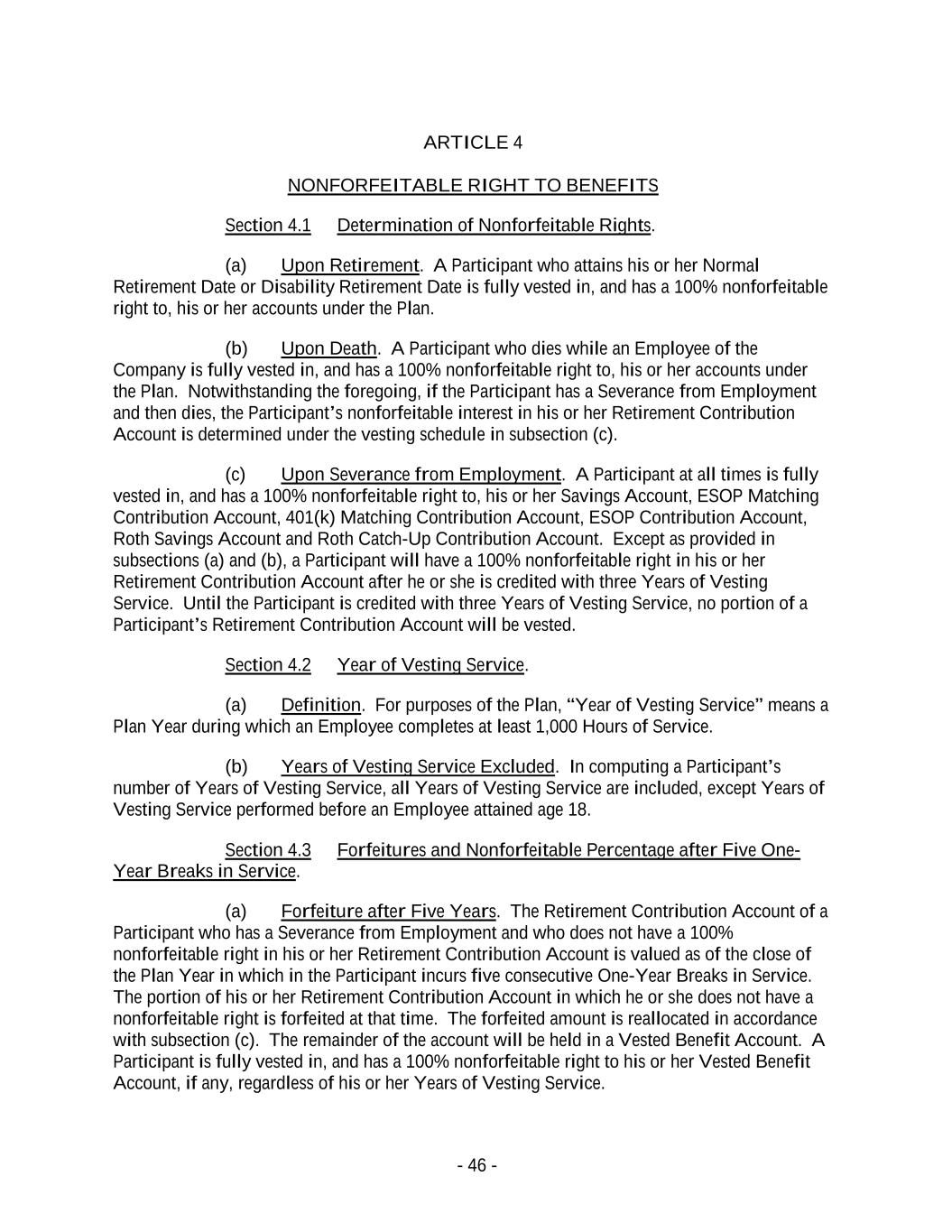
ARTICLE 4 NONFORFEITABLE RIGHT TO BENEFITS Section 4.1 Determination of Nonforfeitable Rights. (a) Upon Retirement. A Participant who attains his or her Normal Retirement Date or Disability Retirement Date is fully vested in, and has a 100% nonforfeitable right to, his or her accounts under the Plan. (b) Upon Death. A Participant who dies while an Employee of the Company is fully vested in, and has a 100% nonforfeitable right to, his or her accounts under the Plan. Notwithstanding the foregoing, if the Participant has a Severance from Employment and then dies, the Participant’s nonforfeitable interest in his or her Retirement Contribution Account is determined under the vesting schedule in subsection (c). (c) Upon Severance from Employment. A Participant at all times is fully vested in, and has a 100% nonforfeitable right to, his or her Savings Account, ESOP Matching Contribution Account, 401(k) Matching Contribution Account, ESOP Contribution Account, Roth Savings Account and Roth Catch-Up Contribution Account. Except as provided in subsections (a) and (b), a Participant will have a 100% nonforfeitable right in his or her Retirement Contribution Account after he or she is credited with three Years of Vesting Service. Until the Participant is credited with three Years of Vesting Service, no portion of a Participant’s Retirement Contribution Account will be vested. Section 4.2 Year of Vesting Service. (a) Definition. For purposes of the Plan, “Year of Vesting Service” means a Plan Year during which an Employee completes at least 1,000 Hours of Service. (b) Years of Vesting Service Excluded. In computing a Participant’s number of Years of Vesting Service, all Years of Vesting Service are included, except Years of Vesting Service performed before an Employee attained age 18. Section 4.3 Forfeitures and Nonforfeitable Percentage after Five One- Year Breaks in Service. (a) Forfeiture after Five Years. The Retirement Contribution Account of a Participant who has a Severance from Employment and who does not have a 100% nonforfeitable right in his or her Retirement Contribution Account is valued as of the close of the Plan Year in which in the Participant incurs five consecutive One-Year Breaks in Service. The portion of his or her Retirement Contribution Account in which he or she does not have a nonforfeitable right is forfeited at that time. The forfeited amount is reallocated in accordance with subsection (c). The remainder of the account will be held in a Vested Benefit Account. A Participant is fully vested in, and has a 100% nonforfeitable right to his or her Vested Benefit Account, if any, regardless of his or her Years of Vesting Service. - 46 -

Notwithstanding the foregoing paragraph -- (1) If a Participant receives a distribution of his or her entire nonforfeitable interest vested account balances under the Plan before he or she incurs five consecutive One-Year Breaks in Service, the portion of his or her Plan accounts in which he or she does not have a nonforfeitable interest, if any, is forfeited as of the date of distribution and is reallocated in accordance with subsection (c). A Participant who has a Severance from Employment with the Company and whose nonforfeitable interest in the Plan is $0.00 will be deemed to have received a distribution of his or her entire nonforfeitable interest in the Plan as of the date of the Severance from Employment. (2) If a Participant receives a distribution or deemed distribution in the form of a lump sum payment and is reemployed by the Company before he or she incurs five consecutive Breaks in Service, and if the Participant’s nonforfeitable percentage with respect to any account was less than 100%, the dollar amount forfeited by the Participant will be restored to the account from which it was forfeited within a reasonable period of time after reemployment. Any restoration of forfeited amounts under this Section will first be made from forfeitures, if any, available for restoring forfeited amounts under subsection (c) and then, if necessary, by an additional contribution by the Company. (b) Reemployment after Five One-Year Breaks in Service. Any Retirement Contribution allocated to a reemployed Participant after he or she incurs five consecutive One-Year Breaks in Service will be credited to a new Retirement Contribution Account. A Participant’s nonforfeitable interest in the new Retirement Contribution Account will be determined in accordance with Section 4.1. (c) Application of Forfeitures. Forfeitures resulting from the application of this Section 4.3 will not be applied to directly increase the allocation that any Participant would otherwise receive under the Plan. Forfeitures will be used, as directed by the Plan Administrator, (i) to reduce (but not below zero) the Retirement Contributions, if any, no later than the last day of the Plan Year following the Plan Year in which the forfeitures occurred, (ii) to restore any forfeited account balances as may be required under Section 4.3(a)(2), and (iii) if any forfeitures remain, to pay Plan expenses and Trustee compensation. - 47 -
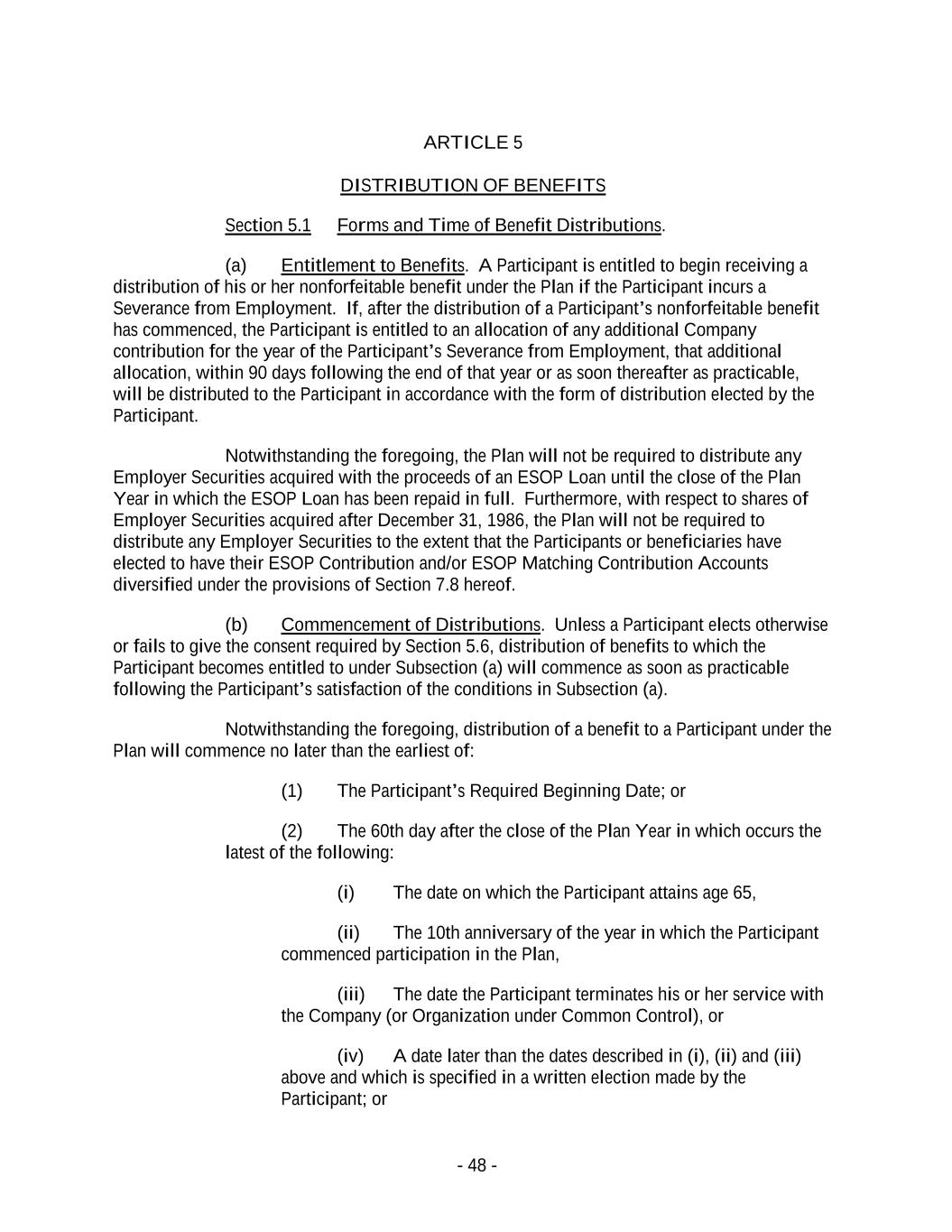
ARTICLE 5 DISTRIBUTION OF BENEFITS Section 5.1 Forms and Time of Benefit Distributions. (a) Entitlement to Benefits. A Participant is entitled to begin receiving a distribution of his or her nonforfeitable benefit under the Plan if the Participant incurs a Severance from Employment. If, after the distribution of a Participant’s nonforfeitable benefit has commenced, the Participant is entitled to an allocation of any additional Company contribution for the year of the Participant’s Severance from Employment, that additional allocation, within 90 days following the end of that year or as soon thereafter as practicable, will be distributed to the Participant in accordance with the form of distribution elected by the Participant. Notwithstanding the foregoing, the Plan will not be required to distribute any Employer Securities acquired with the proceeds of an ESOP Loan until the close of the Plan Year in which the ESOP Loan has been repaid in full. Furthermore, with respect to shares of Employer Securities acquired after December 31, 1986, the Plan will not be required to distribute any Employer Securities to the extent that the Participants or beneficiaries have elected to have their ESOP Contribution and/or ESOP Matching Contribution Accounts diversified under the provisions of Section 7.8 hereof. (b) Commencement of Distributions. Unless a Participant elects otherwise or fails to give the consent required by Section 5.6, distribution of benefits to which the Participant becomes entitled to under Subsection (a) will commence as soon as practicable following the Participant’s satisfaction of the conditions in Subsection (a). Notwithstanding the foregoing, distribution of a benefit to a Participant under the Plan will commence no later than the earliest of: (1) The Participant’s Required Beginning Date; or (2) The 60th day after the close of the Plan Year in which occurs the latest of the following: (i) The date on which the Participant attains age 65, (ii) The 10th anniversary of the year in which the Participant commenced participation in the Plan, (iii) The date the Participant terminates his or her service with the Company (or Organization under Common Control), or (iv) A date later than the dates described in (i), (ii) and (iii) above and which is specified in a written election made by the Participant; or - 48 -
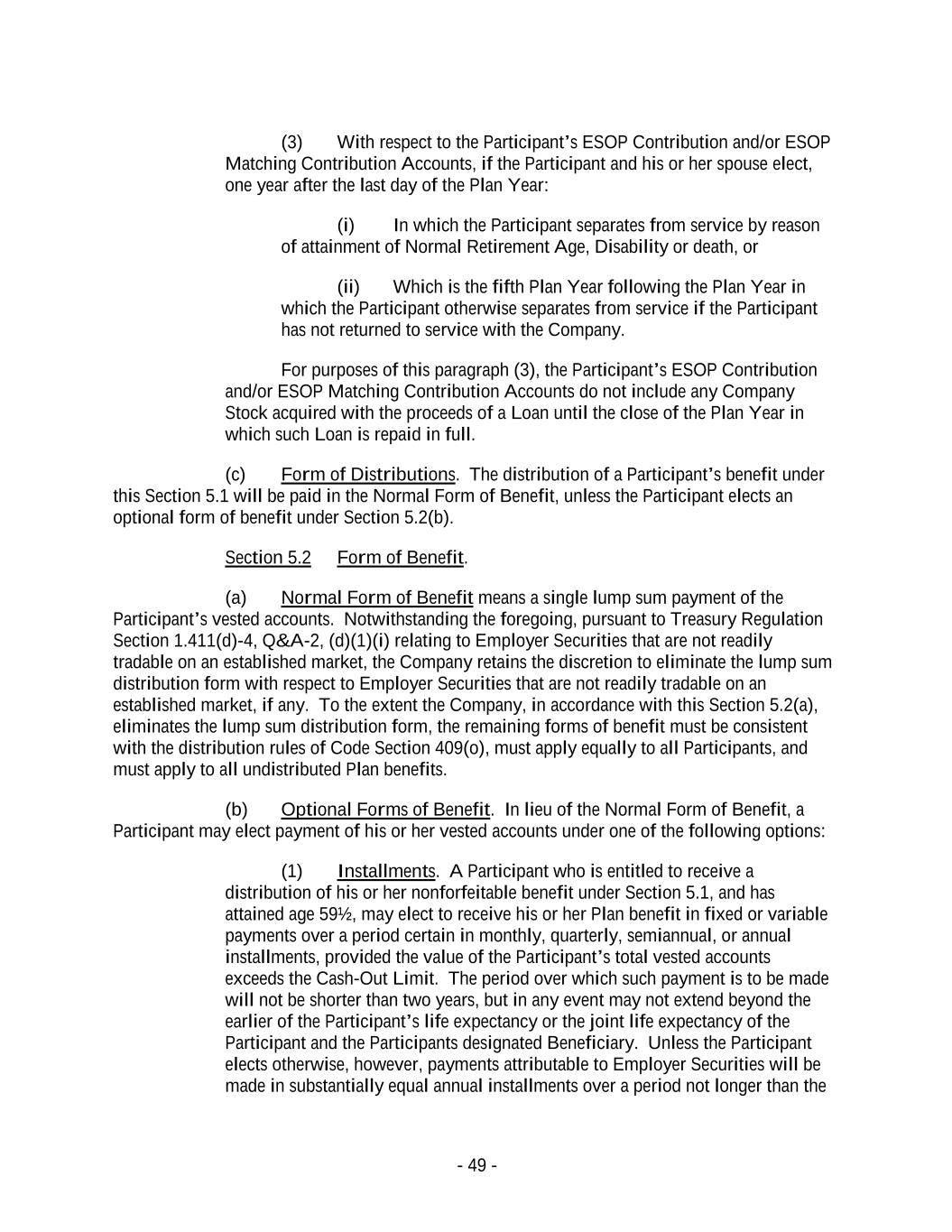
(3) With respect to the Participant’s ESOP Contribution and/or ESOP Matching Contribution Accounts, if the Participant and his or her spouse elect, one year after the last day of the Plan Year: (i) In which the Participant separates from service by reason of attainment of Normal Retirement Age, Disability or death, or (ii) Which is the fifth Plan Year following the Plan Year in which the Participant otherwise separates from service if the Participant has not returned to service with the Company. For purposes of this paragraph (3), the Participant’s ESOP Contribution and/or ESOP Matching Contribution Accounts do not include any Company Stock acquired with the proceeds of a Loan until the close of the Plan Year in which such Loan is repaid in full. (c) Form of Distributions. The distribution of a Participant’s benefit under this Section 5.1 will be paid in the Normal Form of Benefit, unless the Participant elects an optional form of benefit under Section 5.2(b). Section 5.2 Form of Benefit. (a) Normal Form of Benefit means a single lump sum payment of the Participant’s vested accounts. Notwithstanding the foregoing, pursuant to Treasury Regulation Section 1.411(d)-4, Q&A-2, (d)(1)(i) relating to Employer Securities that are not readily tradable on an established market, the Company retains the discretion to eliminate the lump sum distribution form with respect to Employer Securities that are not readily tradable on an established market, if any. To the extent the Company, in accordance with this Section 5.2(a), eliminates the lump sum distribution form, the remaining forms of benefit must be consistent with the distribution rules of Code Section 409(o), must apply equally to all Participants, and must apply to all undistributed Plan benefits. (b) Optional Forms of Benefit. In lieu of the Normal Form of Benefit, a Participant may elect payment of his or her vested accounts under one of the following options: (1) Installments. A Participant who is entitled to receive a distribution of his or her nonforfeitable benefit under Section 5.1, and has attained age 59½, may elect to receive his or her Plan benefit in fixed or variable payments over a period certain in monthly, quarterly, semiannual, or annual installments, provided the value of the Participant’s total vested accounts exceeds the Cash-Out Limit. The period over which such payment is to be made will not be shorter than two years, but in any event may not extend beyond the earlier of the Participant’s life expectancy or the joint life expectancy of the Participant and the Participants designated Beneficiary. Unless the Participant elects otherwise, however, payments attributable to Employer Securities will be made in substantially equal annual installments over a period not longer than the - 49 -
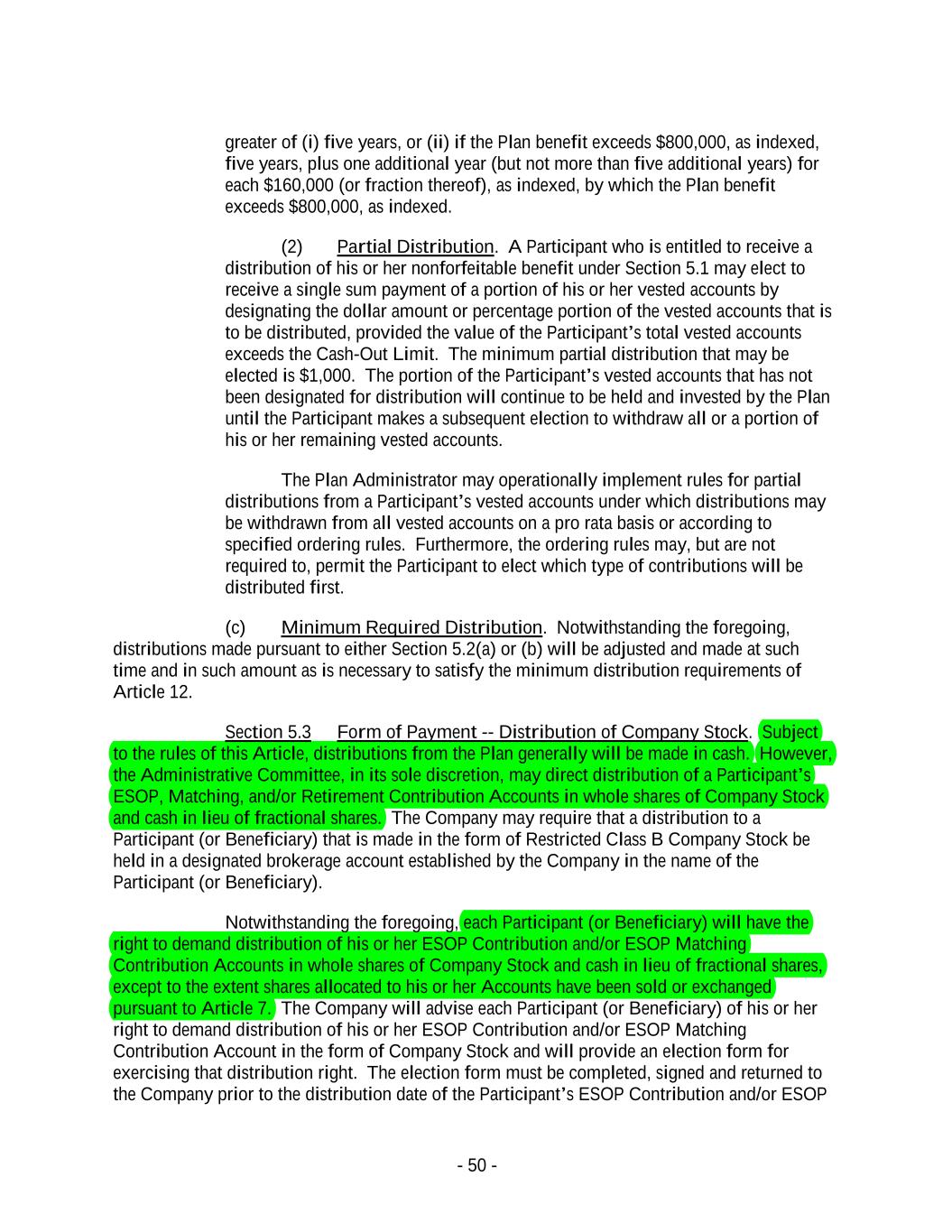
greater of (i) five years, or (ii) if the Plan benefit exceeds $800,000, as indexed, five years, plus one additional year (but not more than five additional years) for each $160,000 (or fraction thereof), as indexed, by which the Plan benefit exceeds $800,000, as indexed. (2) Partial Distribution. A Participant who is entitled to receive a distribution of his or her nonforfeitable benefit under Section 5.1 may elect to receive a single sum payment of a portion of his or her vested accounts by designating the dollar amount or percentage portion of the vested accounts that is to be distributed, provided the value of the Participant’s total vested accounts exceeds the Cash-Out Limit. The minimum partial distribution that may be elected is $1,000. The portion of the Participant’s vested accounts that has not been designated for distribution will continue to be held and invested by the Plan until the Participant makes a subsequent election to withdraw all or a portion of his or her remaining vested accounts. The Plan Administrator may operationally implement rules for partial distributions from a Participant’s vested accounts under which distributions may be withdrawn from all vested accounts on a pro rata basis or according to specified ordering rules. Furthermore, the ordering rules may, but are not required to, permit the Participant to elect which type of contributions will be distributed first. (c) Minimum Required Distribution. Notwithstanding the foregoing, distributions made pursuant to either Section 5.2(a) or (b) will be adjusted and made at such time and in such amount as is necessary to satisfy the minimum distribution requirements of Article 12. Section 5.3 Form of Payment -- Distribution of Company Stock. Subject to the rules of this Article, distributions from the Plan generally will be made in cash. However, the Administrative Committee, in its sole discretion, may direct distribution of a Participant’s ESOP, Matching, and/or Retirement Contribution Accounts in whole shares of Company Stock and cash in lieu of fractional shares. The Company may require that a distribution to a Participant (or Beneficiary) that is made in the form of Restricted Class B Company Stock be held in a designated brokerage account established by the Company in the name of the Participant (or Beneficiary). Notwithstanding the foregoing, each Participant (or Beneficiary) will have the right to demand distribution of his or her ESOP Contribution and/or ESOP Matching Contribution Accounts in whole shares of Company Stock and cash in lieu of fractional shares, except to the extent shares allocated to his or her Accounts have been sold or exchanged pursuant to Article 7. The Company will advise each Participant (or Beneficiary) of his or her right to demand distribution of his or her ESOP Contribution and/or ESOP Matching Contribution Account in the form of Company Stock and will provide an election form for exercising that distribution right. The election form must be completed, signed and returned to the Company prior to the distribution date of the Participant’s ESOP Contribution and/or ESOP - 50 -

Matching Contribution Account (or the commencement date of installments, if applicable) and will be ineffective thereafter. The Company may require that a distribution to a Participant (or Beneficiary) made on or after February 1, 2007 that is made in the form of Restricted Class B Company Stock may be held in a designated brokerage account established by the Company in the name of the Participant (or Beneficiary). For purposes of the Plan, the term “Restricted Class B Company Stock” means shares of Class B Company Stock that were not acquired with proceeds of an ESOP Loan. Section 5.4 Designation of Death Beneficiary. Each Participant may designate a specific Prospective Beneficiary, including any class of Prospective Beneficiaries or any contingent Prospective Beneficiaries, for the benefits provided on his or her death under the Plan. That designation may be changed from time to time. All designations must be made in a manner acceptable to the Plan Administrator, and will not be effective unless and until filed with the Plan Administrator prior to such Participant’s death. A married Participant may designate a Prospective Beneficiary other than his or her spouse if the spouse consents in writing to the designation. Spousal consent will not be required if it is established to the Plan Administrator’s satisfaction that spousal consent may not be obtained because either there is no spouse or the spouse cannot be located, or because of other circumstances provided in applicable regulations. Spousal consent must acknowledge the effect of the designation and must be witnessed by a representative of the Plan Administrator or a notary public. No such designation will be effective if the Prospective Beneficiary may be changed without the consent of the spouse, unless the spouse’s consent expressly permits changes in Prospective Beneficiary designations by the Participant without any requirement of further consent of the spouse. Any consent by a spouse under this Section will be effective only with respect to that spouse. Any designation of a Prospective Beneficiary made by an unmarried Participant who subsequently marries will be ineffective unless the Participant’s spouse is the Prospective Beneficiary or consents to the designation. Notwithstanding the foregoing, the Plan will not be required to distribute any Company Stock acquired with the proceeds of an ESOP Loan until the close of the Plan Year in which the ESOP Loan is repaid in full. Section 5.5 Death Benefit Provisions. (a) Normal Form of Payment of Death Benefits. If a Participant dies before his or her benefits under the Plan have been fully distributed, the Participant’s entire remaining nonforfeitable interest in the Plan will be distributed to his or her Beneficiary in a single lump sum payment in cash and/or property (as determined by the Plan Administrator in accordance with a uniform, nondiscriminatory policy) as soon as practicable following the Participant’s death, but in any event not later than December 31 of the calendar year in which the fifth anniversary of the Participant’s death occurs. If, however, the Participant’s Beneficiary is his or her surviving spouse, the Participant’s surviving spouse may defer distribution after the Participant’s death until December 31 of the calendar year in which the Participant would have attained age 70½, at - 51 -
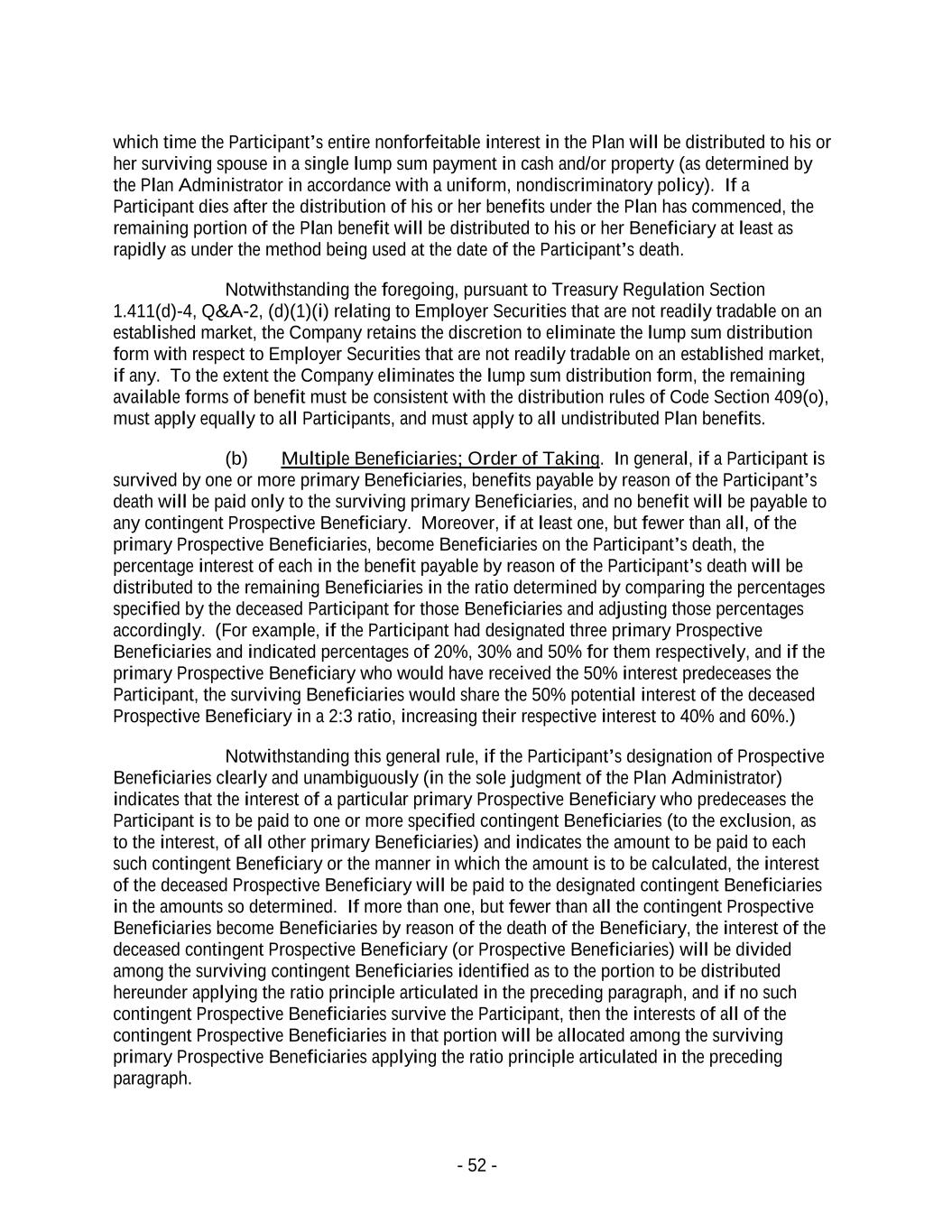
which time the Participant’s entire nonforfeitable interest in the Plan will be distributed to his or her surviving spouse in a single lump sum payment in cash and/or property (as determined by the Plan Administrator in accordance with a uniform, nondiscriminatory policy). If a Participant dies after the distribution of his or her benefits under the Plan has commenced, the remaining portion of the Plan benefit will be distributed to his or her Beneficiary at least as rapidly as under the method being used at the date of the Participant’s death. Notwithstanding the foregoing, pursuant to Treasury Regulation Section 1.411(d)-4, Q&A-2, (d)(1)(i) relating to Employer Securities that are not readily tradable on an established market, the Company retains the discretion to eliminate the lump sum distribution form with respect to Employer Securities that are not readily tradable on an established market, if any. To the extent the Company eliminates the lump sum distribution form, the remaining available forms of benefit must be consistent with the distribution rules of Code Section 409(o), must apply equally to all Participants, and must apply to all undistributed Plan benefits. (b) Multiple Beneficiaries; Order of Taking. In general, if a Participant is survived by one or more primary Beneficiaries, benefits payable by reason of the Participant’s death will be paid only to the surviving primary Beneficiaries, and no benefit will be payable to any contingent Prospective Beneficiary. Moreover, if at least one, but fewer than all, of the primary Prospective Beneficiaries, become Beneficiaries on the Participant’s death, the percentage interest of each in the benefit payable by reason of the Participant’s death will be distributed to the remaining Beneficiaries in the ratio determined by comparing the percentages specified by the deceased Participant for those Beneficiaries and adjusting those percentages accordingly. (For example, if the Participant had designated three primary Prospective Beneficiaries and indicated percentages of 20%, 30% and 50% for them respectively, and if the primary Prospective Beneficiary who would have received the 50% interest predeceases the Participant, the surviving Beneficiaries would share the 50% potential interest of the deceased Prospective Beneficiary in a 2:3 ratio, increasing their respective interest to 40% and 60%.) Notwithstanding this general rule, if the Participant’s designation of Prospective Beneficiaries clearly and unambiguously (in the sole judgment of the Plan Administrator) indicates that the interest of a particular primary Prospective Beneficiary who predeceases the Participant is to be paid to one or more specified contingent Beneficiaries (to the exclusion, as to the interest, of all other primary Beneficiaries) and indicates the amount to be paid to each such contingent Beneficiary or the manner in which the amount is to be calculated, the interest of the deceased Prospective Beneficiary will be paid to the designated contingent Beneficiaries in the amounts so determined. If more than one, but fewer than all the contingent Prospective Beneficiaries become Beneficiaries by reason of the death of the Beneficiary, the interest of the deceased contingent Prospective Beneficiary (or Prospective Beneficiaries) will be divided among the surviving contingent Beneficiaries identified as to the portion to be distributed hereunder applying the ratio principle articulated in the preceding paragraph, and if no such contingent Prospective Beneficiaries survive the Participant, then the interests of all of the contingent Prospective Beneficiaries in that portion will be allocated among the surviving primary Prospective Beneficiaries applying the ratio principle articulated in the preceding paragraph. - 52 -
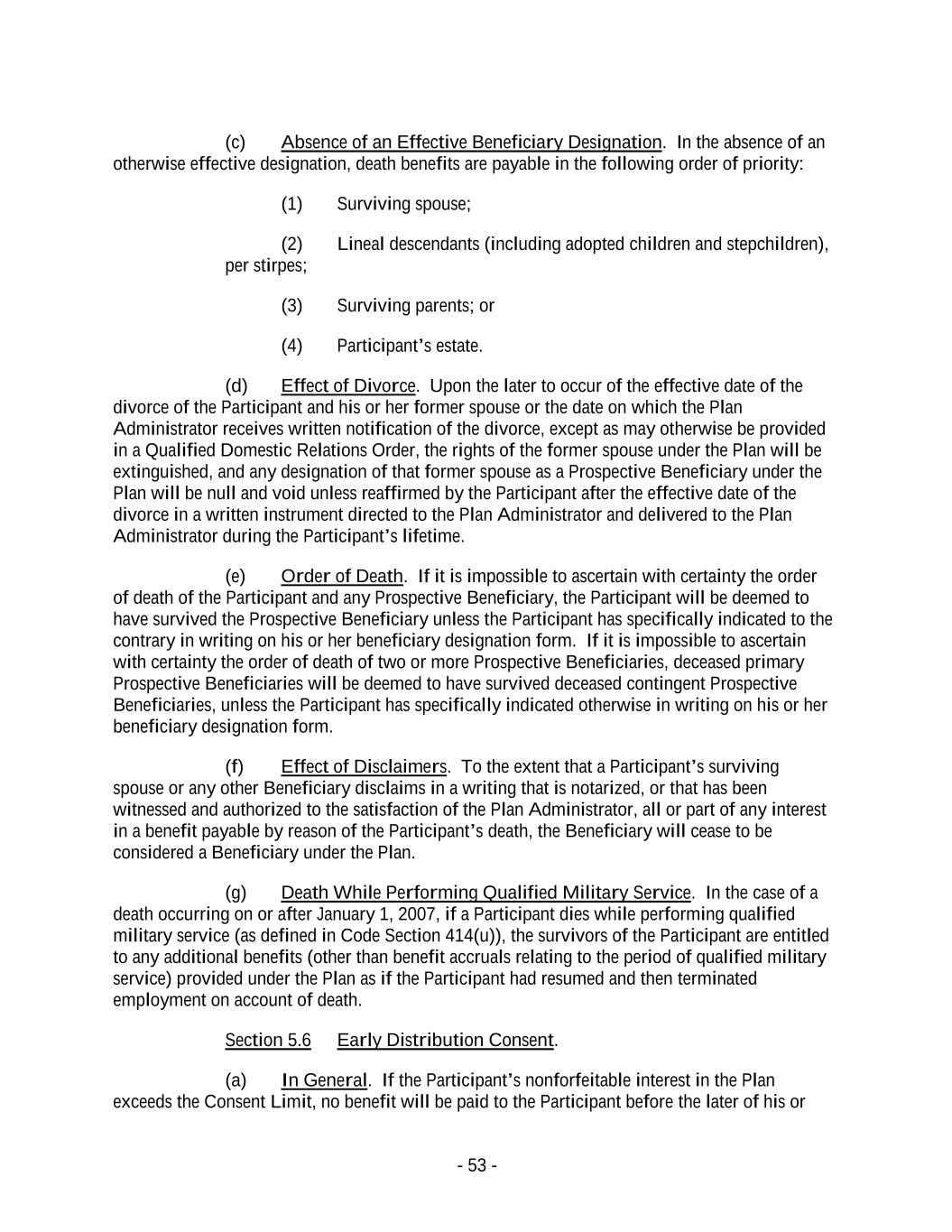
(c) Absence of an Effective Beneficiary Designation. In the absence of an otherwise effective designation, death benefits are payable in the following order of priority: (1) Surviving spouse; (2) Lineal descendants (including adopted children and stepchildren), per stirpes; (3) Surviving parents; or (4) Participant’s estate. (d) Effect of Divorce. Upon the later to occur of the effective date of the divorce of the Participant and his or her former spouse or the date on which the Plan Administrator receives written notification of the divorce, except as may otherwise be provided in a Qualified Domestic Relations Order, the rights of the former spouse under the Plan will be extinguished, and any designation of that former spouse as a Prospective Beneficiary under the Plan will be null and void unless reaffirmed by the Participant after the effective date of the divorce in a written instrument directed to the Plan Administrator and delivered to the Plan Administrator during the Participant’s lifetime. (e) Order of Death. If it is impossible to ascertain with certainty the order of death of the Participant and any Prospective Beneficiary, the Participant will be deemed to have survived the Prospective Beneficiary unless the Participant has specifically indicated to the contrary in writing on his or her beneficiary designation form. If it is impossible to ascertain with certainty the order of death of two or more Prospective Beneficiaries, deceased primary Prospective Beneficiaries will be deemed to have survived deceased contingent Prospective Beneficiaries, unless the Participant has specifically indicated otherwise in writing on his or her beneficiary designation form. (f) Effect of Disclaimers. To the extent that a Participant’s surviving spouse or any other Beneficiary disclaims in a writing that is notarized, or that has been witnessed and authorized to the satisfaction of the Plan Administrator, all or part of any interest in a benefit payable by reason of the Participant’s death, the Beneficiary will cease to be considered a Beneficiary under the Plan. (g) Death While Performing Qualified Military Service. In the case of a death occurring on or after January 1, 2007, if a Participant dies while performing qualified military service (as defined in Code Section 414(u)), the survivors of the Participant are entitled to any additional benefits (other than benefit accruals relating to the period of qualified military service) provided under the Plan as if the Participant had resumed and then terminated employment on account of death. Section 5.6 Early Distribution Consent. (a) In General. If the Participant’s nonforfeitable interest in the Plan exceeds the Consent Limit, no benefit will be paid to the Participant before the later of his or - 53 -
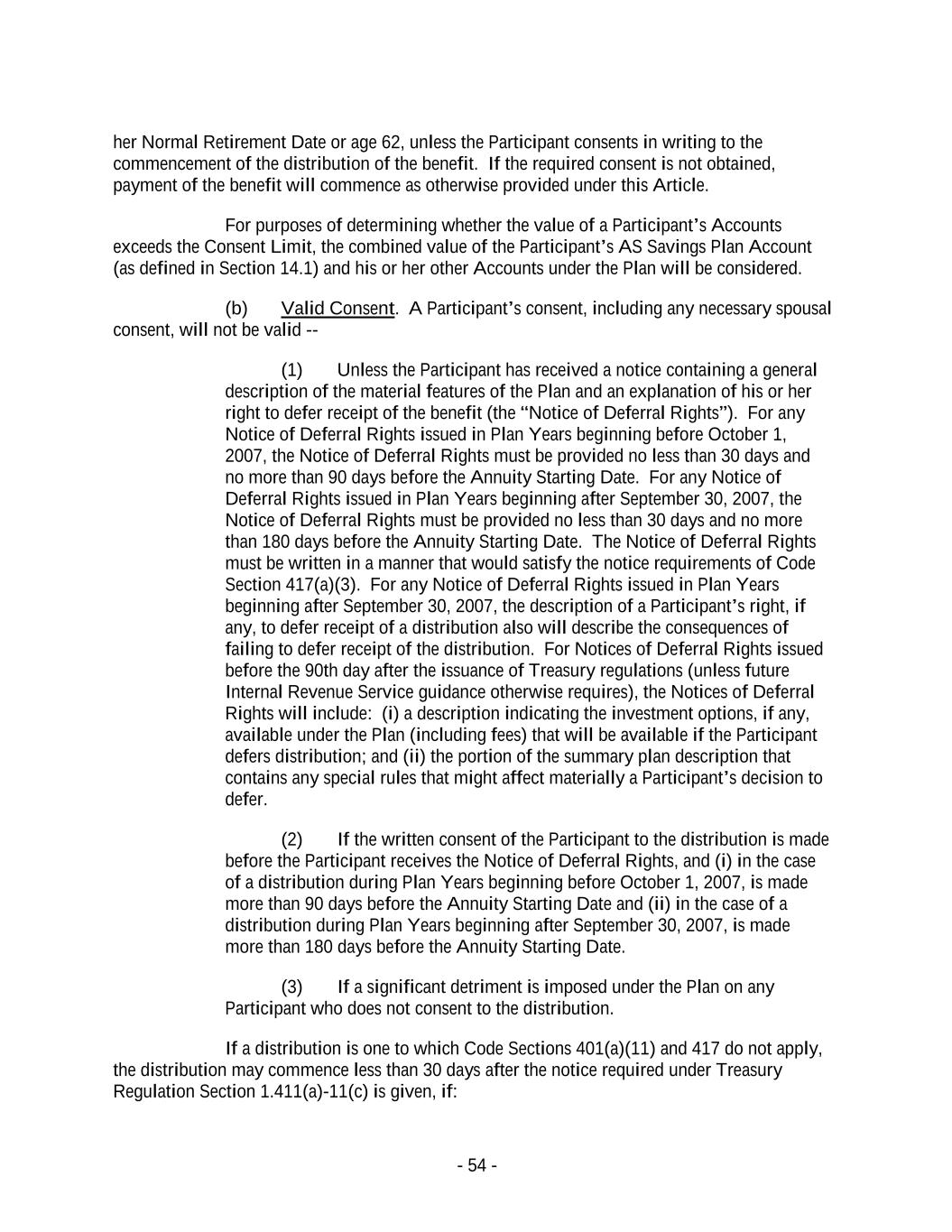
her Normal Retirement Date or age 62, unless the Participant consents in writing to the commencement of the distribution of the benefit. If the required consent is not obtained, payment of the benefit will commence as otherwise provided under this Article. For purposes of determining whether the value of a Participant’s Accounts exceeds the Consent Limit, the combined value of the Participant’s AS Savings Plan Account (as defined in Section 14.1) and his or her other Accounts under the Plan will be considered. (b) Valid Consent. A Participant’s consent, including any necessary spousal consent, will not be valid -- (1) Unless the Participant has received a notice containing a general description of the material features of the Plan and an explanation of his or her right to defer receipt of the benefit (the “Notice of Deferral Rights”). For any Notice of Deferral Rights issued in Plan Years beginning before October 1, 2007, the Notice of Deferral Rights must be provided no less than 30 days and no more than 90 days before the Annuity Starting Date. For any Notice of Deferral Rights issued in Plan Years beginning after September 30, 2007, the Notice of Deferral Rights must be provided no less than 30 days and no more than 180 days before the Annuity Starting Date. The Notice of Deferral Rights must be written in a manner that would satisfy the notice requirements of Code Section 417(a)(3). For any Notice of Deferral Rights issued in Plan Years beginning after September 30, 2007, the description of a Participant’s right, if any, to defer receipt of a distribution also will describe the consequences of failing to defer receipt of the distribution. For Notices of Deferral Rights issued before the 90th day after the issuance of Treasury regulations (unless future Internal Revenue Service guidance otherwise requires), the Notices of Deferral Rights will include: (i) a description indicating the investment options, if any, available under the Plan (including fees) that will be available if the Participant defers distribution; and (ii) the portion of the summary plan description that contains any special rules that might affect materially a Participant’s decision to defer. (2) If the written consent of the Participant to the distribution is made before the Participant receives the Notice of Deferral Rights, and (i) in the case of a distribution during Plan Years beginning before October 1, 2007, is made more than 90 days before the Annuity Starting Date and (ii) in the case of a distribution during Plan Years beginning after September 30, 2007, is made more than 180 days before the Annuity Starting Date. (3) If a significant detriment is imposed under the Plan on any Participant who does not consent to the distribution. If a distribution is one to which Code Sections 401(a)(11) and 417 do not apply, the distribution may commence less than 30 days after the notice required under Treasury Regulation Section 1.411(a)-11(c) is given, if: - 54 -
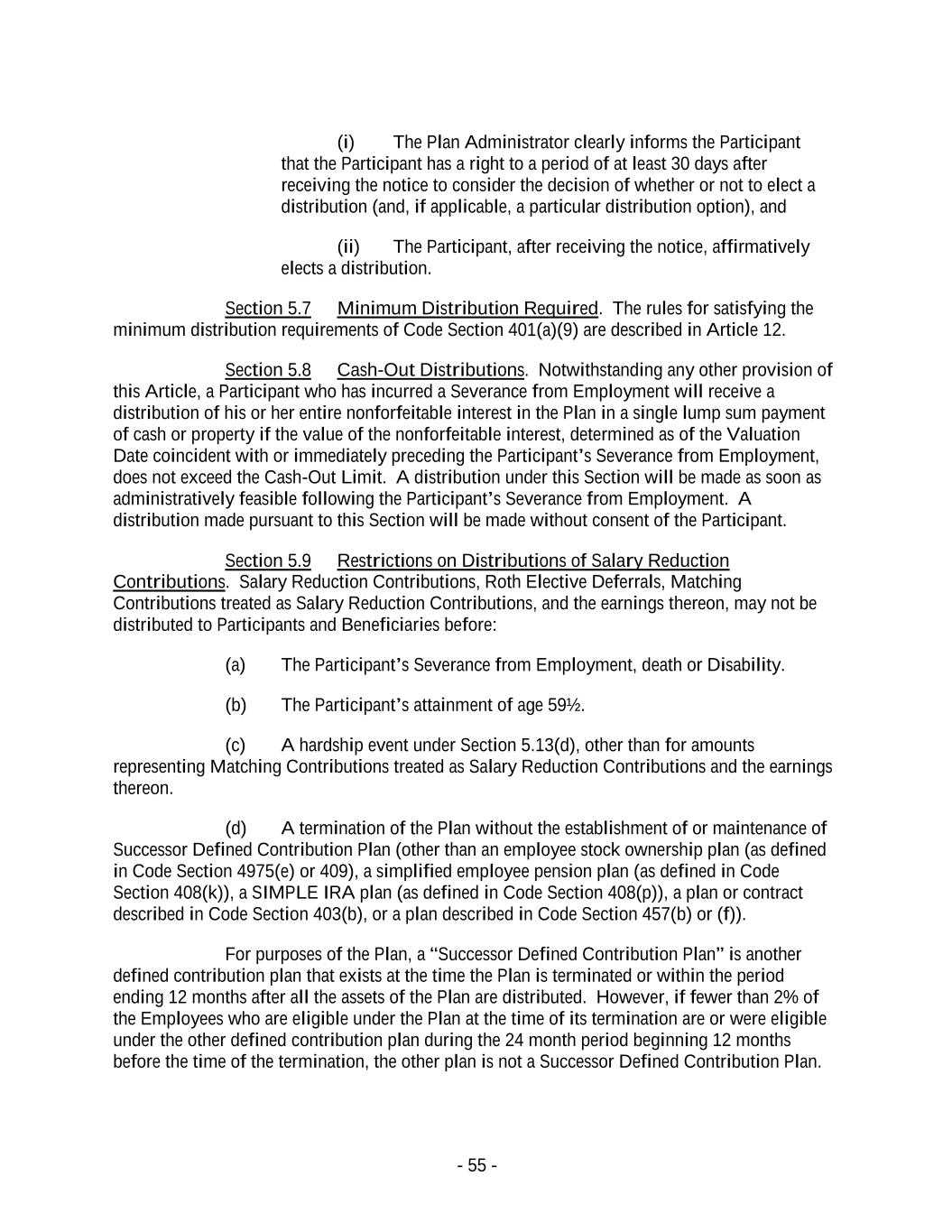
(i) The Plan Administrator clearly informs the Participant that the Participant has a right to a period of at least 30 days after receiving the notice to consider the decision of whether or not to elect a distribution (and, if applicable, a particular distribution option), and (ii) The Participant, after receiving the notice, affirmatively elects a distribution. Section 5.7 Minimum Distribution Required. The rules for satisfying the minimum distribution requirements of Code Section 401(a)(9) are described in Article 12. Section 5.8 Cash-Out Distributions. Notwithstanding any other provision of this Article, a Participant who has incurred a Severance from Employment will receive a distribution of his or her entire nonforfeitable interest in the Plan in a single lump sum payment of cash or property if the value of the nonforfeitable interest, determined as of the Valuation Date coincident with or immediately preceding the Participant’s Severance from Employment, does not exceed the Cash-Out Limit. A distribution under this Section will be made as soon as administratively feasible following the Participant’s Severance from Employment. A distribution made pursuant to this Section will be made without consent of the Participant. Section 5.9 Restrictions on Distributions of Salary Reduction Contributions. Salary Reduction Contributions, Roth Elective Deferrals, Matching Contributions treated as Salary Reduction Contributions, and the earnings thereon, may not be distributed to Participants and Beneficiaries before: (a) The Participant’s Severance from Employment, death or Disability. (b) The Participant’s attainment of age 59½. (c) A hardship event under Section 5.13(d), other than for amounts representing Matching Contributions treated as Salary Reduction Contributions and the earnings thereon. (d) A termination of the Plan without the establishment of or maintenance of Successor Defined Contribution Plan (other than an employee stock ownership plan (as defined in Code Section 4975(e) or 409), a simplified employee pension plan (as defined in Code Section 408(k)), a SIMPLE IRA plan (as defined in Code Section 408(p)), a plan or contract described in Code Section 403(b), or a plan described in Code Section 457(b) or (f)). For purposes of the Plan, a “Successor Defined Contribution Plan” is another defined contribution plan that exists at the time the Plan is terminated or within the period ending 12 months after all the assets of the Plan are distributed. However, if fewer than 2% of the Employees who are eligible under the Plan at the time of its termination are or were eligible under the other defined contribution plan during the 24 month period beginning 12 months before the time of the termination, the other plan is not a Successor Defined Contribution Plan. - 55 -
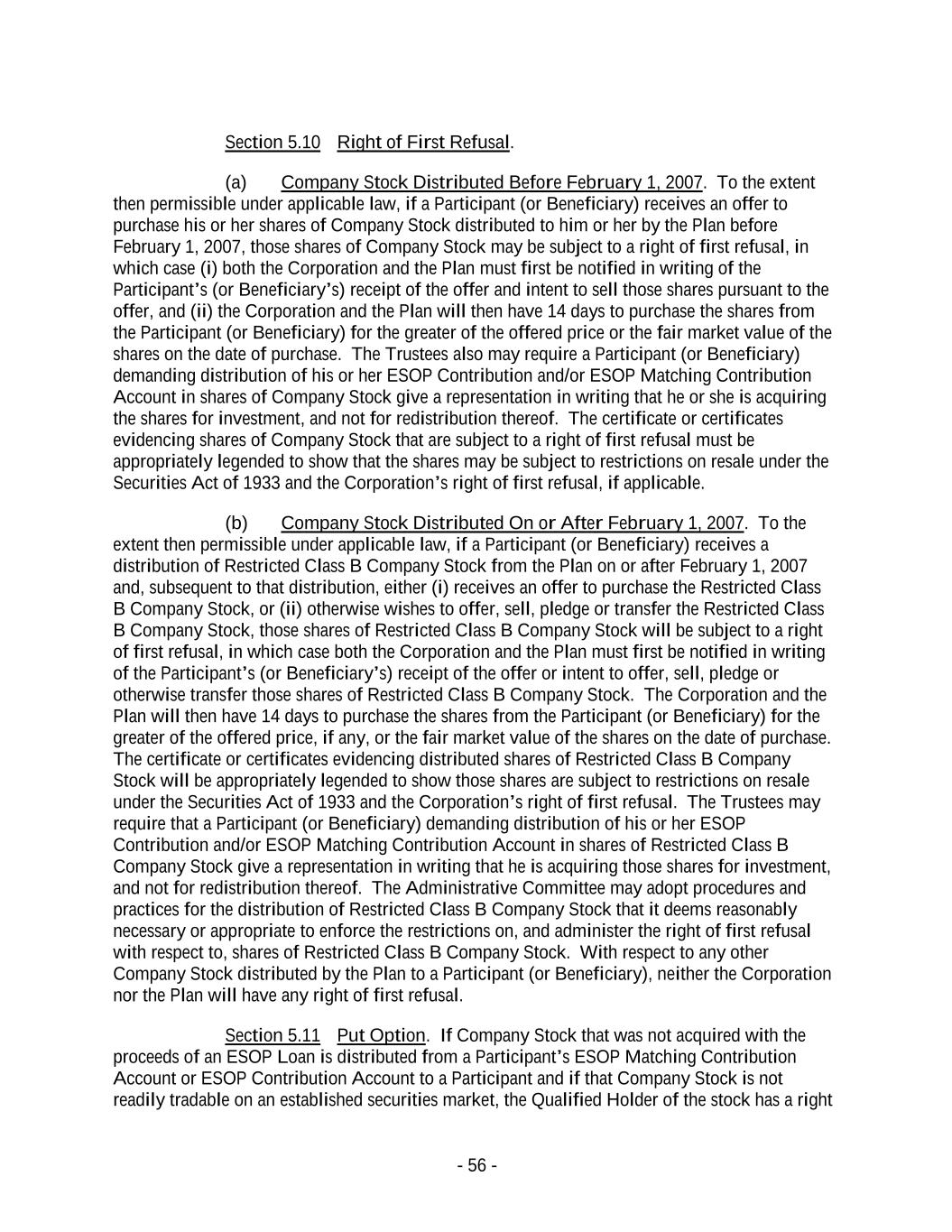
Section 5.10 Right of First Refusal. (a) Company Stock Distributed Before February 1, 2007. To the extent then permissible under applicable law, if a Participant (or Beneficiary) receives an offer to purchase his or her shares of Company Stock distributed to him or her by the Plan before February 1, 2007, those shares of Company Stock may be subject to a right of first refusal, in which case (i) both the Corporation and the Plan must first be notified in writing of the Participant’s (or Beneficiary’s) receipt of the offer and intent to sell those shares pursuant to the offer, and (ii) the Corporation and the Plan will then have 14 days to purchase the shares from the Participant (or Beneficiary) for the greater of the offered price or the fair market value of the shares on the date of purchase. The Trustees also may require a Participant (or Beneficiary) demanding distribution of his or her ESOP Contribution and/or ESOP Matching Contribution Account in shares of Company Stock give a representation in writing that he or she is acquiring the shares for investment, and not for redistribution thereof. The certificate or certificates evidencing shares of Company Stock that are subject to a right of first refusal must be appropriately legended to show that the shares may be subject to restrictions on resale under the Securities Act of 1933 and the Corporation’s right of first refusal, if applicable. (b) Company Stock Distributed On or After February 1, 2007. To the extent then permissible under applicable law, if a Participant (or Beneficiary) receives a distribution of Restricted Class B Company Stock from the Plan on or after February 1, 2007 and, subsequent to that distribution, either (i) receives an offer to purchase the Restricted Class B Company Stock, or (ii) otherwise wishes to offer, sell, pledge or transfer the Restricted Class B Company Stock, those shares of Restricted Class B Company Stock will be subject to a right of first refusal, in which case both the Corporation and the Plan must first be notified in writing of the Participant’s (or Beneficiary’s) receipt of the offer or intent to offer, sell, pledge or otherwise transfer those shares of Restricted Class B Company Stock. The Corporation and the Plan will then have 14 days to purchase the shares from the Participant (or Beneficiary) for the greater of the offered price, if any, or the fair market value of the shares on the date of purchase. The certificate or certificates evidencing distributed shares of Restricted Class B Company Stock will be appropriately legended to show those shares are subject to restrictions on resale under the Securities Act of 1933 and the Corporation’s right of first refusal. The Trustees may require that a Participant (or Beneficiary) demanding distribution of his or her ESOP Contribution and/or ESOP Matching Contribution Account in shares of Restricted Class B Company Stock give a representation in writing that he is acquiring those shares for investment, and not for redistribution thereof. The Administrative Committee may adopt procedures and practices for the distribution of Restricted Class B Company Stock that it deems reasonably necessary or appropriate to enforce the restrictions on, and administer the right of first refusal with respect to, shares of Restricted Class B Company Stock. With respect to any other Company Stock distributed by the Plan to a Participant (or Beneficiary), neither the Corporation nor the Plan will have any right of first refusal. Section 5.11 Put Option. If Company Stock that was not acquired with the proceeds of an ESOP Loan is distributed from a Participant’s ESOP Matching Contribution Account or ESOP Contribution Account to a Participant and if that Company Stock is not readily tradable on an established securities market, the Qualified Holder of the stock has a right - 56 -
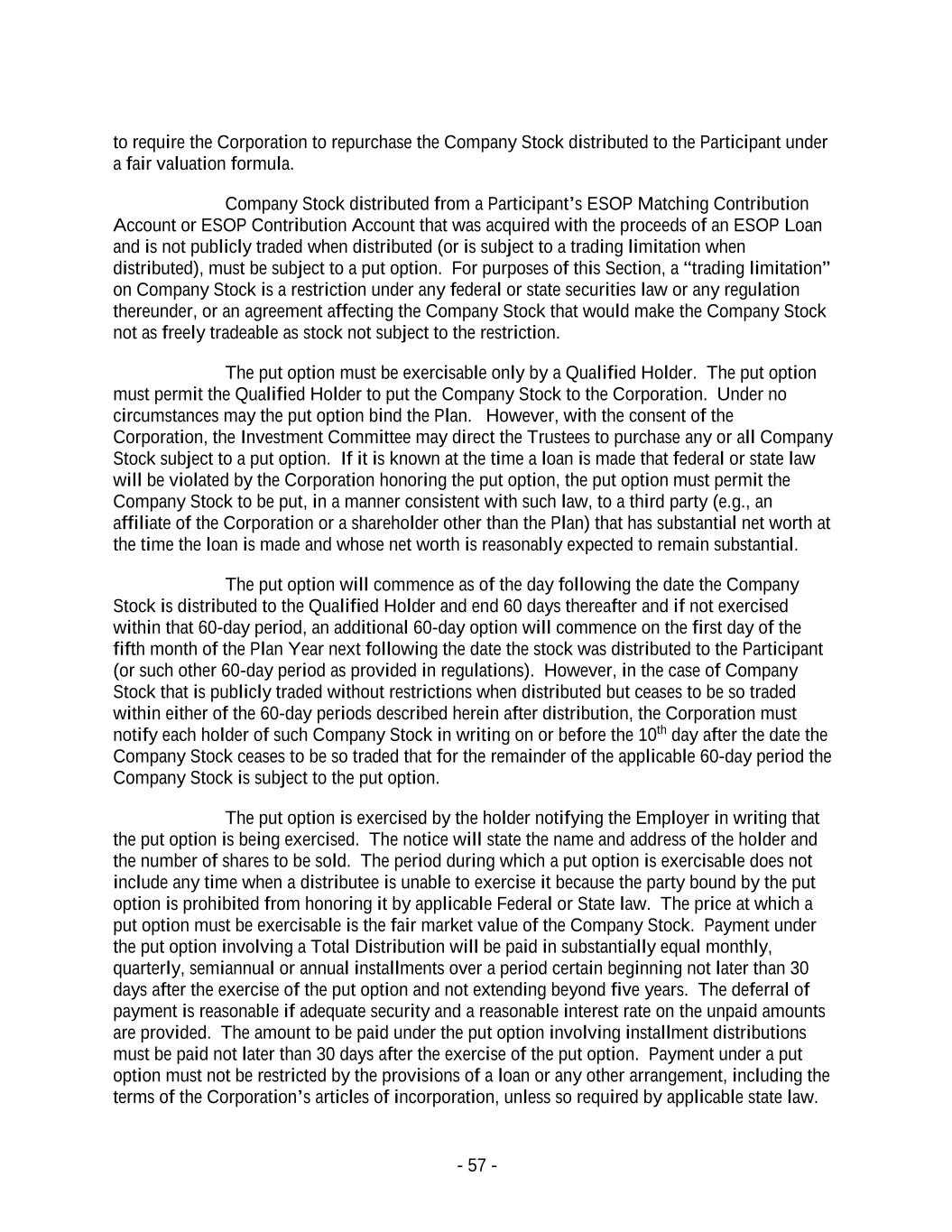
to require the Corporation to repurchase the Company Stock distributed to the Participant under a fair valuation formula. Company Stock distributed from a Participant’s ESOP Matching Contribution Account or ESOP Contribution Account that was acquired with the proceeds of an ESOP Loan and is not publicly traded when distributed (or is subject to a trading limitation when distributed), must be subject to a put option. For purposes of this Section, a “trading limitation” on Company Stock is a restriction under any federal or state securities law or any regulation thereunder, or an agreement affecting the Company Stock that would make the Company Stock not as freely tradeable as stock not subject to the restriction. The put option must be exercisable only by a Qualified Holder. The put option must permit the Qualified Holder to put the Company Stock to the Corporation. Under no circumstances may the put option bind the Plan. However, with the consent of the Corporation, the Investment Committee may direct the Trustees to purchase any or all Company Stock subject to a put option. If it is known at the time a loan is made that federal or state law will be violated by the Corporation honoring the put option, the put option must permit the Company Stock to be put, in a manner consistent with such law, to a third party (e.g., an affiliate of the Corporation or a shareholder other than the Plan) that has substantial net worth at the time the loan is made and whose net worth is reasonably expected to remain substantial. The put option will commence as of the day following the date the Company Stock is distributed to the Qualified Holder and end 60 days thereafter and if not exercised within that 60-day period, an additional 60-day option will commence on the first day of the fifth month of the Plan Year next following the date the stock was distributed to the Participant (or such other 60-day period as provided in regulations). However, in the case of Company Stock that is publicly traded without restrictions when distributed but ceases to be so traded within either of the 60-day periods described herein after distribution, the Corporation must notify each holder of such Company Stock in writing on or before the 10th day after the date the Company Stock ceases to be so traded that for the remainder of the applicable 60-day period the Company Stock is subject to the put option. The put option is exercised by the holder notifying the Employer in writing that the put option is being exercised. The notice will state the name and address of the holder and the number of shares to be sold. The period during which a put option is exercisable does not include any time when a distributee is unable to exercise it because the party bound by the put option is prohibited from honoring it by applicable Federal or State law. The price at which a put option must be exercisable is the fair market value of the Company Stock. Payment under the put option involving a Total Distribution will be paid in substantially equal monthly, quarterly, semiannual or annual installments over a period certain beginning not later than 30 days after the exercise of the put option and not extending beyond five years. The deferral of payment is reasonable if adequate security and a reasonable interest rate on the unpaid amounts are provided. The amount to be paid under the put option involving installment distributions must be paid not later than 30 days after the exercise of the put option. Payment under a put option must not be restricted by the provisions of a loan or any other arrangement, including the terms of the Corporation’s articles of incorporation, unless so required by applicable state law. - 57 -
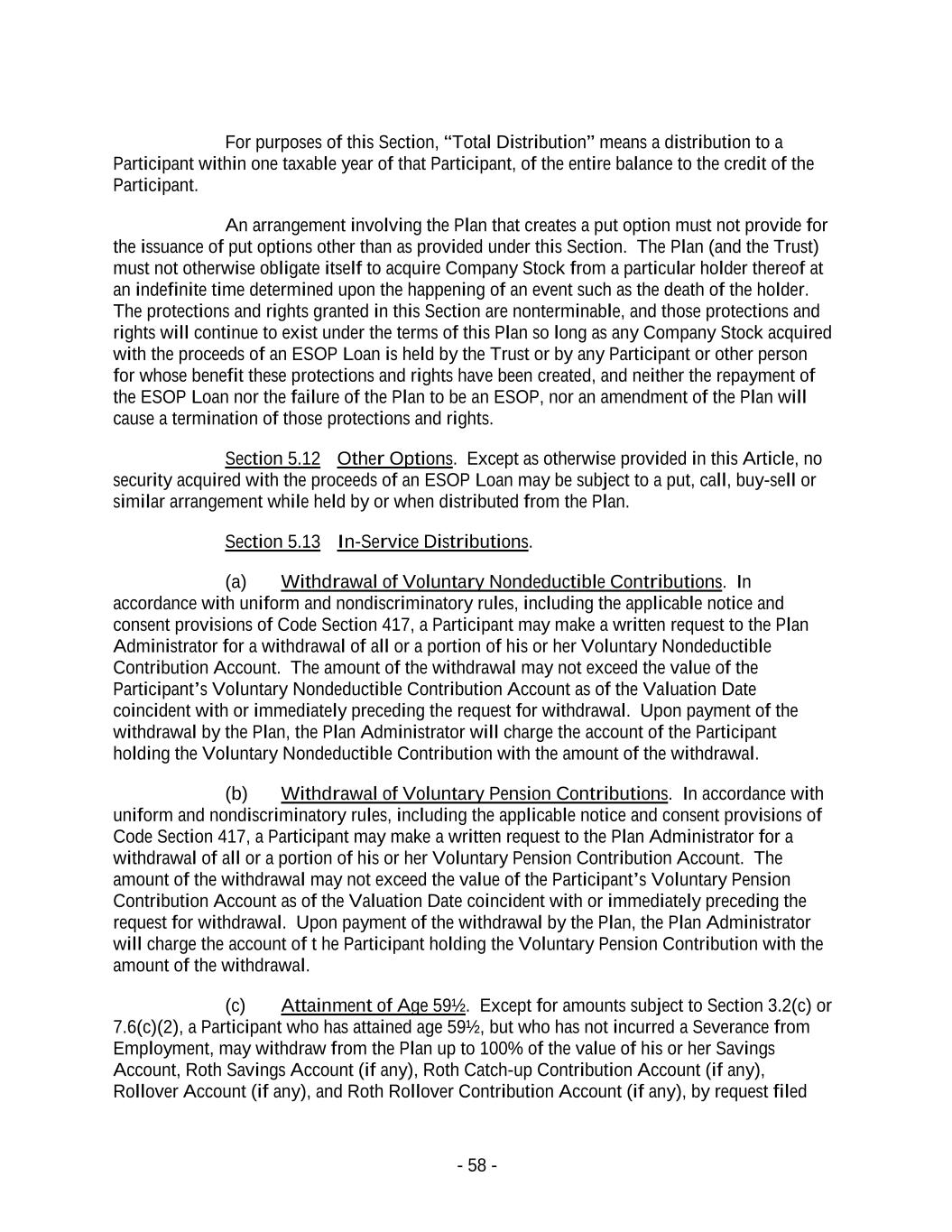
For purposes of this Section, “Total Distribution” means a distribution to a Participant within one taxable year of that Participant, of the entire balance to the credit of the Participant. An arrangement involving the Plan that creates a put option must not provide for the issuance of put options other than as provided under this Section. The Plan (and the Trust) must not otherwise obligate itself to acquire Company Stock from a particular holder thereof at an indefinite time determined upon the happening of an event such as the death of the holder. The protections and rights granted in this Section are nonterminable, and those protections and rights will continue to exist under the terms of this Plan so long as any Company Stock acquired with the proceeds of an ESOP Loan is held by the Trust or by any Participant or other person for whose benefit these protections and rights have been created, and neither the repayment of the ESOP Loan nor the failure of the Plan to be an ESOP, nor an amendment of the Plan will cause a termination of those protections and rights. Section 5.12 Other Options. Except as otherwise provided in this Article, no security acquired with the proceeds of an ESOP Loan may be subject to a put, call, buy-sell or similar arrangement while held by or when distributed from the Plan. Section 5.13 In-Service Distributions. (a) Withdrawal of Voluntary Nondeductible Contributions. In accordance with uniform and nondiscriminatory rules, including the applicable notice and consent provisions of Code Section 417, a Participant may make a written request to the Plan Administrator for a withdrawal of all or a portion of his or her Voluntary Nondeductible Contribution Account. The amount of the withdrawal may not exceed the value of the Participant’s Voluntary Nondeductible Contribution Account as of the Valuation Date coincident with or immediately preceding the request for withdrawal. Upon payment of the withdrawal by the Plan, the Plan Administrator will charge the account of the Participant holding the Voluntary Nondeductible Contribution with the amount of the withdrawal. (b) Withdrawal of Voluntary Pension Contributions. In accordance with uniform and nondiscriminatory rules, including the applicable notice and consent provisions of Code Section 417, a Participant may make a written request to the Plan Administrator for a withdrawal of all or a portion of his or her Voluntary Pension Contribution Account. The amount of the withdrawal may not exceed the value of the Participant’s Voluntary Pension Contribution Account as of the Valuation Date coincident with or immediately preceding the request for withdrawal. Upon payment of the withdrawal by the Plan, the Plan Administrator will charge the account of t he Participant holding the Voluntary Pension Contribution with the amount of the withdrawal. (c) Attainment of Age 59½. Except for amounts subject to Section 3.2(c) or 7.6(c)(2), a Participant who has attained age 59½, but who has not incurred a Severance from Employment, may withdraw from the Plan up to 100% of the value of his or her Savings Account, Roth Savings Account (if any), Roth Catch-up Contribution Account (if any), Rollover Account (if any), and Roth Rollover Contribution Account (if any), by request filed - 58 -
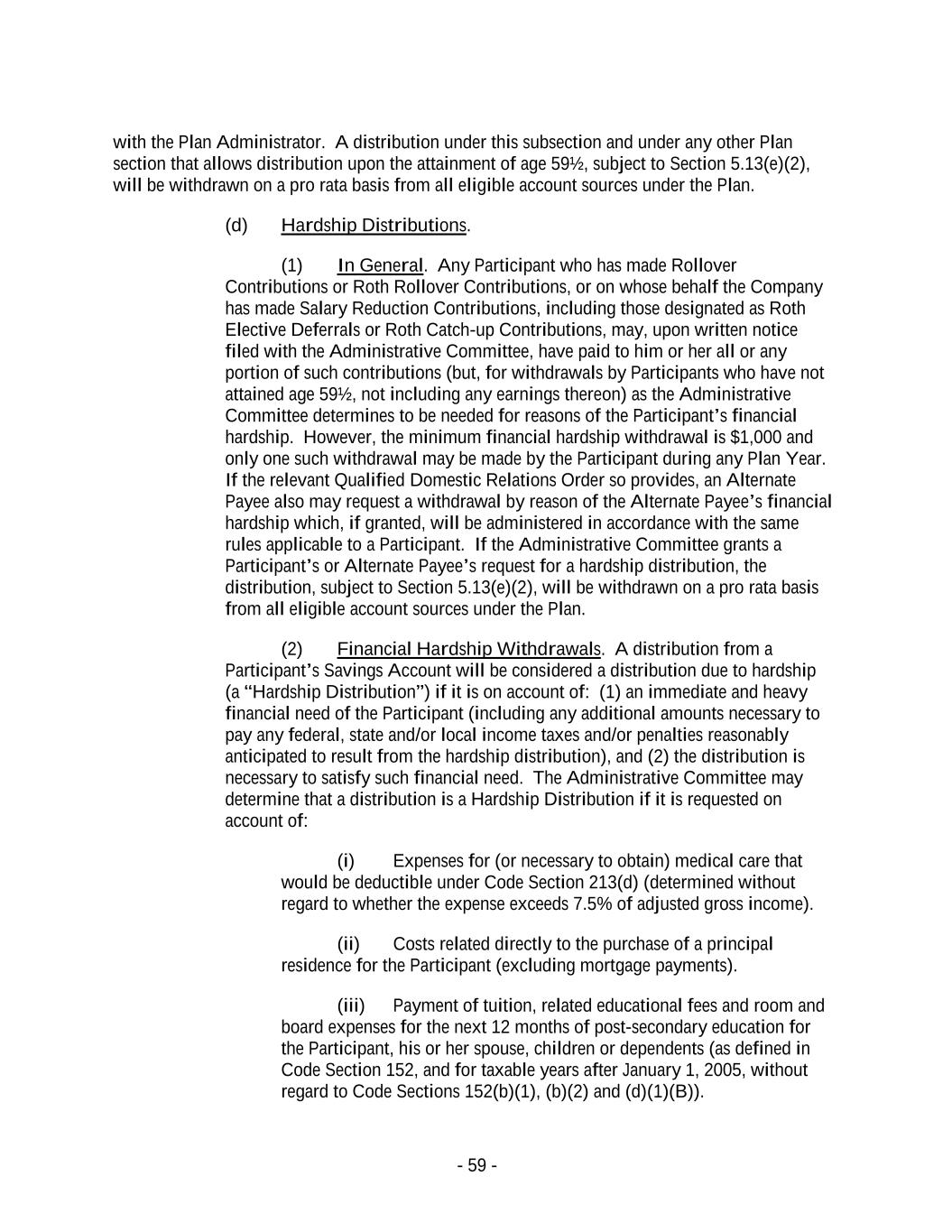
with the Plan Administrator. A distribution under this subsection and under any other Plan section that allows distribution upon the attainment of age 59½, subject to Section 5.13(e)(2), will be withdrawn on a pro rata basis from all eligible account sources under the Plan. (d) Hardship Distributions. (1) In General. Any Participant who has made Rollover Contributions or Roth Rollover Contributions, or on whose behalf the Company has made Salary Reduction Contributions, including those designated as Roth Elective Deferrals or Roth Catch-up Contributions, may, upon written notice filed with the Administrative Committee, have paid to him or her all or any portion of such contributions (but, for withdrawals by Participants who have not attained age 59½, not including any earnings thereon) as the Administrative Committee determines to be needed for reasons of the Participant’s financial hardship. However, the minimum financial hardship withdrawal is $1,000 and only one such withdrawal may be made by the Participant during any Plan Year. If the relevant Qualified Domestic Relations Order so provides, an Alternate Payee also may request a withdrawal by reason of the Alternate Payee’s financial hardship which, if granted, will be administered in accordance with the same rules applicable to a Participant. If the Administrative Committee grants a Participant’s or Alternate Payee’s request for a hardship distribution, the distribution, subject to Section 5.13(e)(2), will be withdrawn on a pro rata basis from all eligible account sources under the Plan. (2) Financial Hardship Withdrawals. A distribution from a Participant’s Savings Account will be considered a distribution due to hardship (a “Hardship Distribution”) if it is on account of: (1) an immediate and heavy financial need of the Participant (including any additional amounts necessary to pay any federal, state and/or local income taxes and/or penalties reasonably anticipated to result from the hardship distribution), and (2) the distribution is necessary to satisfy such financial need. The Administrative Committee may determine that a distribution is a Hardship Distribution if it is requested on account of: (i) Expenses for (or necessary to obtain) medical care that would be deductible under Code Section 213(d) (determined without regard to whether the expense exceeds 7.5% of adjusted gross income). (ii) Costs related directly to the purchase of a principal residence for the Participant (excluding mortgage payments). (iii) Payment of tuition, related educational fees and room and board expenses for the next 12 months of post-secondary education for the Participant, his or her spouse, children or dependents (as defined in Code Section 152, and for taxable years after January 1, 2005, without regard to Code Sections 152(b)(1), (b)(2) and (d)(1)(B)). - 59 -
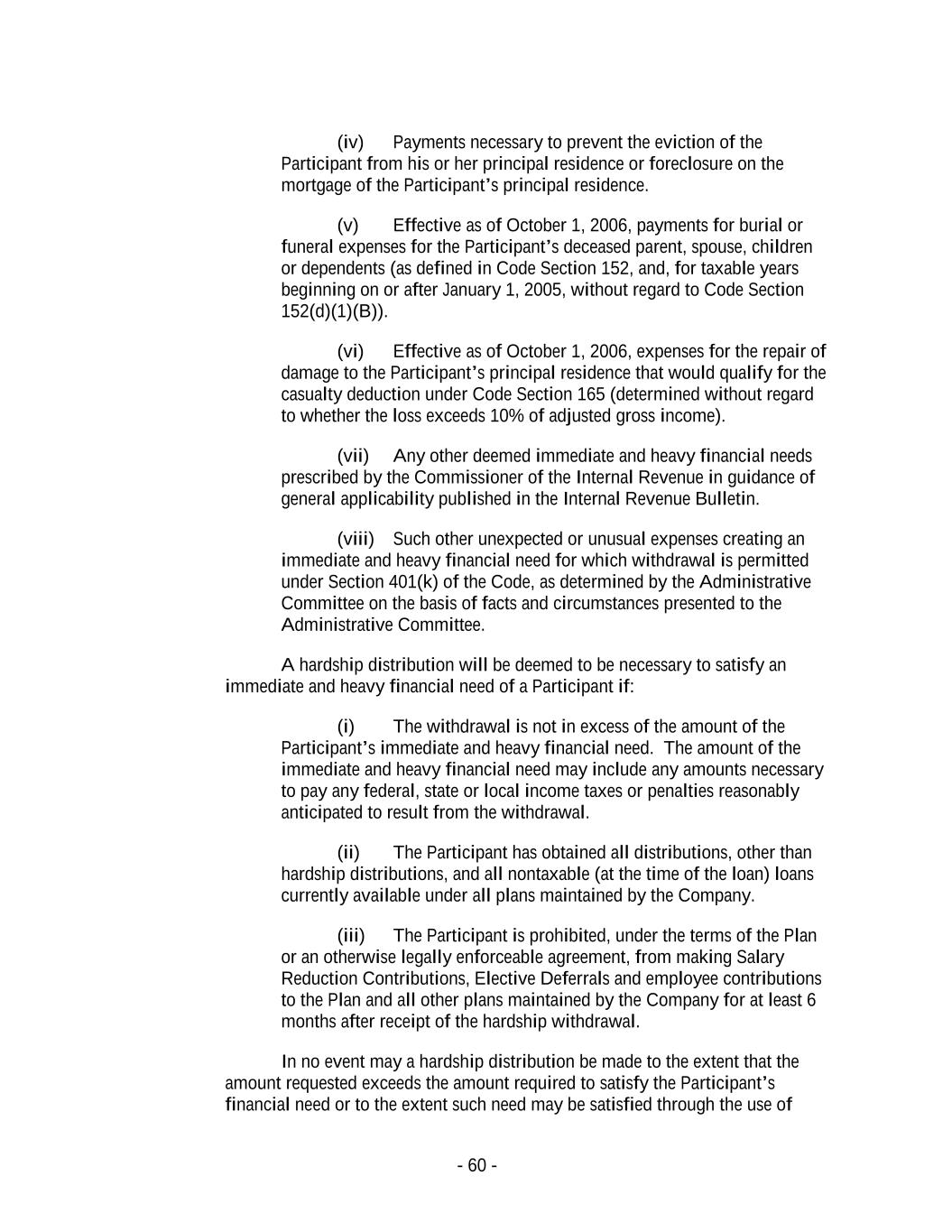
(iv) Payments necessary to prevent the eviction of the Participant from his or her principal residence or foreclosure on the mortgage of the Participant’s principal residence. (v) Effective as of October 1, 2006, payments for burial or funeral expenses for the Participant’s deceased parent, spouse, children or dependents (as defined in Code Section 152, and, for taxable years beginning on or after January 1, 2005, without regard to Code Section 152(d)(1)(B)). (vi) Effective as of October 1, 2006, expenses for the repair of damage to the Participant’s principal residence that would qualify for the casualty deduction under Code Section 165 (determined without regard to whether the loss exceeds 10% of adjusted gross income). (vii) Any other deemed immediate and heavy financial needs prescribed by the Commissioner of the Internal Revenue in guidance of general applicability published in the Internal Revenue Bulletin. (viii) Such other unexpected or unusual expenses creating an immediate and heavy financial need for which withdrawal is permitted under Section 401(k) of the Code, as determined by the Administrative Committee on the basis of facts and circumstances presented to the Administrative Committee. A hardship distribution will be deemed to be necessary to satisfy an immediate and heavy financial need of a Participant if: (i) The withdrawal is not in excess of the amount of the Participant’s immediate and heavy financial need. The amount of the immediate and heavy financial need may include any amounts necessary to pay any federal, state or local income taxes or penalties reasonably anticipated to result from the withdrawal. (ii) The Participant has obtained all distributions, other than hardship distributions, and all nontaxable (at the time of the loan) loans currently available under all plans maintained by the Company. (iii) The Participant is prohibited, under the terms of the Plan or an otherwise legally enforceable agreement, from making Salary Reduction Contributions, Elective Deferrals and employee contributions to the Plan and all other plans maintained by the Company for at least 6 months after receipt of the hardship withdrawal. In no event may a hardship distribution be made to the extent that the amount requested exceeds the amount required to satisfy the Participant’s financial need or to the extent such need may be satisfied through the use of - 60 -
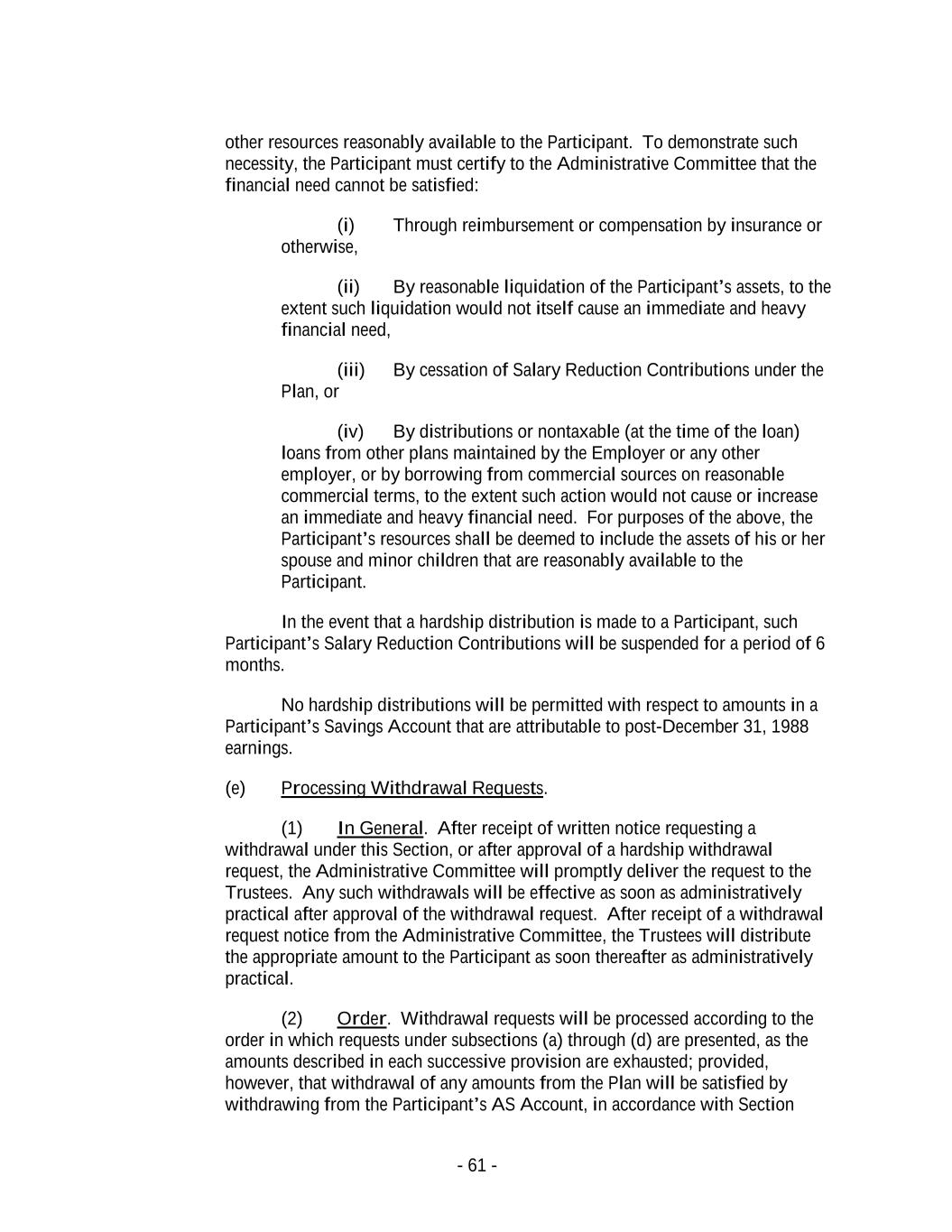
other resources reasonably available to the Participant. To demonstrate such necessity, the Participant must certify to the Administrative Committee that the financial need cannot be satisfied: (i) Through reimbursement or compensation by insurance or otherwise, (ii) By reasonable liquidation of the Participant’s assets, to the extent such liquidation would not itself cause an immediate and heavy financial need, (iii) By cessation of Salary Reduction Contributions under the Plan, or (iv) By distributions or nontaxable (at the time of the loan) loans from other plans maintained by the Employer or any other employer, or by borrowing from commercial sources on reasonable commercial terms, to the extent such action would not cause or increase an immediate and heavy financial need. For purposes of the above, the Participant’s resources shall be deemed to include the assets of his or her spouse and minor children that are reasonably available to the Participant. In the event that a hardship distribution is made to a Participant, such Participant’s Salary Reduction Contributions will be suspended for a period of 6 months. No hardship distributions will be permitted with respect to amounts in a Participant’s Savings Account that are attributable to post-December 31, 1988 earnings. (e) Processing Withdrawal Requests. (1) In General. After receipt of written notice requesting a withdrawal under this Section, or after approval of a hardship withdrawal request, the Administrative Committee will promptly deliver the request to the Trustees. Any such withdrawals will be effective as soon as administratively practical after approval of the withdrawal request. After receipt of a withdrawal request notice from the Administrative Committee, the Trustees will distribute the appropriate amount to the Participant as soon thereafter as administratively practical. (2) Order. Withdrawal requests will be processed according to the order in which requests under subsections (a) through (d) are presented, as the amounts described in each successive provision are exhausted; provided, however, that withdrawal of any amounts from the Plan will be satisfied by withdrawing from the Participant’s AS Account, in accordance with Section - 61 -

14.6, before withdrawing any amounts from his or her other Accounts under the Plan. The Plan Administrator may operationally implement an ordering rule procedure for withdrawals (including, but not limited to, hardship or other in-service withdrawals) from a Participant’s accounts attributable to Salary Reduction Contributions, Roth Elective Deferrals, Rollover Contributions and Roth Rollover Contributions. The ordering rules may specify whether (i) Salary Reduction Contributions that are not Roth Elective Deferrals are distributed first, or (ii) Roth Elective Deferrals are distributed first, or (iii) the withdrawal is taken pro rata from Salary Reduction Contributions that are not Roth Elective Deferrals and Roth Elective Deferrals. Furthermore, the ordering rules may, but are not required to, permit the Participant to elect which type of Salary Reduction Contributions will be distributed first. (3) Transferred Employees. Notwithstanding the foregoing, any withdrawal by a Transferred Employee (as defined in Section 14.1) who had an outstanding participant loan transferred to the Plan from the AS Savings Plan (as defined in Section 14.1) may not be greater than the amount that will cause the combined value of his or her AS Account (as defined in Section 14.1) and his or her other Accounts under the Plan to be twice the outstanding principal balance of the loan and all accrued interest thereon. (f) Roth Rollover Contributions. To the extent a Participant is entitled under the terms of the Plan to request and receive a distribution of all or any portion of his or her vested Accounts under the Plan before he or she has a Severance from Employment (an “In- Service Withdrawal”), the Participant may elect, at the time and in the manner prescribed by the Plan Administrator, to have any portion of that In-Service Withdrawal paid directly to his or her Roth Rollover Account (“Roth Rollover Contribution”) in accordance with the following rules: (1) A Participant generally may elect to make a Roth Rollover Contribution of any portion of an In-Service Withdrawal directly to his or her Roth Rollover Account, provided the Participant is eligible for an In-Service Withdrawal at the time he or she elects to make the Roth Rollover Contribution. However, an amount is not eligible to be designated as a Roth Rollover Contribution unless it satisfies the rules for distribution under the Code and is an eligible rollover distribution as defined in Code Section 402(c)(4). (2) A Plan loan may not be included as part of a Roth Rollover Contribution. (3) Roth Rollover Contributions will be allocated to and held in a Roth Rollover Contribution Account established in the name of the electing Participant. - 62 -
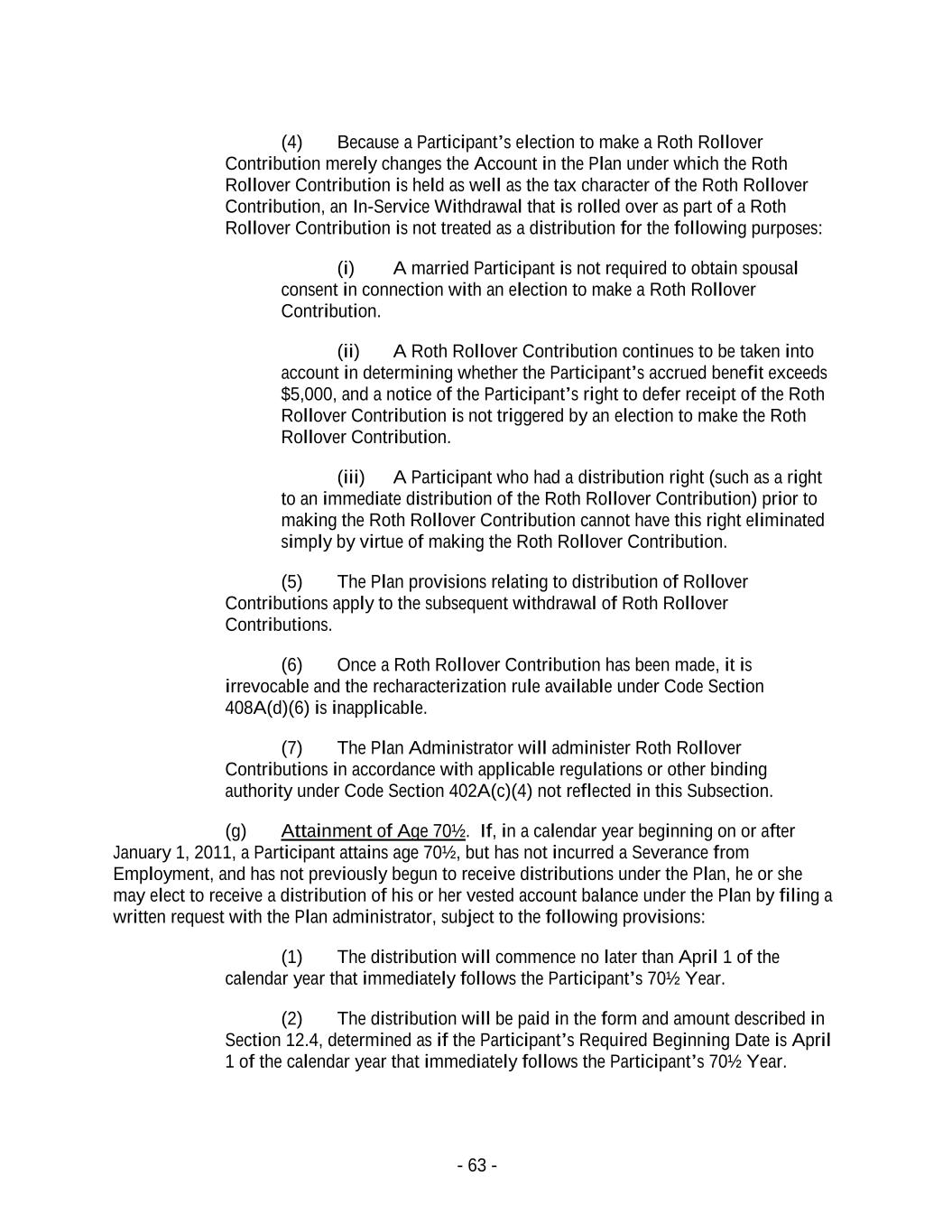
(4) Because a Participant’s election to make a Roth Rollover Contribution merely changes the Account in the Plan under which the Roth Rollover Contribution is held as well as the tax character of the Roth Rollover Contribution, an In-Service Withdrawal that is rolled over as part of a Roth Rollover Contribution is not treated as a distribution for the following purposes: (i) A married Participant is not required to obtain spousal consent in connection with an election to make a Roth Rollover Contribution. (ii) A Roth Rollover Contribution continues to be taken into account in determining whether the Participant’s accrued benefit exceeds $5,000, and a notice of the Participant’s right to defer receipt of the Roth Rollover Contribution is not triggered by an election to make the Roth Rollover Contribution. (iii) A Participant who had a distribution right (such as a right to an immediate distribution of the Roth Rollover Contribution) prior to making the Roth Rollover Contribution cannot have this right eliminated simply by virtue of making the Roth Rollover Contribution. (5) The Plan provisions relating to distribution of Rollover Contributions apply to the subsequent withdrawal of Roth Rollover Contributions. (6) Once a Roth Rollover Contribution has been made, it is irrevocable and the recharacterization rule available under Code Section 408A(d)(6) is inapplicable. (7) The Plan Administrator will administer Roth Rollover Contributions in accordance with applicable regulations or other binding authority under Code Section 402A(c)(4) not reflected in this Subsection. (g) Attainment of Age 70½. If, in a calendar year beginning on or after January 1, 2011, a Participant attains age 70½, but has not incurred a Severance from Employment, and has not previously begun to receive distributions under the Plan, he or she may elect to receive a distribution of his or her vested account balance under the Plan by filing a written request with the Plan administrator, subject to the following provisions: (1) The distribution will commence no later than April 1 of the calendar year that immediately follows the Participant’s 70½ Year. (2) The distribution will be paid in the form and amount described in Section 12.4, determined as if the Participant’s Required Beginning Date is April 1 of the calendar year that immediately follows the Participant’s 70½ Year. - 63 -
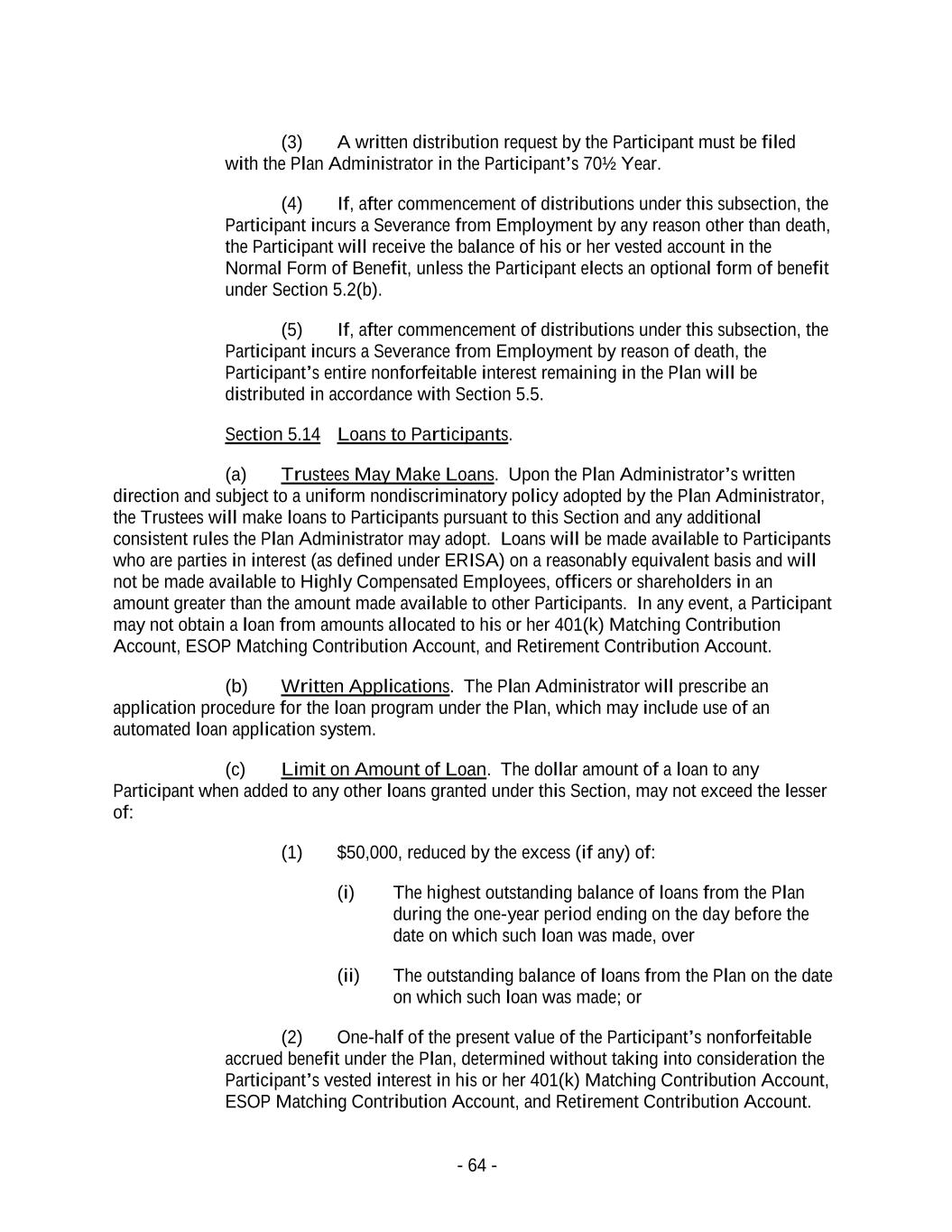
(3) A written distribution request by the Participant must be filed with the Plan Administrator in the Participant’s 70½ Year. (4) If, after commencement of distributions under this subsection, the Participant incurs a Severance from Employment by any reason other than death, the Participant will receive the balance of his or her vested account in the Normal Form of Benefit, unless the Participant elects an optional form of benefit under Section 5.2(b). (5) If, after commencement of distributions under this subsection, the Participant incurs a Severance from Employment by reason of death, the Participant’s entire nonforfeitable interest remaining in the Plan will be distributed in accordance with Section 5.5. Section 5.14 Loans to Participants. (a) Trustees May Make Loans. Upon the Plan Administrator’s written direction and subject to a uniform nondiscriminatory policy adopted by the Plan Administrator, the Trustees will make loans to Participants pursuant to this Section and any additional consistent rules the Plan Administrator may adopt. Loans will be made available to Participants who are parties in interest (as defined under ERISA) on a reasonably equivalent basis and will not be made available to Highly Compensated Employees, officers or shareholders in an amount greater than the amount made available to other Participants. In any event, a Participant may not obtain a loan from amounts allocated to his or her 401(k) Matching Contribution Account, ESOP Matching Contribution Account, and Retirement Contribution Account. (b) Written Applications. The Plan Administrator will prescribe an application procedure for the loan program under the Plan, which may include use of an automated loan application system. (c) Limit on Amount of Loan. The dollar amount of a loan to any Participant when added to any other loans granted under this Section, may not exceed the lesser of: (1) $50,000, reduced by the excess (if any) of: (i) The highest outstanding balance of loans from the Plan during the one-year period ending on the day before the date on which such loan was made, over (ii) The outstanding balance of loans from the Plan on the date on which such loan was made; or (2) One-half of the present value of the Participant’s nonforfeitable accrued benefit under the Plan, determined without taking into consideration the Participant’s vested interest in his or her 401(k) Matching Contribution Account, ESOP Matching Contribution Account, and Retirement Contribution Account. - 64 -
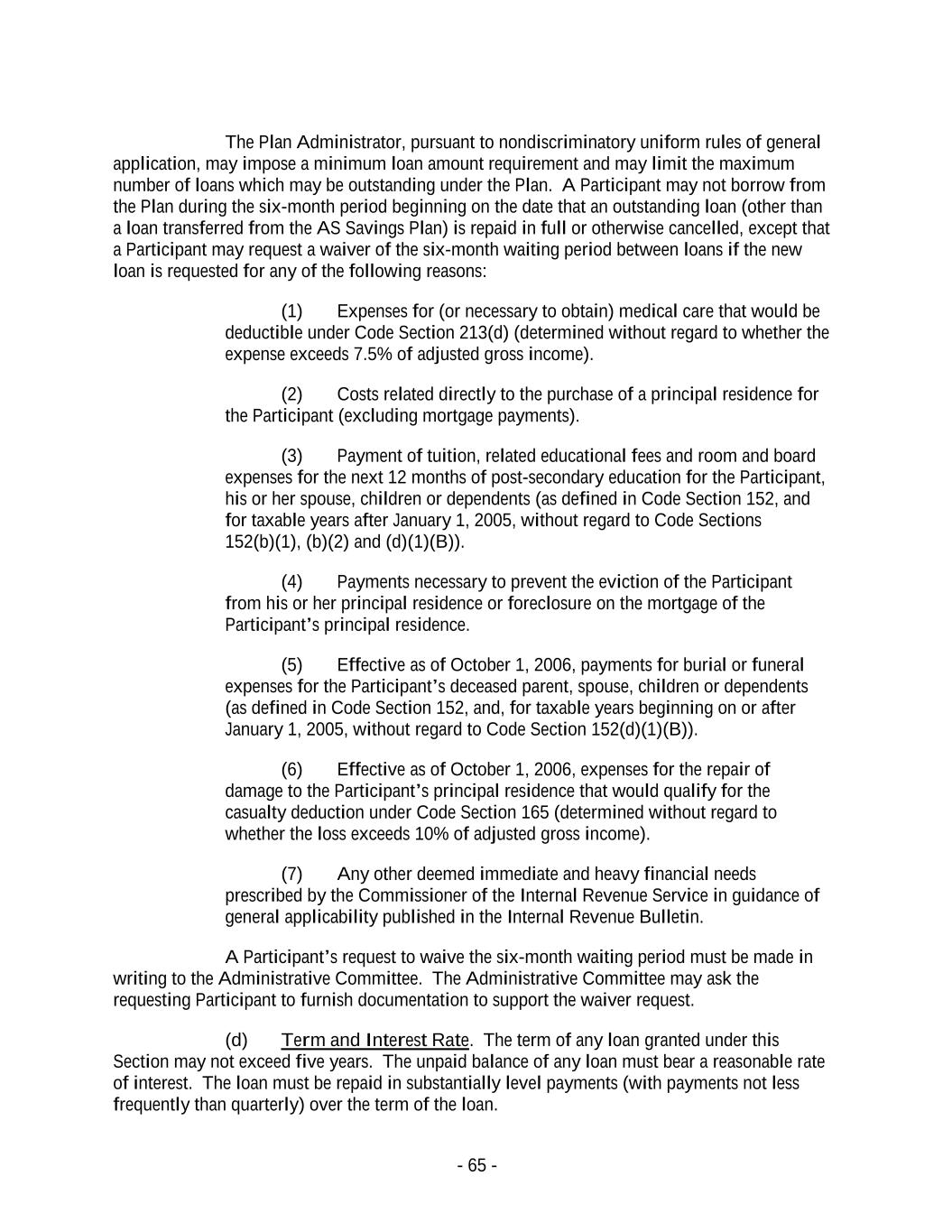
The Plan Administrator, pursuant to nondiscriminatory uniform rules of general application, may impose a minimum loan amount requirement and may limit the maximum number of loans which may be outstanding under the Plan. A Participant may not borrow from the Plan during the six-month period beginning on the date that an outstanding loan (other than a loan transferred from the AS Savings Plan) is repaid in full or otherwise cancelled, except that a Participant may request a waiver of the six-month waiting period between loans if the new loan is requested for any of the following reasons: (1) Expenses for (or necessary to obtain) medical care that would be deductible under Code Section 213(d) (determined without regard to whether the expense exceeds 7.5% of adjusted gross income). (2) Costs related directly to the purchase of a principal residence for the Participant (excluding mortgage payments). (3) Payment of tuition, related educational fees and room and board expenses for the next 12 months of post-secondary education for the Participant, his or her spouse, children or dependents (as defined in Code Section 152, and for taxable years after January 1, 2005, without regard to Code Sections 152(b)(1), (b)(2) and (d)(1)(B)). (4) Payments necessary to prevent the eviction of the Participant from his or her principal residence or foreclosure on the mortgage of the Participant’s principal residence. (5) Effective as of October 1, 2006, payments for burial or funeral expenses for the Participant’s deceased parent, spouse, children or dependents (as defined in Code Section 152, and, for taxable years beginning on or after January 1, 2005, without regard to Code Section 152(d)(1)(B)). (6) Effective as of October 1, 2006, expenses for the repair of damage to the Participant’s principal residence that would qualify for the casualty deduction under Code Section 165 (determined without regard to whether the loss exceeds 10% of adjusted gross income). (7) Any other deemed immediate and heavy financial needs prescribed by the Commissioner of the Internal Revenue Service in guidance of general applicability published in the Internal Revenue Bulletin. A Participant’s request to waive the six-month waiting period must be made in writing to the Administrative Committee. The Administrative Committee may ask the requesting Participant to furnish documentation to support the waiver request. (d) Term and Interest Rate. The term of any loan granted under this Section may not exceed five years. The unpaid balance of any loan must bear a reasonable rate of interest. The loan must be repaid in substantially level payments (with payments not less frequently than quarterly) over the term of the loan. - 65 -
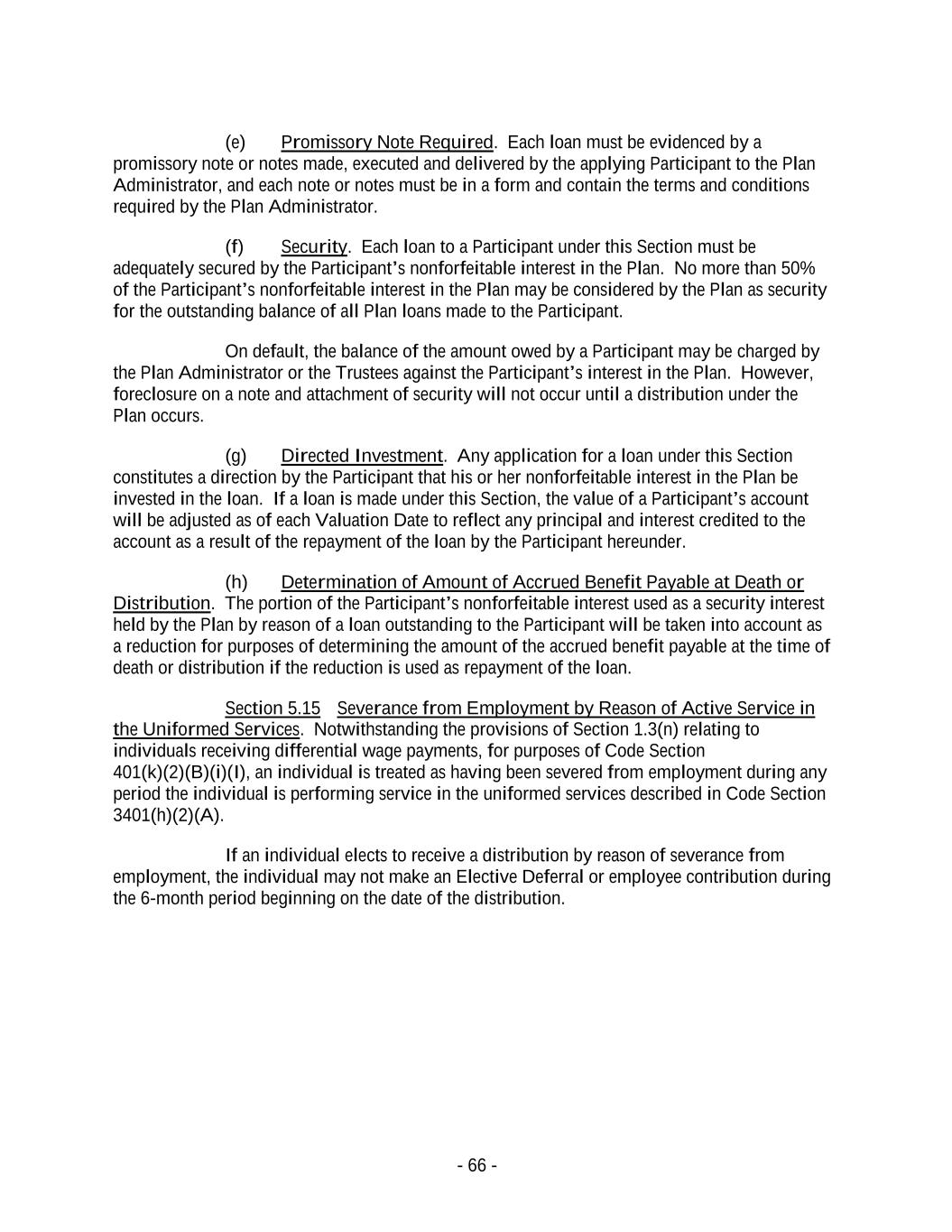
(e) Promissory Note Required. Each loan must be evidenced by a promissory note or notes made, executed and delivered by the applying Participant to the Plan Administrator, and each note or notes must be in a form and contain the terms and conditions required by the Plan Administrator. (f) Security. Each loan to a Participant under this Section must be adequately secured by the Participant’s nonforfeitable interest in the Plan. No more than 50% of the Participant’s nonforfeitable interest in the Plan may be considered by the Plan as security for the outstanding balance of all Plan loans made to the Participant. On default, the balance of the amount owed by a Participant may be charged by the Plan Administrator or the Trustees against the Participant’s interest in the Plan. However, foreclosure on a note and attachment of security will not occur until a distribution under the Plan occurs. (g) Directed Investment. Any application for a loan under this Section constitutes a direction by the Participant that his or her nonforfeitable interest in the Plan be invested in the loan. If a loan is made under this Section, the value of a Participant’s account will be adjusted as of each Valuation Date to reflect any principal and interest credited to the account as a result of the repayment of the loan by the Participant hereunder. (h) Determination of Amount of Accrued Benefit Payable at Death or Distribution. The portion of the Participant’s nonforfeitable interest used as a security interest held by the Plan by reason of a loan outstanding to the Participant will be taken into account as a reduction for purposes of determining the amount of the accrued benefit payable at the time of death or distribution if the reduction is used as repayment of the loan. Section 5.15 Severance from Employment by Reason of Active Service in the Uniformed Services. Notwithstanding the provisions of Section 1.3(n) relating to individuals receiving differential wage payments, for purposes of Code Section 401(k)(2)(B)(i)(I), an individual is treated as having been severed from employment during any period the individual is performing service in the uniformed services described in Code Section 3401(h)(2)(A). If an individual elects to receive a distribution by reason of severance from employment, the individual may not make an Elective Deferral or employee contribution during the 6-month period beginning on the date of the distribution. - 66 -
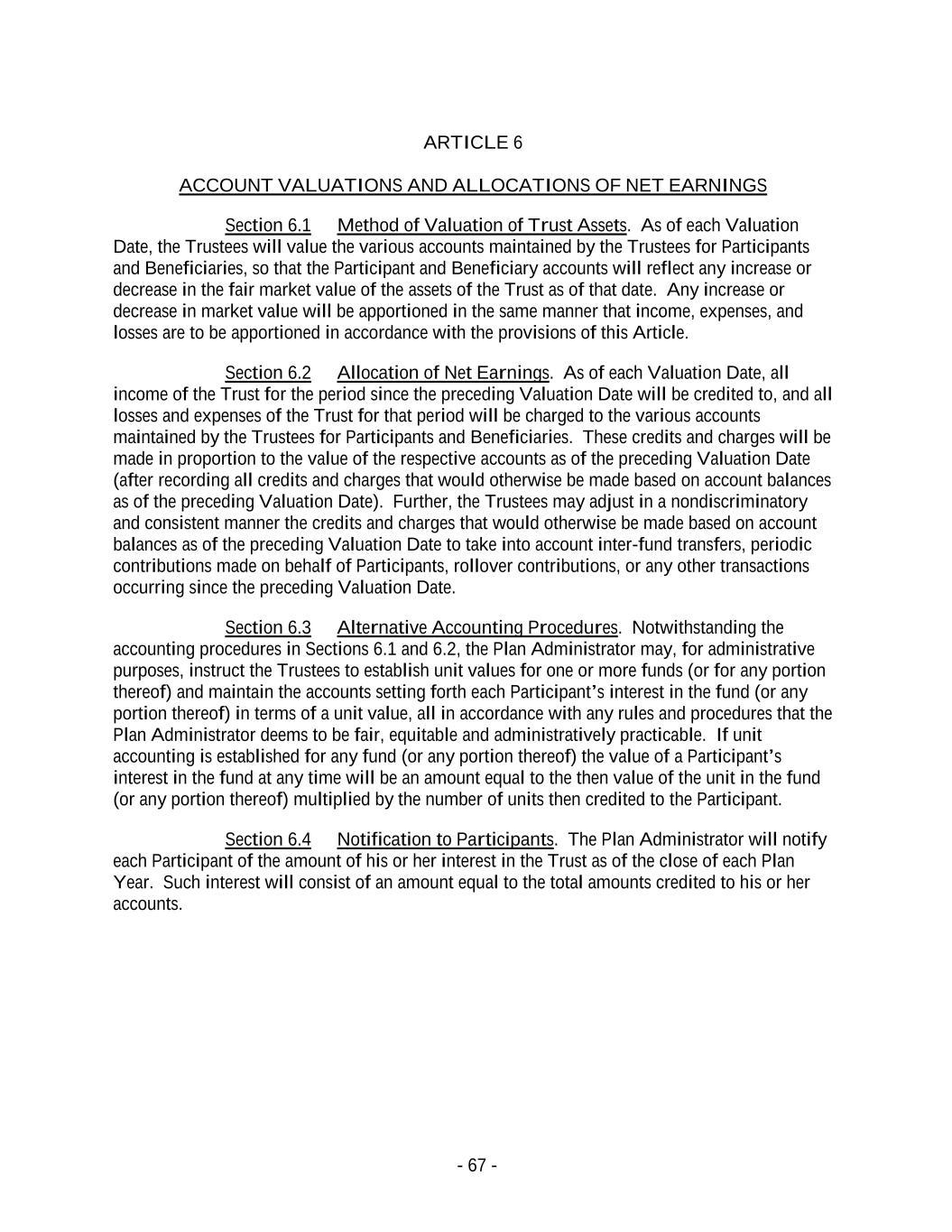
ARTICLE 6 ACCOUNT VALUATIONS AND ALLOCATIONS OF NET EARNINGS Section 6.1 Method of Valuation of Trust Assets. As of each Valuation Date, the Trustees will value the various accounts maintained by the Trustees for Participants and Beneficiaries, so that the Participant and Beneficiary accounts will reflect any increase or decrease in the fair market value of the assets of the Trust as of that date. Any increase or decrease in market value will be apportioned in the same manner that income, expenses, and losses are to be apportioned in accordance with the provisions of this Article. Section 6.2 Allocation of Net Earnings. As of each Valuation Date, all income of the Trust for the period since the preceding Valuation Date will be credited to, and all losses and expenses of the Trust for that period will be charged to the various accounts maintained by the Trustees for Participants and Beneficiaries. These credits and charges will be made in proportion to the value of the respective accounts as of the preceding Valuation Date (after recording all credits and charges that would otherwise be made based on account balances as of the preceding Valuation Date). Further, the Trustees may adjust in a nondiscriminatory and consistent manner the credits and charges that would otherwise be made based on account balances as of the preceding Valuation Date to take into account inter-fund transfers, periodic contributions made on behalf of Participants, rollover contributions, or any other transactions occurring since the preceding Valuation Date. Section 6.3 Alternative Accounting Procedures. Notwithstanding the accounting procedures in Sections 6.1 and 6.2, the Plan Administrator may, for administrative purposes, instruct the Trustees to establish unit values for one or more funds (or for any portion thereof) and maintain the accounts setting forth each Participant’s interest in the fund (or any portion thereof) in terms of a unit value, all in accordance with any rules and procedures that the Plan Administrator deems to be fair, equitable and administratively practicable. If unit accounting is established for any fund (or any portion thereof) the value of a Participant’s interest in the fund at any time will be an amount equal to the then value of the unit in the fund (or any portion thereof) multiplied by the number of units then credited to the Participant. Section 6.4 Notification to Participants. The Plan Administrator will notify each Participant of the amount of his or her interest in the Trust as of the close of each Plan Year. Such interest will consist of an amount equal to the total amounts credited to his or her accounts. - 67 -
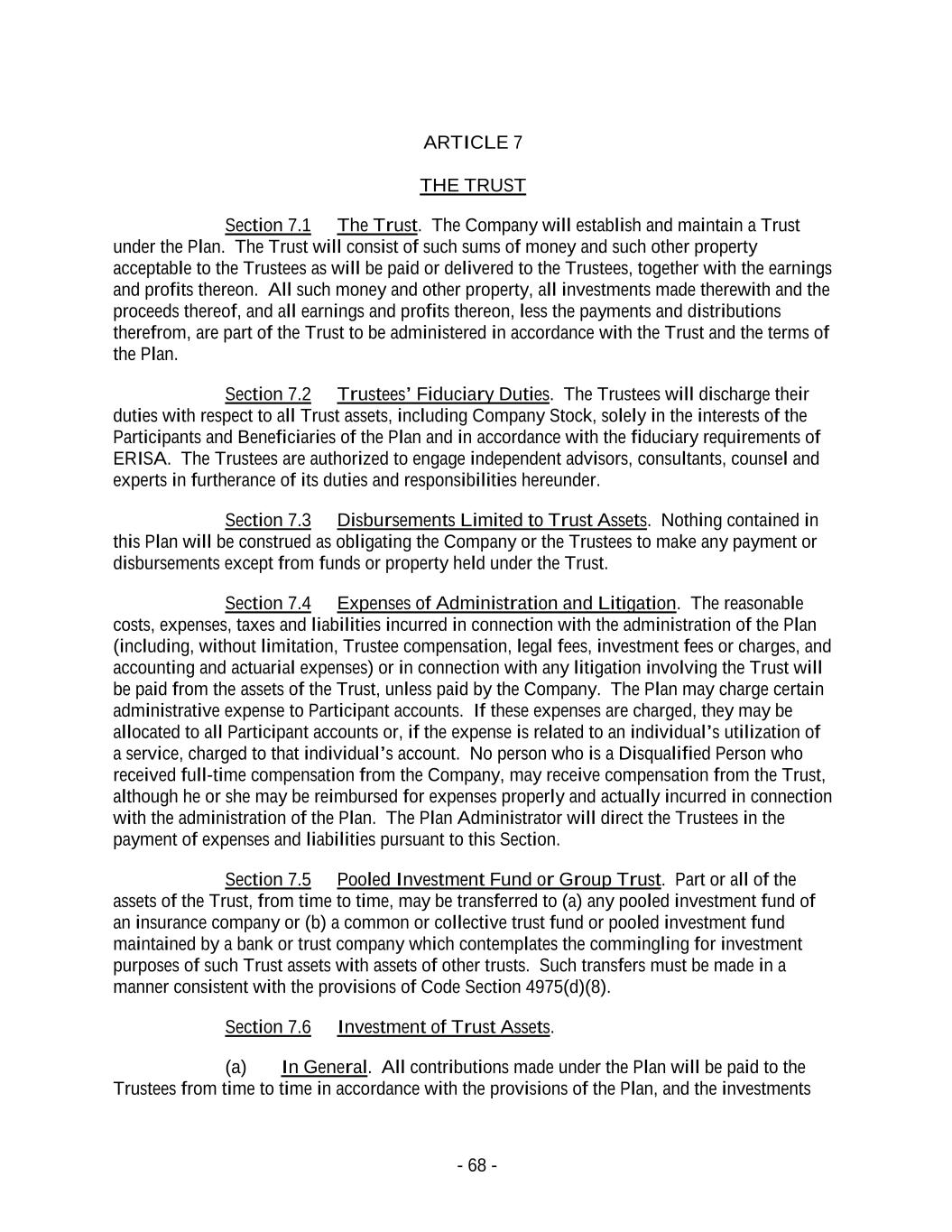
ARTICLE 7 THE TRUST Section 7.1 The Trust. The Company will establish and maintain a Trust under the Plan. The Trust will consist of such sums of money and such other property acceptable to the Trustees as will be paid or delivered to the Trustees, together with the earnings and profits thereon. All such money and other property, all investments made therewith and the proceeds thereof, and all earnings and profits thereon, less the payments and distributions therefrom, are part of the Trust to be administered in accordance with the Trust and the terms of the Plan. Section 7.2 Trustees’ Fiduciary Duties. The Trustees will discharge their duties with respect to all Trust assets, including Company Stock, solely in the interests of the Participants and Beneficiaries of the Plan and in accordance with the fiduciary requirements of ERISA. The Trustees are authorized to engage independent advisors, consultants, counsel and experts in furtherance of its duties and responsibilities hereunder. Section 7.3 Disbursements Limited to Trust Assets. Nothing contained in this Plan will be construed as obligating the Company or the Trustees to make any payment or disbursements except from funds or property held under the Trust. Section 7.4 Expenses of Administration and Litigation. The reasonable costs, expenses, taxes and liabilities incurred in connection with the administration of the Plan (including, without limitation, Trustee compensation, legal fees, investment fees or charges, and accounting and actuarial expenses) or in connection with any litigation involving the Trust will be paid from the assets of the Trust, unless paid by the Company. The Plan may charge certain administrative expense to Participant accounts. If these expenses are charged, they may be allocated to all Participant accounts or, if the expense is related to an individual’s utilization of a service, charged to that individual’s account. No person who is a Disqualified Person who received full-time compensation from the Company, may receive compensation from the Trust, although he or she may be reimbursed for expenses properly and actually incurred in connection with the administration of the Plan. The Plan Administrator will direct the Trustees in the payment of expenses and liabilities pursuant to this Section. Section 7.5 Pooled Investment Fund or Group Trust. Part or all of the assets of the Trust, from time to time, may be transferred to (a) any pooled investment fund of an insurance company or (b) a common or collective trust fund or pooled investment fund maintained by a bank or trust company which contemplates the commingling for investment purposes of such Trust assets with assets of other trusts. Such transfers must be made in a manner consistent with the provisions of Code Section 4975(d)(8). Section 7.6 Investment of Trust Assets. (a) In General. All contributions made under the Plan will be paid to the Trustees from time to time in accordance with the provisions of the Plan, and the investments - 68 -
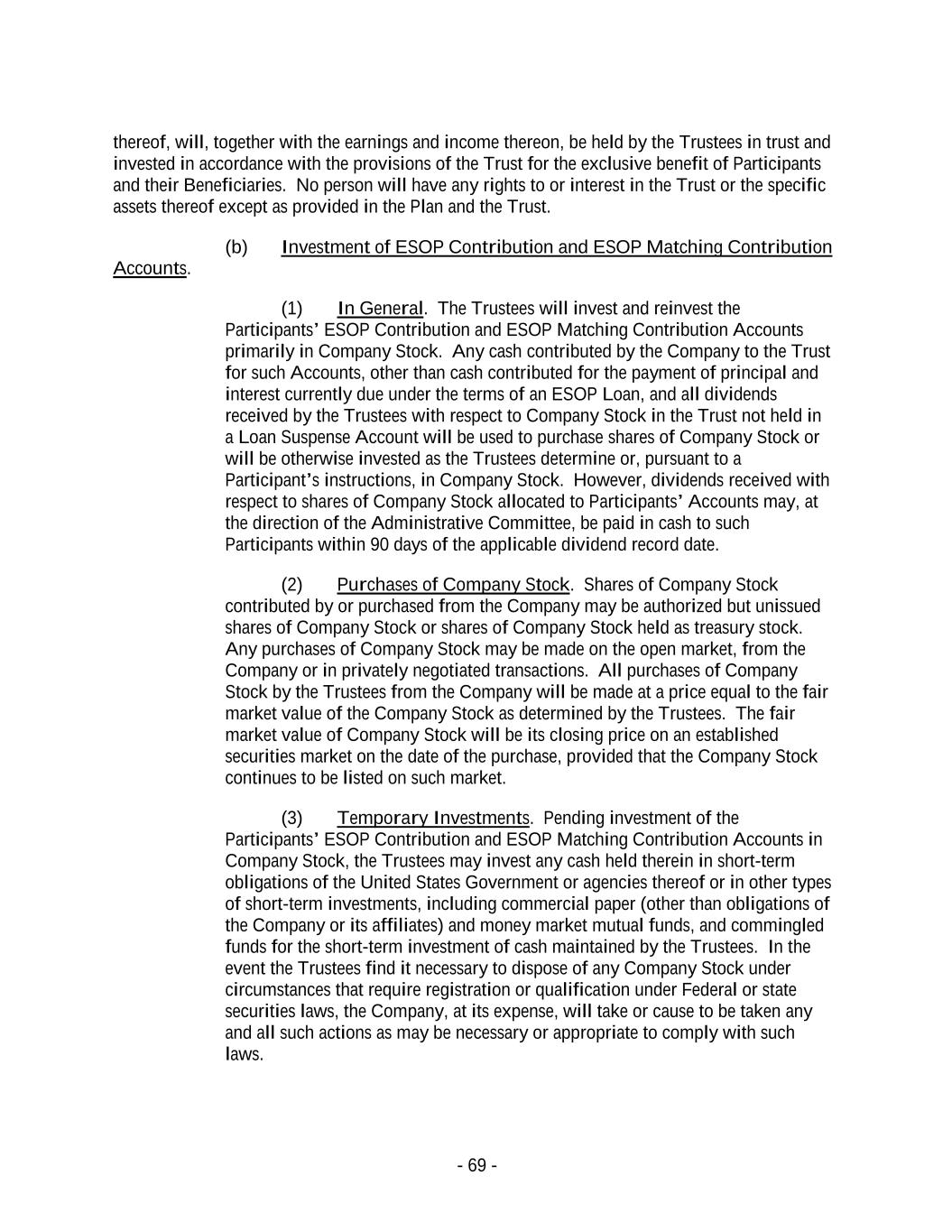
thereof, will, together with the earnings and income thereon, be held by the Trustees in trust and invested in accordance with the provisions of the Trust for the exclusive benefit of Participants and their Beneficiaries. No person will have any rights to or interest in the Trust or the specific assets thereof except as provided in the Plan and the Trust. (b) Investment of ESOP Contribution and ESOP Matching Contribution Accounts. (1) In General. The Trustees will invest and reinvest the Participants’ ESOP Contribution and ESOP Matching Contribution Accounts primarily in Company Stock. Any cash contributed by the Company to the Trust for such Accounts, other than cash contributed for the payment of principal and interest currently due under the terms of an ESOP Loan, and all dividends received by the Trustees with respect to Company Stock in the Trust not held in a Loan Suspense Account will be used to purchase shares of Company Stock or will be otherwise invested as the Trustees determine or, pursuant to a Participant’s instructions, in Company Stock. However, dividends received with respect to shares of Company Stock allocated to Participants’ Accounts may, at the direction of the Administrative Committee, be paid in cash to such Participants within 90 days of the applicable dividend record date. (2) Purchases of Company Stock. Shares of Company Stock contributed by or purchased from the Company may be authorized but unissued shares of Company Stock or shares of Company Stock held as treasury stock. Any purchases of Company Stock may be made on the open market, from the Company or in privately negotiated transactions. All purchases of Company Stock by the Trustees from the Company will be made at a price equal to the fair market value of the Company Stock as determined by the Trustees. The fair market value of Company Stock will be its closing price on an established securities market on the date of the purchase, provided that the Company Stock continues to be listed on such market. (3) Temporary Investments. Pending investment of the Participants’ ESOP Contribution and ESOP Matching Contribution Accounts in Company Stock, the Trustees may invest any cash held therein in short-term obligations of the United States Government or agencies thereof or in other types of short-term investments, including commercial paper (other than obligations of the Company or its affiliates) and money market mutual funds, and commingled funds for the short-term investment of cash maintained by the Trustees. In the event the Trustees find it necessary to dispose of any Company Stock under circumstances that require registration or qualification under Federal or state securities laws, the Company, at its expense, will take or cause to be taken any and all such actions as may be necessary or appropriate to comply with such laws. - 69 -

(c) Investment of Other Contributions. (1) In General. All contributions made under the Plan, except for those specified in subsection (b), will be paid over to the Trustees and, pursuant to each Participant’s instructions, will be invested and reinvested by the Trustees or by an Investment Manager appointed by the Administrative Committee in one or more investment funds established from time to time by the Administrative Committee. Requirements for the timing and frequency of and any limitations regarding investment election changes will be established from time to time by the Administrative Committee. Any rules and regulations established by the Administrative Committee will be communicated to Participants and designed with the intention of permitting Participants to exercise control over the assets in their respective accounts within the meaning of ERISA Section 404(c) and the guidelines promulgated thereunder. (2) Investment in Company Stock. For the purpose of investing contributions pursuant to this subsection (c), the Trustees will establish one or more investment funds to be invested primarily in Company Stock (collectively, the “Company Stock Investment Funds”). The Company Stock Investment Funds will be used for purposes of the Participant investment elections relating to Salary Reduction (including Roth Elective Deferrals), Catch-up (including Roth Catch-up Contributions), 401(k) Matching, Retirement, Rollover, Voluntary Nondeductible and Voluntary Pension Contributions. Effective June 1, 2015, the fair market value of a Participant’s investment in each of the Company Stock Investment Funds may not exceed 25% of the value of the Participant’s Plan accounts, subject to the following additional rules: (i) Participants whose investments in a Company Stock Investment Fund exceeded the 25% limit on June 1, 2015 will not be required to reduce their investments in that Company Stock Investment Fund to satisfy the 25% limit. (ii) The 25% limit will not restrict the ability of Participants to direct the investment of any portion of new contributions of any kind into any of the Company Stock Funds available for the investment of new contributions. For purposes of obtaining the Company Stock to be used in such Company Stock Investment Fund, purchases of Company Stock may be made on the open market, from the Company, or in privately negotiated transactions (as provided in Section 7.6(b)(2)). (d) Cessation of Investments in Moog Class A Stock. Notwithstanding any other Plan provision, effective September 1, 2016 or as close to that date as may be practicable, Plan assets may no longer be invested in Class A shares of the Corporation (other - 70 -

than by reason of the exercise of conversion rights with respect to Class B shares of the Corporation to facilitate a sale of those Class B shares), and any Plan investments in Class A shares of the Corporation will be liquidated. Subject to the right of Participants to direct the investment of their Plan accounts, proceeds from the liquidation of the Class A shares will be reinvested in other available classes of Company Stock, in accordance with procedures established by the Administrative Committee. Section 7.7 ESOP Loans. From time to time, the Investment Committee may direct the Trustees to incur one or more loans or other extensions of credit to finance the acquisition of shares of Employer Securities (“ESOP Loan”). All shares of Company Stock purchased by the Trust with the proceeds of any ESOP Loan will, for Plan purposes, be held in a separate Loan Suspense Account in respect of that ESOP Loan until paid for and allocated. Each ESOP Loan must be for a specified term not exceeding 15 years in duration and must bear a reasonable rate of interest. Each ESOP Loan must be secured by a collateral pledge of the shares so acquired. The ESOP Loan must be primarily for the benefit of the Participants and their beneficiaries. No other assets of the Trust may be pledged as collateral for an ESOP Loan, and no lender will have recourse against any asset of the Trust except for the shares remaining subject to the pledge. Notwithstanding the foregoing, shares of Company Stock allocated to Participants’ Accounts pursuant to the Plan will no longer be subject to recourse by the lender under the terms of any ESOP Loan. The pledge will provide for the release of shares so pledged pursuant to either the “General Rule” or the “Special Rule” set forth in Section 3.8(e), and those shares are allocated to Participants’ ESOP Contribution Accounts pursuant to Section 3.8. Shares of Company Stock released from the Loan Suspense Account will be allocated to Participants’ accounts in shares of stock or other nonmonetary units. The Trustees, as directed by the Investment Committee, will repay principal and interest on ESOP Loans only from ESOP Contributions and ESOP Matching Contributions made pursuant to Article 3 to enable the Trustees to repay the ESOP Loans, from earnings attributable to those ESOP Contributions and ESOP Matching Contributions, and from any cash dividends received by the Trust on the shares so acquired. Those contributions, dividends and earnings will be accounted for separately in the books of accounts of the Plan until the ESOP Loan is repaid. The proceeds of an ESOP Loan may be used only to acquire Employer Securities, to repay such loan, or to repay a prior ESOP Loan. Purchases may be made on the open market, from the Company or in privately negotiated transactions. Shares of Company Stock purchased from the Company with the proceeds of any ESOP Loan may be authorized but unissued shares of Company Stock or shares of Company Stock held as treasury stock. Any purchases of Company Stock may be made on the open market, from the Company or in privately negotiated transactions. All purchases of Company Stock by the Trustees from the Company will be made at a price equal to the fair market value of the Company Stock as determined by the Trustees. The fair market value of Company Stock will be its closing price on an established securities market on the date of the purchase, provided that the Company Stock continues to be listed on such market. If the Trustees purchase shares of Company Stock - 71 -

from the Company (or from any Disqualified Person), no commissions will be paid with respect to that purchase. In the event of default of an ESOP Loan, the value of Plan assets transferred in satisfaction of the ESOP Loan must not exceed the amount of default. If the lender is a Disqualified Person, an ESOP Loan must provide for a transfer of Plan assets on default only upon and to the extent of the failure of the Plan to meet the payment schedule of the ESOP Loan. For purposes of this paragraph, the making of a guarantee does not make a person a lender. Notwithstanding any provision of the Plan to the contrary, the payments made with respect to an ESOP Loan during a Plan Year may not exceed an amount equal to the sum of the contributions and earnings received during or prior to the Plan Year, less any such payments in prior Plan Years. Section 7.8 Diversification of Investments. Each Diversification Qualified Participant, upon written notice to the Plan Administrator received no later than the 90th day after the last day of a Plan Year within such Participant’s Diversification Election Period, may elect to direct the Plan Administrator and the Trustees to diversify a portion of his or her ESOP Contribution and/or ESOP Matching Contribution Accounts if the Participant’s ESOP Contribution and/or ESOP Matching Contribution Accounts exceed $500 (a “Diversification Election”). (a) Diversification Qualified Participant means an Employee who has completed at least 10 years of participation under the Plan and has attained age 55, counting only years of participation since October 1, 1987 by the close of the preceding Plan Year. (b) Diversification Election Period means the six Plan Year period beginning with the first Plan Year in which the Participant first became a Diversification Qualified Participant. (c) Diversification Amount. The portion of a Participant’s ESOP Contribution and/or ESOP Matching Contribution Accounts subject to diversification may be no greater than (i) the number of shares of the ESOP Contribution and/or ESOP Matching Contribution Accounts representing Company Stock acquired by the Plan after December 31, 1986; plus (ii) the amount, if any, previously elected to be diversified; times (iii) 25% or, in the case of the last year of the Diversification Election Period, 50%; less (iv) the number of shares previously elected to be diversified. (d) Effect of Diversification Election. If a Diversification Qualified Participant elects to diversify pursuant to this Section, the Administrative Committee, within 90 days after the close of the 90-day election period, will direct the Trustees to make available to Diversification Qualified Participants alternative investment options with respect to the investment of their ESOP Contribution and/or ESOP Matching Contribution Accounts consistent with United States Treasury Department Regulations. Those investment options may include one or more of the investment funds established pursuant to Section 7.6(c). - 72 -
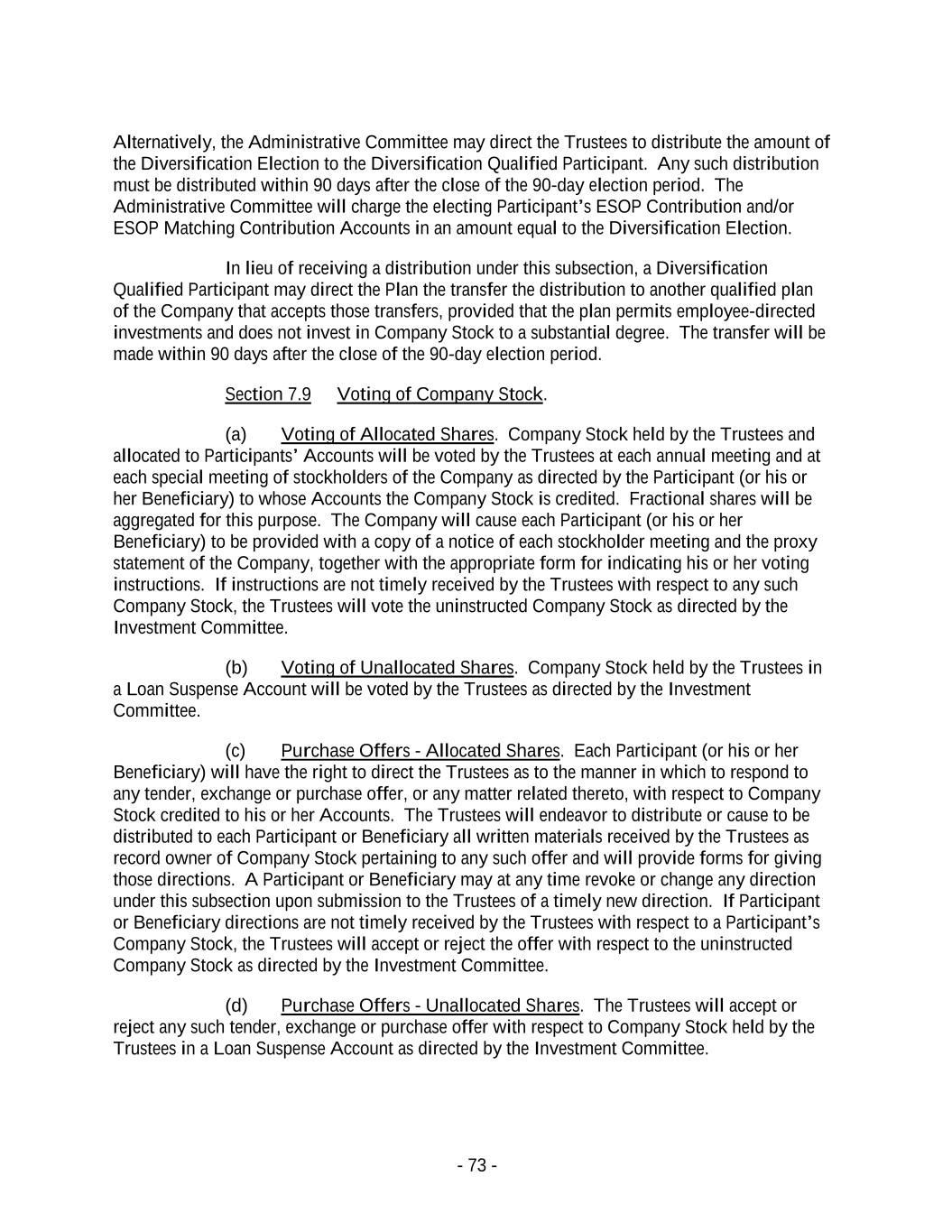
Alternatively, the Administrative Committee may direct the Trustees to distribute the amount of the Diversification Election to the Diversification Qualified Participant. Any such distribution must be distributed within 90 days after the close of the 90-day election period. The Administrative Committee will charge the electing Participant’s ESOP Contribution and/or ESOP Matching Contribution Accounts in an amount equal to the Diversification Election. In lieu of receiving a distribution under this subsection, a Diversification Qualified Participant may direct the Plan the transfer the distribution to another qualified plan of the Company that accepts those transfers, provided that the plan permits employee-directed investments and does not invest in Company Stock to a substantial degree. The transfer will be made within 90 days after the close of the 90-day election period. Section 7.9 Voting of Company Stock. (a) Voting of Allocated Shares. Company Stock held by the Trustees and allocated to Participants’ Accounts will be voted by the Trustees at each annual meeting and at each special meeting of stockholders of the Company as directed by the Participant (or his or her Beneficiary) to whose Accounts the Company Stock is credited. Fractional shares will be aggregated for this purpose. The Company will cause each Participant (or his or her Beneficiary) to be provided with a copy of a notice of each stockholder meeting and the proxy statement of the Company, together with the appropriate form for indicating his or her voting instructions. If instructions are not timely received by the Trustees with respect to any such Company Stock, the Trustees will vote the uninstructed Company Stock as directed by the Investment Committee. (b) Voting of Unallocated Shares. Company Stock held by the Trustees in a Loan Suspense Account will be voted by the Trustees as directed by the Investment Committee. (c) Purchase Offers - Allocated Shares. Each Participant (or his or her Beneficiary) will have the right to direct the Trustees as to the manner in which to respond to any tender, exchange or purchase offer, or any matter related thereto, with respect to Company Stock credited to his or her Accounts. The Trustees will endeavor to distribute or cause to be distributed to each Participant or Beneficiary all written materials received by the Trustees as record owner of Company Stock pertaining to any such offer and will provide forms for giving those directions. A Participant or Beneficiary may at any time revoke or change any direction under this subsection upon submission to the Trustees of a timely new direction. If Participant or Beneficiary directions are not timely received by the Trustees with respect to a Participant’s Company Stock, the Trustees will accept or reject the offer with respect to the uninstructed Company Stock as directed by the Investment Committee. (d) Purchase Offers - Unallocated Shares. The Trustees will accept or reject any such tender, exchange or purchase offer with respect to Company Stock held by the Trustees in a Loan Suspense Account as directed by the Investment Committee. - 73 -
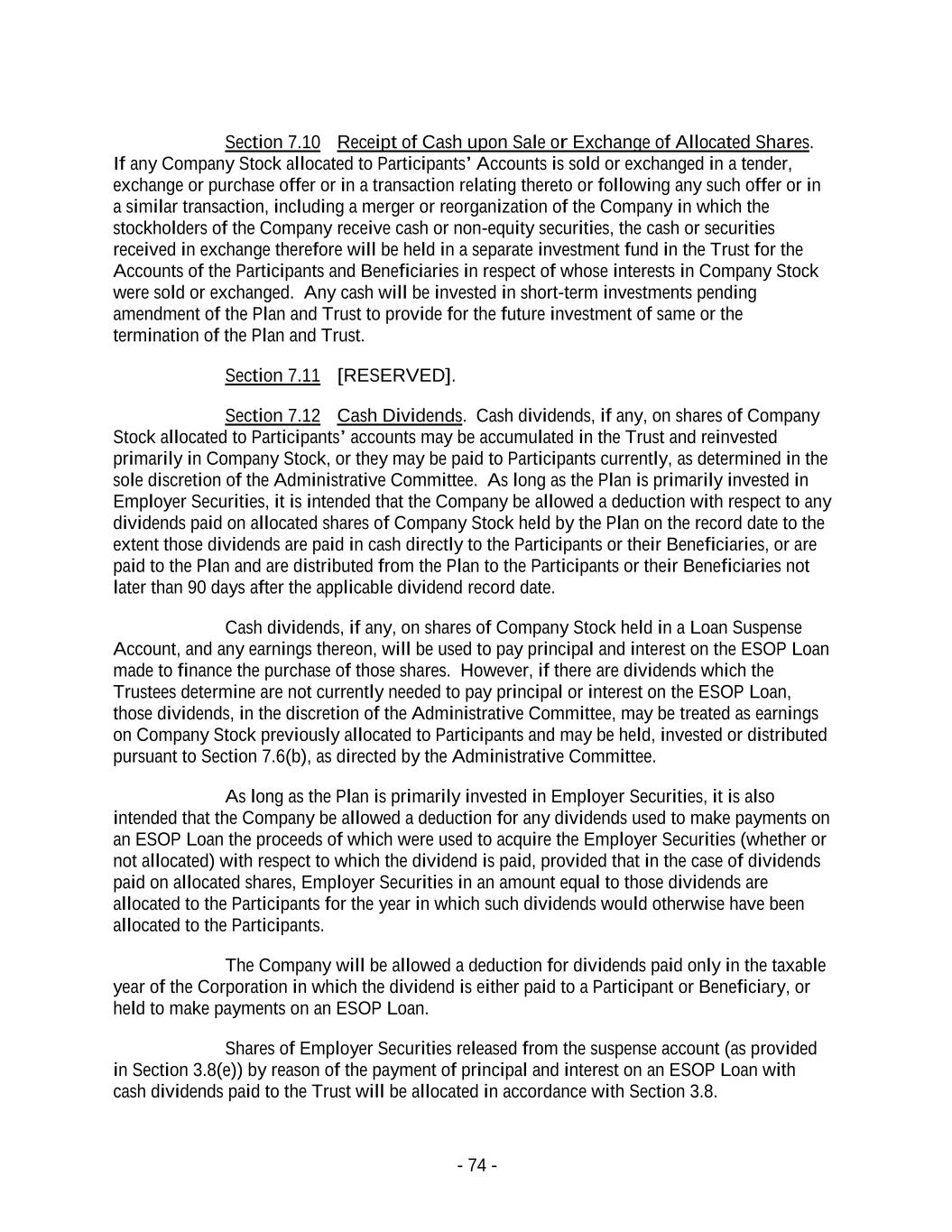
Section 7.10 Receipt of Cash upon Sale or Exchange of Allocated Shares. If any Company Stock allocated to Participants’ Accounts is sold or exchanged in a tender, exchange or purchase offer or in a transaction relating thereto or following any such offer or in a similar transaction, including a merger or reorganization of the Company in which the stockholders of the Company receive cash or non-equity securities, the cash or securities received in exchange therefore will be held in a separate investment fund in the Trust for the Accounts of the Participants and Beneficiaries in respect of whose interests in Company Stock were sold or exchanged. Any cash will be invested in short-term investments pending amendment of the Plan and Trust to provide for the future investment of same or the termination of the Plan and Trust. Section 7.11 [RESERVED]. Section 7.12 Cash Dividends. Cash dividends, if any, on shares of Company Stock allocated to Participants’ accounts may be accumulated in the Trust and reinvested primarily in Company Stock, or they may be paid to Participants currently, as determined in the sole discretion of the Administrative Committee. As long as the Plan is primarily invested in Employer Securities, it is intended that the Company be allowed a deduction with respect to any dividends paid on allocated shares of Company Stock held by the Plan on the record date to the extent those dividends are paid in cash directly to the Participants or their Beneficiaries, or are paid to the Plan and are distributed from the Plan to the Participants or their Beneficiaries not later than 90 days after the applicable dividend record date. Cash dividends, if any, on shares of Company Stock held in a Loan Suspense Account, and any earnings thereon, will be used to pay principal and interest on the ESOP Loan made to finance the purchase of those shares. However, if there are dividends which the Trustees determine are not currently needed to pay principal or interest on the ESOP Loan, those dividends, in the discretion of the Administrative Committee, may be treated as earnings on Company Stock previously allocated to Participants and may be held, invested or distributed pursuant to Section 7.6(b), as directed by the Administrative Committee. As long as the Plan is primarily invested in Employer Securities, it is also intended that the Company be allowed a deduction for any dividends used to make payments on an ESOP Loan the proceeds of which were used to acquire the Employer Securities (whether or not allocated) with respect to which the dividend is paid, provided that in the case of dividends paid on allocated shares, Employer Securities in an amount equal to those dividends are allocated to the Participants for the year in which such dividends would otherwise have been allocated to the Participants. The Company will be allowed a deduction for dividends paid only in the taxable year of the Corporation in which the dividend is either paid to a Participant or Beneficiary, or held to make payments on an ESOP Loan. Shares of Employer Securities released from the suspense account (as provided in Section 3.8(e)) by reason of the payment of principal and interest on an ESOP Loan with cash dividends paid to the Trust will be allocated in accordance with Section 3.8. - 74 -

Section 7.13 Nonterminable Rights. All rights and protections conferred by this Plan on Participants, with respect to (1) put, call or other options and (2) buy-sell or similar arrangements, in accordance with Treasury Regulation Sections 54.4975-7(b)(4), (10), (11) and (12), will be nonterminable, regardless of whether all ESOP Loans have been fully repaid or the Plan ceases to be an employee stock ownership plan. Section 7.14 Diversification of Employer Securities. (a) Rule Applicable to Elective Deferrals and Employee Contributions. For Plan Years beginning after December 31, 2006, if any portion of the account of a Participant (including, for purposes of this Section 7.14, a Beneficiary entitled to exercise the rights of a Participant) attributable to Elective Deferrals or employee contributions is invested in Company Stock that is readily tradable on an established securities market, the Participant may elect to direct the Plan to divest any such securities, and to reinvest an equivalent amount in other investment options that satisfy the requirements of Section 7.14(c). (b) Rule Applicable to Employer Contributions. If any portion of a Participant’s account attributable to nonelective or matching contributions is invested in publicly-traded Company Stock, then a Participant, or a Beneficiary of any deceased Participant entitled to exercise the right of a Participant, may elect to direct the Plan to divest any such securities, and to reinvest an equivalent amount in other investment options that satisfy the requirements of Section 7.14(c). (c) Investment Options. For purposes of this Section, other investment options must include not less than three investment options, other than Company Stock, to which the Participant may direct the proceeds of divestment of Company Stock required by this Section, each of which option is diversified and has materially different risk and return characteristics. The Plan must provide reasonable divestment and reinvestment opportunities at least quarterly. Except as provided in Regulations, the Plan may not impose restrictions or conditions on the investment of Company Stock that the Plan does not impose on the investment of other Plan assets, other than restrictions or conditions imposed by reason of the application of securities laws or a condition permitted under IRS Notice 2006-107 or other applicable guidance. (d) Treatment as Publicly Traded Employer Securities. Except as provided in Regulations or in Code Section 401(a)(35)(F)(ii) (relating to certain controlled groups), if the Plan holds Company Stock that is not publicly traded Company Stock, it will be treated as holding Company Stock that is publicly traded, if the Company or any member of a controlled group of corporations that includes the Company has issued a class of stock that is a publicly traded security. For purposes of this subsection, the term “controlled group of corporations” has the meaning given such term in Code Section 1563(a), except that “50 percent” will be substituted for “80 percent” each place it appears. - 75 -
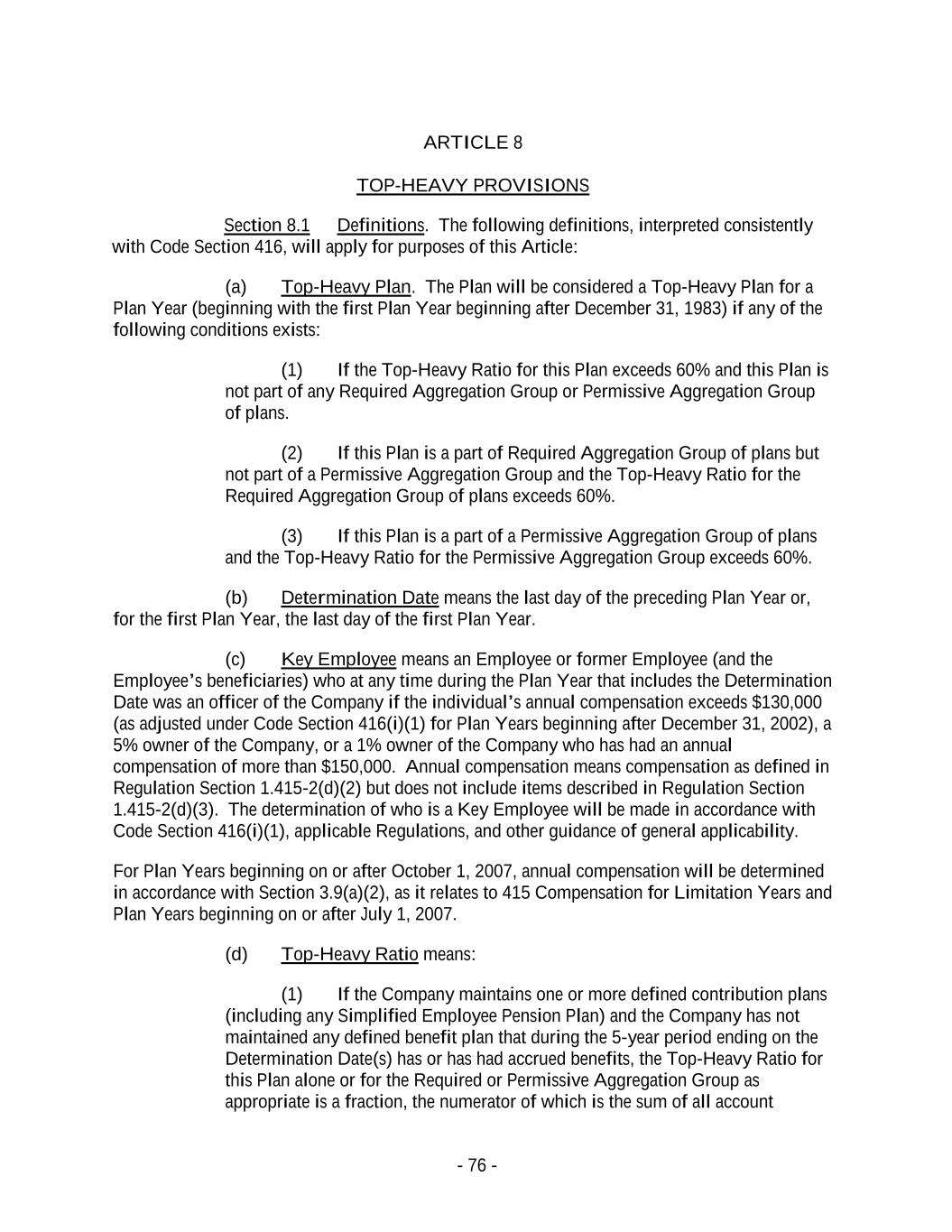
ARTICLE 8 TOP-HEAVY PROVISIONS Section 8.1 Definitions. The following definitions, interpreted consistently with Code Section 416, will apply for purposes of this Article: (a) Top-Heavy Plan. The Plan will be considered a Top-Heavy Plan for a Plan Year (beginning with the first Plan Year beginning after December 31, 1983) if any of the following conditions exists: (1) If the Top-Heavy Ratio for this Plan exceeds 60% and this Plan is not part of any Required Aggregation Group or Permissive Aggregation Group of plans. (2) If this Plan is a part of Required Aggregation Group of plans but not part of a Permissive Aggregation Group and the Top-Heavy Ratio for the Required Aggregation Group of plans exceeds 60%. (3) If this Plan is a part of a Permissive Aggregation Group of plans and the Top-Heavy Ratio for the Permissive Aggregation Group exceeds 60%. (b) Determination Date means the last day of the preceding Plan Year or, for the first Plan Year, the last day of the first Plan Year. (c) Key Employee means an Employee or former Employee (and the Employee’s beneficiaries) who at any time during the Plan Year that includes the Determination Date was an officer of the Company if the individual’s annual compensation exceeds $130,000 (as adjusted under Code Section 416(i)(1) for Plan Years beginning after December 31, 2002), a 5% owner of the Company, or a 1% owner of the Company who has had an annual compensation of more than $150,000. Annual compensation means compensation as defined in Regulation Section 1.415-2(d)(2) but does not include items described in Regulation Section 1.415-2(d)(3). The determination of who is a Key Employee will be made in accordance with Code Section 416(i)(1), applicable Regulations, and other guidance of general applicability. For Plan Years beginning on or after October 1, 2007, annual compensation will be determined in accordance with Section 3.9(a)(2), as it relates to 415 Compensation for Limitation Years and Plan Years beginning on or after July 1, 2007. (d) Top-Heavy Ratio means: (1) If the Company maintains one or more defined contribution plans (including any Simplified Employee Pension Plan) and the Company has not maintained any defined benefit plan that during the 5-year period ending on the Determination Date(s) has or has had accrued benefits, the Top-Heavy Ratio for this Plan alone or for the Required or Permissive Aggregation Group as appropriate is a fraction, the numerator of which is the sum of all account - 76 -
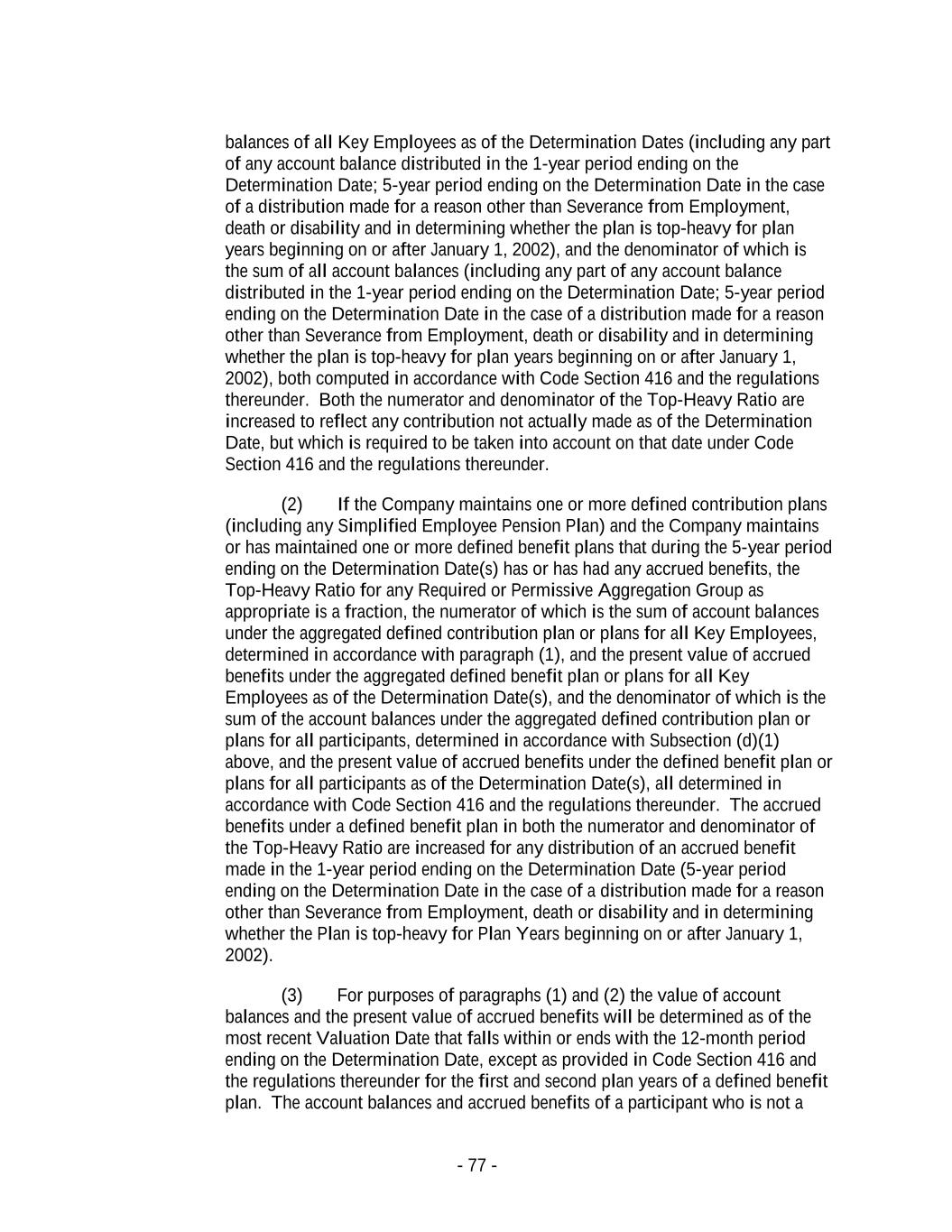
balances of all Key Employees as of the Determination Dates (including any part of any account balance distributed in the 1-year period ending on the Determination Date; 5-year period ending on the Determination Date in the case of a distribution made for a reason other than Severance from Employment, death or disability and in determining whether the plan is top-heavy for plan years beginning on or after January 1, 2002), and the denominator of which is the sum of all account balances (including any part of any account balance distributed in the 1-year period ending on the Determination Date; 5-year period ending on the Determination Date in the case of a distribution made for a reason other than Severance from Employment, death or disability and in determining whether the plan is top-heavy for plan years beginning on or after January 1, 2002), both computed in accordance with Code Section 416 and the regulations thereunder. Both the numerator and denominator of the Top-Heavy Ratio are increased to reflect any contribution not actually made as of the Determination Date, but which is required to be taken into account on that date under Code Section 416 and the regulations thereunder. (2) If the Company maintains one or more defined contribution plans (including any Simplified Employee Pension Plan) and the Company maintains or has maintained one or more defined benefit plans that during the 5-year period ending on the Determination Date(s) has or has had any accrued benefits, the Top-Heavy Ratio for any Required or Permissive Aggregation Group as appropriate is a fraction, the numerator of which is the sum of account balances under the aggregated defined contribution plan or plans for all Key Employees, determined in accordance with paragraph (1), and the present value of accrued benefits under the aggregated defined benefit plan or plans for all Key Employees as of the Determination Date(s), and the denominator of which is the sum of the account balances under the aggregated defined contribution plan or plans for all participants, determined in accordance with Subsection (d)(1) above, and the present value of accrued benefits under the defined benefit plan or plans for all participants as of the Determination Date(s), all determined in accordance with Code Section 416 and the regulations thereunder. The accrued benefits under a defined benefit plan in both the numerator and denominator of the Top-Heavy Ratio are increased for any distribution of an accrued benefit made in the 1-year period ending on the Determination Date (5-year period ending on the Determination Date in the case of a distribution made for a reason other than Severance from Employment, death or disability and in determining whether the Plan is top-heavy for Plan Years beginning on or after January 1, 2002). (3) For purposes of paragraphs (1) and (2) the value of account balances and the present value of accrued benefits will be determined as of the most recent Valuation Date that falls within or ends with the 12-month period ending on the Determination Date, except as provided in Code Section 416 and the regulations thereunder for the first and second plan years of a defined benefit plan. The account balances and accrued benefits of a participant who is not a - 77 -
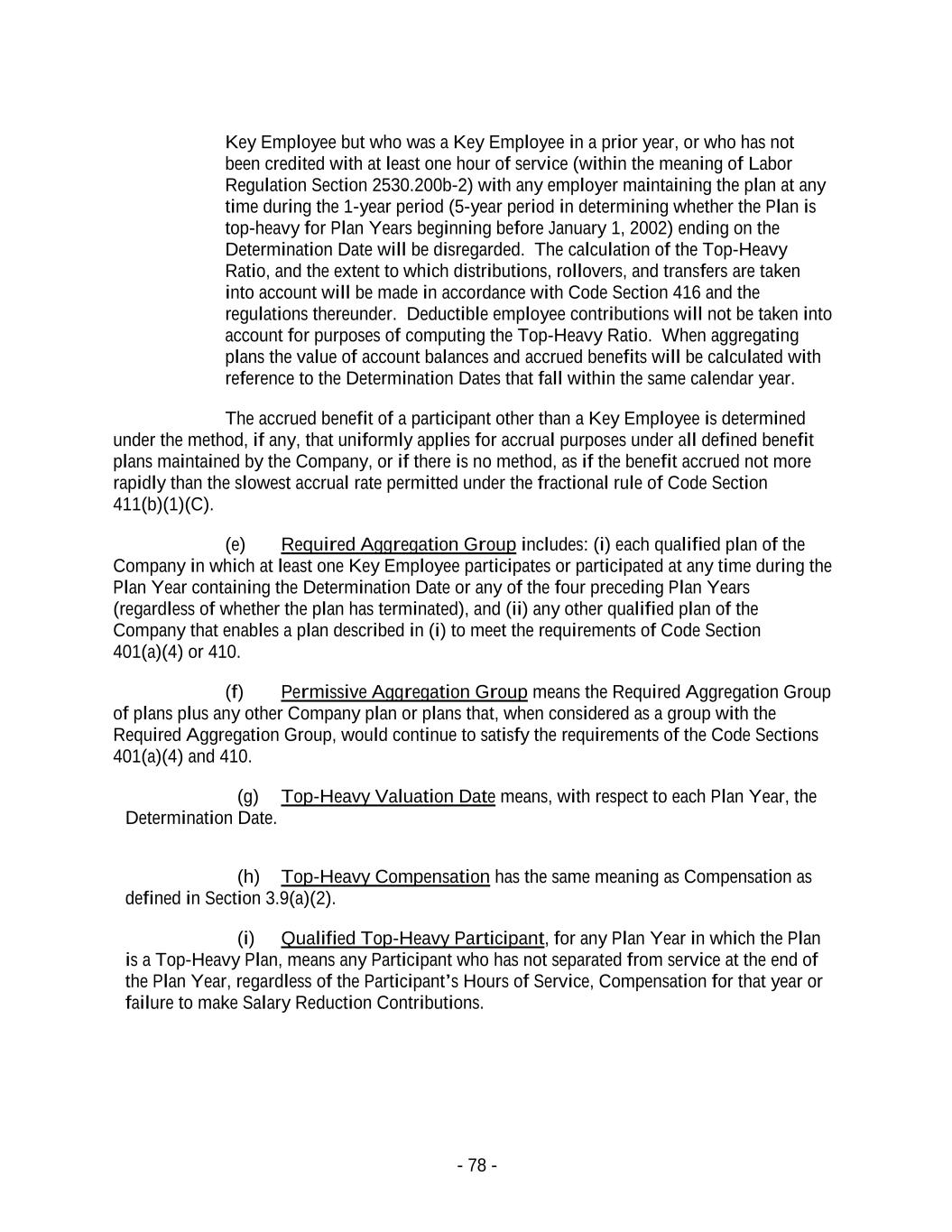
Key Employee but who was a Key Employee in a prior year, or who has not been credited with at least one hour of service (within the meaning of Labor Regulation Section 2530.200b-2) with any employer maintaining the plan at any time during the 1-year period (5-year period in determining whether the Plan is top-heavy for Plan Years beginning before January 1, 2002) ending on the Determination Date will be disregarded. The calculation of the Top-Heavy Ratio, and the extent to which distributions, rollovers, and transfers are taken into account will be made in accordance with Code Section 416 and the regulations thereunder. Deductible employee contributions will not be taken into account for purposes of computing the Top-Heavy Ratio. When aggregating plans the value of account balances and accrued benefits will be calculated with reference to the Determination Dates that fall within the same calendar year. The accrued benefit of a participant other than a Key Employee is determined under the method, if any, that uniformly applies for accrual purposes under all defined benefit plans maintained by the Company, or if there is no method, as if the benefit accrued not more rapidly than the slowest accrual rate permitted under the fractional rule of Code Section 411(b)(1)(C). (e) Required Aggregation Group includes: (i) each qualified plan of the Company in which at least one Key Employee participates or participated at any time during the Plan Year containing the Determination Date or any of the four preceding Plan Years (regardless of whether the plan has terminated), and (ii) any other qualified plan of the Company that enables a plan described in (i) to meet the requirements of Code Section 401(a)(4) or 410. (f) Permissive Aggregation Group means the Required Aggregation Group of plans plus any other Company plan or plans that, when considered as a group with the Required Aggregation Group, would continue to satisfy the requirements of the Code Sections 401(a)(4) and 410. (g) Top-Heavy Valuation Date means, with respect to each Plan Year, the Determination Date. (h) Top-Heavy Compensation has the same meaning as Compensation as defined in Section 3.9(a)(2). (i) Qualified Top-Heavy Participant, for any Plan Year in which the Plan is a Top-Heavy Plan, means any Participant who has not separated from service at the end of the Plan Year, regardless of the Participant’s Hours of Service, Compensation for that year or failure to make Salary Reduction Contributions. - 78 -
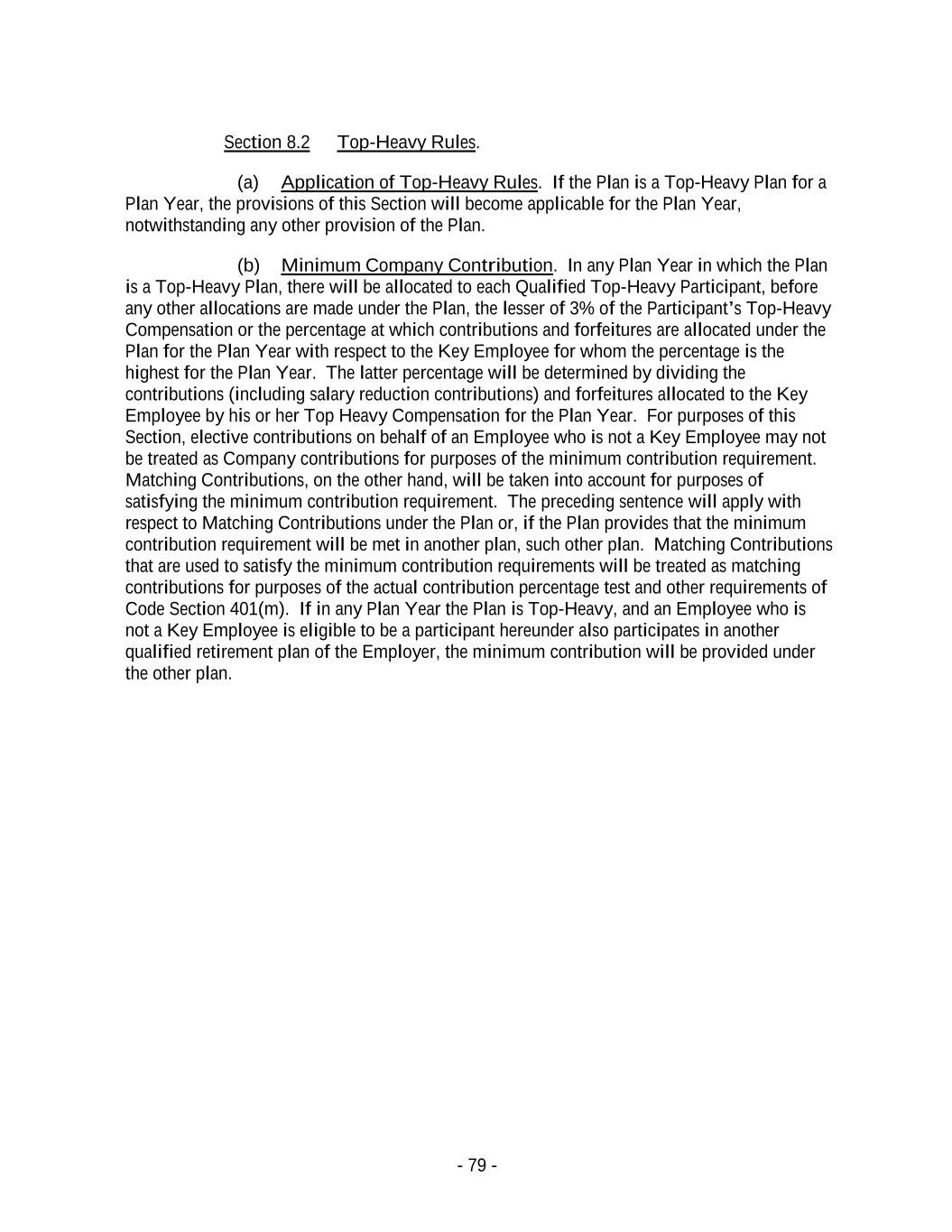
Section 8.2 Top-Heavy Rules. (a) Application of Top-Heavy Rules. If the Plan is a Top-Heavy Plan for a Plan Year, the provisions of this Section will become applicable for the Plan Year, notwithstanding any other provision of the Plan. (b) Minimum Company Contribution. In any Plan Year in which the Plan is a Top-Heavy Plan, there will be allocated to each Qualified Top-Heavy Participant, before any other allocations are made under the Plan, the lesser of 3% of the Participant’s Top-Heavy Compensation or the percentage at which contributions and forfeitures are allocated under the Plan for the Plan Year with respect to the Key Employee for whom the percentage is the highest for the Plan Year. The latter percentage will be determined by dividing the contributions (including salary reduction contributions) and forfeitures allocated to the Key Employee by his or her Top Heavy Compensation for the Plan Year. For purposes of this Section, elective contributions on behalf of an Employee who is not a Key Employee may not be treated as Company contributions for purposes of the minimum contribution requirement. Matching Contributions, on the other hand, will be taken into account for purposes of satisfying the minimum contribution requirement. The preceding sentence will apply with respect to Matching Contributions under the Plan or, if the Plan provides that the minimum contribution requirement will be met in another plan, such other plan. Matching Contributions that are used to satisfy the minimum contribution requirements will be treated as matching contributions for purposes of the actual contribution percentage test and other requirements of Code Section 401(m). If in any Plan Year the Plan is Top-Heavy, and an Employee who is not a Key Employee is eligible to be a participant hereunder also participates in another qualified retirement plan of the Employer, the minimum contribution will be provided under the other plan. - 79 -

ARTICLE 9 ADMINISTRATION OF PLAN Section 9.1 Responsibility and Actions of the Corporation. The Corporation accepts responsibility as a “named fiduciary” under ERISA Section 402(a)(1) with respect to the selection, retention and replacement of the Trustees, the selection, retention or replacement of the members of the Administrative Committee and the Investment Committee, the mandatory investments in Company Stock, and the review of the performance of the fiduciary duties and responsibilities vested in the Trustees and the Committees under the Plan and Trust. The Corporation will act by resolution of its Board. Any such action will be evidenced by written resolution certified in writing by the Secretary or Assistant Secretary of the Corporation or by two members of the Board that the resolution was duly approved and adopted by the Board. Section 9.2 Administrative Committee. The Administrative Committee is the Plan Administrator and is a “named fiduciary” under ERISA Section 402(a)(1). The Administrative Committee will consist of at least three persons who will be appointed by and serve at the pleasure of the Board. The Administrative Committee has primary discretionary responsibility and authority for the administration of the Plan (except for the duties delegated to the Investment Committee under Section 9.4), including the power and authority to interpret the Plan’s provisions and interpret ambiguities therein, authorize distributions from the Trust, establish and enforce rules and regulations they deem proper for the efficient administration of the Plan, determine the amount of benefits that are payable to any person in accordance with the provisions of the Plan, appoint an Investment Manager for purposes of Section 9.3, establish investment funds for investing the assets held under the Trust, establish benefit claim procedures, consider and decide conclusively appeals by any claimant in accordance with an appeals procedure established by the Administrative Committee, determine the existence of financial hardship for purposes of Section 5.13, maintain records of Participant investment fund elections, communicate same to the Trustees and authorize the payment of benefits from the Trust. The Administrative Committee has the authority to engage independent counsel and consultants and to compensate them out of Plan assets. The Administrative Committee also has responsibility for compliance with reporting and disclosure requirements under ERISA. The Administrative Committee, from time to time, may recommend Plan amendments to the Board that the Administrative Committee, in consultation with others, deems appropriate. In exercising the powers and authorities described in this Section, the Administrative Committee will at all times exercise good faith, apply standards of uniform application, and refrain from arbitrary action. Section 9.3 Delegation of Administrative Committee Responsibilities. In addition to and in furtherance of the Administrative Committee’s powers and authorities with - 80 -
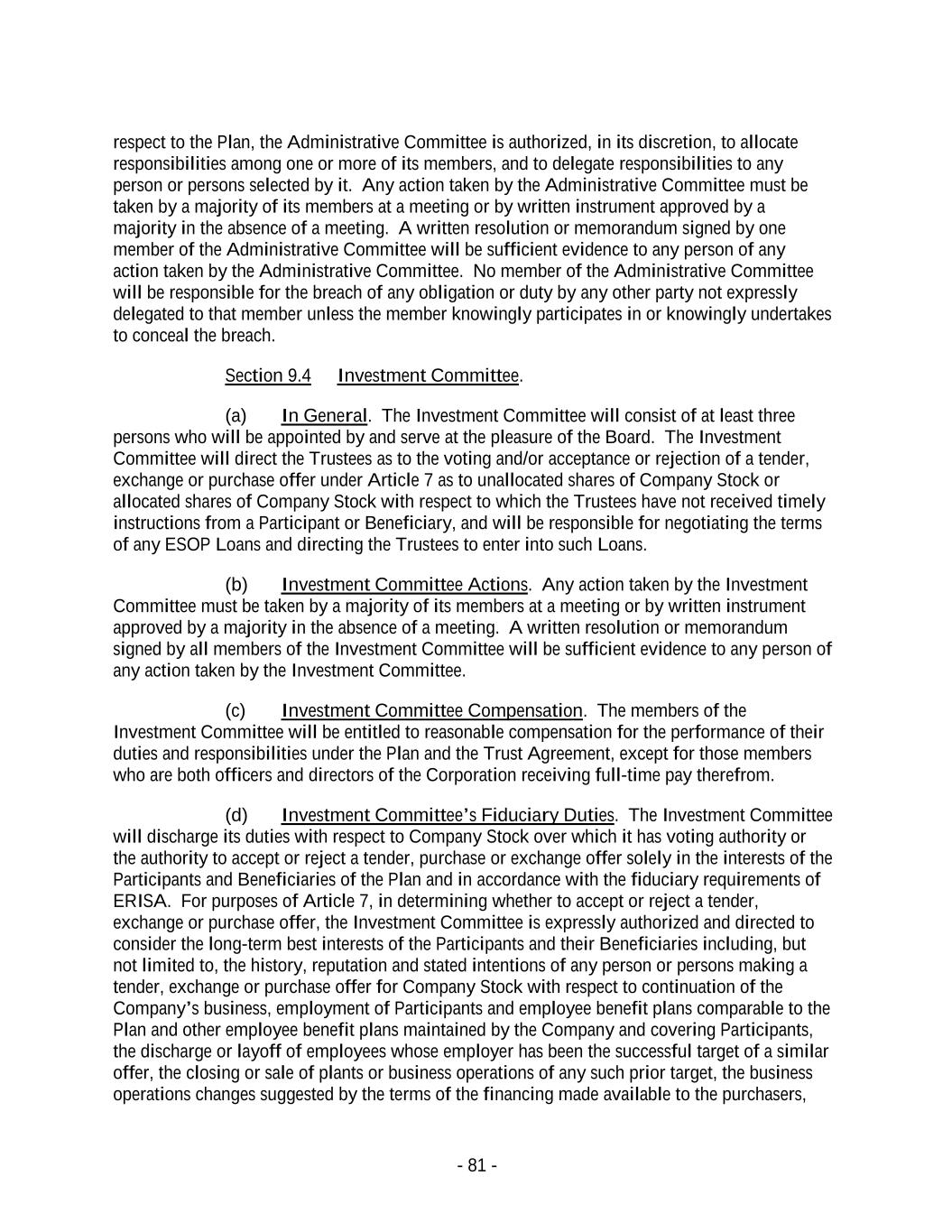
respect to the Plan, the Administrative Committee is authorized, in its discretion, to allocate responsibilities among one or more of its members, and to delegate responsibilities to any person or persons selected by it. Any action taken by the Administrative Committee must be taken by a majority of its members at a meeting or by written instrument approved by a majority in the absence of a meeting. A written resolution or memorandum signed by one member of the Administrative Committee will be sufficient evidence to any person of any action taken by the Administrative Committee. No member of the Administrative Committee will be responsible for the breach of any obligation or duty by any other party not expressly delegated to that member unless the member knowingly participates in or knowingly undertakes to conceal the breach. Section 9.4 Investment Committee. (a) In General. The Investment Committee will consist of at least three persons who will be appointed by and serve at the pleasure of the Board. The Investment Committee will direct the Trustees as to the voting and/or acceptance or rejection of a tender, exchange or purchase offer under Article 7 as to unallocated shares of Company Stock or allocated shares of Company Stock with respect to which the Trustees have not received timely instructions from a Participant or Beneficiary, and will be responsible for negotiating the terms of any ESOP Loans and directing the Trustees to enter into such Loans. (b) Investment Committee Actions. Any action taken by the Investment Committee must be taken by a majority of its members at a meeting or by written instrument approved by a majority in the absence of a meeting. A written resolution or memorandum signed by all members of the Investment Committee will be sufficient evidence to any person of any action taken by the Investment Committee. (c) Investment Committee Compensation. The members of the Investment Committee will be entitled to reasonable compensation for the performance of their duties and responsibilities under the Plan and the Trust Agreement, except for those members who are both officers and directors of the Corporation receiving full-time pay therefrom. (d) Investment Committee’s Fiduciary Duties. The Investment Committee will discharge its duties with respect to Company Stock over which it has voting authority or the authority to accept or reject a tender, purchase or exchange offer solely in the interests of the Participants and Beneficiaries of the Plan and in accordance with the fiduciary requirements of ERISA. For purposes of Article 7, in determining whether to accept or reject a tender, exchange or purchase offer, the Investment Committee is expressly authorized and directed to consider the long-term best interests of the Participants and their Beneficiaries including, but not limited to, the history, reputation and stated intentions of any person or persons making a tender, exchange or purchase offer for Company Stock with respect to continuation of the Company’s business, employment of Participants and employee benefit plans comparable to the Plan and other employee benefit plans maintained by the Company and covering Participants, the discharge or layoff of employees whose employer has been the successful target of a similar offer, the closing or sale of plants or business operations of any such prior target, the business operations changes suggested by the terms of the financing made available to the purchasers, - 81 -
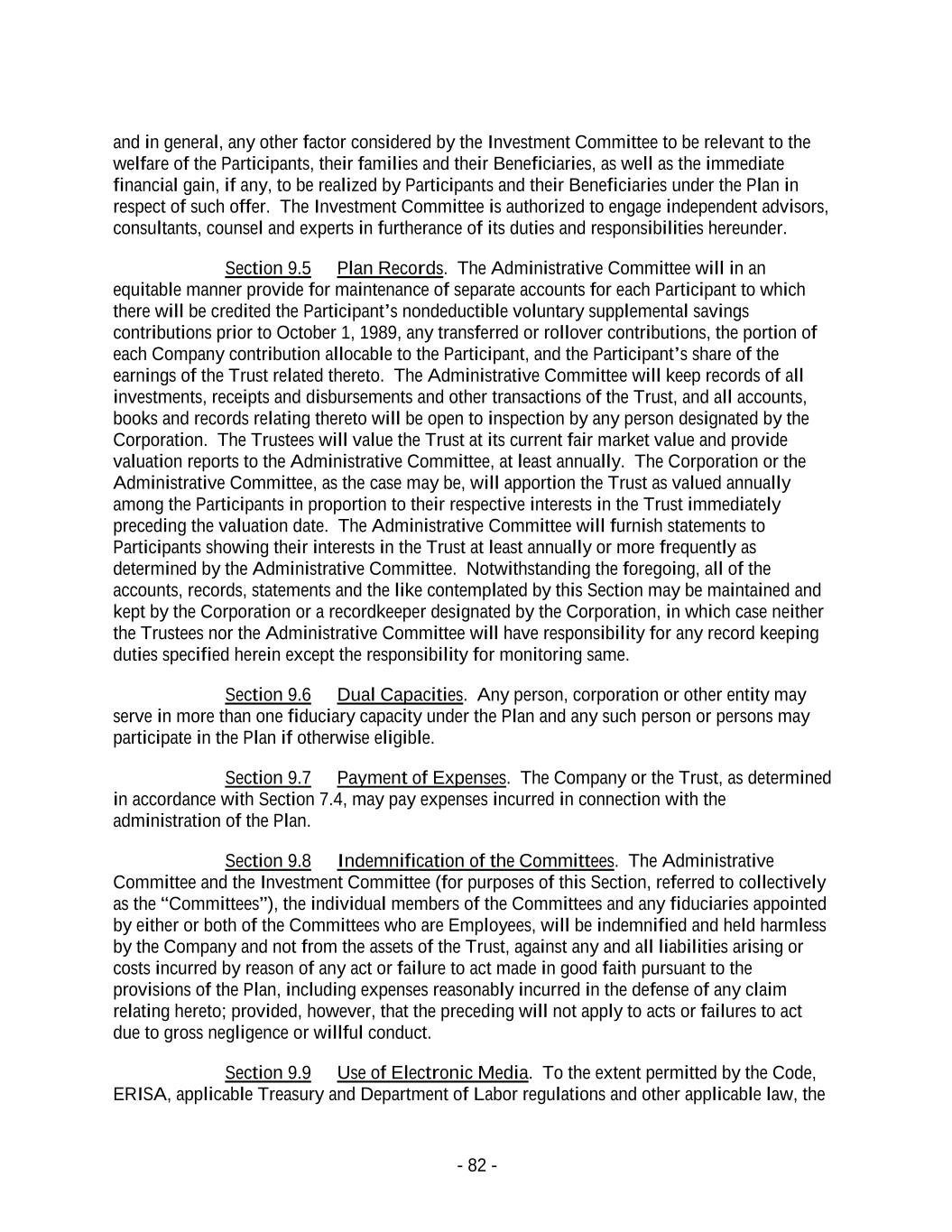
and in general, any other factor considered by the Investment Committee to be relevant to the welfare of the Participants, their families and their Beneficiaries, as well as the immediate financial gain, if any, to be realized by Participants and their Beneficiaries under the Plan in respect of such offer. The Investment Committee is authorized to engage independent advisors, consultants, counsel and experts in furtherance of its duties and responsibilities hereunder. Section 9.5 Plan Records. The Administrative Committee will in an equitable manner provide for maintenance of separate accounts for each Participant to which there will be credited the Participant’s nondeductible voluntary supplemental savings contributions prior to October 1, 1989, any transferred or rollover contributions, the portion of each Company contribution allocable to the Participant, and the Participant’s share of the earnings of the Trust related thereto. The Administrative Committee will keep records of all investments, receipts and disbursements and other transactions of the Trust, and all accounts, books and records relating thereto will be open to inspection by any person designated by the Corporation. The Trustees will value the Trust at its current fair market value and provide valuation reports to the Administrative Committee, at least annually. The Corporation or the Administrative Committee, as the case may be, will apportion the Trust as valued annually among the Participants in proportion to their respective interests in the Trust immediately preceding the valuation date. The Administrative Committee will furnish statements to Participants showing their interests in the Trust at least annually or more frequently as determined by the Administrative Committee. Notwithstanding the foregoing, all of the accounts, records, statements and the like contemplated by this Section may be maintained and kept by the Corporation or a recordkeeper designated by the Corporation, in which case neither the Trustees nor the Administrative Committee will have responsibility for any record keeping duties specified herein except the responsibility for monitoring same. Section 9.6 Dual Capacities. Any person, corporation or other entity may serve in more than one fiduciary capacity under the Plan and any such person or persons may participate in the Plan if otherwise eligible. Section 9.7 Payment of Expenses. The Company or the Trust, as determined in accordance with Section 7.4, may pay expenses incurred in connection with the administration of the Plan. Section 9.8 Indemnification of the Committees. The Administrative Committee and the Investment Committee (for purposes of this Section, referred to collectively as the “Committees”), the individual members of the Committees and any fiduciaries appointed by either or both of the Committees who are Employees, will be indemnified and held harmless by the Company and not from the assets of the Trust, against any and all liabilities arising or costs incurred by reason of any act or failure to act made in good faith pursuant to the provisions of the Plan, including expenses reasonably incurred in the defense of any claim relating hereto; provided, however, that the preceding will not apply to acts or failures to act due to gross negligence or willful conduct. Section 9.9 Use of Electronic Media. To the extent permitted by the Code, ERISA, applicable Treasury and Department of Labor regulations and other applicable law, the - 82 -
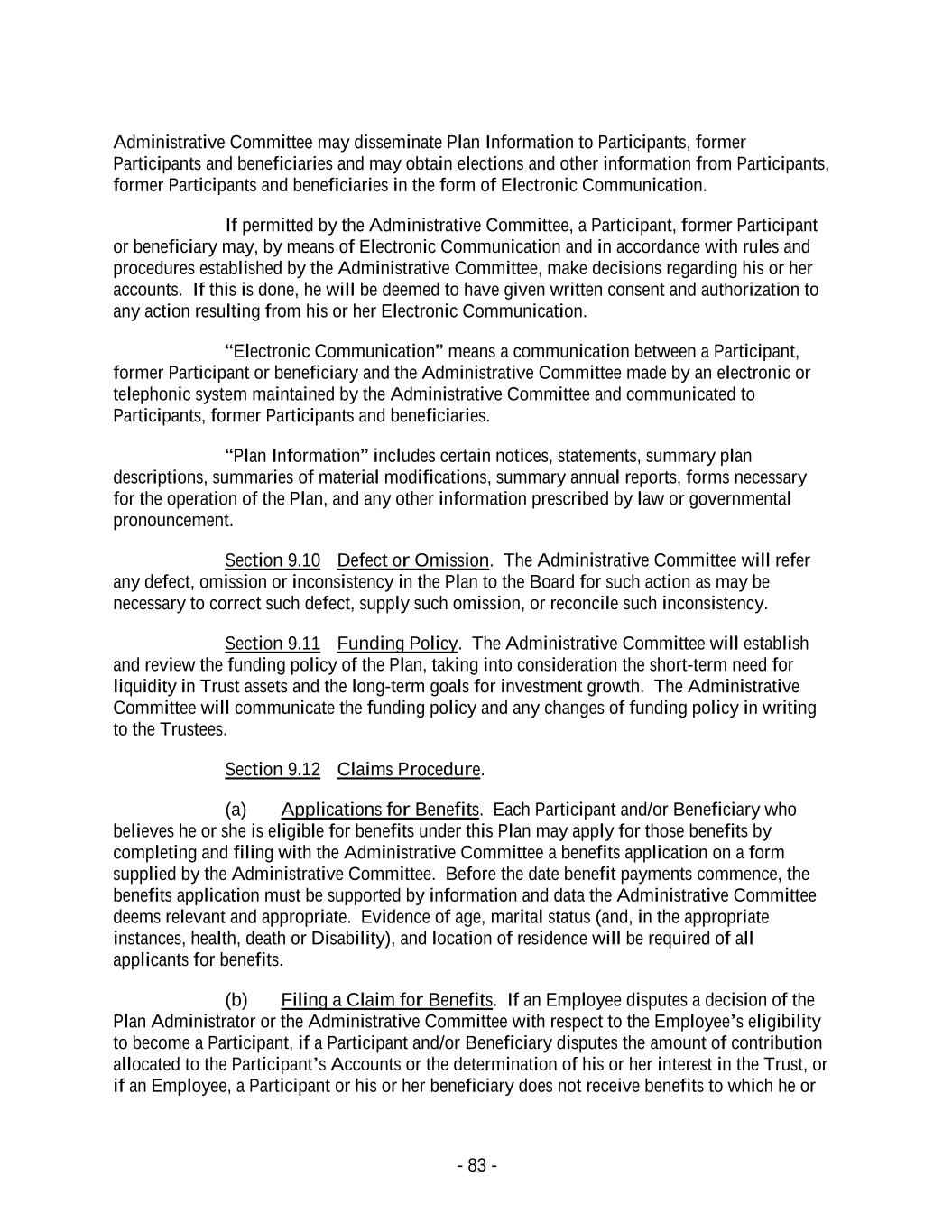
Administrative Committee may disseminate Plan Information to Participants, former Participants and beneficiaries and may obtain elections and other information from Participants, former Participants and beneficiaries in the form of Electronic Communication. If permitted by the Administrative Committee, a Participant, former Participant or beneficiary may, by means of Electronic Communication and in accordance with rules and procedures established by the Administrative Committee, make decisions regarding his or her accounts. If this is done, he will be deemed to have given written consent and authorization to any action resulting from his or her Electronic Communication. “Electronic Communication” means a communication between a Participant, former Participant or beneficiary and the Administrative Committee made by an electronic or telephonic system maintained by the Administrative Committee and communicated to Participants, former Participants and beneficiaries. “Plan Information” includes certain notices, statements, summary plan descriptions, summaries of material modifications, summary annual reports, forms necessary for the operation of the Plan, and any other information prescribed by law or governmental pronouncement. Section 9.10 Defect or Omission. The Administrative Committee will refer any defect, omission or inconsistency in the Plan to the Board for such action as may be necessary to correct such defect, supply such omission, or reconcile such inconsistency. Section 9.11 Funding Policy. The Administrative Committee will establish and review the funding policy of the Plan, taking into consideration the short-term need for liquidity in Trust assets and the long-term goals for investment growth. The Administrative Committee will communicate the funding policy and any changes of funding policy in writing to the Trustees. Section 9.12 Claims Procedure. (a) Applications for Benefits. Each Participant and/or Beneficiary who believes he or she is eligible for benefits under this Plan may apply for those benefits by completing and filing with the Administrative Committee a benefits application on a form supplied by the Administrative Committee. Before the date benefit payments commence, the benefits application must be supported by information and data the Administrative Committee deems relevant and appropriate. Evidence of age, marital status (and, in the appropriate instances, health, death or Disability), and location of residence will be required of all applicants for benefits. (b) Filing a Claim for Benefits. If an Employee disputes a decision of the Plan Administrator or the Administrative Committee with respect to the Employee’s eligibility to become a Participant, if a Participant and/or Beneficiary disputes the amount of contribution allocated to the Participant’s Accounts or the determination of his or her interest in the Trust, or if an Employee, a Participant or his or her beneficiary does not receive benefits to which he or - 83 -
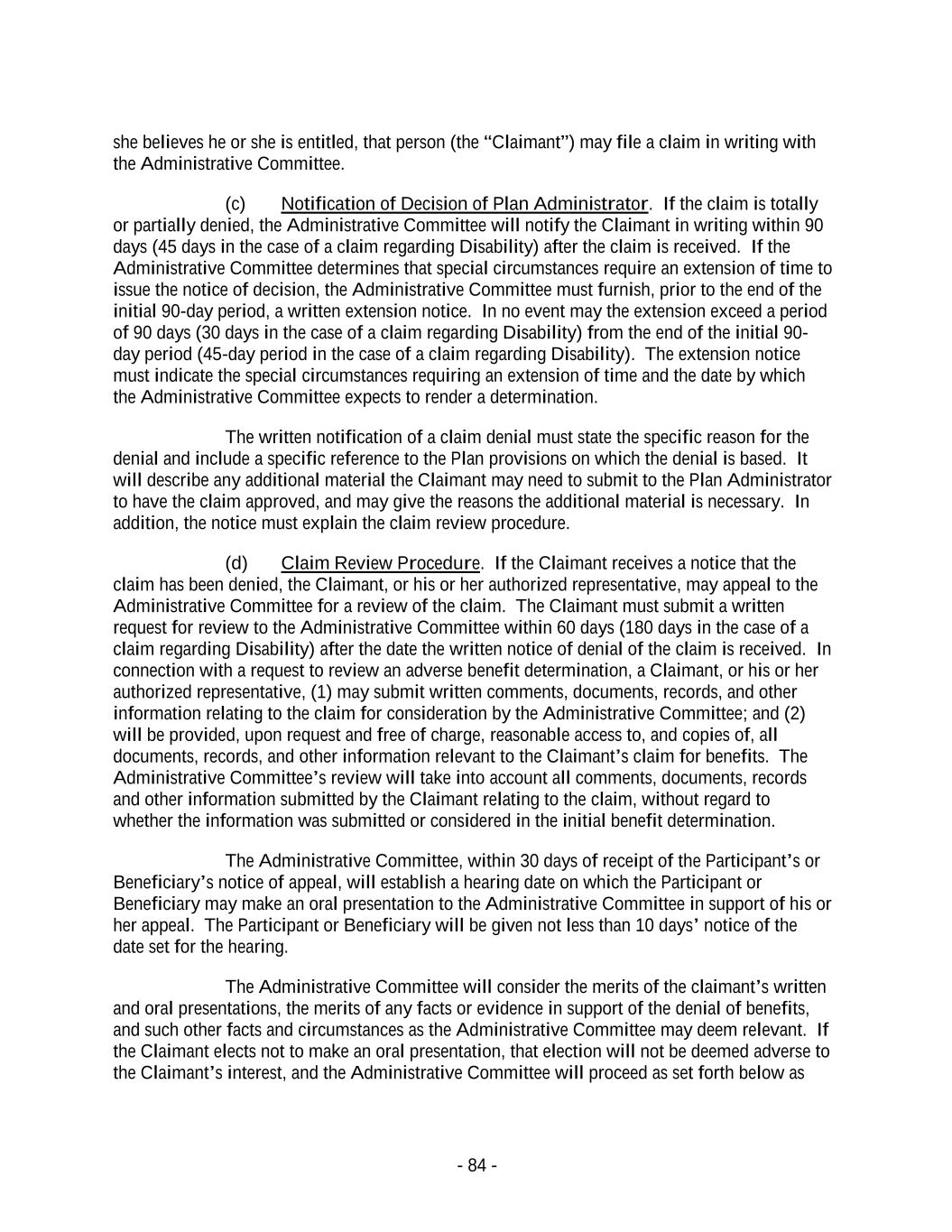
she believes he or she is entitled, that person (the “Claimant”) may file a claim in writing with the Administrative Committee. (c) Notification of Decision of Plan Administrator. If the claim is totally or partially denied, the Administrative Committee will notify the Claimant in writing within 90 days (45 days in the case of a claim regarding Disability) after the claim is received. If the Administrative Committee determines that special circumstances require an extension of time to issue the notice of decision, the Administrative Committee must furnish, prior to the end of the initial 90-day period, a written extension notice. In no event may the extension exceed a period of 90 days (30 days in the case of a claim regarding Disability) from the end of the initial 90- day period (45-day period in the case of a claim regarding Disability). The extension notice must indicate the special circumstances requiring an extension of time and the date by which the Administrative Committee expects to render a determination. The written notification of a claim denial must state the specific reason for the denial and include a specific reference to the Plan provisions on which the denial is based. It will describe any additional material the Claimant may need to submit to the Plan Administrator to have the claim approved, and may give the reasons the additional material is necessary. In addition, the notice must explain the claim review procedure. (d) Claim Review Procedure. If the Claimant receives a notice that the claim has been denied, the Claimant, or his or her authorized representative, may appeal to the Administrative Committee for a review of the claim. The Claimant must submit a written request for review to the Administrative Committee within 60 days (180 days in the case of a claim regarding Disability) after the date the written notice of denial of the claim is received. In connection with a request to review an adverse benefit determination, a Claimant, or his or her authorized representative, (1) may submit written comments, documents, records, and other information relating to the claim for consideration by the Administrative Committee; and (2) will be provided, upon request and free of charge, reasonable access to, and copies of, all documents, records, and other information relevant to the Claimant’s claim for benefits. The Administrative Committee’s review will take into account all comments, documents, records and other information submitted by the Claimant relating to the claim, without regard to whether the information was submitted or considered in the initial benefit determination. The Administrative Committee, within 30 days of receipt of the Participant’s or Beneficiary’s notice of appeal, will establish a hearing date on which the Participant or Beneficiary may make an oral presentation to the Administrative Committee in support of his or her appeal. The Participant or Beneficiary will be given not less than 10 days’ notice of the date set for the hearing. The Administrative Committee will consider the merits of the claimant’s written and oral presentations, the merits of any facts or evidence in support of the denial of benefits, and such other facts and circumstances as the Administrative Committee may deem relevant. If the Claimant elects not to make an oral presentation, that election will not be deemed adverse to the Claimant’s interest, and the Administrative Committee will proceed as set forth below as - 84 -
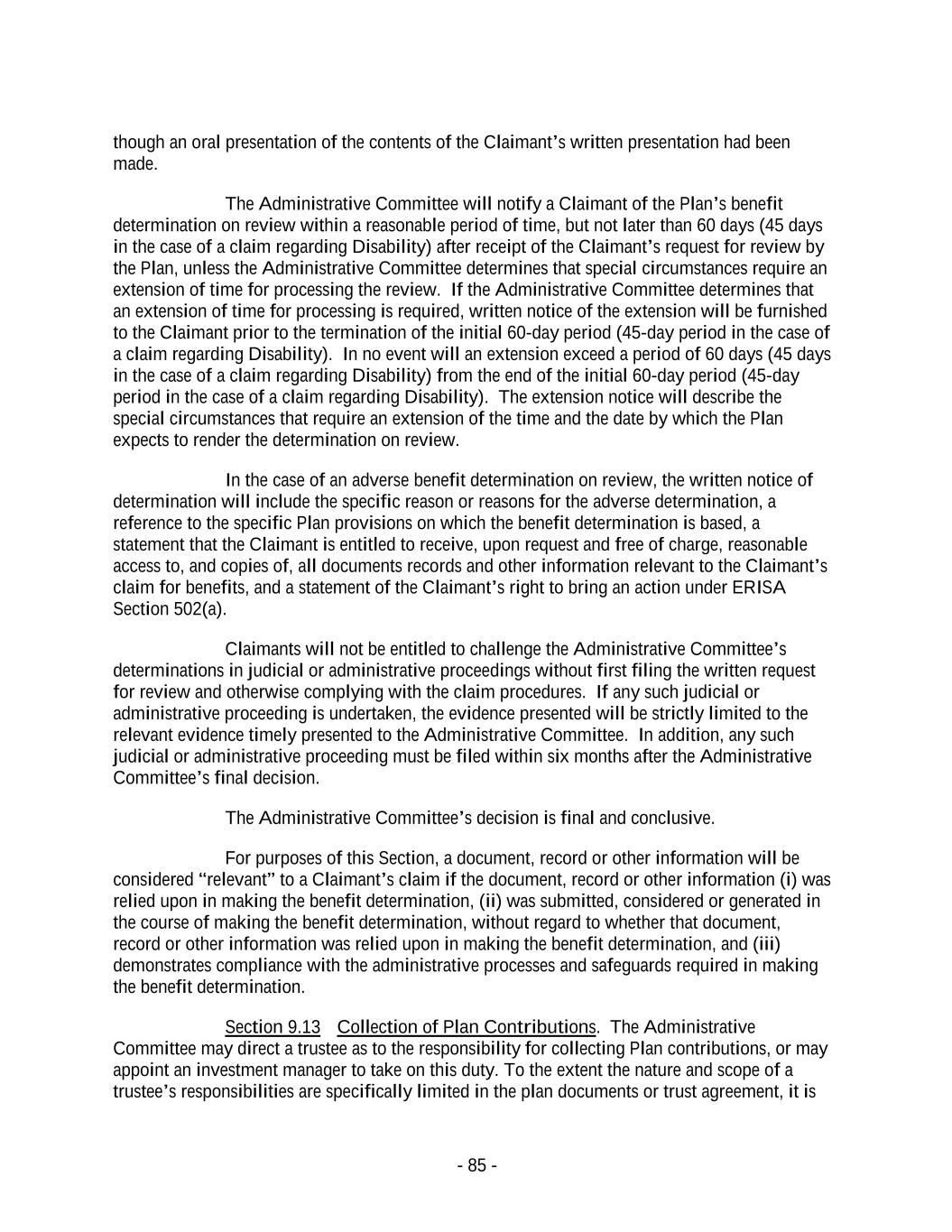
though an oral presentation of the contents of the Claimant’s written presentation had been made. The Administrative Committee will notify a Claimant of the Plan’s benefit determination on review within a reasonable period of time, but not later than 60 days (45 days in the case of a claim regarding Disability) after receipt of the Claimant’s request for review by the Plan, unless the Administrative Committee determines that special circumstances require an extension of time for processing the review. If the Administrative Committee determines that an extension of time for processing is required, written notice of the extension will be furnished to the Claimant prior to the termination of the initial 60-day period (45-day period in the case of a claim regarding Disability). In no event will an extension exceed a period of 60 days (45 days in the case of a claim regarding Disability) from the end of the initial 60-day period (45-day period in the case of a claim regarding Disability). The extension notice will describe the special circumstances that require an extension of the time and the date by which the Plan expects to render the determination on review. In the case of an adverse benefit determination on review, the written notice of determination will include the specific reason or reasons for the adverse determination, a reference to the specific Plan provisions on which the benefit determination is based, a statement that the Claimant is entitled to receive, upon request and free of charge, reasonable access to, and copies of, all documents records and other information relevant to the Claimant’s claim for benefits, and a statement of the Claimant’s right to bring an action under ERISA Section 502(a). Claimants will not be entitled to challenge the Administrative Committee’s determinations in judicial or administrative proceedings without first filing the written request for review and otherwise complying with the claim procedures. If any such judicial or administrative proceeding is undertaken, the evidence presented will be strictly limited to the relevant evidence timely presented to the Administrative Committee. In addition, any such judicial or administrative proceeding must be filed within six months after the Administrative Committee’s final decision. The Administrative Committee’s decision is final and conclusive. For purposes of this Section, a document, record or other information will be considered “relevant” to a Claimant’s claim if the document, record or other information (i) was relied upon in making the benefit determination, (ii) was submitted, considered or generated in the course of making the benefit determination, without regard to whether that document, record or other information was relied upon in making the benefit determination, and (iii) demonstrates compliance with the administrative processes and safeguards required in making the benefit determination. Section 9.13 Collection of Plan Contributions. The Administrative Committee may direct a trustee as to the responsibility for collecting Plan contributions, or may appoint an investment manager to take on this duty. To the extent the nature and scope of a trustee’s responsibilities are specifically limited in the plan documents or trust agreement, it is - 85 -
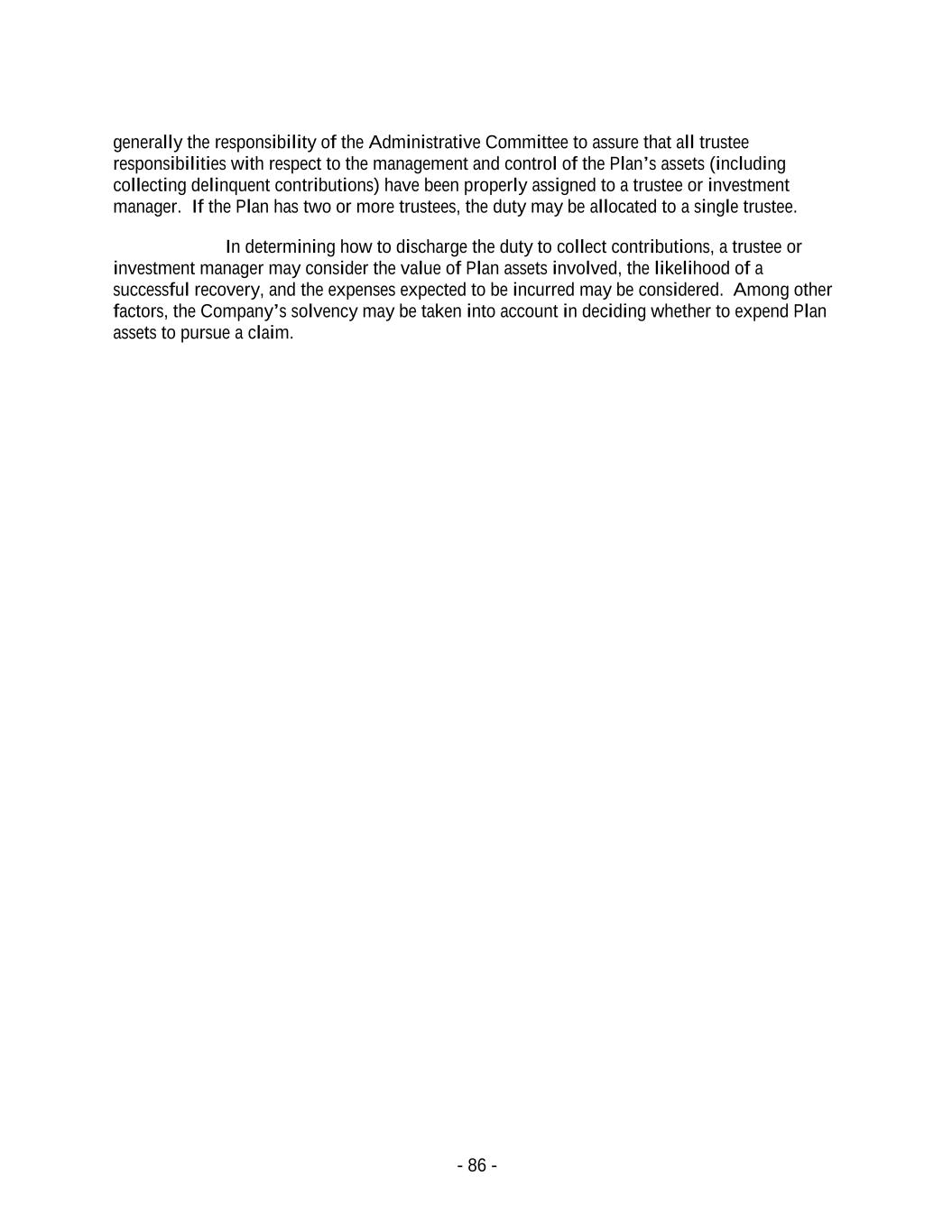
generally the responsibility of the Administrative Committee to assure that all trustee responsibilities with respect to the management and control of the Plan’s assets (including collecting delinquent contributions) have been properly assigned to a trustee or investment manager. If the Plan has two or more trustees, the duty may be allocated to a single trustee. In determining how to discharge the duty to collect contributions, a trustee or investment manager may consider the value of Plan assets involved, the likelihood of a successful recovery, and the expenses expected to be incurred may be considered. Among other factors, the Company’s solvency may be taken into account in deciding whether to expend Plan assets to pursue a claim. - 86 -
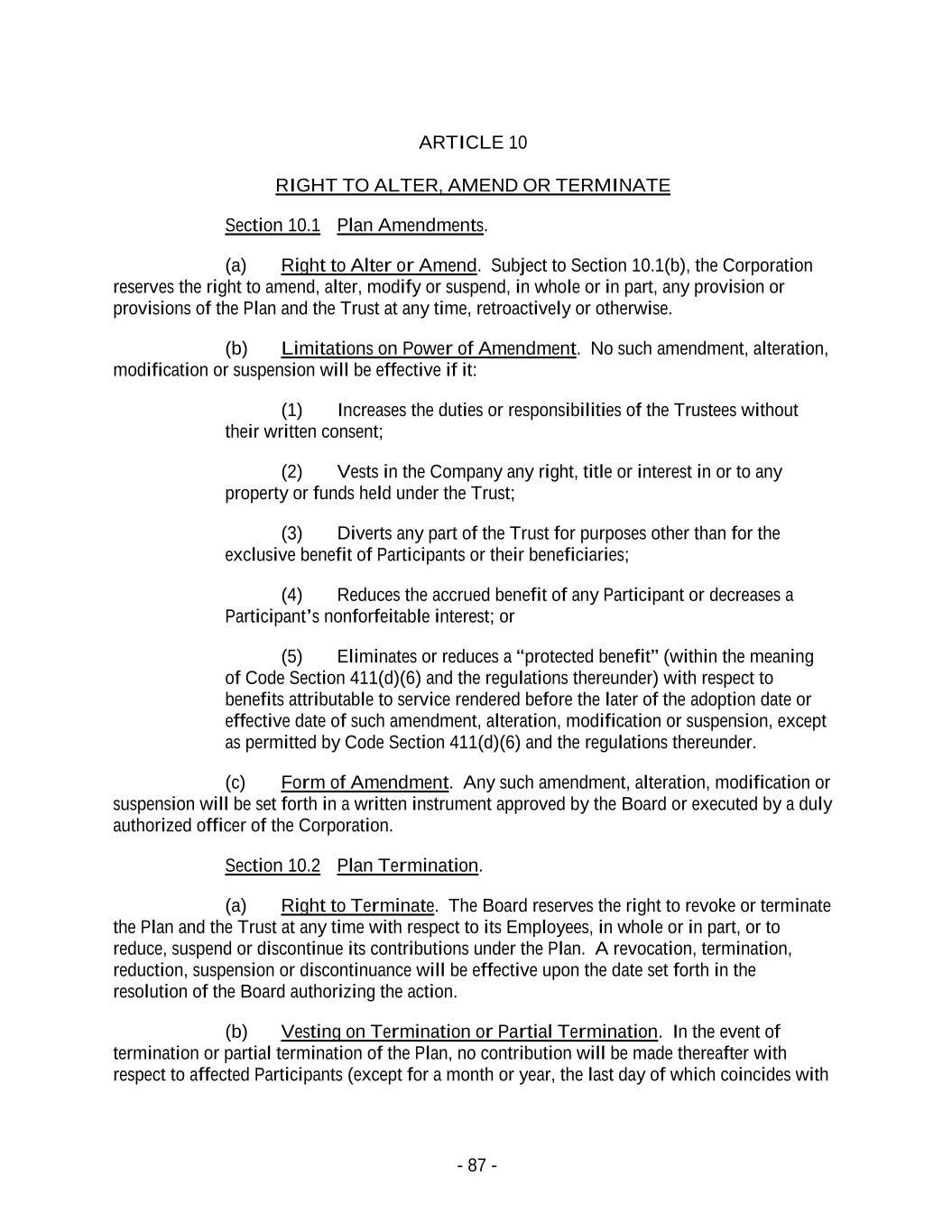
ARTICLE 10 RIGHT TO ALTER, AMEND OR TERMINATE Section 10.1 Plan Amendments. (a) Right to Alter or Amend. Subject to Section 10.1(b), the Corporation reserves the right to amend, alter, modify or suspend, in whole or in part, any provision or provisions of the Plan and the Trust at any time, retroactively or otherwise. (b) Limitations on Power of Amendment. No such amendment, alteration, modification or suspension will be effective if it: (1) Increases the duties or responsibilities of the Trustees without their written consent; (2) Vests in the Company any right, title or interest in or to any property or funds held under the Trust; (3) Diverts any part of the Trust for purposes other than for the exclusive benefit of Participants or their beneficiaries; (4) Reduces the accrued benefit of any Participant or decreases a Participant’s nonforfeitable interest; or (5) Eliminates or reduces a “protected benefit” (within the meaning of Code Section 411(d)(6) and the regulations thereunder) with respect to benefits attributable to service rendered before the later of the adoption date or effective date of such amendment, alteration, modification or suspension, except as permitted by Code Section 411(d)(6) and the regulations thereunder. (c) Form of Amendment. Any such amendment, alteration, modification or suspension will be set forth in a written instrument approved by the Board or executed by a duly authorized officer of the Corporation. Section 10.2 Plan Termination. (a) Right to Terminate. The Board reserves the right to revoke or terminate the Plan and the Trust at any time with respect to its Employees, in whole or in part, or to reduce, suspend or discontinue its contributions under the Plan. A revocation, termination, reduction, suspension or discontinuance will be effective upon the date set forth in the resolution of the Board authorizing the action. (b) Vesting on Termination or Partial Termination. In the event of termination or partial termination of the Plan, no contribution will be made thereafter with respect to affected Participants (except for a month or year, the last day of which coincides with - 87 -
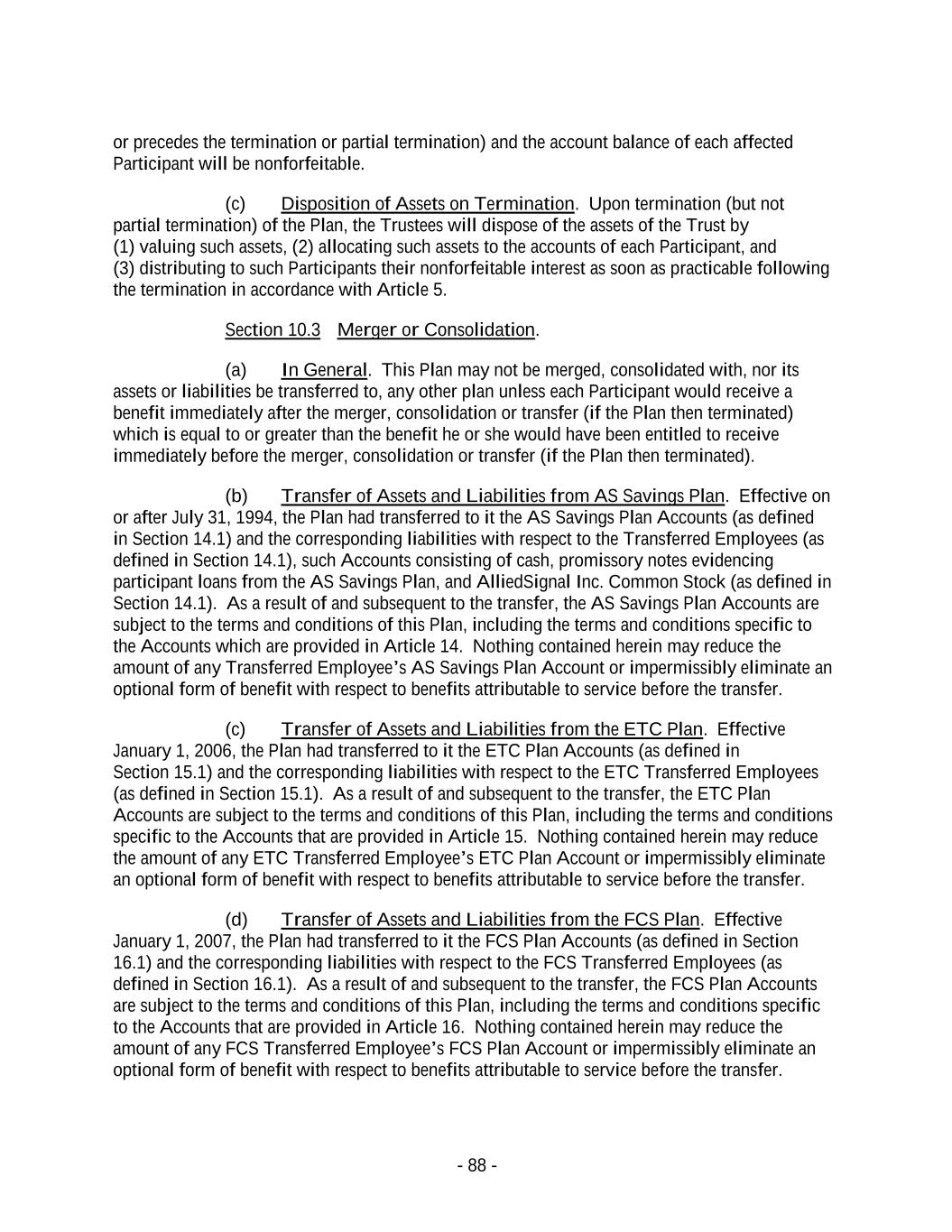
or precedes the termination or partial termination) and the account balance of each affected Participant will be nonforfeitable. (c) Disposition of Assets on Termination. Upon termination (but not partial termination) of the Plan, the Trustees will dispose of the assets of the Trust by (1) valuing such assets, (2) allocating such assets to the accounts of each Participant, and (3) distributing to such Participants their nonforfeitable interest as soon as practicable following the termination in accordance with Article 5. Section 10.3 Merger or Consolidation. (a) In General. This Plan may not be merged, consolidated with, nor its assets or liabilities be transferred to, any other plan unless each Participant would receive a benefit immediately after the merger, consolidation or transfer (if the Plan then terminated) which is equal to or greater than the benefit he or she would have been entitled to receive immediately before the merger, consolidation or transfer (if the Plan then terminated). (b) Transfer of Assets and Liabilities from AS Savings Plan. Effective on or after July 31, 1994, the Plan had transferred to it the AS Savings Plan Accounts (as defined in Section 14.1) and the corresponding liabilities with respect to the Transferred Employees (as defined in Section 14.1), such Accounts consisting of cash, promissory notes evidencing participant loans from the AS Savings Plan, and AlliedSignal Inc. Common Stock (as defined in Section 14.1). As a result of and subsequent to the transfer, the AS Savings Plan Accounts are subject to the terms and conditions of this Plan, including the terms and conditions specific to the Accounts which are provided in Article 14. Nothing contained herein may reduce the amount of any Transferred Employee’s AS Savings Plan Account or impermissibly eliminate an optional form of benefit with respect to benefits attributable to service before the transfer. (c) Transfer of Assets and Liabilities from the ETC Plan. Effective January 1, 2006, the Plan had transferred to it the ETC Plan Accounts (as defined in Section 15.1) and the corresponding liabilities with respect to the ETC Transferred Employees (as defined in Section 15.1). As a result of and subsequent to the transfer, the ETC Plan Accounts are subject to the terms and conditions of this Plan, including the terms and conditions specific to the Accounts that are provided in Article 15. Nothing contained herein may reduce the amount of any ETC Transferred Employee’s ETC Plan Account or impermissibly eliminate an optional form of benefit with respect to benefits attributable to service before the transfer. (d) Transfer of Assets and Liabilities from the FCS Plan. Effective January 1, 2007, the Plan had transferred to it the FCS Plan Accounts (as defined in Section 16.1) and the corresponding liabilities with respect to the FCS Transferred Employees (as defined in Section 16.1). As a result of and subsequent to the transfer, the FCS Plan Accounts are subject to the terms and conditions of this Plan, including the terms and conditions specific to the Accounts that are provided in Article 16. Nothing contained herein may reduce the amount of any FCS Transferred Employee’s FCS Plan Account or impermissibly eliminate an optional form of benefit with respect to benefits attributable to service before the transfer. - 88 -
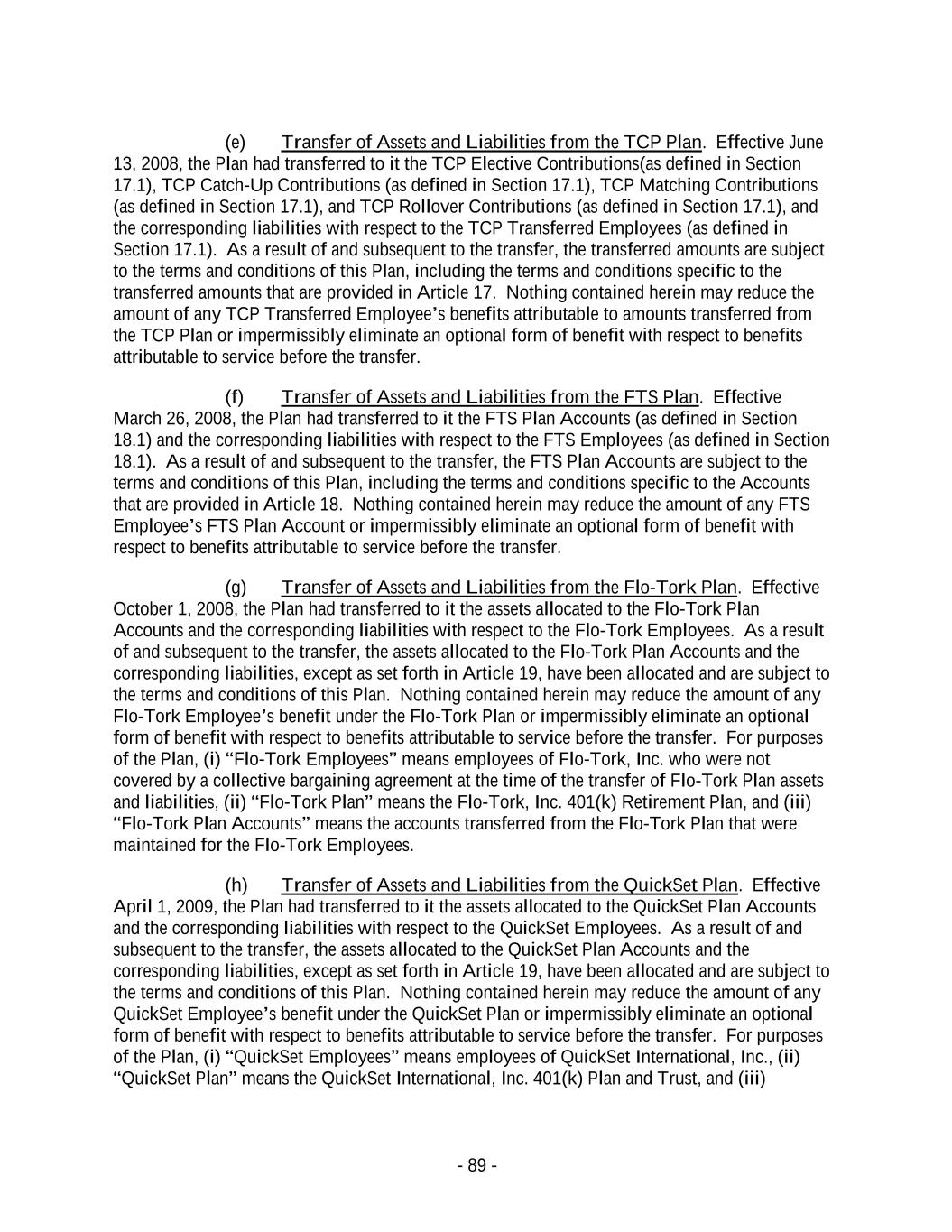
(e) Transfer of Assets and Liabilities from the TCP Plan. Effective June 13, 2008, the Plan had transferred to it the TCP Elective Contributions(as defined in Section 17.1), TCP Catch-Up Contributions (as defined in Section 17.1), TCP Matching Contributions (as defined in Section 17.1), and TCP Rollover Contributions (as defined in Section 17.1), and the corresponding liabilities with respect to the TCP Transferred Employees (as defined in Section 17.1). As a result of and subsequent to the transfer, the transferred amounts are subject to the terms and conditions of this Plan, including the terms and conditions specific to the transferred amounts that are provided in Article 17. Nothing contained herein may reduce the amount of any TCP Transferred Employee’s benefits attributable to amounts transferred from the TCP Plan or impermissibly eliminate an optional form of benefit with respect to benefits attributable to service before the transfer. (f) Transfer of Assets and Liabilities from the FTS Plan. Effective March 26, 2008, the Plan had transferred to it the FTS Plan Accounts (as defined in Section 18.1) and the corresponding liabilities with respect to the FTS Employees (as defined in Section 18.1). As a result of and subsequent to the transfer, the FTS Plan Accounts are subject to the terms and conditions of this Plan, including the terms and conditions specific to the Accounts that are provided in Article 18. Nothing contained herein may reduce the amount of any FTS Employee’s FTS Plan Account or impermissibly eliminate an optional form of benefit with respect to benefits attributable to service before the transfer. (g) Transfer of Assets and Liabilities from the Flo-Tork Plan. Effective October 1, 2008, the Plan had transferred to it the assets allocated to the Flo-Tork Plan Accounts and the corresponding liabilities with respect to the Flo-Tork Employees. As a result of and subsequent to the transfer, the assets allocated to the Flo-Tork Plan Accounts and the corresponding liabilities, except as set forth in Article 19, have been allocated and are subject to the terms and conditions of this Plan. Nothing contained herein may reduce the amount of any Flo-Tork Employee’s benefit under the Flo-Tork Plan or impermissibly eliminate an optional form of benefit with respect to benefits attributable to service before the transfer. For purposes of the Plan, (i) “Flo-Tork Employees” means employees of Flo-Tork, Inc. who were not covered by a collective bargaining agreement at the time of the transfer of Flo-Tork Plan assets and liabilities, (ii) “Flo-Tork Plan” means the Flo-Tork, Inc. 401(k) Retirement Plan, and (iii) “Flo-Tork Plan Accounts” means the accounts transferred from the Flo-Tork Plan that were maintained for the Flo-Tork Employees. (h) Transfer of Assets and Liabilities from the QuickSet Plan. Effective April 1, 2009, the Plan had transferred to it the assets allocated to the QuickSet Plan Accounts and the corresponding liabilities with respect to the QuickSet Employees. As a result of and subsequent to the transfer, the assets allocated to the QuickSet Plan Accounts and the corresponding liabilities, except as set forth in Article 19, have been allocated and are subject to the terms and conditions of this Plan. Nothing contained herein may reduce the amount of any QuickSet Employee’s benefit under the QuickSet Plan or impermissibly eliminate an optional form of benefit with respect to benefits attributable to service before the transfer. For purposes of the Plan, (i) “QuickSet Employees” means employees of QuickSet International, Inc., (ii) “QuickSet Plan” means the QuickSet International, Inc. 401(k) Plan and Trust, and (iii) - 89 -
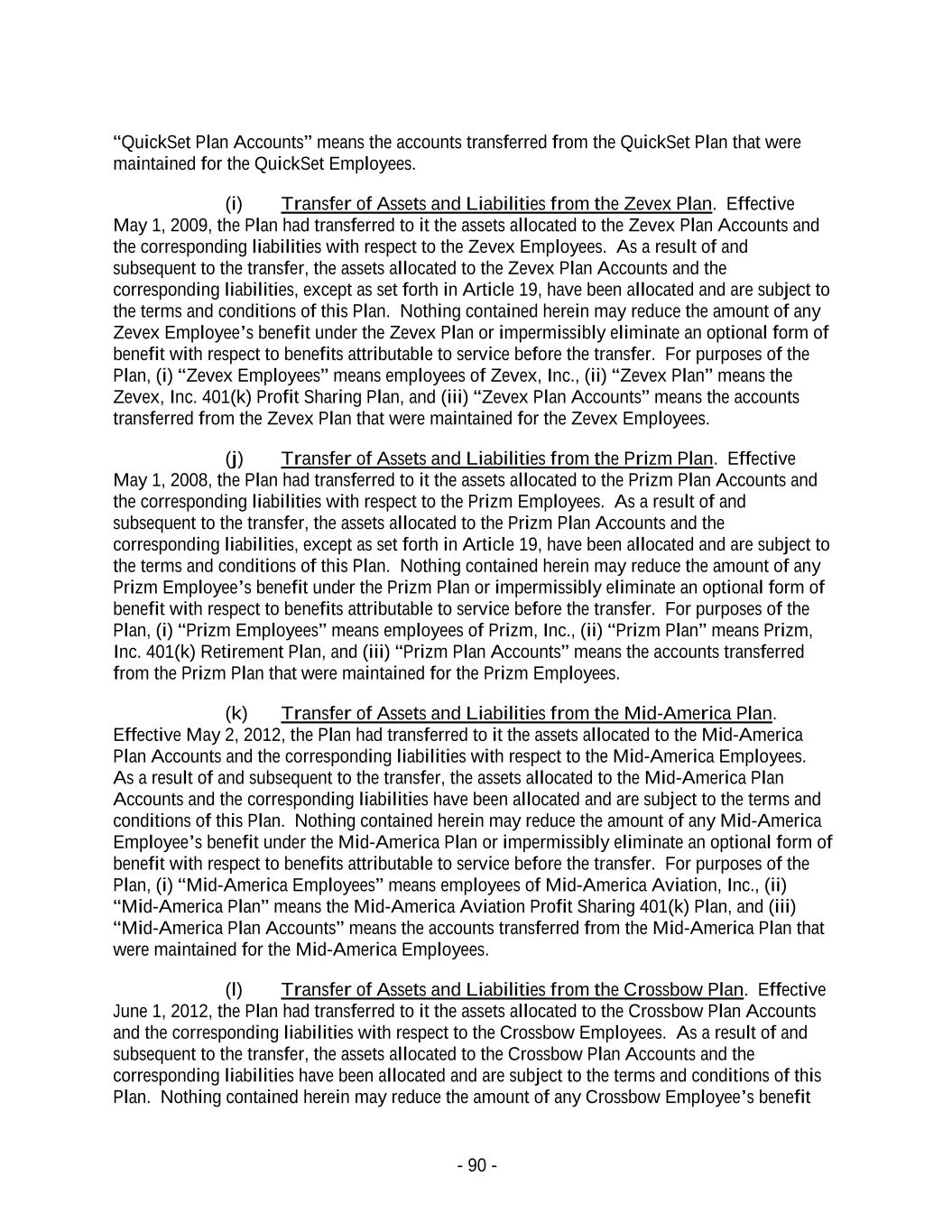
“QuickSet Plan Accounts” means the accounts transferred from the QuickSet Plan that were maintained for the QuickSet Employees. (i) Transfer of Assets and Liabilities from the Zevex Plan. Effective May 1, 2009, the Plan had transferred to it the assets allocated to the Zevex Plan Accounts and the corresponding liabilities with respect to the Zevex Employees. As a result of and subsequent to the transfer, the assets allocated to the Zevex Plan Accounts and the corresponding liabilities, except as set forth in Article 19, have been allocated and are subject to the terms and conditions of this Plan. Nothing contained herein may reduce the amount of any Zevex Employee’s benefit under the Zevex Plan or impermissibly eliminate an optional form of benefit with respect to benefits attributable to service before the transfer. For purposes of the Plan, (i) “Zevex Employees” means employees of Zevex, Inc., (ii) “Zevex Plan” means the Zevex, Inc. 401(k) Profit Sharing Plan, and (iii) “Zevex Plan Accounts” means the accounts transferred from the Zevex Plan that were maintained for the Zevex Employees. (j) Transfer of Assets and Liabilities from the Prizm Plan. Effective May 1, 2008, the Plan had transferred to it the assets allocated to the Prizm Plan Accounts and the corresponding liabilities with respect to the Prizm Employees. As a result of and subsequent to the transfer, the assets allocated to the Prizm Plan Accounts and the corresponding liabilities, except as set forth in Article 19, have been allocated and are subject to the terms and conditions of this Plan. Nothing contained herein may reduce the amount of any Prizm Employee’s benefit under the Prizm Plan or impermissibly eliminate an optional form of benefit with respect to benefits attributable to service before the transfer. For purposes of the Plan, (i) “Prizm Employees” means employees of Prizm, Inc., (ii) “Prizm Plan” means Prizm, Inc. 401(k) Retirement Plan, and (iii) “Prizm Plan Accounts” means the accounts transferred from the Prizm Plan that were maintained for the Prizm Employees. (k) Transfer of Assets and Liabilities from the Mid-America Plan. Effective May 2, 2012, the Plan had transferred to it the assets allocated to the Mid-America Plan Accounts and the corresponding liabilities with respect to the Mid-America Employees. As a result of and subsequent to the transfer, the assets allocated to the Mid-America Plan Accounts and the corresponding liabilities have been allocated and are subject to the terms and conditions of this Plan. Nothing contained herein may reduce the amount of any Mid-America Employee’s benefit under the Mid-America Plan or impermissibly eliminate an optional form of benefit with respect to benefits attributable to service before the transfer. For purposes of the Plan, (i) “Mid-America Employees” means employees of Mid-America Aviation, Inc., (ii) “Mid-America Plan” means the Mid-America Aviation Profit Sharing 401(k) Plan, and (iii) “Mid-America Plan Accounts” means the accounts transferred from the Mid-America Plan that were maintained for the Mid-America Employees. (l) Transfer of Assets and Liabilities from the Crossbow Plan. Effective June 1, 2012, the Plan had transferred to it the assets allocated to the Crossbow Plan Accounts and the corresponding liabilities with respect to the Crossbow Employees. As a result of and subsequent to the transfer, the assets allocated to the Crossbow Plan Accounts and the corresponding liabilities have been allocated and are subject to the terms and conditions of this Plan. Nothing contained herein may reduce the amount of any Crossbow Employee’s benefit - 90 -
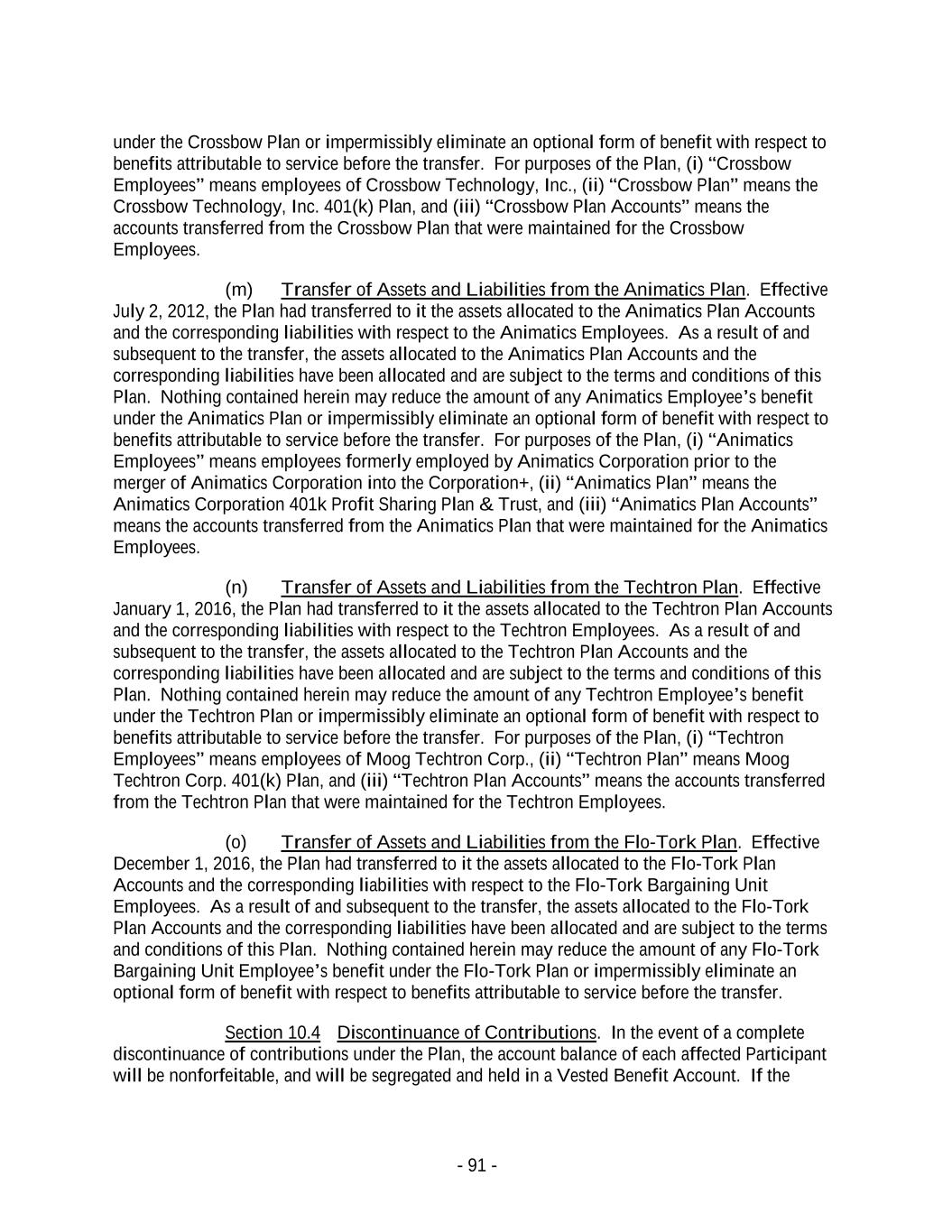
under the Crossbow Plan or impermissibly eliminate an optional form of benefit with respect to benefits attributable to service before the transfer. For purposes of the Plan, (i) “Crossbow Employees” means employees of Crossbow Technology, Inc., (ii) “Crossbow Plan” means the Crossbow Technology, Inc. 401(k) Plan, and (iii) “Crossbow Plan Accounts” means the accounts transferred from the Crossbow Plan that were maintained for the Crossbow Employees. (m) Transfer of Assets and Liabilities from the Animatics Plan. Effective July 2, 2012, the Plan had transferred to it the assets allocated to the Animatics Plan Accounts and the corresponding liabilities with respect to the Animatics Employees. As a result of and subsequent to the transfer, the assets allocated to the Animatics Plan Accounts and the corresponding liabilities have been allocated and are subject to the terms and conditions of this Plan. Nothing contained herein may reduce the amount of any Animatics Employee’s benefit under the Animatics Plan or impermissibly eliminate an optional form of benefit with respect to benefits attributable to service before the transfer. For purposes of the Plan, (i) “Animatics Employees” means employees formerly employed by Animatics Corporation prior to the merger of Animatics Corporation into the Corporation+, (ii) “Animatics Plan” means the Animatics Corporation 401k Profit Sharing Plan & Trust, and (iii) “Animatics Plan Accounts” means the accounts transferred from the Animatics Plan that were maintained for the Animatics Employees. (n) Transfer of Assets and Liabilities from the Techtron Plan. Effective January 1, 2016, the Plan had transferred to it the assets allocated to the Techtron Plan Accounts and the corresponding liabilities with respect to the Techtron Employees. As a result of and subsequent to the transfer, the assets allocated to the Techtron Plan Accounts and the corresponding liabilities have been allocated and are subject to the terms and conditions of this Plan. Nothing contained herein may reduce the amount of any Techtron Employee’s benefit under the Techtron Plan or impermissibly eliminate an optional form of benefit with respect to benefits attributable to service before the transfer. For purposes of the Plan, (i) “Techtron Employees” means employees of Moog Techtron Corp., (ii) “Techtron Plan” means Moog Techtron Corp. 401(k) Plan, and (iii) “Techtron Plan Accounts” means the accounts transferred from the Techtron Plan that were maintained for the Techtron Employees. (o) Transfer of Assets and Liabilities from the Flo-Tork Plan. Effective December 1, 2016, the Plan had transferred to it the assets allocated to the Flo-Tork Plan Accounts and the corresponding liabilities with respect to the Flo-Tork Bargaining Unit Employees. As a result of and subsequent to the transfer, the assets allocated to the Flo-Tork Plan Accounts and the corresponding liabilities have been allocated and are subject to the terms and conditions of this Plan. Nothing contained herein may reduce the amount of any Flo-Tork Bargaining Unit Employee’s benefit under the Flo-Tork Plan or impermissibly eliminate an optional form of benefit with respect to benefits attributable to service before the transfer. Section 10.4 Discontinuance of Contributions. In the event of a complete discontinuance of contributions under the Plan, the account balance of each affected Participant will be nonforfeitable, and will be segregated and held in a Vested Benefit Account. If the - 91 -

Company resumes contributions thereafter, any Company contributions or forfeitures allocated to a Participant will be credited to new accounts. - 92 -
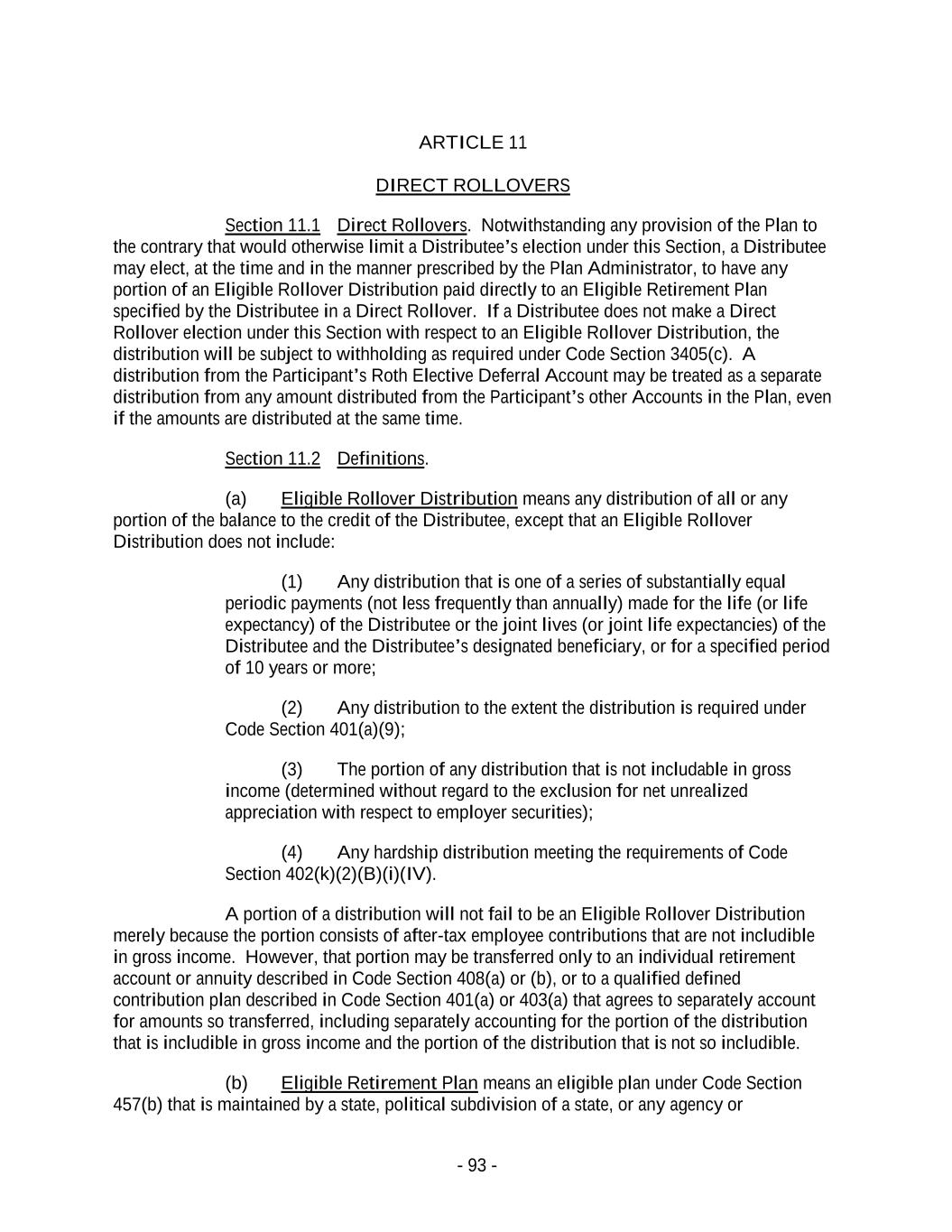
ARTICLE 11 DIRECT ROLLOVERS Section 11.1 Direct Rollovers. Notwithstanding any provision of the Plan to the contrary that would otherwise limit a Distributee’s election under this Section, a Distributee may elect, at the time and in the manner prescribed by the Plan Administrator, to have any portion of an Eligible Rollover Distribution paid directly to an Eligible Retirement Plan specified by the Distributee in a Direct Rollover. If a Distributee does not make a Direct Rollover election under this Section with respect to an Eligible Rollover Distribution, the distribution will be subject to withholding as required under Code Section 3405(c). A distribution from the Participant’s Roth Elective Deferral Account may be treated as a separate distribution from any amount distributed from the Participant’s other Accounts in the Plan, even if the amounts are distributed at the same time. Section 11.2 Definitions. (a) Eligible Rollover Distribution means any distribution of all or any portion of the balance to the credit of the Distributee, except that an Eligible Rollover Distribution does not include: (1) Any distribution that is one of a series of substantially equal periodic payments (not less frequently than annually) made for the life (or life expectancy) of the Distributee or the joint lives (or joint life expectancies) of the Distributee and the Distributee’s designated beneficiary, or for a specified period of 10 years or more; (2) Any distribution to the extent the distribution is required under Code Section 401(a)(9); (3) The portion of any distribution that is not includable in gross income (determined without regard to the exclusion for net unrealized appreciation with respect to employer securities); (4) Any hardship distribution meeting the requirements of Code Section 402(k)(2)(B)(i)(IV). A portion of a distribution will not fail to be an Eligible Rollover Distribution merely because the portion consists of after-tax employee contributions that are not includible in gross income. However, that portion may be transferred only to an individual retirement account or annuity described in Code Section 408(a) or (b), or to a qualified defined contribution plan described in Code Section 401(a) or 403(a) that agrees to separately account for amounts so transferred, including separately accounting for the portion of the distribution that is includible in gross income and the portion of the distribution that is not so includible. (b) Eligible Retirement Plan means an eligible plan under Code Section 457(b) that is maintained by a state, political subdivision of a state, or any agency or - 93 -
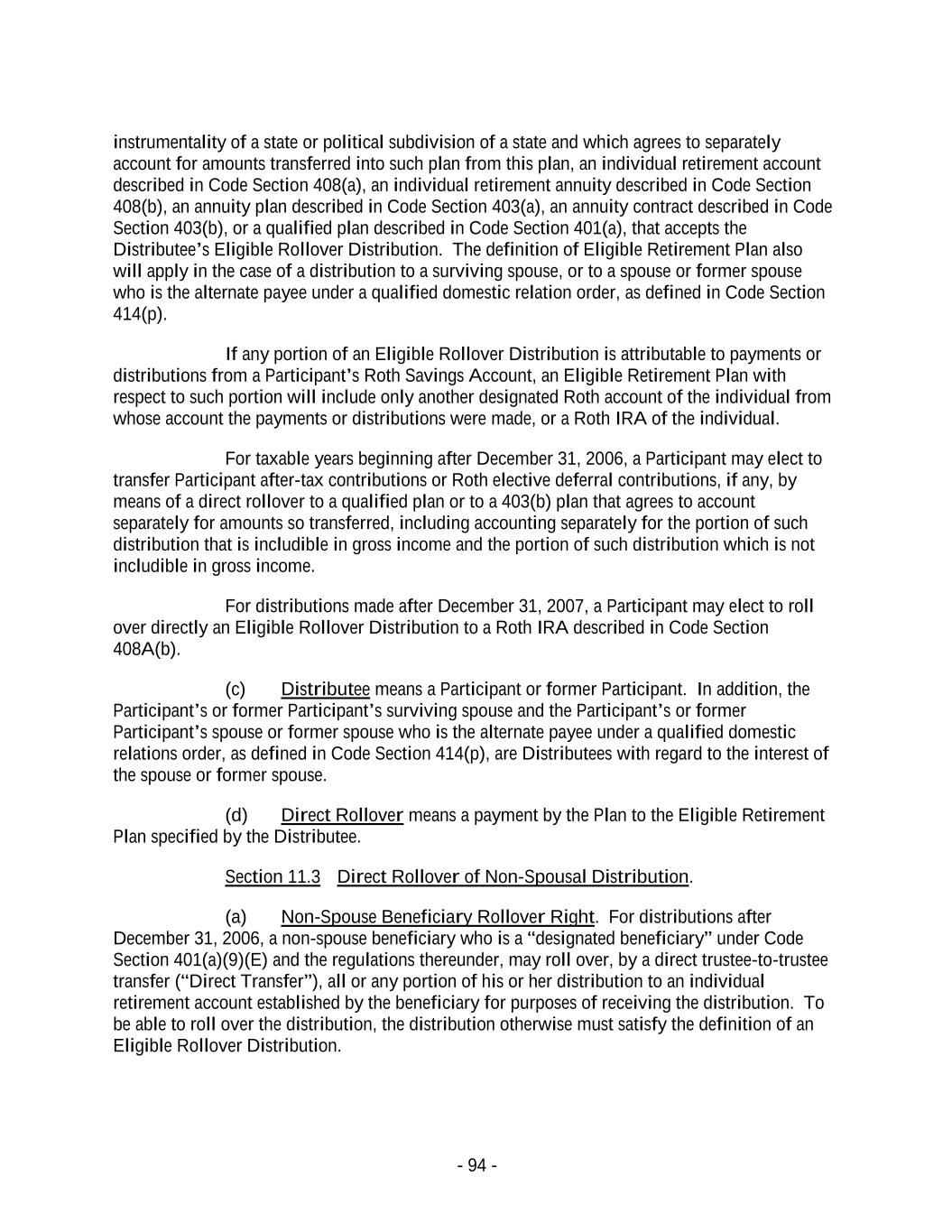
instrumentality of a state or political subdivision of a state and which agrees to separately account for amounts transferred into such plan from this plan, an individual retirement account described in Code Section 408(a), an individual retirement annuity described in Code Section 408(b), an annuity plan described in Code Section 403(a), an annuity contract described in Code Section 403(b), or a qualified plan described in Code Section 401(a), that accepts the Distributee’s Eligible Rollover Distribution. The definition of Eligible Retirement Plan also will apply in the case of a distribution to a surviving spouse, or to a spouse or former spouse who is the alternate payee under a qualified domestic relation order, as defined in Code Section 414(p). If any portion of an Eligible Rollover Distribution is attributable to payments or distributions from a Participant’s Roth Savings Account, an Eligible Retirement Plan with respect to such portion will include only another designated Roth account of the individual from whose account the payments or distributions were made, or a Roth IRA of the individual. For taxable years beginning after December 31, 2006, a Participant may elect to transfer Participant after-tax contributions or Roth elective deferral contributions, if any, by means of a direct rollover to a qualified plan or to a 403(b) plan that agrees to account separately for amounts so transferred, including accounting separately for the portion of such distribution that is includible in gross income and the portion of such distribution which is not includible in gross income. For distributions made after December 31, 2007, a Participant may elect to roll over directly an Eligible Rollover Distribution to a Roth IRA described in Code Section 408A(b). (c) Distributee means a Participant or former Participant. In addition, the Participant’s or former Participant’s surviving spouse and the Participant’s or former Participant’s spouse or former spouse who is the alternate payee under a qualified domestic relations order, as defined in Code Section 414(p), are Distributees with regard to the interest of the spouse or former spouse. (d) Direct Rollover means a payment by the Plan to the Eligible Retirement Plan specified by the Distributee. Section 11.3 Direct Rollover of Non-Spousal Distribution. (a) Non-Spouse Beneficiary Rollover Right. For distributions after December 31, 2006, a non-spouse beneficiary who is a “designated beneficiary” under Code Section 401(a)(9)(E) and the regulations thereunder, may roll over, by a direct trustee-to-trustee transfer (“Direct Transfer”), all or any portion of his or her distribution to an individual retirement account established by the beneficiary for purposes of receiving the distribution. To be able to roll over the distribution, the distribution otherwise must satisfy the definition of an Eligible Rollover Distribution. - 94 -
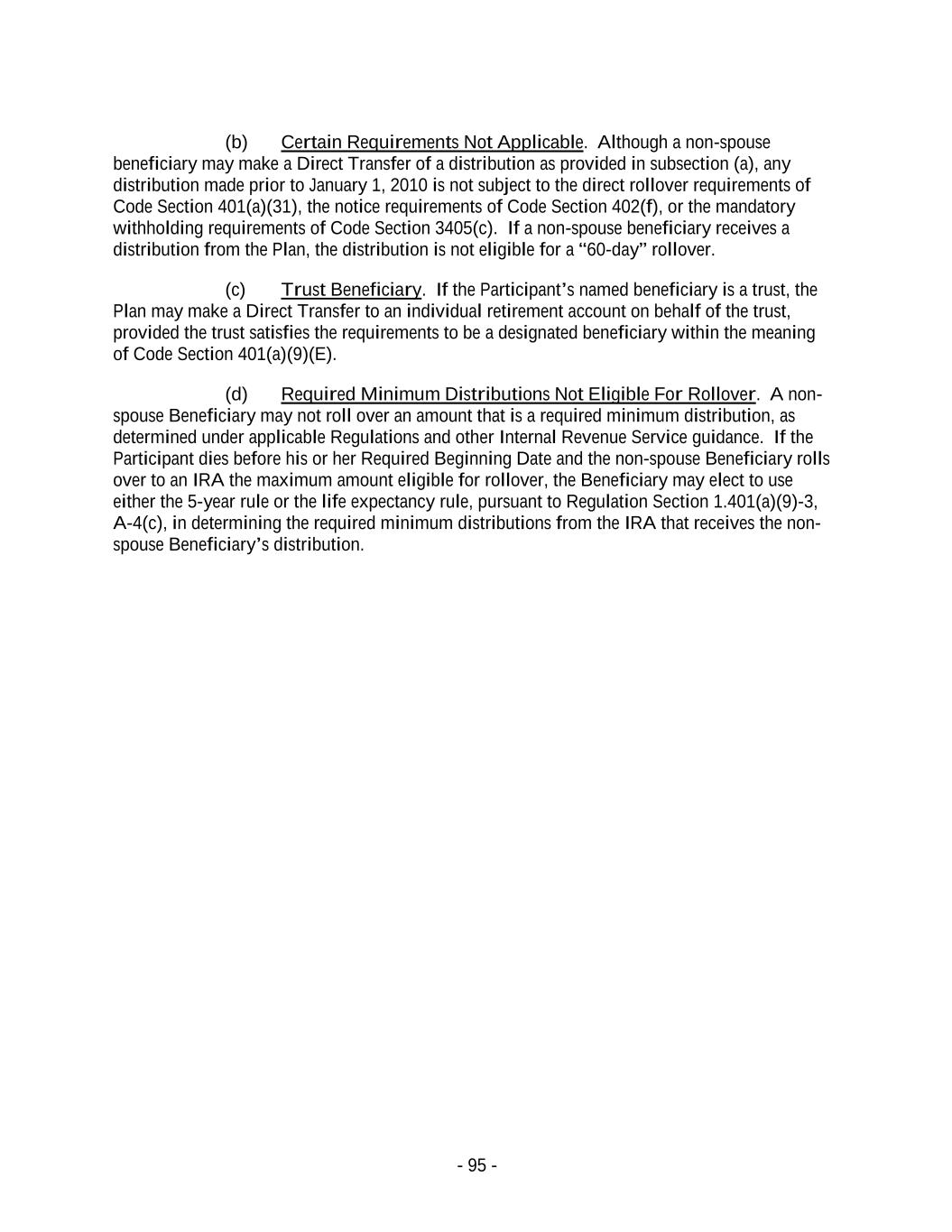
(b) Certain Requirements Not Applicable. Although a non-spouse beneficiary may make a Direct Transfer of a distribution as provided in subsection (a), any distribution made prior to January 1, 2010 is not subject to the direct rollover requirements of Code Section 401(a)(31), the notice requirements of Code Section 402(f), or the mandatory withholding requirements of Code Section 3405(c). If a non-spouse beneficiary receives a distribution from the Plan, the distribution is not eligible for a “60-day” rollover. (c) Trust Beneficiary. If the Participant’s named beneficiary is a trust, the Plan may make a Direct Transfer to an individual retirement account on behalf of the trust, provided the trust satisfies the requirements to be a designated beneficiary within the meaning of Code Section 401(a)(9)(E). (d) Required Minimum Distributions Not Eligible For Rollover. A non- spouse Beneficiary may not roll over an amount that is a required minimum distribution, as determined under applicable Regulations and other Internal Revenue Service guidance. If the Participant dies before his or her Required Beginning Date and the non-spouse Beneficiary rolls over to an IRA the maximum amount eligible for rollover, the Beneficiary may elect to use either the 5-year rule or the life expectancy rule, pursuant to Regulation Section 1.401(a)(9)-3, A-4(c), in determining the required minimum distributions from the IRA that receives the non- spouse Beneficiary’s distribution. - 95 -
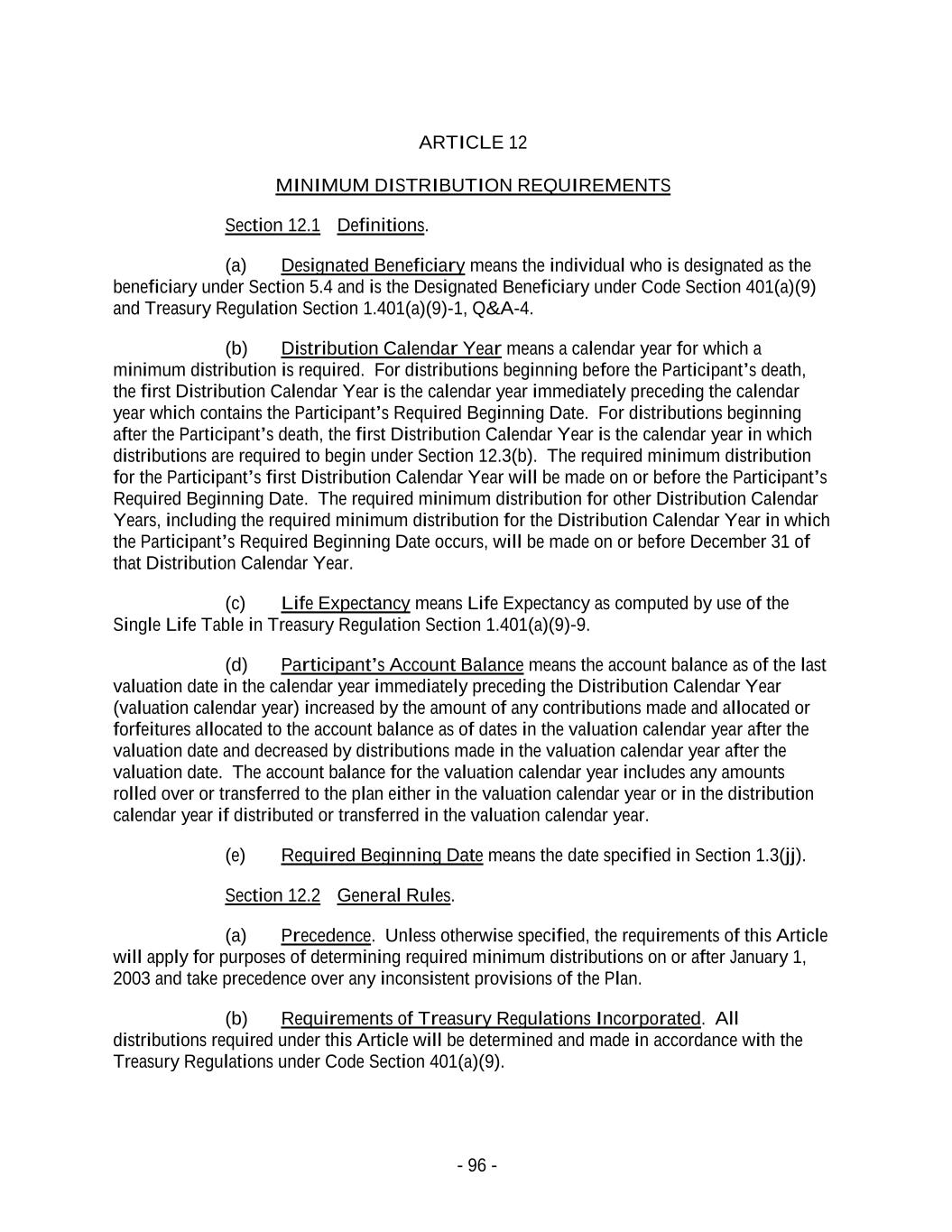
ARTICLE 12 MINIMUM DISTRIBUTION REQUIREMENTS Section 12.1 Definitions. (a) Designated Beneficiary means the individual who is designated as the beneficiary under Section 5.4 and is the Designated Beneficiary under Code Section 401(a)(9) and Treasury Regulation Section 1.401(a)(9)-1, Q&A-4. (b) Distribution Calendar Year means a calendar year for which a minimum distribution is required. For distributions beginning before the Participant’s death, the first Distribution Calendar Year is the calendar year immediately preceding the calendar year which contains the Participant’s Required Beginning Date. For distributions beginning after the Participant’s death, the first Distribution Calendar Year is the calendar year in which distributions are required to begin under Section 12.3(b). The required minimum distribution for the Participant’s first Distribution Calendar Year will be made on or before the Participant’s Required Beginning Date. The required minimum distribution for other Distribution Calendar Years, including the required minimum distribution for the Distribution Calendar Year in which the Participant’s Required Beginning Date occurs, will be made on or before December 31 of that Distribution Calendar Year. (c) Life Expectancy means Life Expectancy as computed by use of the Single Life Table in Treasury Regulation Section 1.401(a)(9)-9. (d) Participant’s Account Balance means the account balance as of the last valuation date in the calendar year immediately preceding the Distribution Calendar Year (valuation calendar year) increased by the amount of any contributions made and allocated or forfeitures allocated to the account balance as of dates in the valuation calendar year after the valuation date and decreased by distributions made in the valuation calendar year after the valuation date. The account balance for the valuation calendar year includes any amounts rolled over or transferred to the plan either in the valuation calendar year or in the distribution calendar year if distributed or transferred in the valuation calendar year. (e) Required Beginning Date means the date specified in Section 1.3(jj). Section 12.2 General Rules. (a) Precedence. Unless otherwise specified, the requirements of this Article will apply for purposes of determining required minimum distributions on or after January 1, 2003 and take precedence over any inconsistent provisions of the Plan. (b) Requirements of Treasury Regulations Incorporated. All distributions required under this Article will be determined and made in accordance with the Treasury Regulations under Code Section 401(a)(9). - 96 -
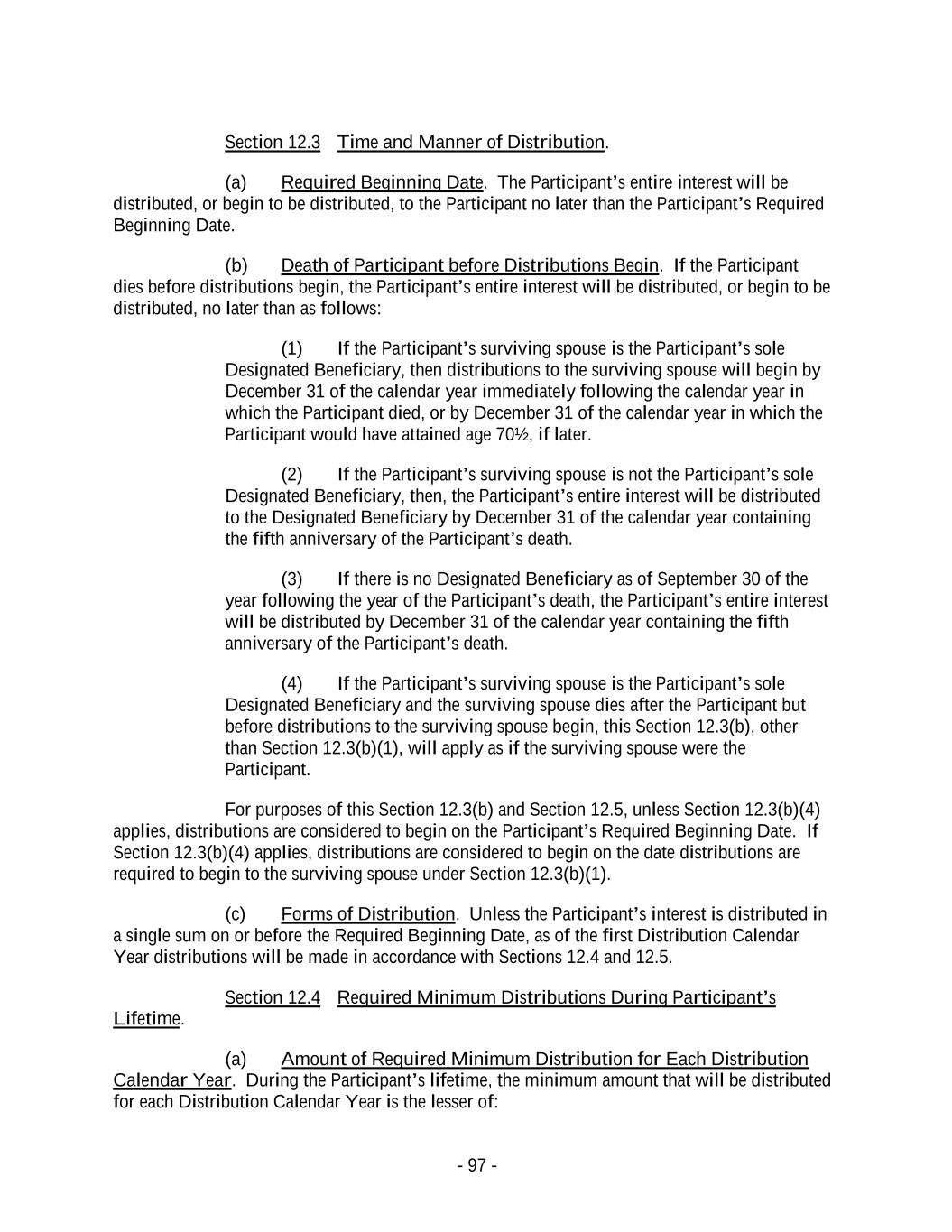
Section 12.3 Time and Manner of Distribution. (a) Required Beginning Date. The Participant’s entire interest will be distributed, or begin to be distributed, to the Participant no later than the Participant’s Required Beginning Date. (b) Death of Participant before Distributions Begin. If the Participant dies before distributions begin, the Participant’s entire interest will be distributed, or begin to be distributed, no later than as follows: (1) If the Participant’s surviving spouse is the Participant’s sole Designated Beneficiary, then distributions to the surviving spouse will begin by December 31 of the calendar year immediately following the calendar year in which the Participant died, or by December 31 of the calendar year in which the Participant would have attained age 70½, if later. (2) If the Participant’s surviving spouse is not the Participant’s sole Designated Beneficiary, then, the Participant’s entire interest will be distributed to the Designated Beneficiary by December 31 of the calendar year containing the fifth anniversary of the Participant’s death. (3) If there is no Designated Beneficiary as of September 30 of the year following the year of the Participant’s death, the Participant’s entire interest will be distributed by December 31 of the calendar year containing the fifth anniversary of the Participant’s death. (4) If the Participant’s surviving spouse is the Participant’s sole Designated Beneficiary and the surviving spouse dies after the Participant but before distributions to the surviving spouse begin, this Section 12.3(b), other than Section 12.3(b)(1), will apply as if the surviving spouse were the Participant. For purposes of this Section 12.3(b) and Section 12.5, unless Section 12.3(b)(4) applies, distributions are considered to begin on the Participant’s Required Beginning Date. If Section 12.3(b)(4) applies, distributions are considered to begin on the date distributions are required to begin to the surviving spouse under Section 12.3(b)(1). (c) Forms of Distribution. Unless the Participant’s interest is distributed in a single sum on or before the Required Beginning Date, as of the first Distribution Calendar Year distributions will be made in accordance with Sections 12.4 and 12.5. Section 12.4 Required Minimum Distributions During Participant’s Lifetime. (a) Amount of Required Minimum Distribution for Each Distribution Calendar Year. During the Participant’s lifetime, the minimum amount that will be distributed for each Distribution Calendar Year is the lesser of: - 97 -
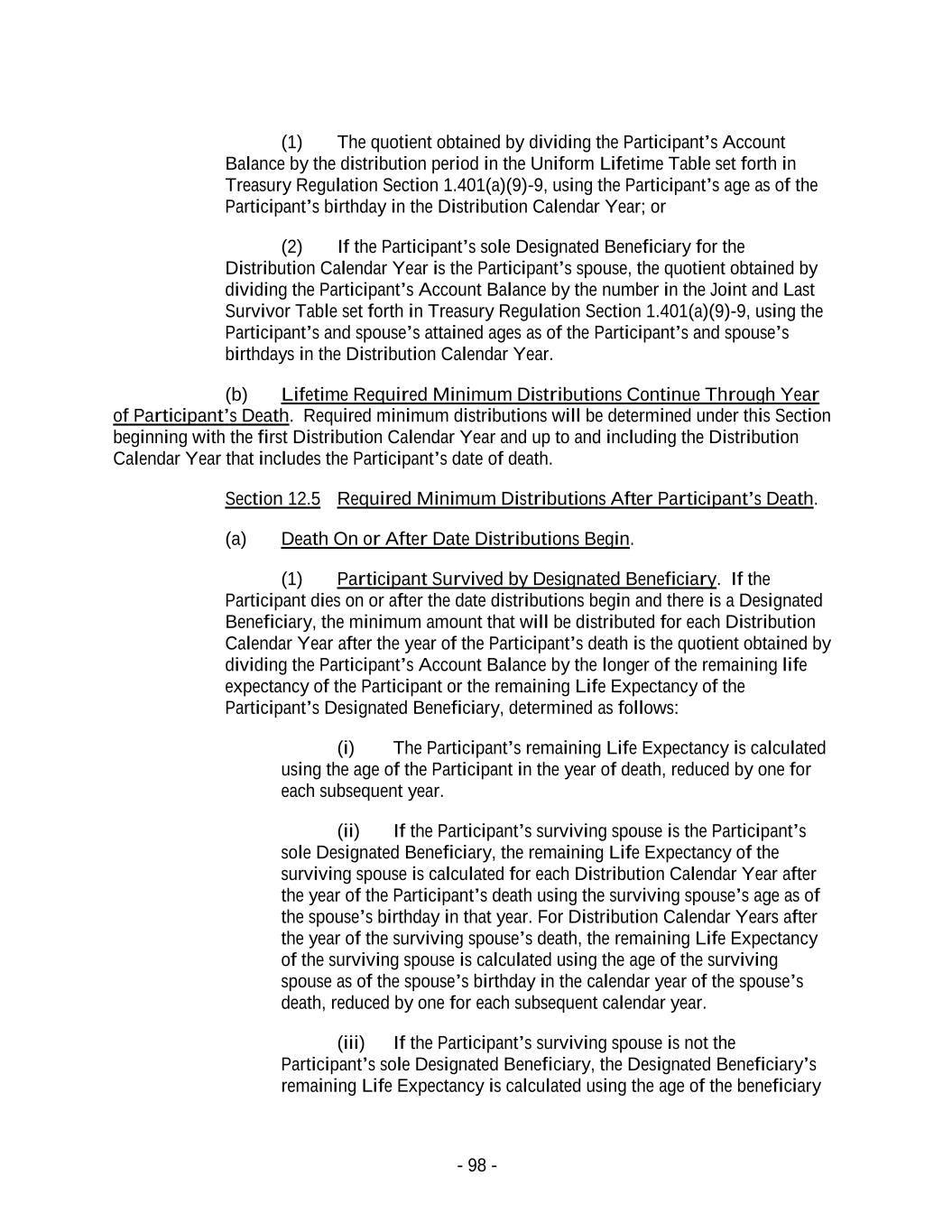
(1) The quotient obtained by dividing the Participant’s Account Balance by the distribution period in the Uniform Lifetime Table set forth in Treasury Regulation Section 1.401(a)(9)-9, using the Participant’s age as of the Participant’s birthday in the Distribution Calendar Year; or (2) If the Participant’s sole Designated Beneficiary for the Distribution Calendar Year is the Participant’s spouse, the quotient obtained by dividing the Participant’s Account Balance by the number in the Joint and Last Survivor Table set forth in Treasury Regulation Section 1.401(a)(9)-9, using the Participant’s and spouse’s attained ages as of the Participant’s and spouse’s birthdays in the Distribution Calendar Year. (b) Lifetime Required Minimum Distributions Continue Through Year of Participant’s Death. Required minimum distributions will be determined under this Section beginning with the first Distribution Calendar Year and up to and including the Distribution Calendar Year that includes the Participant’s date of death. Section 12.5 Required Minimum Distributions After Participant’s Death. (a) Death On or After Date Distributions Begin. (1) Participant Survived by Designated Beneficiary. If the Participant dies on or after the date distributions begin and there is a Designated Beneficiary, the minimum amount that will be distributed for each Distribution Calendar Year after the year of the Participant’s death is the quotient obtained by dividing the Participant’s Account Balance by the longer of the remaining life expectancy of the Participant or the remaining Life Expectancy of the Participant’s Designated Beneficiary, determined as follows: (i) The Participant’s remaining Life Expectancy is calculated using the age of the Participant in the year of death, reduced by one for each subsequent year. (ii) If the Participant’s surviving spouse is the Participant’s sole Designated Beneficiary, the remaining Life Expectancy of the surviving spouse is calculated for each Distribution Calendar Year after the year of the Participant’s death using the surviving spouse’s age as of the spouse’s birthday in that year. For Distribution Calendar Years after the year of the surviving spouse’s death, the remaining Life Expectancy of the surviving spouse is calculated using the age of the surviving spouse as of the spouse’s birthday in the calendar year of the spouse’s death, reduced by one for each subsequent calendar year. (iii) If the Participant’s surviving spouse is not the Participant’s sole Designated Beneficiary, the Designated Beneficiary’s remaining Life Expectancy is calculated using the age of the beneficiary - 98 -
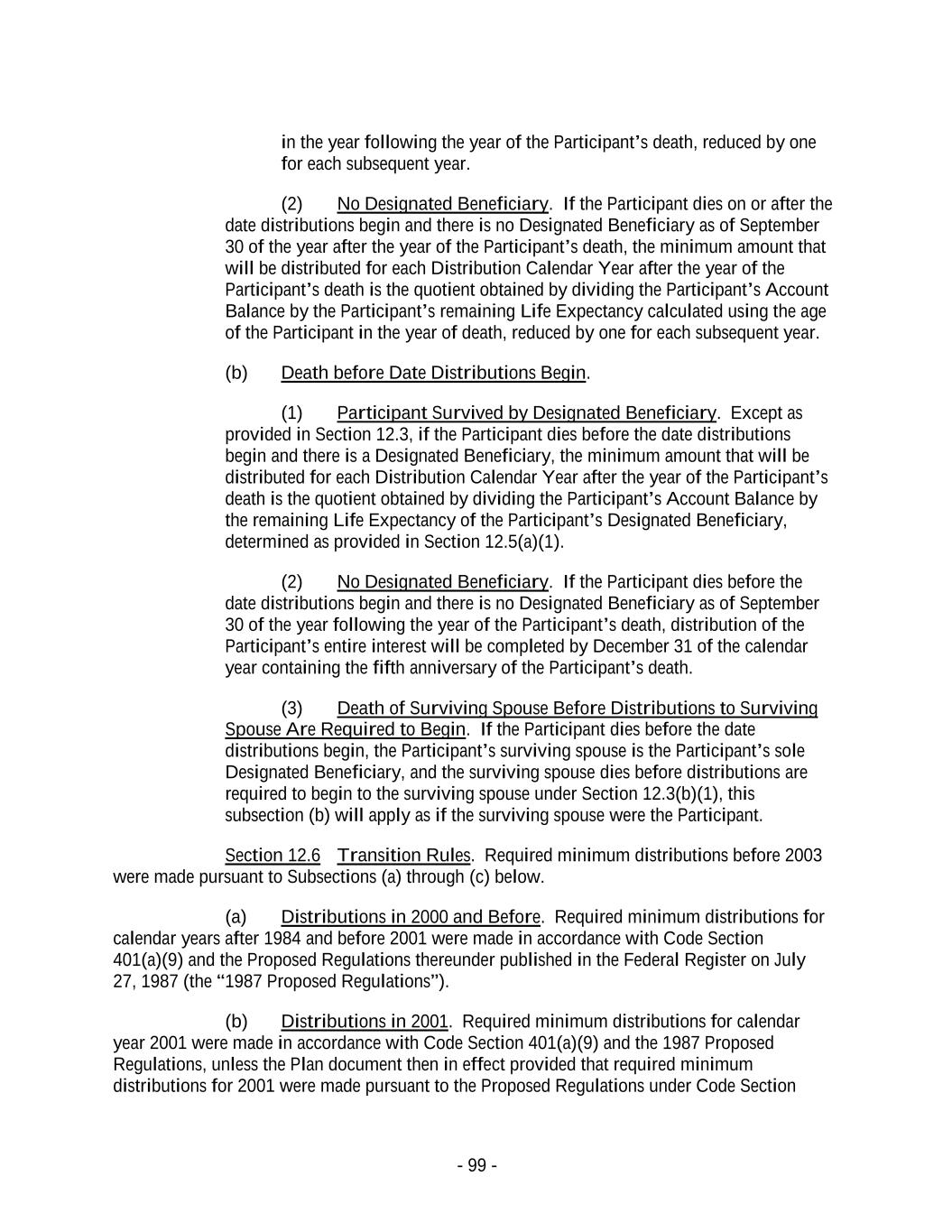
in the year following the year of the Participant’s death, reduced by one for each subsequent year. (2) No Designated Beneficiary. If the Participant dies on or after the date distributions begin and there is no Designated Beneficiary as of September 30 of the year after the year of the Participant’s death, the minimum amount that will be distributed for each Distribution Calendar Year after the year of the Participant’s death is the quotient obtained by dividing the Participant’s Account Balance by the Participant’s remaining Life Expectancy calculated using the age of the Participant in the year of death, reduced by one for each subsequent year. (b) Death before Date Distributions Begin. (1) Participant Survived by Designated Beneficiary. Except as provided in Section 12.3, if the Participant dies before the date distributions begin and there is a Designated Beneficiary, the minimum amount that will be distributed for each Distribution Calendar Year after the year of the Participant’s death is the quotient obtained by dividing the Participant’s Account Balance by the remaining Life Expectancy of the Participant’s Designated Beneficiary, determined as provided in Section 12.5(a)(1). (2) No Designated Beneficiary. If the Participant dies before the date distributions begin and there is no Designated Beneficiary as of September 30 of the year following the year of the Participant’s death, distribution of the Participant’s entire interest will be completed by December 31 of the calendar year containing the fifth anniversary of the Participant’s death. (3) Death of Surviving Spouse Before Distributions to Surviving Spouse Are Required to Begin. If the Participant dies before the date distributions begin, the Participant’s surviving spouse is the Participant’s sole Designated Beneficiary, and the surviving spouse dies before distributions are required to begin to the surviving spouse under Section 12.3(b)(1), this subsection (b) will apply as if the surviving spouse were the Participant. Section 12.6 Transition Rules. Required minimum distributions before 2003 were made pursuant to Subsections (a) through (c) below. (a) Distributions in 2000 and Before. Required minimum distributions for calendar years after 1984 and before 2001 were made in accordance with Code Section 401(a)(9) and the Proposed Regulations thereunder published in the Federal Register on July 27, 1987 (the “1987 Proposed Regulations”). (b) Distributions in 2001. Required minimum distributions for calendar year 2001 were made in accordance with Code Section 401(a)(9) and the 1987 Proposed Regulations, unless the Plan document then in effect provided that required minimum distributions for 2001 were made pursuant to the Proposed Regulations under Code Section - 99 -
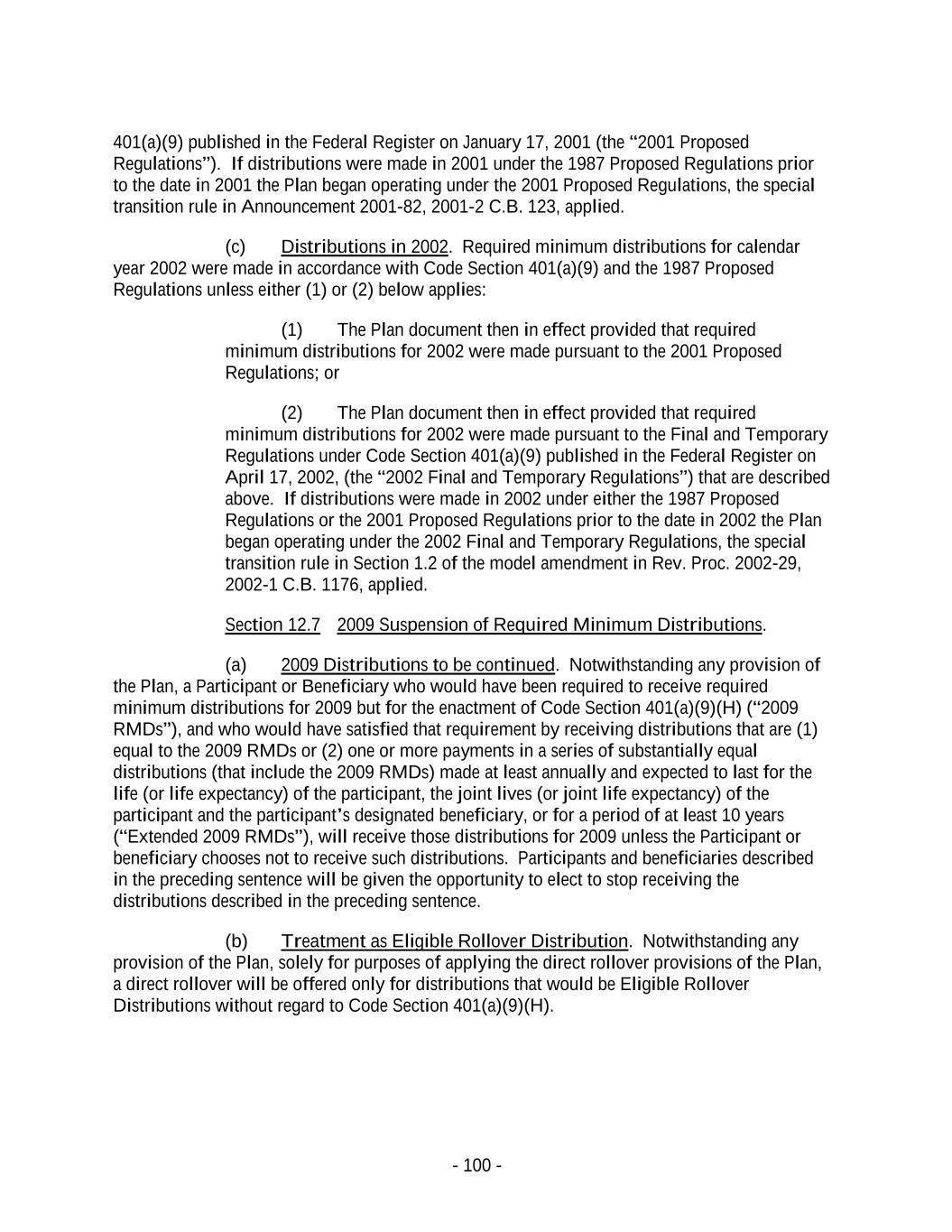
401(a)(9) published in the Federal Register on January 17, 2001 (the “2001 Proposed Regulations”). If distributions were made in 2001 under the 1987 Proposed Regulations prior to the date in 2001 the Plan began operating under the 2001 Proposed Regulations, the special transition rule in Announcement 2001-82, 2001-2 C.B. 123, applied. (c) Distributions in 2002. Required minimum distributions for calendar year 2002 were made in accordance with Code Section 401(a)(9) and the 1987 Proposed Regulations unless either (1) or (2) below applies: (1) The Plan document then in effect provided that required minimum distributions for 2002 were made pursuant to the 2001 Proposed Regulations; or (2) The Plan document then in effect provided that required minimum distributions for 2002 were made pursuant to the Final and Temporary Regulations under Code Section 401(a)(9) published in the Federal Register on April 17, 2002, (the “2002 Final and Temporary Regulations”) that are described above. If distributions were made in 2002 under either the 1987 Proposed Regulations or the 2001 Proposed Regulations prior to the date in 2002 the Plan began operating under the 2002 Final and Temporary Regulations, the special transition rule in Section 1.2 of the model amendment in Rev. Proc. 2002-29, 2002-1 C.B. 1176, applied. Section 12.7 2009 Suspension of Required Minimum Distributions. (a) 2009 Distributions to be continued. Notwithstanding any provision of the Plan, a Participant or Beneficiary who would have been required to receive required minimum distributions for 2009 but for the enactment of Code Section 401(a)(9)(H) (“2009 RMDs”), and who would have satisfied that requirement by receiving distributions that are (1) equal to the 2009 RMDs or (2) one or more payments in a series of substantially equal distributions (that include the 2009 RMDs) made at least annually and expected to last for the life (or life expectancy) of the participant, the joint lives (or joint life expectancy) of the participant and the participant’s designated beneficiary, or for a period of at least 10 years (“Extended 2009 RMDs”), will receive those distributions for 2009 unless the Participant or beneficiary chooses not to receive such distributions. Participants and beneficiaries described in the preceding sentence will be given the opportunity to elect to stop receiving the distributions described in the preceding sentence. (b) Treatment as Eligible Rollover Distribution. Notwithstanding any provision of the Plan, solely for purposes of applying the direct rollover provisions of the Plan, a direct rollover will be offered only for distributions that would be Eligible Rollover Distributions without regard to Code Section 401(a)(9)(H). - 100 -
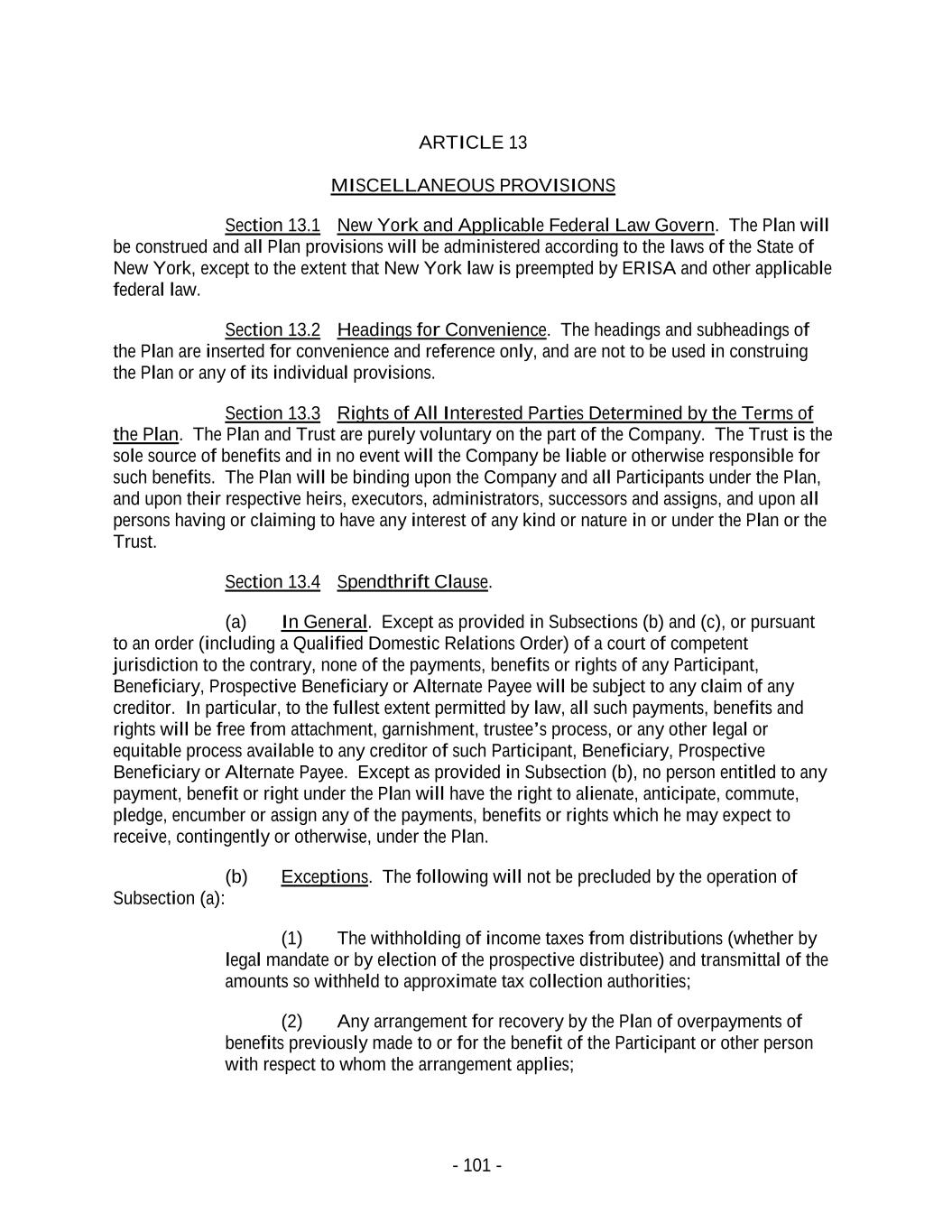
ARTICLE 13 MISCELLANEOUS PROVISIONS Section 13.1 New York and Applicable Federal Law Govern. The Plan will be construed and all Plan provisions will be administered according to the laws of the State of New York, except to the extent that New York law is preempted by ERISA and other applicable federal law. Section 13.2 Headings for Convenience. The headings and subheadings of the Plan are inserted for convenience and reference only, and are not to be used in construing the Plan or any of its individual provisions. Section 13.3 Rights of All Interested Parties Determined by the Terms of the Plan. The Plan and Trust are purely voluntary on the part of the Company. The Trust is the sole source of benefits and in no event will the Company be liable or otherwise responsible for such benefits. The Plan will be binding upon the Company and all Participants under the Plan, and upon their respective heirs, executors, administrators, successors and assigns, and upon all persons having or claiming to have any interest of any kind or nature in or under the Plan or the Trust. Section 13.4 Spendthrift Clause. (a) In General. Except as provided in Subsections (b) and (c), or pursuant to an order (including a Qualified Domestic Relations Order) of a court of competent jurisdiction to the contrary, none of the payments, benefits or rights of any Participant, Beneficiary, Prospective Beneficiary or Alternate Payee will be subject to any claim of any creditor. In particular, to the fullest extent permitted by law, all such payments, benefits and rights will be free from attachment, garnishment, trustee’s process, or any other legal or equitable process available to any creditor of such Participant, Beneficiary, Prospective Beneficiary or Alternate Payee. Except as provided in Subsection (b), no person entitled to any payment, benefit or right under the Plan will have the right to alienate, anticipate, commute, pledge, encumber or assign any of the payments, benefits or rights which he may expect to receive, contingently or otherwise, under the Plan. (b) Exceptions. The following will not be precluded by the operation of Subsection (a): (1) The withholding of income taxes from distributions (whether by legal mandate or by election of the prospective distributee) and transmittal of the amounts so withheld to approximate tax collection authorities; (2) Any arrangement for recovery by the Plan of overpayments of benefits previously made to or for the benefit of the Participant or other person with respect to whom the arrangement applies; - 101 -
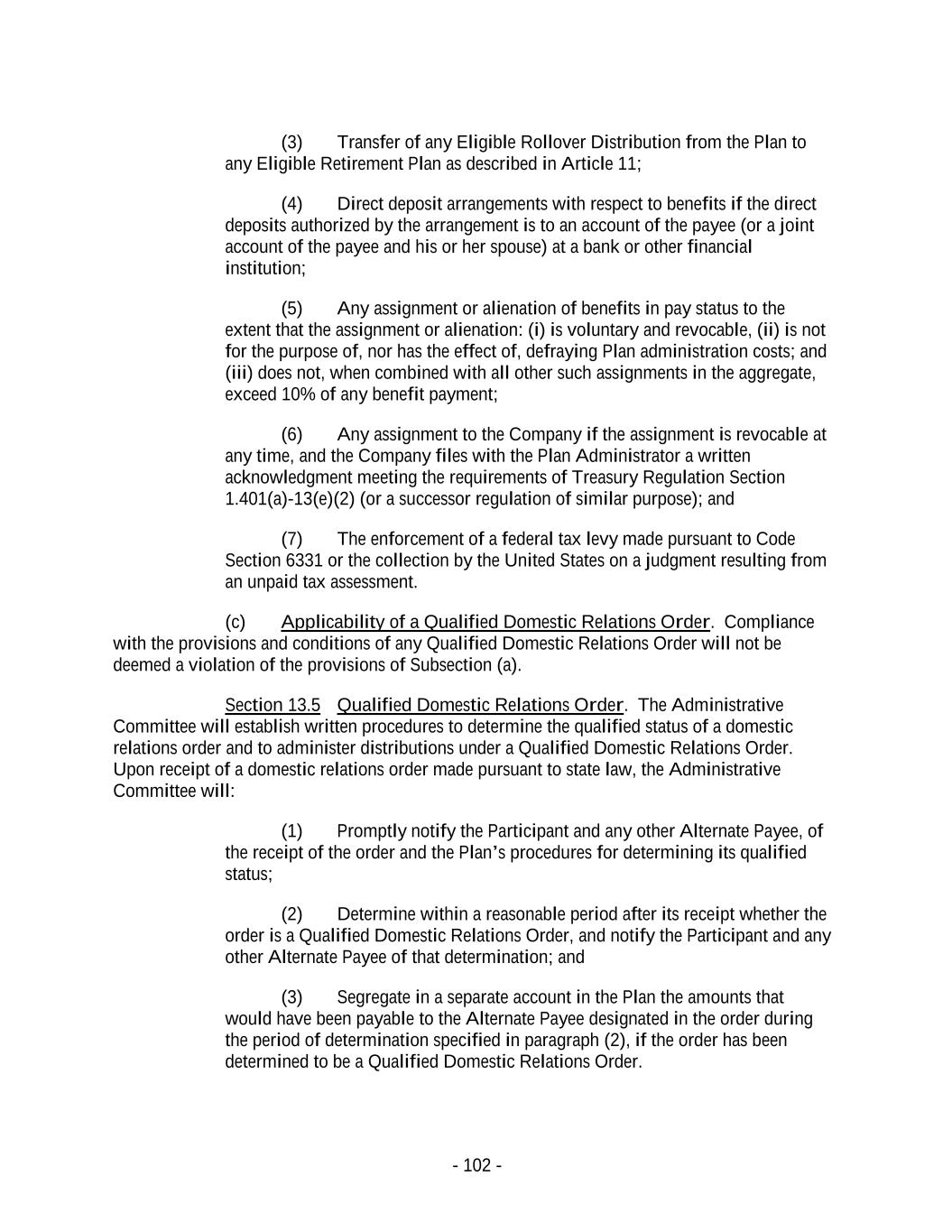
(3) Transfer of any Eligible Rollover Distribution from the Plan to any Eligible Retirement Plan as described in Article 11; (4) Direct deposit arrangements with respect to benefits if the direct deposits authorized by the arrangement is to an account of the payee (or a joint account of the payee and his or her spouse) at a bank or other financial institution; (5) Any assignment or alienation of benefits in pay status to the extent that the assignment or alienation: (i) is voluntary and revocable, (ii) is not for the purpose of, nor has the effect of, defraying Plan administration costs; and (iii) does not, when combined with all other such assignments in the aggregate, exceed 10% of any benefit payment; (6) Any assignment to the Company if the assignment is revocable at any time, and the Company files with the Plan Administrator a written acknowledgment meeting the requirements of Treasury Regulation Section 1.401(a)-13(e)(2) (or a successor regulation of similar purpose); and (7) The enforcement of a federal tax levy made pursuant to Code Section 6331 or the collection by the United States on a judgment resulting from an unpaid tax assessment. (c) Applicability of a Qualified Domestic Relations Order. Compliance with the provisions and conditions of any Qualified Domestic Relations Order will not be deemed a violation of the provisions of Subsection (a). Section 13.5 Qualified Domestic Relations Order. The Administrative Committee will establish written procedures to determine the qualified status of a domestic relations order and to administer distributions under a Qualified Domestic Relations Order. Upon receipt of a domestic relations order made pursuant to state law, the Administrative Committee will: (1) Promptly notify the Participant and any other Alternate Payee, of the receipt of the order and the Plan’s procedures for determining its qualified status; (2) Determine within a reasonable period after its receipt whether the order is a Qualified Domestic Relations Order, and notify the Participant and any other Alternate Payee of that determination; and (3) Segregate in a separate account in the Plan the amounts that would have been payable to the Alternate Payee designated in the order during the period of determination specified in paragraph (2), if the order has been determined to be a Qualified Domestic Relations Order. - 102 -
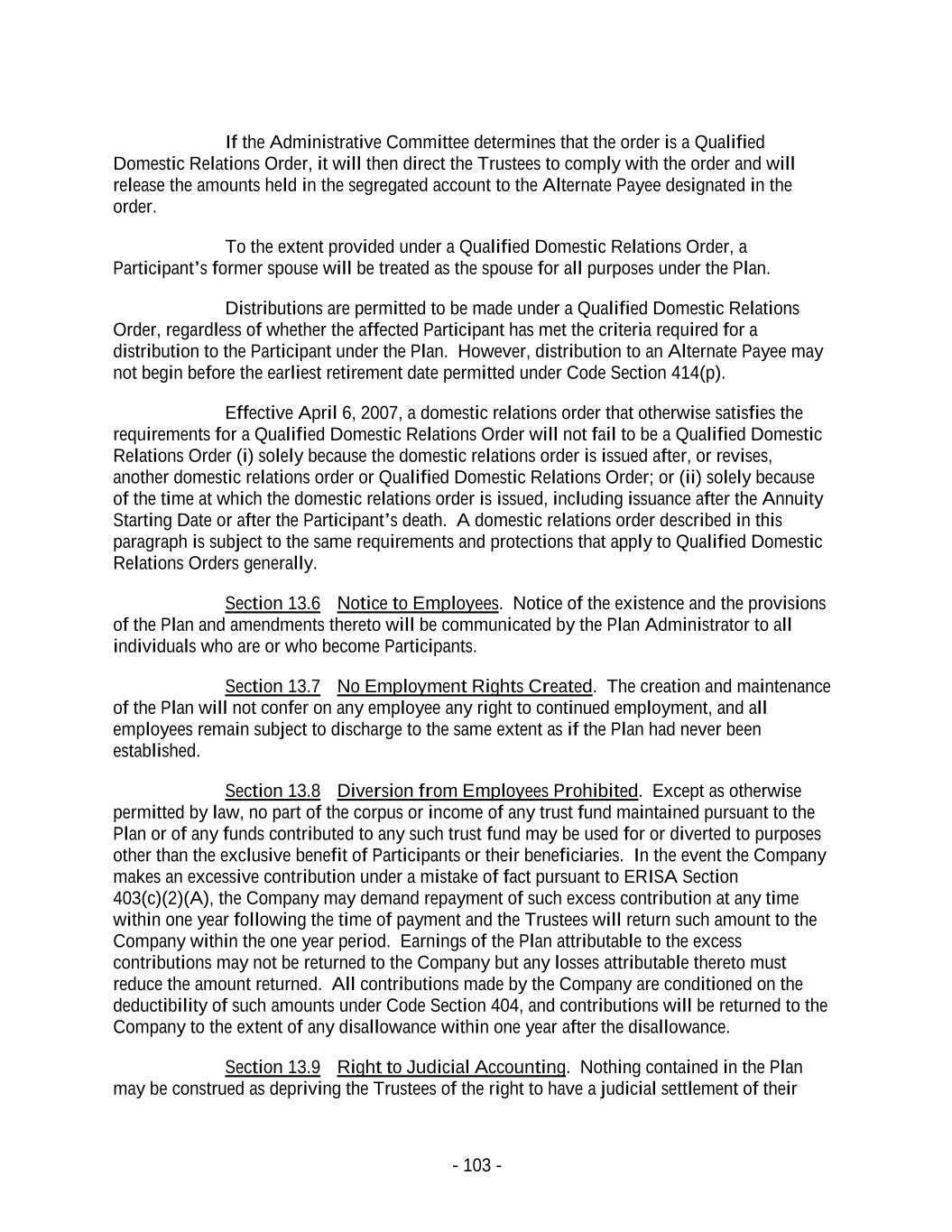
If the Administrative Committee determines that the order is a Qualified Domestic Relations Order, it will then direct the Trustees to comply with the order and will release the amounts held in the segregated account to the Alternate Payee designated in the order. To the extent provided under a Qualified Domestic Relations Order, a Participant’s former spouse will be treated as the spouse for all purposes under the Plan. Distributions are permitted to be made under a Qualified Domestic Relations Order, regardless of whether the affected Participant has met the criteria required for a distribution to the Participant under the Plan. However, distribution to an Alternate Payee may not begin before the earliest retirement date permitted under Code Section 414(p). Effective April 6, 2007, a domestic relations order that otherwise satisfies the requirements for a Qualified Domestic Relations Order will not fail to be a Qualified Domestic Relations Order (i) solely because the domestic relations order is issued after, or revises, another domestic relations order or Qualified Domestic Relations Order; or (ii) solely because of the time at which the domestic relations order is issued, including issuance after the Annuity Starting Date or after the Participant’s death. A domestic relations order described in this paragraph is subject to the same requirements and protections that apply to Qualified Domestic Relations Orders generally. Section 13.6 Notice to Employees. Notice of the existence and the provisions of the Plan and amendments thereto will be communicated by the Plan Administrator to all individuals who are or who become Participants. Section 13.7 No Employment Rights Created. The creation and maintenance of the Plan will not confer on any employee any right to continued employment, and all employees remain subject to discharge to the same extent as if the Plan had never been established. Section 13.8 Diversion from Employees Prohibited. Except as otherwise permitted by law, no part of the corpus or income of any trust fund maintained pursuant to the Plan or of any funds contributed to any such trust fund may be used for or diverted to purposes other than the exclusive benefit of Participants or their beneficiaries. In the event the Company makes an excessive contribution under a mistake of fact pursuant to ERISA Section 403(c)(2)(A), the Company may demand repayment of such excess contribution at any time within one year following the time of payment and the Trustees will return such amount to the Company within the one year period. Earnings of the Plan attributable to the excess contributions may not be returned to the Company but any losses attributable thereto must reduce the amount returned. All contributions made by the Company are conditioned on the deductibility of such amounts under Code Section 404, and contributions will be returned to the Company to the extent of any disallowance within one year after the disallowance. Section 13.9 Right to Judicial Accounting. Nothing contained in the Plan may be construed as depriving the Trustees of the right to have a judicial settlement of their - 103 -
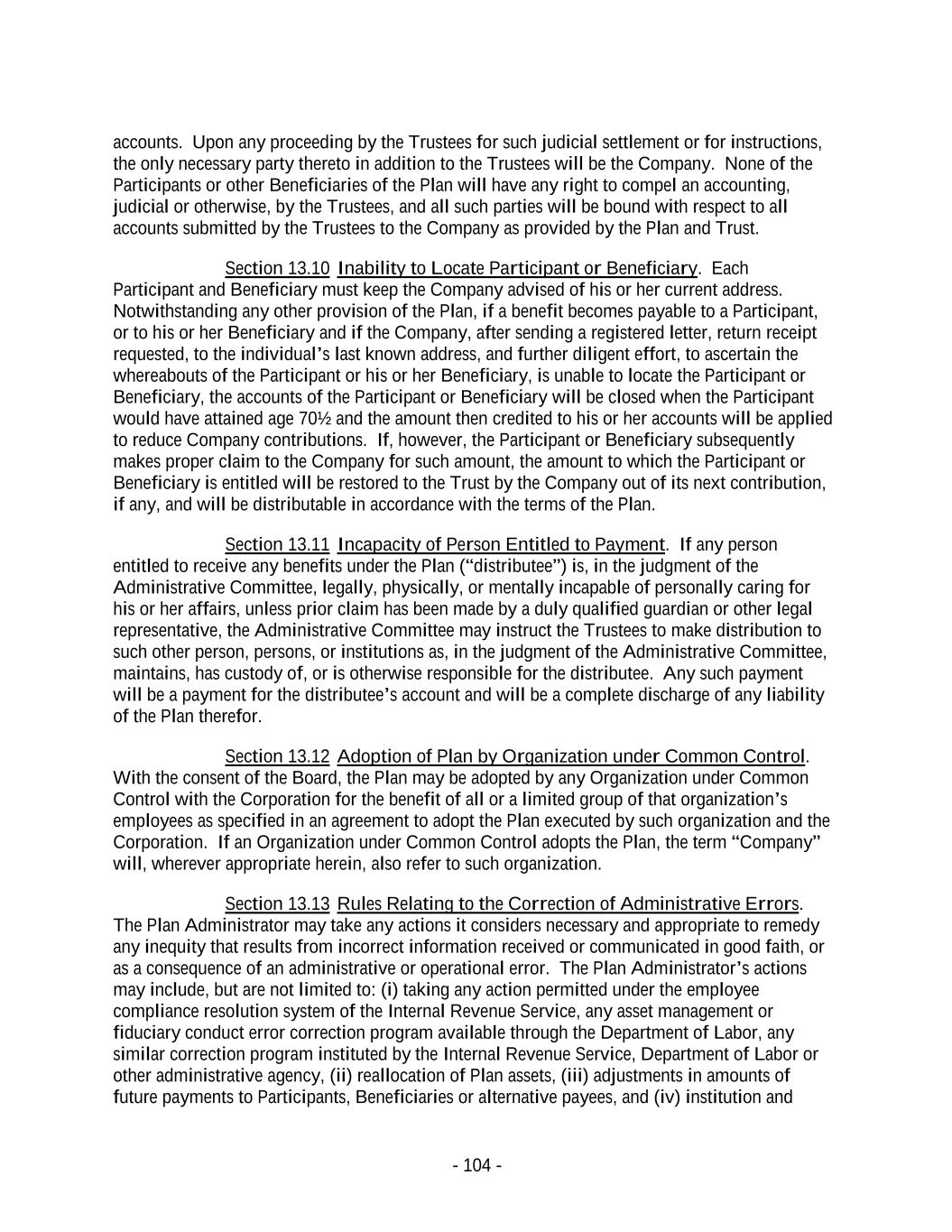
accounts. Upon any proceeding by the Trustees for such judicial settlement or for instructions, the only necessary party thereto in addition to the Trustees will be the Company. None of the Participants or other Beneficiaries of the Plan will have any right to compel an accounting, judicial or otherwise, by the Trustees, and all such parties will be bound with respect to all accounts submitted by the Trustees to the Company as provided by the Plan and Trust. Section 13.10 Inability to Locate Participant or Beneficiary. Each Participant and Beneficiary must keep the Company advised of his or her current address. Notwithstanding any other provision of the Plan, if a benefit becomes payable to a Participant, or to his or her Beneficiary and if the Company, after sending a registered letter, return receipt requested, to the individual’s last known address, and further diligent effort, to ascertain the whereabouts of the Participant or his or her Beneficiary, is unable to locate the Participant or Beneficiary, the accounts of the Participant or Beneficiary will be closed when the Participant would have attained age 70½ and the amount then credited to his or her accounts will be applied to reduce Company contributions. If, however, the Participant or Beneficiary subsequently makes proper claim to the Company for such amount, the amount to which the Participant or Beneficiary is entitled will be restored to the Trust by the Company out of its next contribution, if any, and will be distributable in accordance with the terms of the Plan. Section 13.11 Incapacity of Person Entitled to Payment. If any person entitled to receive any benefits under the Plan (“distributee”) is, in the judgment of the Administrative Committee, legally, physically, or mentally incapable of personally caring for his or her affairs, unless prior claim has been made by a duly qualified guardian or other legal representative, the Administrative Committee may instruct the Trustees to make distribution to such other person, persons, or institutions as, in the judgment of the Administrative Committee, maintains, has custody of, or is otherwise responsible for the distributee. Any such payment will be a payment for the distributee’s account and will be a complete discharge of any liability of the Plan therefor. Section 13.12 Adoption of Plan by Organization under Common Control. With the consent of the Board, the Plan may be adopted by any Organization under Common Control with the Corporation for the benefit of all or a limited group of that organization’s employees as specified in an agreement to adopt the Plan executed by such organization and the Corporation. If an Organization under Common Control adopts the Plan, the term “Company” will, wherever appropriate herein, also refer to such organization. Section 13.13 Rules Relating to the Correction of Administrative Errors. The Plan Administrator may take any actions it considers necessary and appropriate to remedy any inequity that results from incorrect information received or communicated in good faith, or as a consequence of an administrative or operational error. The Plan Administrator’s actions may include, but are not limited to: (i) taking any action permitted under the employee compliance resolution system of the Internal Revenue Service, any asset management or fiduciary conduct error correction program available through the Department of Labor, any similar correction program instituted by the Internal Revenue Service, Department of Labor or other administrative agency, (ii) reallocation of Plan assets, (iii) adjustments in amounts of future payments to Participants, Beneficiaries or alternative payees, and (iv) institution and - 104 -
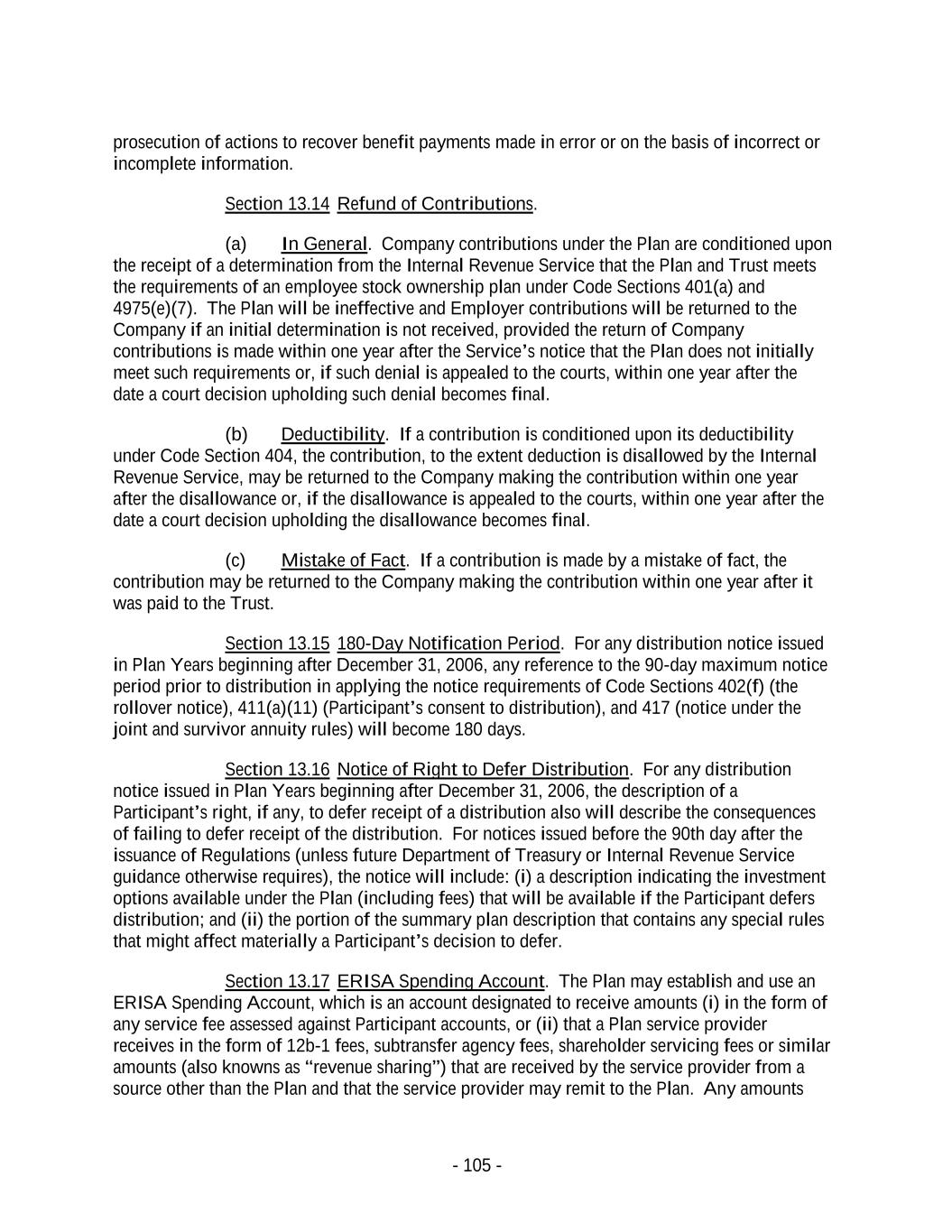
prosecution of actions to recover benefit payments made in error or on the basis of incorrect or incomplete information. Section 13.14 Refund of Contributions. (a) In General. Company contributions under the Plan are conditioned upon the receipt of a determination from the Internal Revenue Service that the Plan and Trust meets the requirements of an employee stock ownership plan under Code Sections 401(a) and 4975(e)(7). The Plan will be ineffective and Employer contributions will be returned to the Company if an initial determination is not received, provided the return of Company contributions is made within one year after the Service’s notice that the Plan does not initially meet such requirements or, if such denial is appealed to the courts, within one year after the date a court decision upholding such denial becomes final. (b) Deductibility. If a contribution is conditioned upon its deductibility under Code Section 404, the contribution, to the extent deduction is disallowed by the Internal Revenue Service, may be returned to the Company making the contribution within one year after the disallowance or, if the disallowance is appealed to the courts, within one year after the date a court decision upholding the disallowance becomes final. (c) Mistake of Fact. If a contribution is made by a mistake of fact, the contribution may be returned to the Company making the contribution within one year after it was paid to the Trust. Section 13.15 180-Day Notification Period. For any distribution notice issued in Plan Years beginning after December 31, 2006, any reference to the 90-day maximum notice period prior to distribution in applying the notice requirements of Code Sections 402(f) (the rollover notice), 411(a)(11) (Participant’s consent to distribution), and 417 (notice under the joint and survivor annuity rules) will become 180 days. Section 13.16 Notice of Right to Defer Distribution. For any distribution notice issued in Plan Years beginning after December 31, 2006, the description of a Participant’s right, if any, to defer receipt of a distribution also will describe the consequences of failing to defer receipt of the distribution. For notices issued before the 90th day after the issuance of Regulations (unless future Department of Treasury or Internal Revenue Service guidance otherwise requires), the notice will include: (i) a description indicating the investment options available under the Plan (including fees) that will be available if the Participant defers distribution; and (ii) the portion of the summary plan description that contains any special rules that might affect materially a Participant’s decision to defer. Section 13.17 ERISA Spending Account. The Plan may establish and use an ERISA Spending Account, which is an account designated to receive amounts (i) in the form of any service fee assessed against Participant accounts, or (ii) that a Plan service provider receives in the form of 12b-1 fees, subtransfer agency fees, shareholder servicing fees or similar amounts (also knowns as “revenue sharing”) that are received by the service provider from a source other than the Plan and that the service provider may remit to the Plan. Any amounts - 105 -
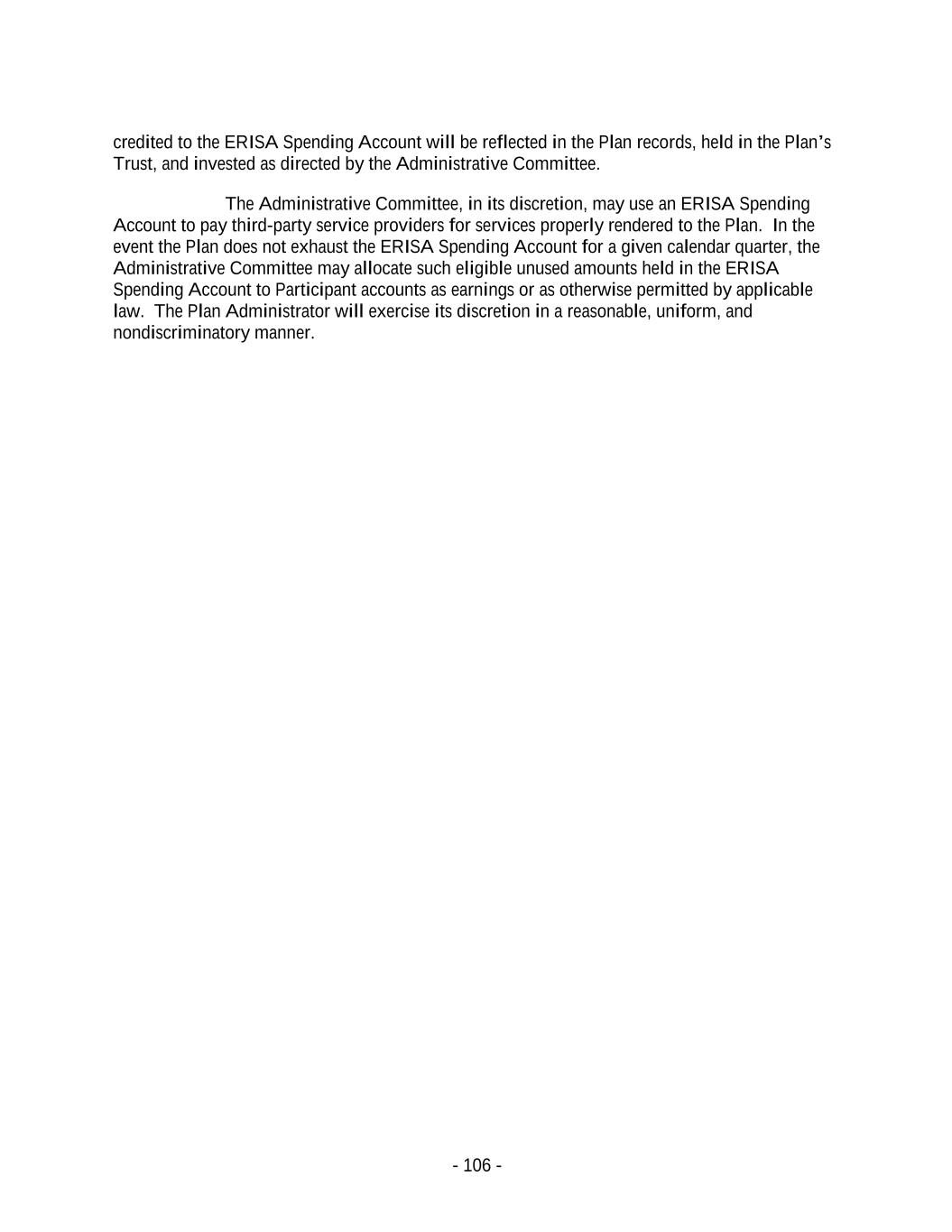
credited to the ERISA Spending Account will be reflected in the Plan records, held in the Plan’s Trust, and invested as directed by the Administrative Committee. The Administrative Committee, in its discretion, may use an ERISA Spending Account to pay third-party service providers for services properly rendered to the Plan. In the event the Plan does not exhaust the ERISA Spending Account for a given calendar quarter, the Administrative Committee may allocate such eligible unused amounts held in the ERISA Spending Account to Participant accounts as earnings or as otherwise permitted by applicable law. The Plan Administrator will exercise its discretion in a reasonable, uniform, and nondiscriminatory manner. - 106 -
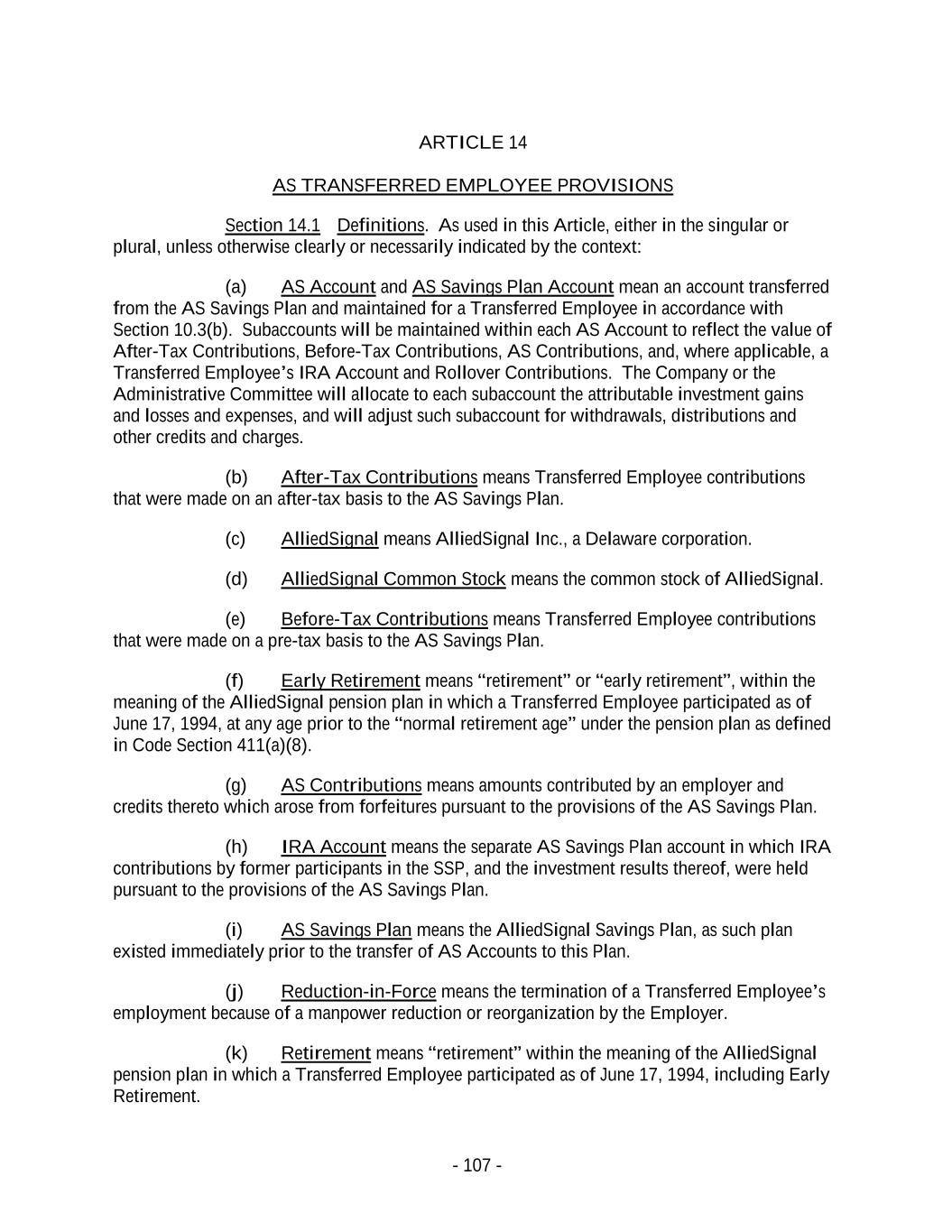
ARTICLE 14 AS TRANSFERRED EMPLOYEE PROVISIONS Section 14.1 Definitions. As used in this Article, either in the singular or plural, unless otherwise clearly or necessarily indicated by the context: (a) AS Account and AS Savings Plan Account mean an account transferred from the AS Savings Plan and maintained for a Transferred Employee in accordance with Section 10.3(b). Subaccounts will be maintained within each AS Account to reflect the value of After-Tax Contributions, Before-Tax Contributions, AS Contributions, and, where applicable, a Transferred Employee’s IRA Account and Rollover Contributions. The Company or the Administrative Committee will allocate to each subaccount the attributable investment gains and losses and expenses, and will adjust such subaccount for withdrawals, distributions and other credits and charges. (b) After-Tax Contributions means Transferred Employee contributions that were made on an after-tax basis to the AS Savings Plan. (c) AlliedSignal means AlliedSignal Inc., a Delaware corporation. (d) AlliedSignal Common Stock means the common stock of AlliedSignal. (e) Before-Tax Contributions means Transferred Employee contributions that were made on a pre-tax basis to the AS Savings Plan. (f) Early Retirement means “retirement” or “early retirement”, within the meaning of the AlliedSignal pension plan in which a Transferred Employee participated as of June 17, 1994, at any age prior to the “normal retirement age” under the pension plan as defined in Code Section 411(a)(8). (g) AS Contributions means amounts contributed by an employer and credits thereto which arose from forfeitures pursuant to the provisions of the AS Savings Plan. (h) IRA Account means the separate AS Savings Plan account in which IRA contributions by former participants in the SSP, and the investment results thereof, were held pursuant to the provisions of the AS Savings Plan. (i) AS Savings Plan means the AlliedSignal Savings Plan, as such plan existed immediately prior to the transfer of AS Accounts to this Plan. (j) Reduction-in-Force means the termination of a Transferred Employee’s employment because of a manpower reduction or reorganization by the Employer. (k) Retirement means “retirement” within the meaning of the AlliedSignal pension plan in which a Transferred Employee participated as of June 17, 1994, including Early Retirement. - 107 -

(l) Rollover Contribution means Transferred Employee rollover contributions that were made to the AS Savings Plan. (m) SSP means The Signal Companies, Inc. Savings and Stock Purchase Plan, as such plan existed immediately prior to its merger into the AS Savings Plan. (n) Transferred Employee means an AlliedSignal employee offered employment by Moog Inc., as of the closing date under the stock purchase agreement dated as of June 7, 1994 entered into by AlliedSignal, Moog Inc. and Moog Torrance Inc., provided that such individual accepted the offer of employment. Section 14.2 Investment of AS Accounts. The AS Accounts may be invested, pursuant to each Transferred Employee’s instructions, in any investment fund established pursuant to Section 7.6(c) for the purpose of investing contributions under the Plan. Notwithstanding the foregoing, AS Accounts may not be reinvested in Company Stock, and repayments of Transferred Employee loans (as described in Section 14.7) may not be invested in Company Stock. To the extent that a Transferred Employee’s AS Account is invested in Company Stock pursuant to the Transferred Employee’s instructions, that investment in Company Stock may not be reinvested in any other investment vehicle or fund under the Plan, except as otherwise permitted by any other provision of the Plan. Section 14.3 Transferred Employees’ AS Accounts and Subaccounts. There will be established for each Transferred Employee a separate AS Account, to which there will be transferred all of each Transferred Employee’s After-Tax Contributions, Before-Tax Contributions, Rollover Contributions, AS Contributions and IRA Account contributions under the AS Savings Plan as of the transfer date. Subaccounts will be maintained within each AS Account to reflect the value of After-Tax Contributions, Before-Tax Contributions, Rollover Contributions, AS Contributions and IRA Account contributions. Section 14.4 Vesting. Each Transferred Employee is fully and immediately vested in his or her AS Savings Plan Account. Section 14.5 Distributions. (a) Amount of Benefits. Notwithstanding any other provision of the Plan to the contrary, the amount of benefits payable to a Transferred Employee (or his or her Beneficiary), with respect to the Transferred Employee’s AS Account, after the Transferred Employee has terminated employment or upon attaining age 70½ will be based on the fair market value of the Transferred Employee’s AS Account, determined as of the applicable Valuation Date described in subsection (b) below. (b) Methods of Payment. (1) Retirement, Reduction-in-Force, Disability, or Attainment of Age 70½. A Transferred Employee who terminates employment as a result of Retirement, Reduction-in-Force or Disability, or who continues as an Employee (or as a former Employee who continues to receive base pay from the Company - 108 -
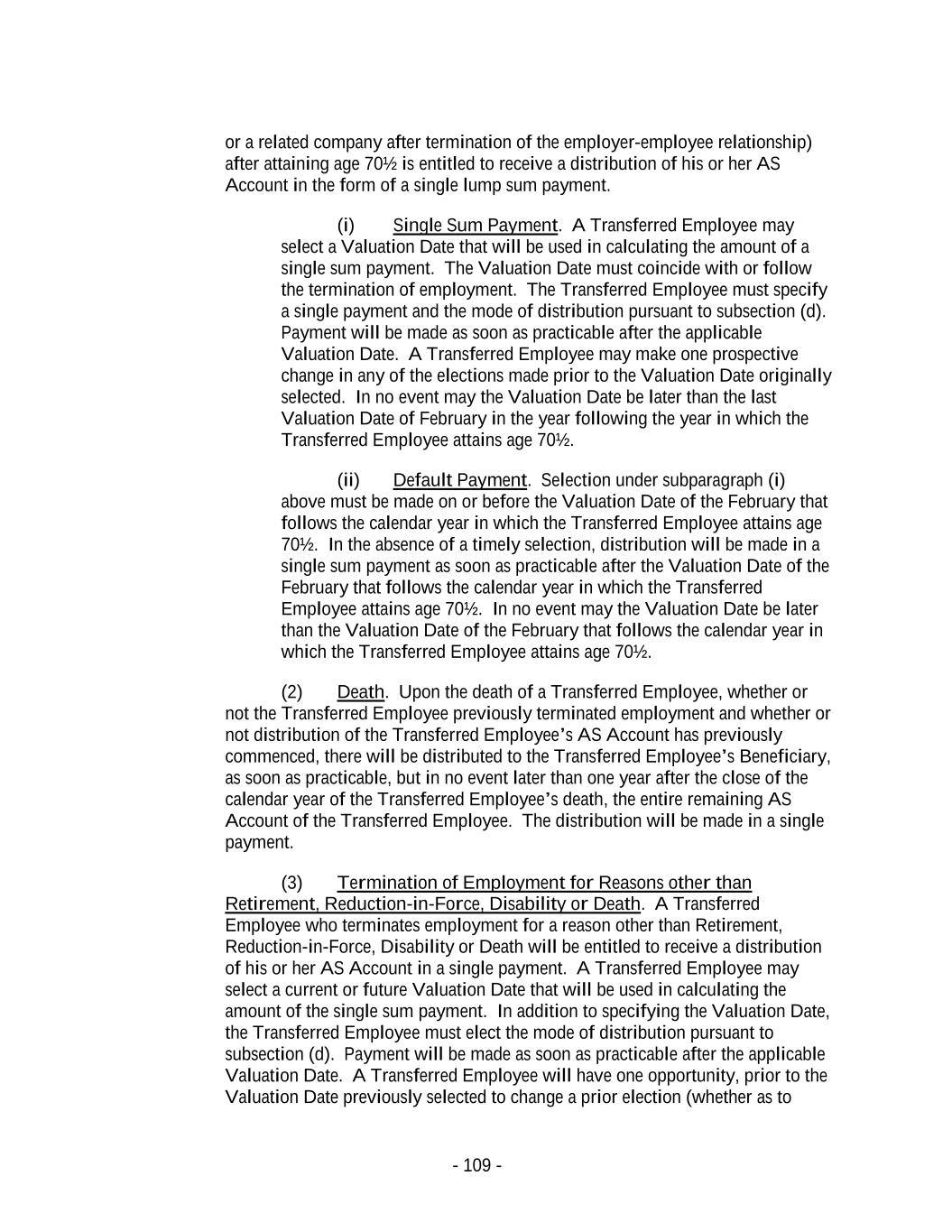
or a related company after termination of the employer-employee relationship) after attaining age 70½ is entitled to receive a distribution of his or her AS Account in the form of a single lump sum payment. (i) Single Sum Payment. A Transferred Employee may select a Valuation Date that will be used in calculating the amount of a single sum payment. The Valuation Date must coincide with or follow the termination of employment. The Transferred Employee must specify a single payment and the mode of distribution pursuant to subsection (d). Payment will be made as soon as practicable after the applicable Valuation Date. A Transferred Employee may make one prospective change in any of the elections made prior to the Valuation Date originally selected. In no event may the Valuation Date be later than the last Valuation Date of February in the year following the year in which the Transferred Employee attains age 70½. (ii) Default Payment. Selection under subparagraph (i) above must be made on or before the Valuation Date of the February that follows the calendar year in which the Transferred Employee attains age 70½. In the absence of a timely selection, distribution will be made in a single sum payment as soon as practicable after the Valuation Date of the February that follows the calendar year in which the Transferred Employee attains age 70½. In no event may the Valuation Date be later than the Valuation Date of the February that follows the calendar year in which the Transferred Employee attains age 70½. (2) Death. Upon the death of a Transferred Employee, whether or not the Transferred Employee previously terminated employment and whether or not distribution of the Transferred Employee’s AS Account has previously commenced, there will be distributed to the Transferred Employee’s Beneficiary, as soon as practicable, but in no event later than one year after the close of the calendar year of the Transferred Employee’s death, the entire remaining AS Account of the Transferred Employee. The distribution will be made in a single payment. (3) Termination of Employment for Reasons other than Retirement, Reduction-in-Force, Disability or Death. A Transferred Employee who terminates employment for a reason other than Retirement, Reduction-in-Force, Disability or Death will be entitled to receive a distribution of his or her AS Account in a single payment. A Transferred Employee may select a current or future Valuation Date that will be used in calculating the amount of the single sum payment. In addition to specifying the Valuation Date, the Transferred Employee must elect the mode of distribution pursuant to subsection (d). Payment will be made as soon as practicable after the applicable Valuation Date. A Transferred Employee will have one opportunity, prior to the Valuation Date previously selected to change a prior election (whether as to - 109 -
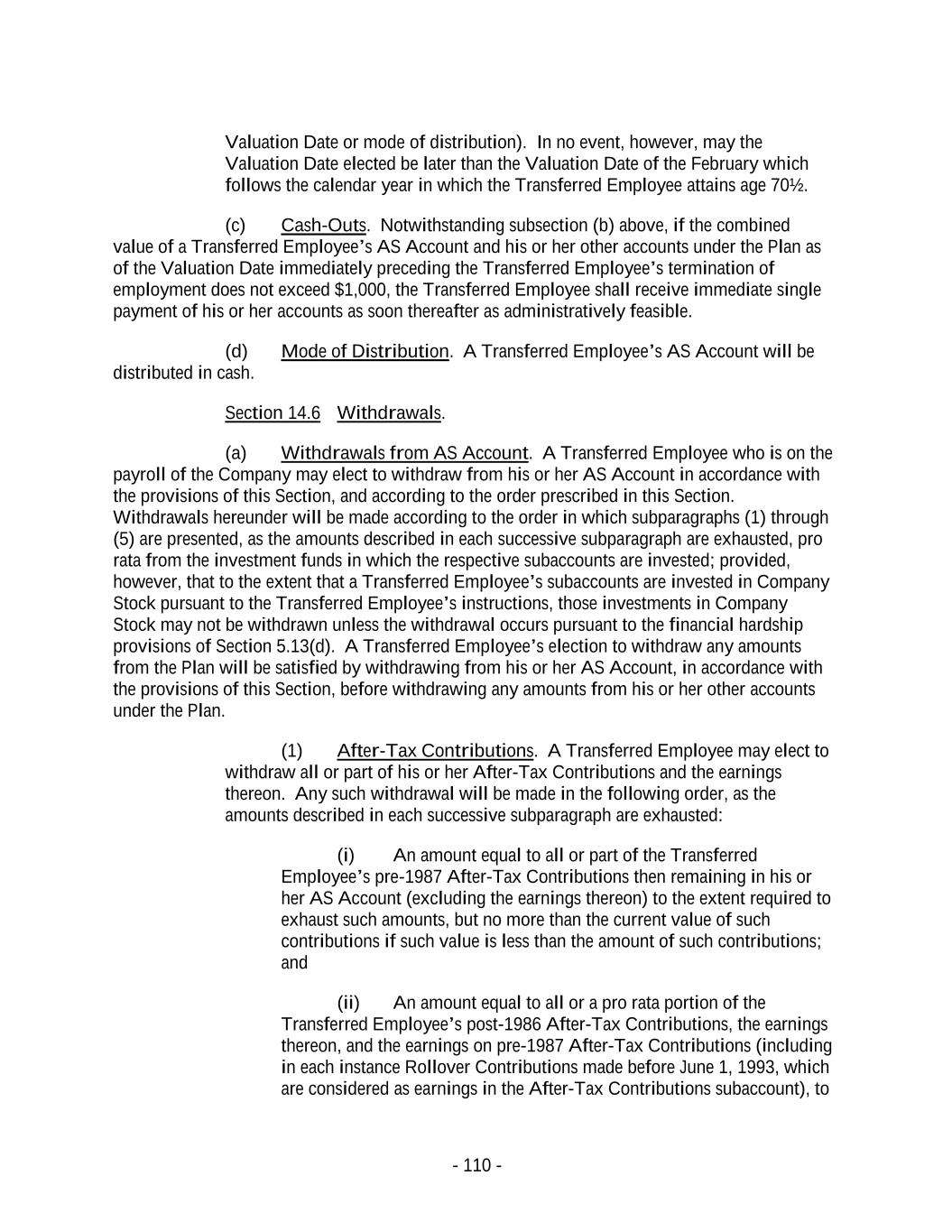
Valuation Date or mode of distribution). In no event, however, may the Valuation Date elected be later than the Valuation Date of the February which follows the calendar year in which the Transferred Employee attains age 70½. (c) Cash-Outs. Notwithstanding subsection (b) above, if the combined value of a Transferred Employee’s AS Account and his or her other accounts under the Plan as of the Valuation Date immediately preceding the Transferred Employee’s termination of employment does not exceed $1,000, the Transferred Employee shall receive immediate single payment of his or her accounts as soon thereafter as administratively feasible. (d) Mode of Distribution. A Transferred Employee’s AS Account will be distributed in cash. Section 14.6 Withdrawals. (a) Withdrawals from AS Account. A Transferred Employee who is on the payroll of the Company may elect to withdraw from his or her AS Account in accordance with the provisions of this Section, and according to the order prescribed in this Section. Withdrawals hereunder will be made according to the order in which subparagraphs (1) through (5) are presented, as the amounts described in each successive subparagraph are exhausted, pro rata from the investment funds in which the respective subaccounts are invested; provided, however, that to the extent that a Transferred Employee’s subaccounts are invested in Company Stock pursuant to the Transferred Employee’s instructions, those investments in Company Stock may not be withdrawn unless the withdrawal occurs pursuant to the financial hardship provisions of Section 5.13(d). A Transferred Employee’s election to withdraw any amounts from the Plan will be satisfied by withdrawing from his or her AS Account, in accordance with the provisions of this Section, before withdrawing any amounts from his or her other accounts under the Plan. (1) After-Tax Contributions. A Transferred Employee may elect to withdraw all or part of his or her After-Tax Contributions and the earnings thereon. Any such withdrawal will be made in the following order, as the amounts described in each successive subparagraph are exhausted: (i) An amount equal to all or part of the Transferred Employee’s pre-1987 After-Tax Contributions then remaining in his or her AS Account (excluding the earnings thereon) to the extent required to exhaust such amounts, but no more than the current value of such contributions if such value is less than the amount of such contributions; and (ii) An amount equal to all or a pro rata portion of the Transferred Employee’s post-1986 After-Tax Contributions, the earnings thereon, and the earnings on pre-1987 After-Tax Contributions (including in each instance Rollover Contributions made before June 1, 1993, which are considered as earnings in the After-Tax Contributions subaccount), to - 110 -

the extent required to exhaust such amounts, but no more than the current value of such contributions and such earnings if such value is less than the amount of such contributions and such earnings. Any withdrawal of After-Tax Contributions by a Transferred Employee who has not completed 60 months of participation will result in a suspension of Employer contributions under the Plan for a period of 90 days immediately following such withdrawal. (2) IRA Account. A Transferred Employee may elect to withdraw all or part of the Transferred Employee’s IRA Account and the earnings thereon. (3) Rollover Contributions. A Transferred Employee may elect to withdraw all or part of his or her Rollover Contributions made on or after June 1, 1993 and the earnings thereon in his or her Rollover Contribution subaccount. (4) AS Contributions. A Transferred Employee may elect to withdraw all or part of his or her AS Contributions and the earnings thereon. Any such withdrawal by a Transferred Employee who has not completed 60 months of participation will result in a suspension of Company contributions under the Plan for a period of three months immediately following such withdrawal. (5) Before-Tax Contributions. (i) Post-Age 59½ Withdrawals. A Transferred Employee who has attained age 59½ may elect to withdraw all or part of his or her Before-Tax Contributions and the earnings thereon. (ii) Pre-Age 59½ Hardship Withdrawals. Distribution of part or all of a Transferred Employee’s Before-Tax Contributions and the earnings thereon (to the extent permitted under the Plan) may occur pursuant to the financial hardship provisions of Section 5.13(d). (b) Withdrawal Procedures. A Transferred Employee may elect to make a withdrawal under this Section, except for hardship withdrawals made pursuant to Section 14.6(a)(5)(ii), as of any current Valuation Date, provided that no other withdrawal under this Section has been made within three months of that Valuation Date. The amount available for withdrawal will be based on the value of the Transferred Employee’s AS Account as of the Valuation Date elected, except that amounts invested in Company Stock pursuant to the Transferred Employee’s instructions may not be withdrawn unless the withdrawal occurs pursuant to the financial hardship provisions of Section 5.13(d). Any withdrawal will be in an amount not less than the lesser of (i) $300 or (ii) the amount available for withdrawal. If a participant loan transferred to the Plan from the AS Savings Plan is outstanding, the Transferred Employee’s withdrawal may not be greater than the amount that will cause the combined value of his AS Account and his or her other accounts under the Plan to be twice the outstanding principal balance of the loan and all accrued interest thereon. Any pre-age 59½ hardship - 111 -
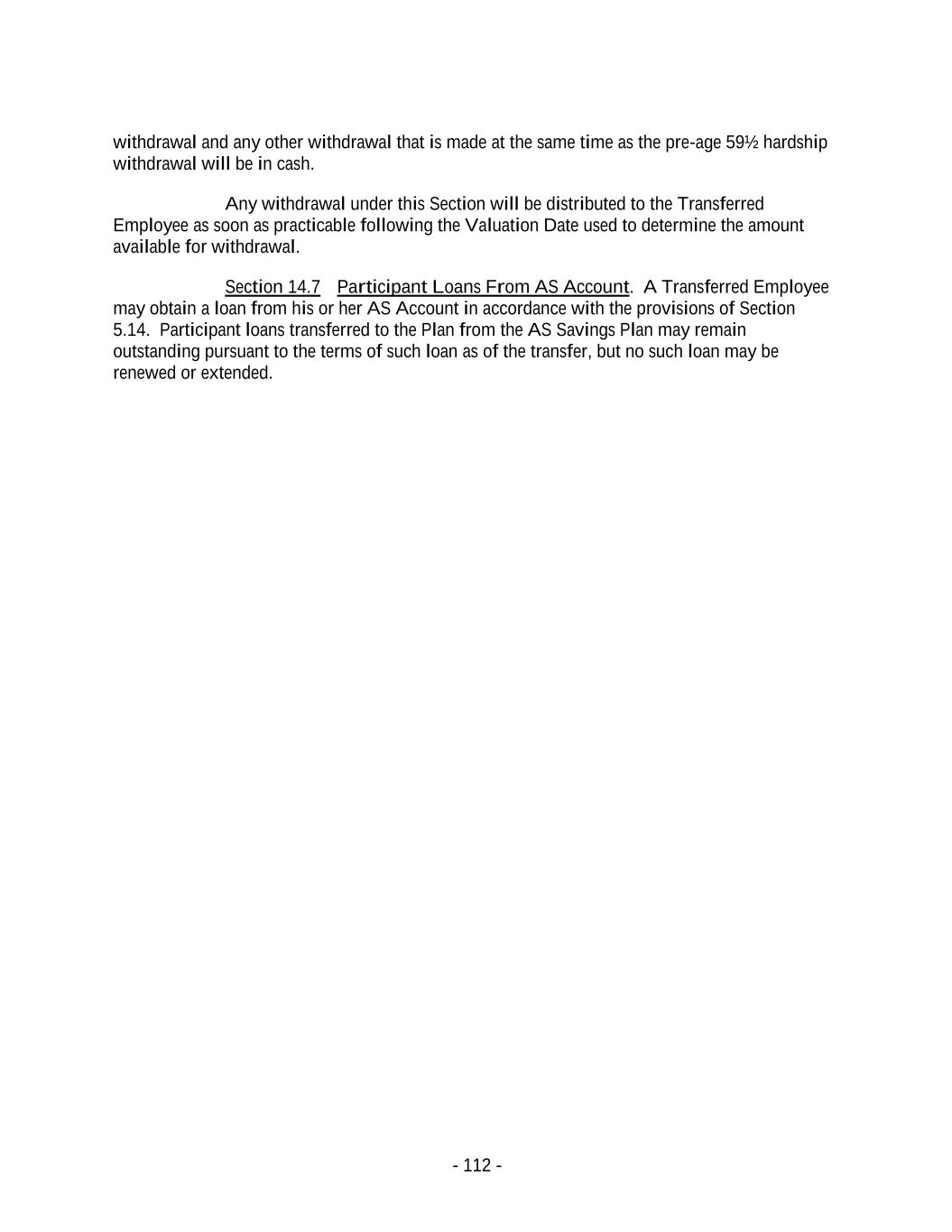
withdrawal and any other withdrawal that is made at the same time as the pre-age 59½ hardship withdrawal will be in cash. Any withdrawal under this Section will be distributed to the Transferred Employee as soon as practicable following the Valuation Date used to determine the amount available for withdrawal. Section 14.7 Participant Loans From AS Account. A Transferred Employee may obtain a loan from his or her AS Account in accordance with the provisions of Section 5.14. Participant loans transferred to the Plan from the AS Savings Plan may remain outstanding pursuant to the terms of such loan as of the transfer, but no such loan may be renewed or extended. - 112 -
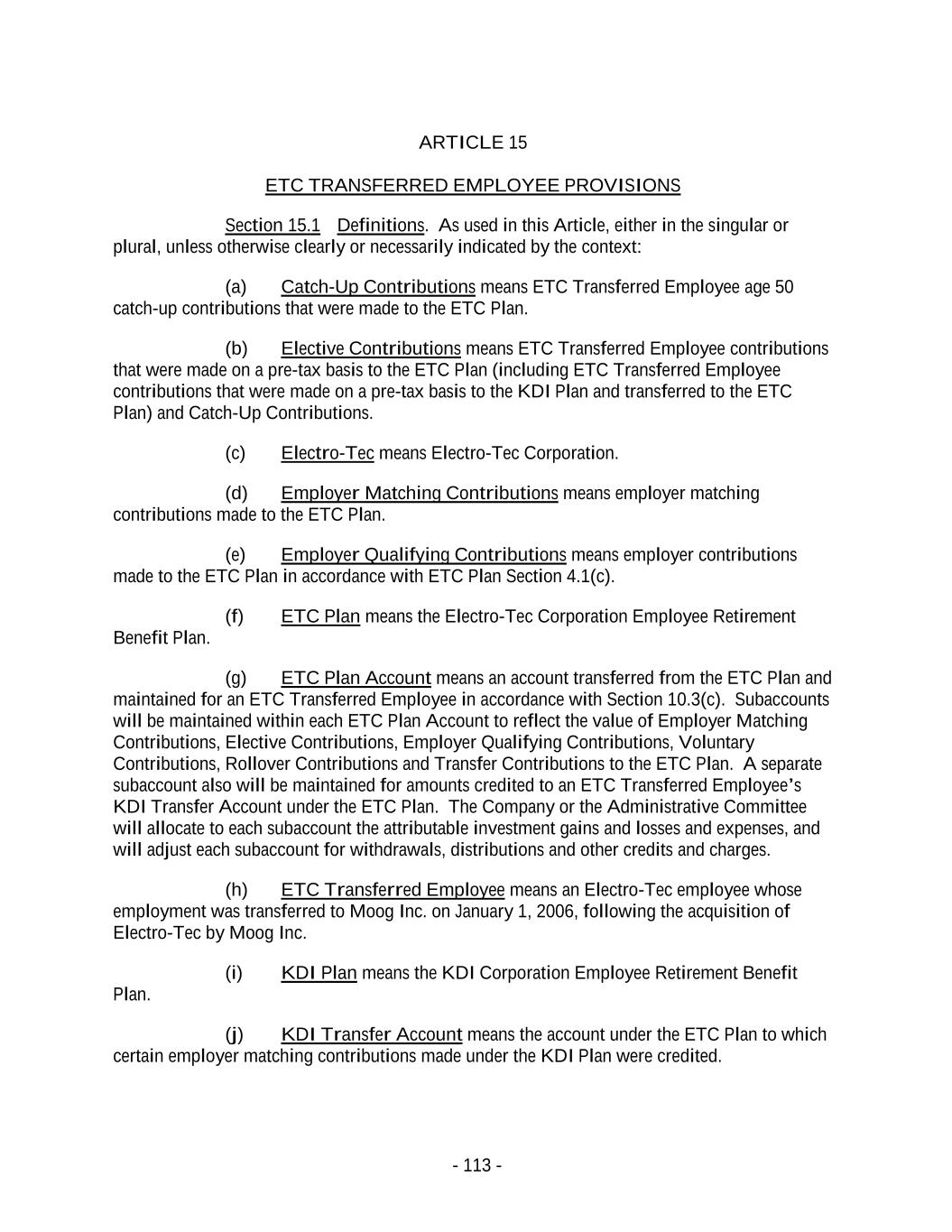
ARTICLE 15 ETC TRANSFERRED EMPLOYEE PROVISIONS Section 15.1 Definitions. As used in this Article, either in the singular or plural, unless otherwise clearly or necessarily indicated by the context: (a) Catch-Up Contributions means ETC Transferred Employee age 50 catch-up contributions that were made to the ETC Plan. (b) Elective Contributions means ETC Transferred Employee contributions that were made on a pre-tax basis to the ETC Plan (including ETC Transferred Employee contributions that were made on a pre-tax basis to the KDI Plan and transferred to the ETC Plan) and Catch-Up Contributions. (c) Electro-Tec means Electro-Tec Corporation. (d) Employer Matching Contributions means employer matching contributions made to the ETC Plan. (e) Employer Qualifying Contributions means employer contributions made to the ETC Plan in accordance with ETC Plan Section 4.1(c). (f) ETC Plan means the Electro-Tec Corporation Employee Retirement Benefit Plan. (g) ETC Plan Account means an account transferred from the ETC Plan and maintained for an ETC Transferred Employee in accordance with Section 10.3(c). Subaccounts will be maintained within each ETC Plan Account to reflect the value of Employer Matching Contributions, Elective Contributions, Employer Qualifying Contributions, Voluntary Contributions, Rollover Contributions and Transfer Contributions to the ETC Plan. A separate subaccount also will be maintained for amounts credited to an ETC Transferred Employee’s KDI Transfer Account under the ETC Plan. The Company or the Administrative Committee will allocate to each subaccount the attributable investment gains and losses and expenses, and will adjust each subaccount for withdrawals, distributions and other credits and charges. (h) ETC Transferred Employee means an Electro-Tec employee whose employment was transferred to Moog Inc. on January 1, 2006, following the acquisition of Electro-Tec by Moog Inc. (i) KDI Plan means the KDI Corporation Employee Retirement Benefit Plan. (j) KDI Transfer Account means the account under the ETC Plan to which certain employer matching contributions made under the KDI Plan were credited. - 113 -
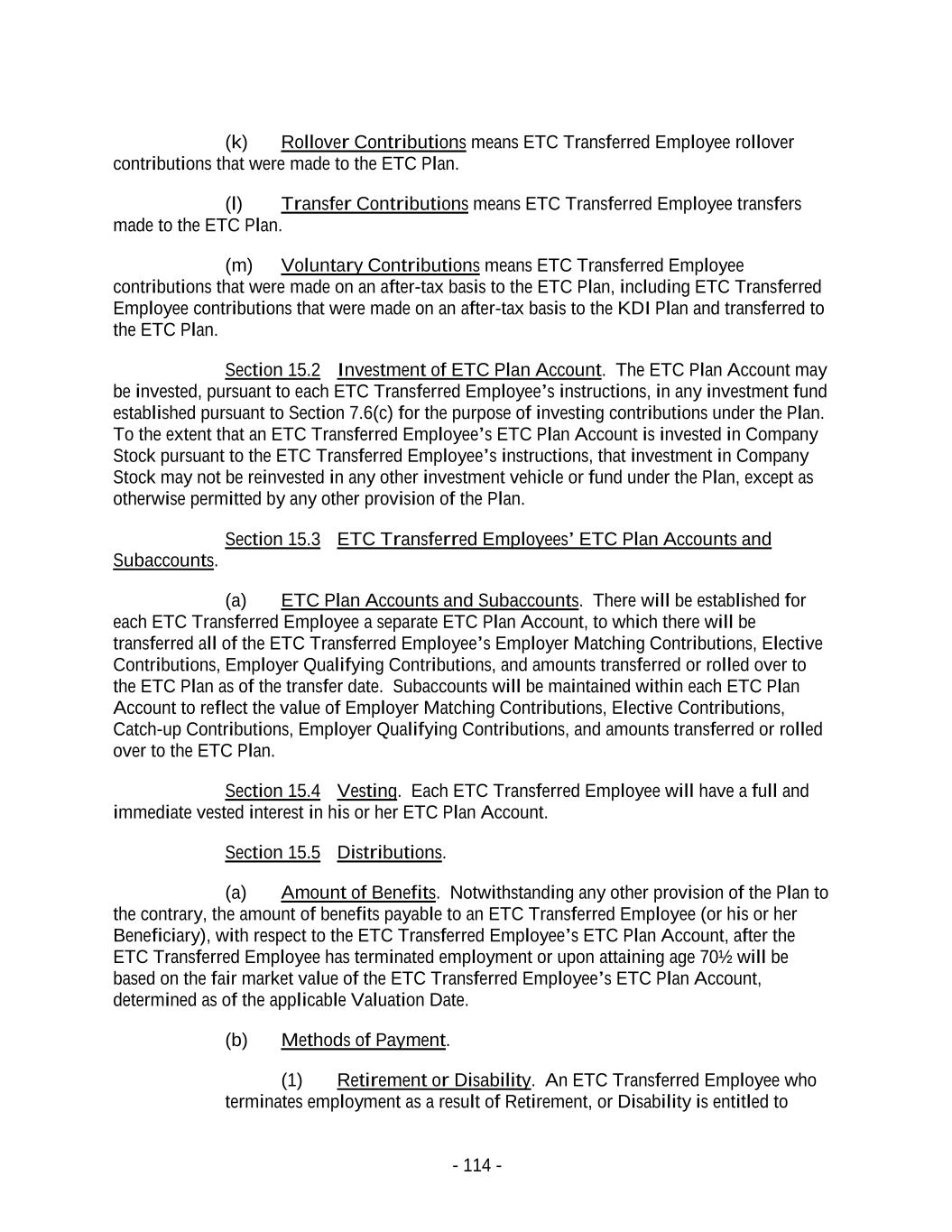
(k) Rollover Contributions means ETC Transferred Employee rollover contributions that were made to the ETC Plan. (l) Transfer Contributions means ETC Transferred Employee transfers made to the ETC Plan. (m) Voluntary Contributions means ETC Transferred Employee contributions that were made on an after-tax basis to the ETC Plan, including ETC Transferred Employee contributions that were made on an after-tax basis to the KDI Plan and transferred to the ETC Plan. Section 15.2 Investment of ETC Plan Account. The ETC Plan Account may be invested, pursuant to each ETC Transferred Employee’s instructions, in any investment fund established pursuant to Section 7.6(c) for the purpose of investing contributions under the Plan. To the extent that an ETC Transferred Employee’s ETC Plan Account is invested in Company Stock pursuant to the ETC Transferred Employee’s instructions, that investment in Company Stock may not be reinvested in any other investment vehicle or fund under the Plan, except as otherwise permitted by any other provision of the Plan. Section 15.3 ETC Transferred Employees’ ETC Plan Accounts and Subaccounts. (a) ETC Plan Accounts and Subaccounts. There will be established for each ETC Transferred Employee a separate ETC Plan Account, to which there will be transferred all of the ETC Transferred Employee’s Employer Matching Contributions, Elective Contributions, Employer Qualifying Contributions, and amounts transferred or rolled over to the ETC Plan as of the transfer date. Subaccounts will be maintained within each ETC Plan Account to reflect the value of Employer Matching Contributions, Elective Contributions, Catch-up Contributions, Employer Qualifying Contributions, and amounts transferred or rolled over to the ETC Plan. Section 15.4 Vesting. Each ETC Transferred Employee will have a full and immediate vested interest in his or her ETC Plan Account. Section 15.5 Distributions. (a) Amount of Benefits. Notwithstanding any other provision of the Plan to the contrary, the amount of benefits payable to an ETC Transferred Employee (or his or her Beneficiary), with respect to the ETC Transferred Employee’s ETC Plan Account, after the ETC Transferred Employee has terminated employment or upon attaining age 70½ will be based on the fair market value of the ETC Transferred Employee’s ETC Plan Account, determined as of the applicable Valuation Date. (b) Methods of Payment. (1) Retirement or Disability. An ETC Transferred Employee who terminates employment as a result of Retirement, or Disability is entitled to - 114 -

receive a distribution of his or her ETC Plan Account in the form of a single lump sum payment. (2) Attainment of Age 70½. An ETC Transferred Employee who continues as an Employee (or as a former Employee who continues to receive base pay from the Company or a related company after termination of the employer-employee relationship) after attaining age 70½ is entitled to begin receiving Minimum Distribution Payments from his or her ETC Plan Account. Those Minimum Distribution Payments will begin to be made no later than April 1 following the close of the calendar year in which the ETC Transferred Employee attains age 70½. Notwithstanding the preceding sentence, an ETC Transferred Employee who is not a five percent owner, within the meaning of Code Section 416, may elect to defer the commencement of benefit payments with respect to amounts attributable to his or her ETC Plan Account until no later than April 1 following the close of the calendar year in which the ETC Transferred Employee terminates employment; provided, however that any payment made after termination of employment will be made in the form of a lump sum payment of all his or her Plan accounts. (i) For purposes of this Article, “Minimum Distribution Payments” means payments determined and made in accordance with Section 12.4. (3) Death. Upon the death of an ETC Transferred Employee, whether or not the ETC Transferred Employee previously terminated employment, and whether or not distribution of the ETC Transferred Employee’s ETC Plan Account has previously commenced, there will be distributed, in a single lump sum payment, to the ETC Transferred Employee’s Beneficiary, as soon as practicable, but in no event later than one year after the close of the calendar year of the ETC Transferred Employee’s death, the entire remaining ETC Plan Account of the ETC Transferred Employee. Notwithstanding the preceding sentence, if the ETC Transferred Employee’s sole designated Beneficiary is his or her surviving spouse, the surviving spouse may withhold consent and defer payment of the benefits in accordance with, and to the extent permitted by, Section 5.5(a). (4) Termination of Employment for Reasons other than Retirement, Disability or Death. An ETC Transferred Employee who terminates employment for a reason other than Retirement, Disability or Death is entitled to receive a distribution of his or her ETC Plan Account in a single lump sum payment. (c) Cash-Outs. Notwithstanding subsection (b) above, if the combined value of an ETC Transferred Employee’s ETC Plan Account and his or her other accounts under the Plan as of the Valuation Date immediately preceding the ETC Transferred Employee’s termination of employment does not exceed $1,000, the ETC Transferred - 115 -

Employee will receive an immediate single payment of his or her accounts as soon thereafter as administratively practical. Section 15.6 Withdrawals. (a) Withdrawals from ETC Plan Account. An ETC Transferred Employee who is on the payroll of an Employer may elect to withdraw from his or her ETC Plan Account in accordance with the provisions of this Section. Withdrawals hereunder will be made pro rata from the investment funds in which the respective subaccounts are invested. An ETC Transferred Employee’s election to withdraw any amounts from the Plan must be satisfied by withdrawing from his or her ETC Plan account in accordance with this Section before withdrawing any amounts from his or her other accounts under the Plan. (1) Voluntary Contributions. An ETC Transferred Employee may elect to withdraw all or part of his or her Voluntary Contributions and the earnings thereon by giving notice to the Administrative Committee of a desire to begin a distribution of all or any part of the Voluntary Contribution subaccount. Any withdrawal of Voluntary Contributions and the earnings thereon will be made in the following order, as the amounts described in each successive subparagraph are exhausted: (i) An amount equal to all or part of the ETC Transferred Employee’s pre-1987 Voluntary Contributions then remaining in his or her ETC Plan Account (excluding the earnings thereon) to the extent required to exhaust those contributions, but no more than the current value of those contributions if that value is less than the amount of the contributions; and (ii) An amount equal to all or a pro rata portion of the ETC Transferred Employee’s post-1986 Voluntary Contributions, the earnings thereon, and the earnings on pre-1987 Voluntary Contributions, to the extent required to exhaust those amounts, but no more than the current value of those contributions and earnings if that value is less than the amount of the contributions and earnings. (2) Rollover Contributions. An ETC Transferred Employee may elect to withdraw all or part of his or her Rollover Contributions and the earnings thereon by giving notice to the Administrative Committee of a desire to begin a distribution of all or any part of his or her Rollover Contribution subaccount. (3) Post-Age 59½ Withdrawals. (i) KDI Transfer Account. An ETC Transferred Employee who has attained age 59½ may elect to withdraw all or part of his or her subaccount attributable to the KDI Transfer Account. - 116 -
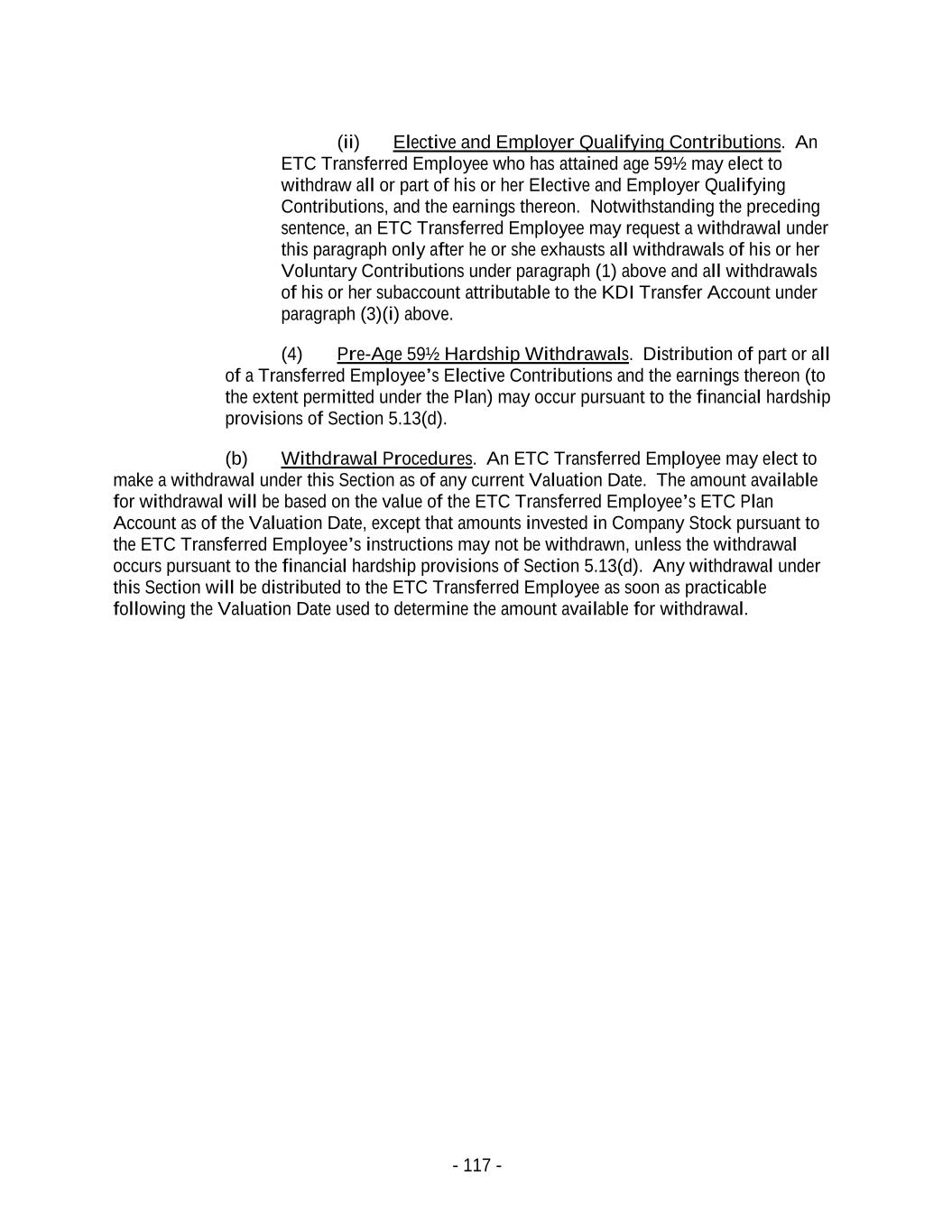
(ii) Elective and Employer Qualifying Contributions. An ETC Transferred Employee who has attained age 59½ may elect to withdraw all or part of his or her Elective and Employer Qualifying Contributions, and the earnings thereon. Notwithstanding the preceding sentence, an ETC Transferred Employee may request a withdrawal under this paragraph only after he or she exhausts all withdrawals of his or her Voluntary Contributions under paragraph (1) above and all withdrawals of his or her subaccount attributable to the KDI Transfer Account under paragraph (3)(i) above. (4) Pre-Age 59½ Hardship Withdrawals. Distribution of part or all of a Transferred Employee’s Elective Contributions and the earnings thereon (to the extent permitted under the Plan) may occur pursuant to the financial hardship provisions of Section 5.13(d). (b) Withdrawal Procedures. An ETC Transferred Employee may elect to make a withdrawal under this Section as of any current Valuation Date. The amount available for withdrawal will be based on the value of the ETC Transferred Employee’s ETC Plan Account as of the Valuation Date, except that amounts invested in Company Stock pursuant to the ETC Transferred Employee’s instructions may not be withdrawn, unless the withdrawal occurs pursuant to the financial hardship provisions of Section 5.13(d). Any withdrawal under this Section will be distributed to the ETC Transferred Employee as soon as practicable following the Valuation Date used to determine the amount available for withdrawal. - 117 -
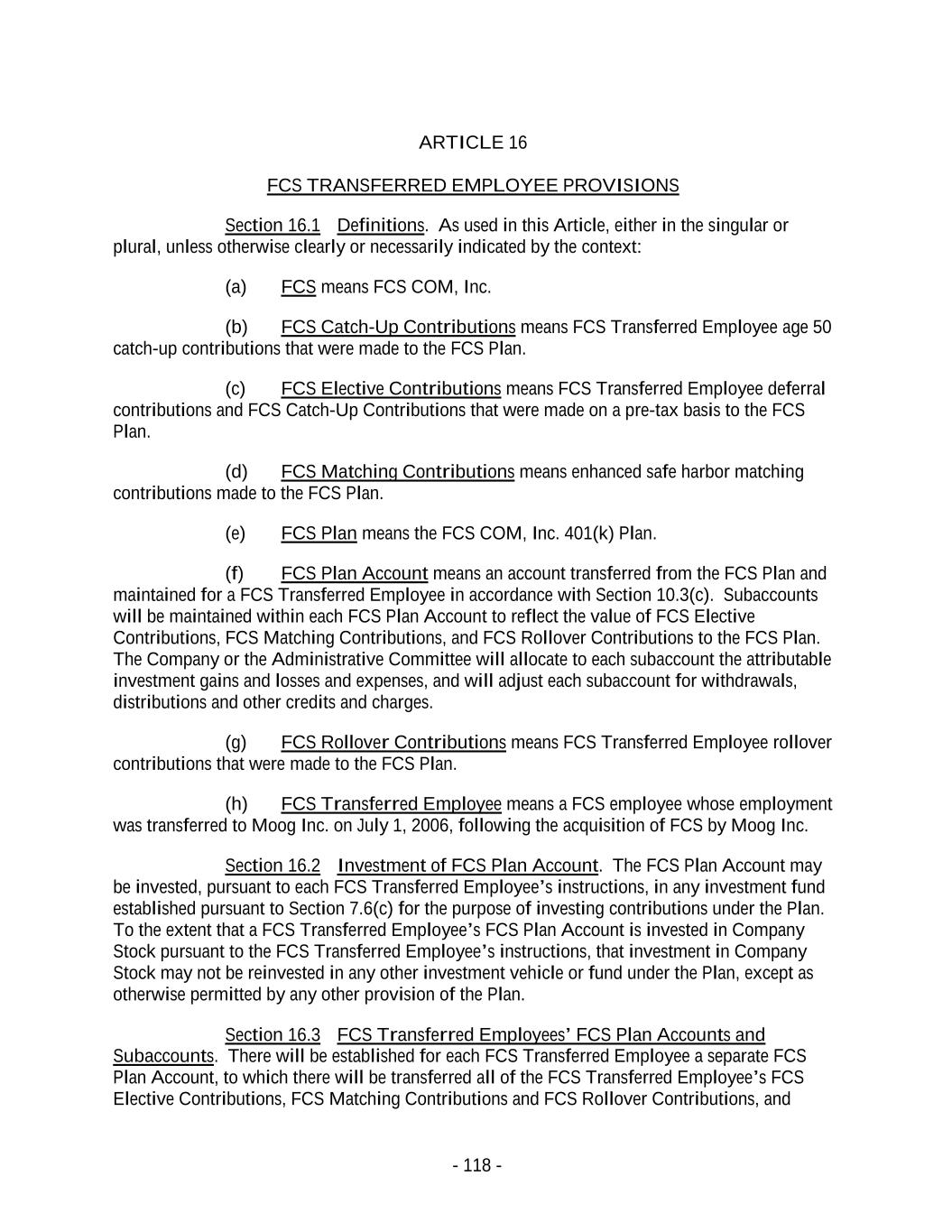
ARTICLE 16 FCS TRANSFERRED EMPLOYEE PROVISIONS Section 16.1 Definitions. As used in this Article, either in the singular or plural, unless otherwise clearly or necessarily indicated by the context: (a) FCS means FCS COM, Inc. (b) FCS Catch-Up Contributions means FCS Transferred Employee age 50 catch-up contributions that were made to the FCS Plan. (c) FCS Elective Contributions means FCS Transferred Employee deferral contributions and FCS Catch-Up Contributions that were made on a pre-tax basis to the FCS Plan. (d) FCS Matching Contributions means enhanced safe harbor matching contributions made to the FCS Plan. (e) FCS Plan means the FCS COM, Inc. 401(k) Plan. (f) FCS Plan Account means an account transferred from the FCS Plan and maintained for a FCS Transferred Employee in accordance with Section 10.3(c). Subaccounts will be maintained within each FCS Plan Account to reflect the value of FCS Elective Contributions, FCS Matching Contributions, and FCS Rollover Contributions to the FCS Plan. The Company or the Administrative Committee will allocate to each subaccount the attributable investment gains and losses and expenses, and will adjust each subaccount for withdrawals, distributions and other credits and charges. (g) FCS Rollover Contributions means FCS Transferred Employee rollover contributions that were made to the FCS Plan. (h) FCS Transferred Employee means a FCS employee whose employment was transferred to Moog Inc. on July 1, 2006, following the acquisition of FCS by Moog Inc. Section 16.2 Investment of FCS Plan Account. The FCS Plan Account may be invested, pursuant to each FCS Transferred Employee’s instructions, in any investment fund established pursuant to Section 7.6(c) for the purpose of investing contributions under the Plan. To the extent that a FCS Transferred Employee’s FCS Plan Account is invested in Company Stock pursuant to the FCS Transferred Employee’s instructions, that investment in Company Stock may not be reinvested in any other investment vehicle or fund under the Plan, except as otherwise permitted by any other provision of the Plan. Section 16.3 FCS Transferred Employees’ FCS Plan Accounts and Subaccounts. There will be established for each FCS Transferred Employee a separate FCS Plan Account, to which there will be transferred all of the FCS Transferred Employee’s FCS Elective Contributions, FCS Matching Contributions and FCS Rollover Contributions, and - 118 -
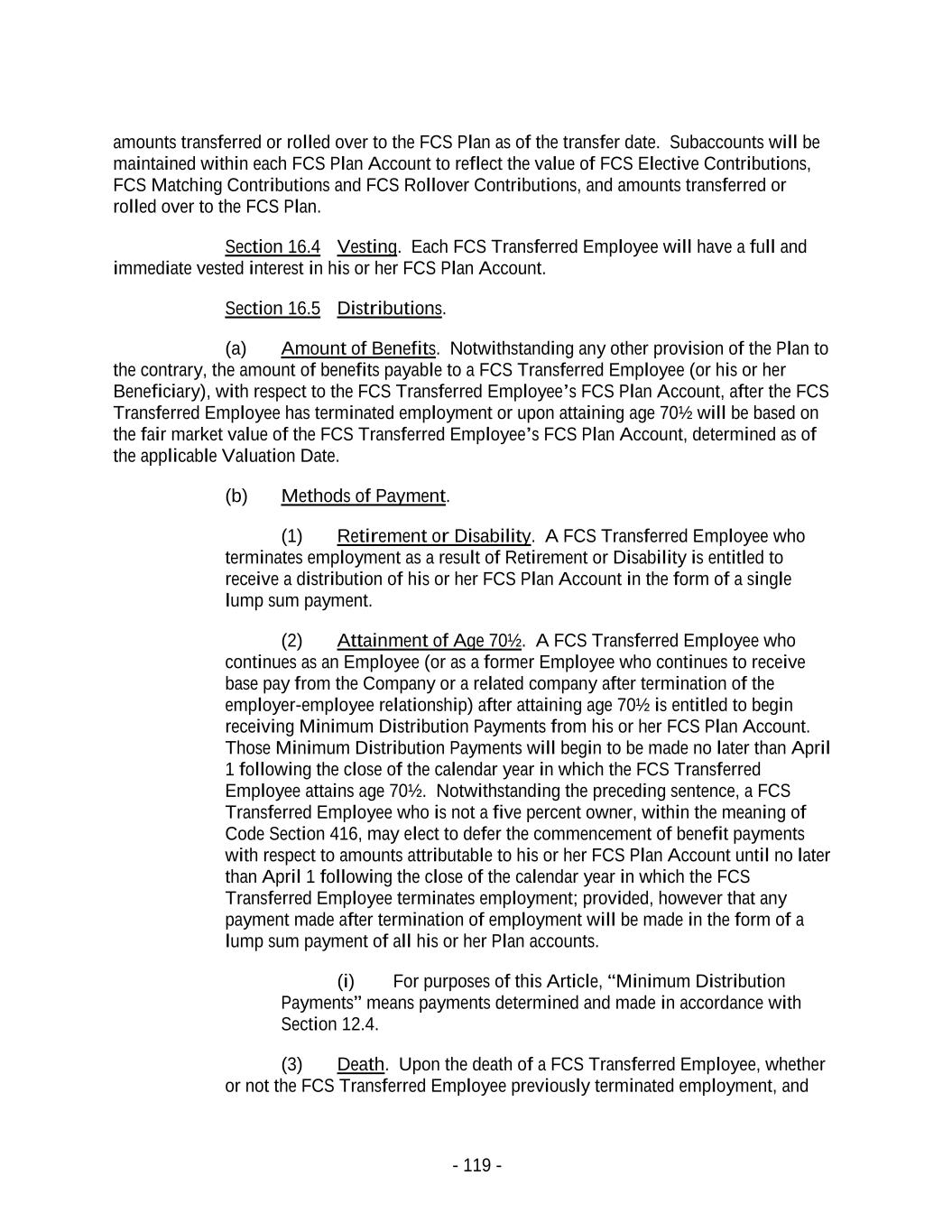
amounts transferred or rolled over to the FCS Plan as of the transfer date. Subaccounts will be maintained within each FCS Plan Account to reflect the value of FCS Elective Contributions, FCS Matching Contributions and FCS Rollover Contributions, and amounts transferred or rolled over to the FCS Plan. Section 16.4 Vesting. Each FCS Transferred Employee will have a full and immediate vested interest in his or her FCS Plan Account. Section 16.5 Distributions. (a) Amount of Benefits. Notwithstanding any other provision of the Plan to the contrary, the amount of benefits payable to a FCS Transferred Employee (or his or her Beneficiary), with respect to the FCS Transferred Employee’s FCS Plan Account, after the FCS Transferred Employee has terminated employment or upon attaining age 70½ will be based on the fair market value of the FCS Transferred Employee’s FCS Plan Account, determined as of the applicable Valuation Date. (b) Methods of Payment. (1) Retirement or Disability. A FCS Transferred Employee who terminates employment as a result of Retirement or Disability is entitled to receive a distribution of his or her FCS Plan Account in the form of a single lump sum payment. (2) Attainment of Age 70½. A FCS Transferred Employee who continues as an Employee (or as a former Employee who continues to receive base pay from the Company or a related company after termination of the employer-employee relationship) after attaining age 70½ is entitled to begin receiving Minimum Distribution Payments from his or her FCS Plan Account. Those Minimum Distribution Payments will begin to be made no later than April 1 following the close of the calendar year in which the FCS Transferred Employee attains age 70½. Notwithstanding the preceding sentence, a FCS Transferred Employee who is not a five percent owner, within the meaning of Code Section 416, may elect to defer the commencement of benefit payments with respect to amounts attributable to his or her FCS Plan Account until no later than April 1 following the close of the calendar year in which the FCS Transferred Employee terminates employment; provided, however that any payment made after termination of employment will be made in the form of a lump sum payment of all his or her Plan accounts. (i) For purposes of this Article, “Minimum Distribution Payments” means payments determined and made in accordance with Section 12.4. (3) Death. Upon the death of a FCS Transferred Employee, whether or not the FCS Transferred Employee previously terminated employment, and - 119 -

whether or not distribution of the FCS Transferred Employee’s FCS Plan Account has previously commenced, there will be distributed, in a single lump sum payment, to the FCS Transferred Employee’s Beneficiary, as soon as practicable, but in no event later than one year after the close of the calendar year of the FCS Transferred Employee’s death, the entire remaining FCS Plan Account of the FCS Transferred Employee. Notwithstanding the preceding sentence, if the FCS Transferred Employee’s sole designated Beneficiary is his or her surviving spouse, the surviving spouse may withhold consent and defer payment of the benefits in accordance with, and to the extent permitted by, Section 5.5(a). (4) Termination of Employment for Reasons other than Retirement, Disability or Death. A FCS Transferred Employee who terminates employment for a reason other than Retirement, Disability or Death is entitled to receive a distribution of his or her FCS Plan Account in a single lump sum payment. (c) Cash-Outs. Notwithstanding subsection (b) above, if the combined value of a FCS Transferred Employee’s FCS Plan Account and his or her other accounts under the Plan as of the Valuation Date immediately preceding the FCS Transferred Employee’s termination of employment does not exceed $1,000, the FCS Transferred Employee will receive an immediate single payment of his or her accounts as soon thereafter as administratively practical. Section 16.6 Withdrawals. (a) Withdrawals from FCS Plan Account. A FCS Transferred Employee who is on the payroll of an Employer may elect to withdraw from his or her FCS Plan Account in accordance with the provisions of this Section. Withdrawals hereunder will be made pro rata from the investment funds in which the respective subaccounts are invested. A FCS Transferred Employee’s election to withdraw any amounts from the Plan must be satisfied by withdrawing from his or her FCS Plan Account in accordance with this Section before withdrawing any amounts from his or her other accounts under the Plan. (1) Post-Age 59½ Withdrawals -- FCS Elective and Rollover Contributions. A FCS Transferred Employee who has attained age 59½, but who has not incurred a Severance from Employment, may elect to withdraw all or part of his or her FCS Elective Contributions and FCS Rollover Contributions, and the earnings thereon, by request filed with the Plan Administrator. Upon payment of the withdrawal by the Plan, the Plan Administrator will charge the Participant’s FCS Plan Account with the amount of the withdrawal. (2) Pre-Age 59½ Hardship Withdrawals. Distribution of part or all of a FCS Transferred Employee’s FCS Elective Contributions and the earnings thereon (to the extent permitted under the Plan) may occur pursuant to the financial hardship provisions of Section 5.13(d). - 120 -
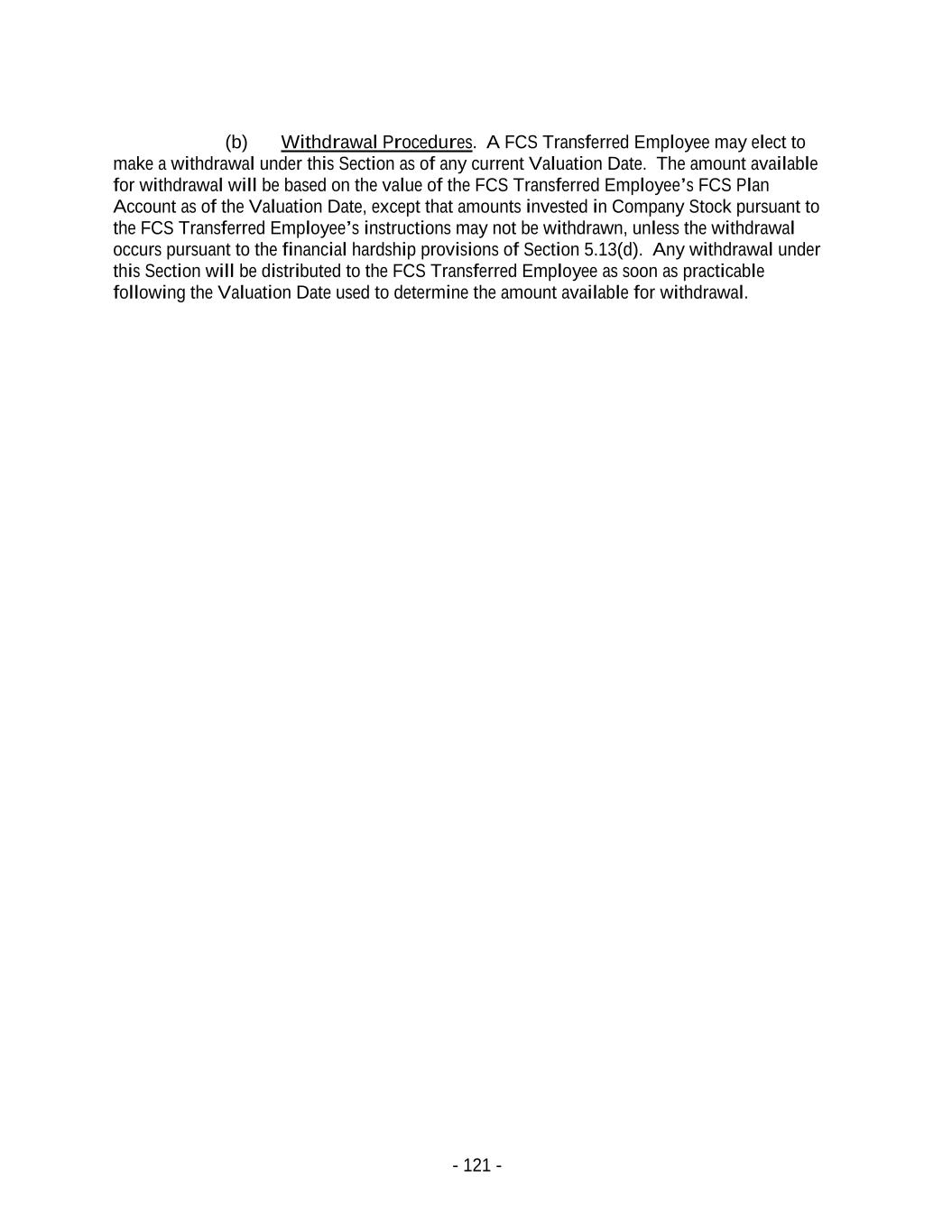
(b) Withdrawal Procedures. A FCS Transferred Employee may elect to make a withdrawal under this Section as of any current Valuation Date. The amount available for withdrawal will be based on the value of the FCS Transferred Employee’s FCS Plan Account as of the Valuation Date, except that amounts invested in Company Stock pursuant to the FCS Transferred Employee’s instructions may not be withdrawn, unless the withdrawal occurs pursuant to the financial hardship provisions of Section 5.13(d). Any withdrawal under this Section will be distributed to the FCS Transferred Employee as soon as practicable following the Valuation Date used to determine the amount available for withdrawal. - 121 -
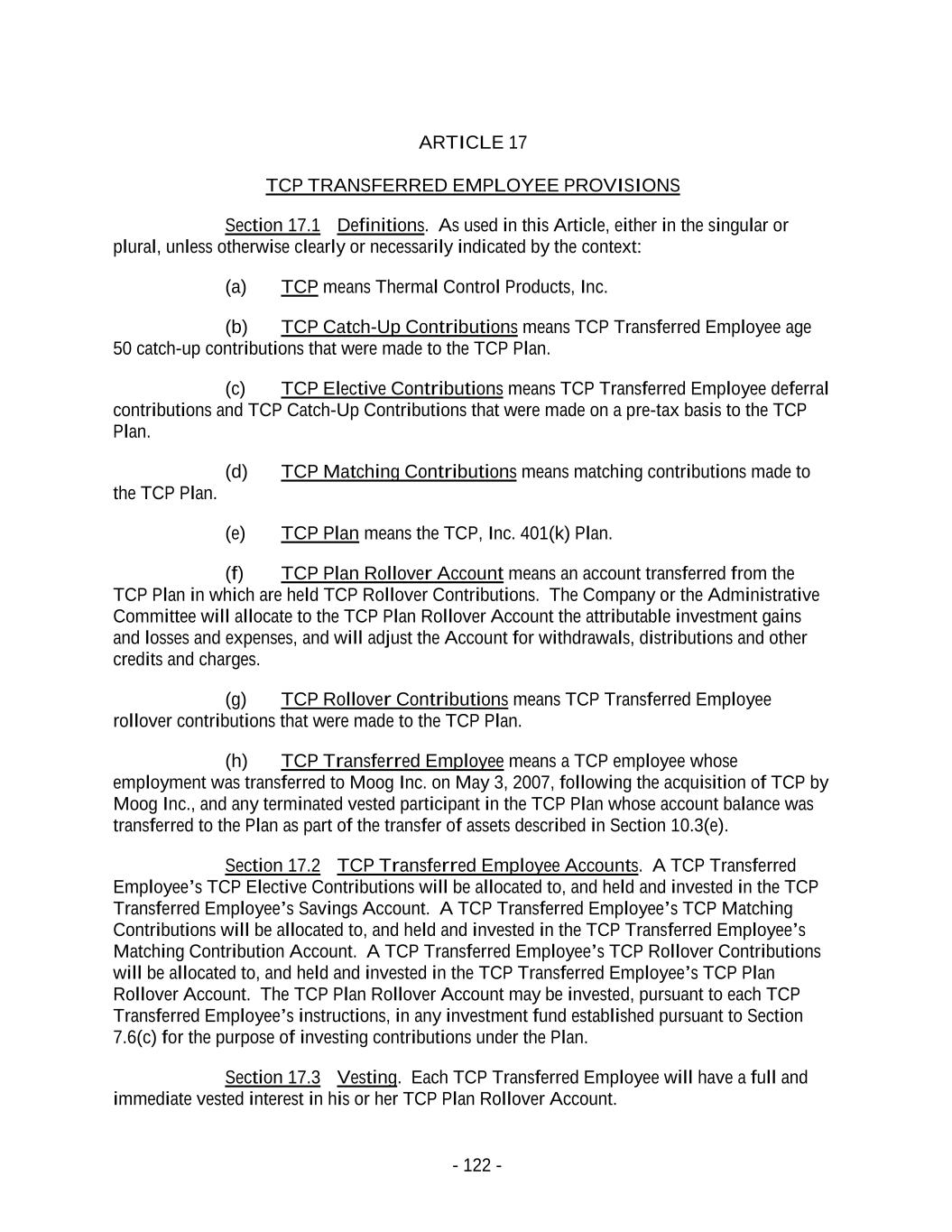
ARTICLE 17 TCP TRANSFERRED EMPLOYEE PROVISIONS Section 17.1 Definitions. As used in this Article, either in the singular or plural, unless otherwise clearly or necessarily indicated by the context: (a) TCP means Thermal Control Products, Inc. (b) TCP Catch-Up Contributions means TCP Transferred Employee age 50 catch-up contributions that were made to the TCP Plan. (c) TCP Elective Contributions means TCP Transferred Employee deferral contributions and TCP Catch-Up Contributions that were made on a pre-tax basis to the TCP Plan. (d) TCP Matching Contributions means matching contributions made to the TCP Plan. (e) TCP Plan means the TCP, Inc. 401(k) Plan. (f) TCP Plan Rollover Account means an account transferred from the TCP Plan in which are held TCP Rollover Contributions. The Company or the Administrative Committee will allocate to the TCP Plan Rollover Account the attributable investment gains and losses and expenses, and will adjust the Account for withdrawals, distributions and other credits and charges. (g) TCP Rollover Contributions means TCP Transferred Employee rollover contributions that were made to the TCP Plan. (h) TCP Transferred Employee means a TCP employee whose employment was transferred to Moog Inc. on May 3, 2007, following the acquisition of TCP by Moog Inc., and any terminated vested participant in the TCP Plan whose account balance was transferred to the Plan as part of the transfer of assets described in Section 10.3(e). Section 17.2 TCP Transferred Employee Accounts. A TCP Transferred Employee’s TCP Elective Contributions will be allocated to, and held and invested in the TCP Transferred Employee’s Savings Account. A TCP Transferred Employee’s TCP Matching Contributions will be allocated to, and held and invested in the TCP Transferred Employee’s Matching Contribution Account. A TCP Transferred Employee’s TCP Rollover Contributions will be allocated to, and held and invested in the TCP Transferred Employee’s TCP Plan Rollover Account. The TCP Plan Rollover Account may be invested, pursuant to each TCP Transferred Employee’s instructions, in any investment fund established pursuant to Section 7.6(c) for the purpose of investing contributions under the Plan. Section 17.3 Vesting. Each TCP Transferred Employee will have a full and immediate vested interest in his or her TCP Plan Rollover Account. - 122 -
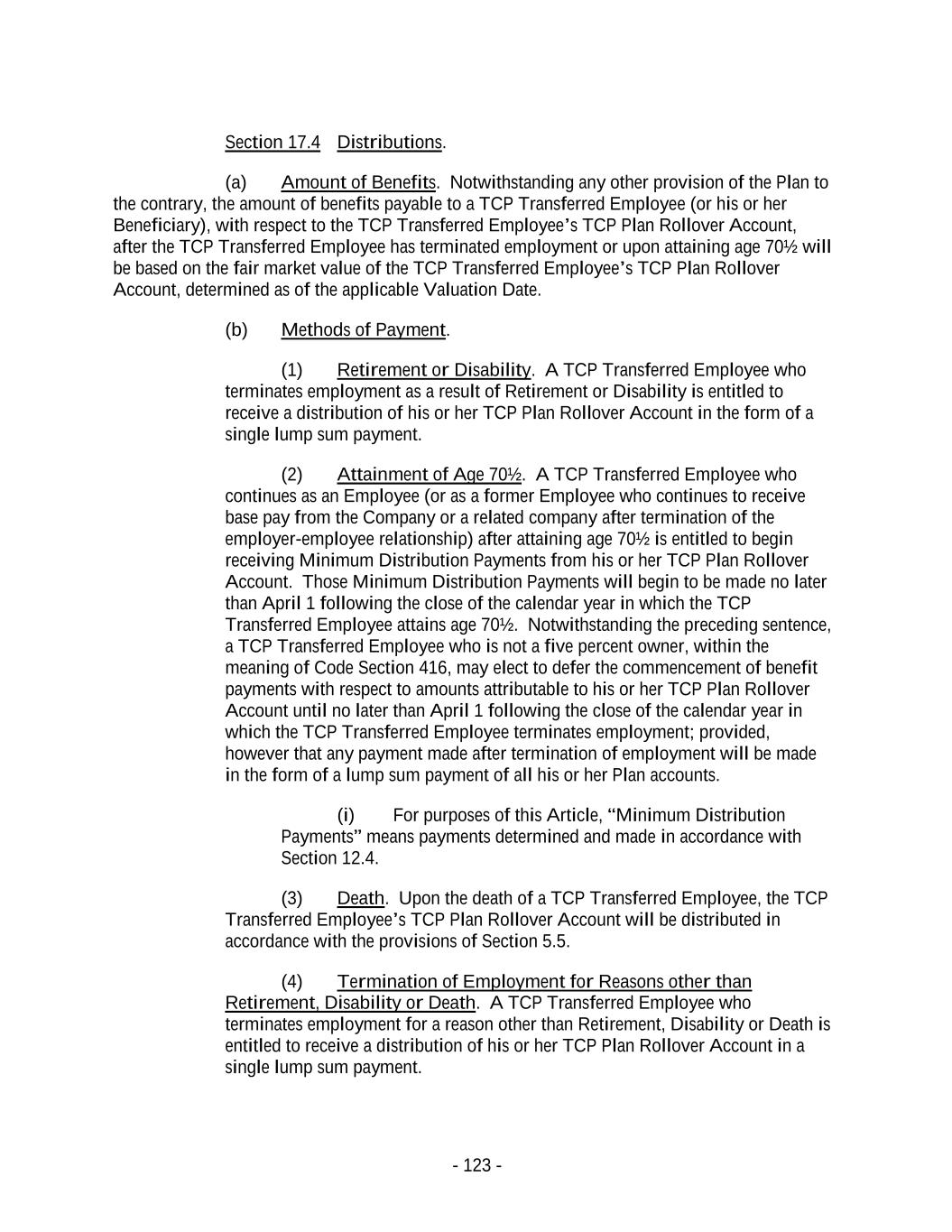
Section 17.4 Distributions. (a) Amount of Benefits. Notwithstanding any other provision of the Plan to the contrary, the amount of benefits payable to a TCP Transferred Employee (or his or her Beneficiary), with respect to the TCP Transferred Employee’s TCP Plan Rollover Account, after the TCP Transferred Employee has terminated employment or upon attaining age 70½ will be based on the fair market value of the TCP Transferred Employee’s TCP Plan Rollover Account, determined as of the applicable Valuation Date. (b) Methods of Payment. (1) Retirement or Disability. A TCP Transferred Employee who terminates employment as a result of Retirement or Disability is entitled to receive a distribution of his or her TCP Plan Rollover Account in the form of a single lump sum payment. (2) Attainment of Age 70½. A TCP Transferred Employee who continues as an Employee (or as a former Employee who continues to receive base pay from the Company or a related company after termination of the employer-employee relationship) after attaining age 70½ is entitled to begin receiving Minimum Distribution Payments from his or her TCP Plan Rollover Account. Those Minimum Distribution Payments will begin to be made no later than April 1 following the close of the calendar year in which the TCP Transferred Employee attains age 70½. Notwithstanding the preceding sentence, a TCP Transferred Employee who is not a five percent owner, within the meaning of Code Section 416, may elect to defer the commencement of benefit payments with respect to amounts attributable to his or her TCP Plan Rollover Account until no later than April 1 following the close of the calendar year in which the TCP Transferred Employee terminates employment; provided, however that any payment made after termination of employment will be made in the form of a lump sum payment of all his or her Plan accounts. (i) For purposes of this Article, “Minimum Distribution Payments” means payments determined and made in accordance with Section 12.4. (3) Death. Upon the death of a TCP Transferred Employee, the TCP Transferred Employee’s TCP Plan Rollover Account will be distributed in accordance with the provisions of Section 5.5. (4) Termination of Employment for Reasons other than Retirement, Disability or Death. A TCP Transferred Employee who terminates employment for a reason other than Retirement, Disability or Death is entitled to receive a distribution of his or her TCP Plan Rollover Account in a single lump sum payment. - 123 -

(c) Cash-Outs. Notwithstanding subsection (b) above, if the combined value of a TCP Transferred Employee’s TCP Plan Rollover Account and his or her other accounts under the Plan as of the Valuation Date immediately preceding the TCP Transferred Employee’s termination of employment does not exceed $1,000, the TCP Transferred Employee will receive an immediate single payment of his or her accounts as soon thereafter as administratively practical. Section 17.5 Withdrawals. (a) Withdrawals from TCP Plan Rollover Account. A TCP Transferred Employee who is on the payroll of a Company may elect to withdraw from his or her TCP Plan Rollover Account at any time in accordance with the provisions of this Section. Withdrawals hereunder will be made pro rata from the investment funds in which the TCP Plan Rollover Account is invested. (b) Withdrawal Procedures. A TCP Transferred Employee may elect to make a withdrawal under this Section as of any current Valuation Date. The amount available for withdrawal will be based on the value of the TCP Transferred Employee’s TCP Plan Rollover Account as of the Valuation Date, unless the withdrawal occurs pursuant to the financial hardship provisions of Section 5.13(d). Any withdrawal under this Section will be distributed to the TCP Transferred Employee as soon as practicable following the Valuation Date used to determine the amount available for withdrawal. Section 17.6 Plan Loans. For purposes of administering the Plan loan provisions of Section 5.14, a TCP Transferred Employee’s TCP Plan Rollover Account will be available as a source for a Plan loan made to a TCP Transferred Employee. - 124 -
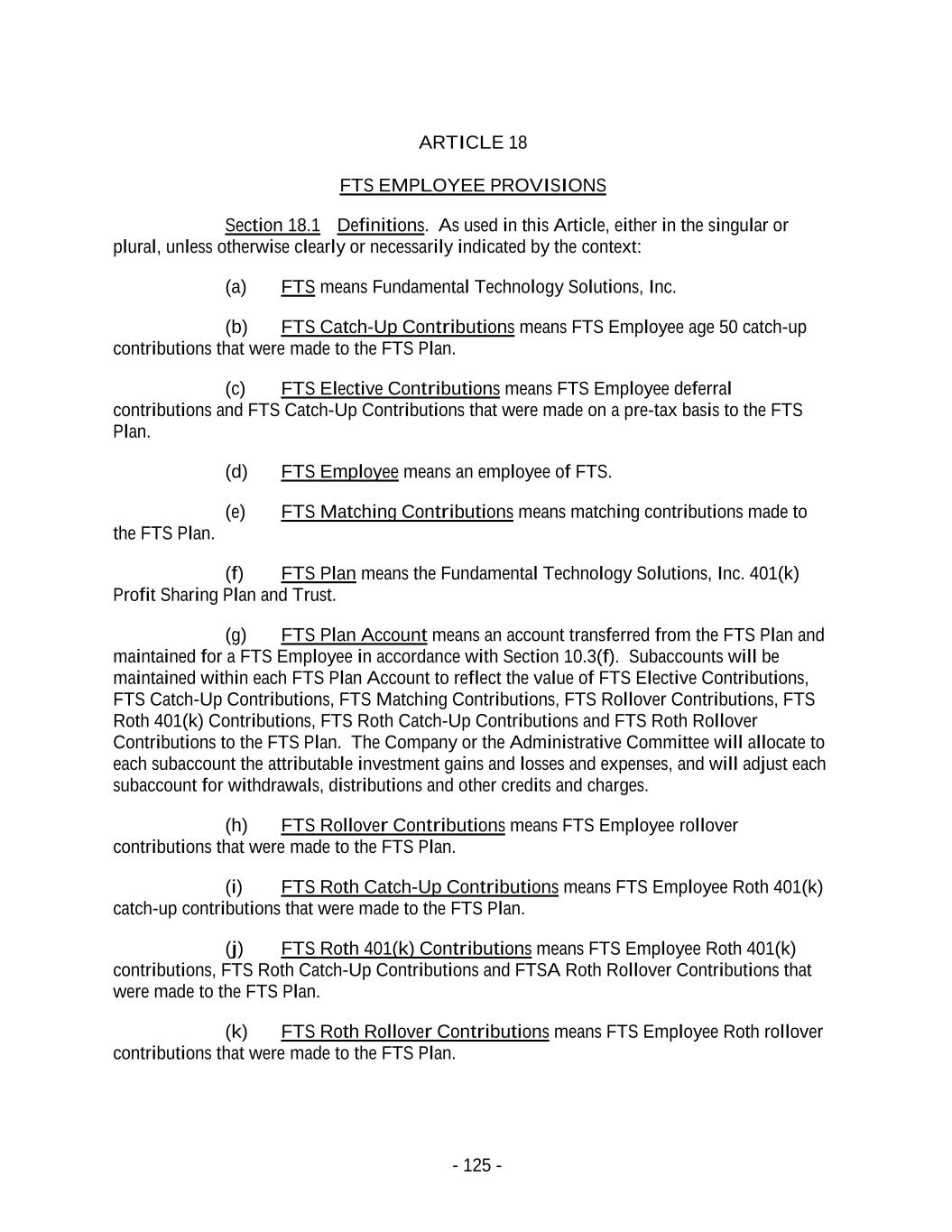
ARTICLE 18 FTS EMPLOYEE PROVISIONS Section 18.1 Definitions. As used in this Article, either in the singular or plural, unless otherwise clearly or necessarily indicated by the context: (a) FTS means Fundamental Technology Solutions, Inc. (b) FTS Catch-Up Contributions means FTS Employee age 50 catch-up contributions that were made to the FTS Plan. (c) FTS Elective Contributions means FTS Employee deferral contributions and FTS Catch-Up Contributions that were made on a pre-tax basis to the FTS Plan. (d) FTS Employee means an employee of FTS. (e) FTS Matching Contributions means matching contributions made to the FTS Plan. (f) FTS Plan means the Fundamental Technology Solutions, Inc. 401(k) Profit Sharing Plan and Trust. (g) FTS Plan Account means an account transferred from the FTS Plan and maintained for a FTS Employee in accordance with Section 10.3(f). Subaccounts will be maintained within each FTS Plan Account to reflect the value of FTS Elective Contributions, FTS Catch-Up Contributions, FTS Matching Contributions, FTS Rollover Contributions, FTS Roth 401(k) Contributions, FTS Roth Catch-Up Contributions and FTS Roth Rollover Contributions to the FTS Plan. The Company or the Administrative Committee will allocate to each subaccount the attributable investment gains and losses and expenses, and will adjust each subaccount for withdrawals, distributions and other credits and charges. (h) FTS Rollover Contributions means FTS Employee rollover contributions that were made to the FTS Plan. (i) FTS Roth Catch-Up Contributions means FTS Employee Roth 401(k) catch-up contributions that were made to the FTS Plan. (j) FTS Roth 401(k) Contributions means FTS Employee Roth 401(k) contributions, FTS Roth Catch-Up Contributions and FTSA Roth Rollover Contributions that were made to the FTS Plan. (k) FTS Roth Rollover Contributions means FTS Employee Roth rollover contributions that were made to the FTS Plan. - 125 -
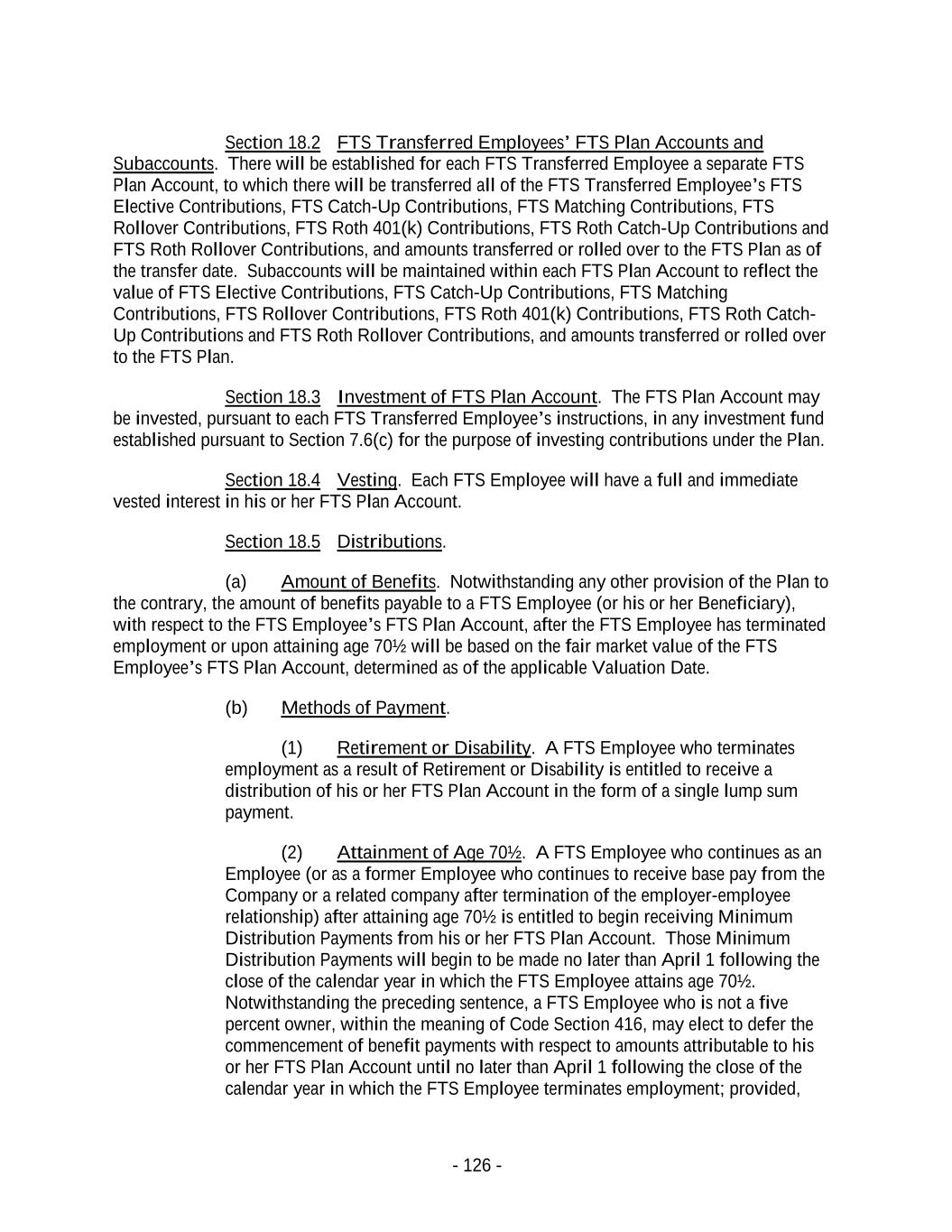
Section 18.2 FTS Transferred Employees’ FTS Plan Accounts and Subaccounts. There will be established for each FTS Transferred Employee a separate FTS Plan Account, to which there will be transferred all of the FTS Transferred Employee’s FTS Elective Contributions, FTS Catch-Up Contributions, FTS Matching Contributions, FTS Rollover Contributions, FTS Roth 401(k) Contributions, FTS Roth Catch-Up Contributions and FTS Roth Rollover Contributions, and amounts transferred or rolled over to the FTS Plan as of the transfer date. Subaccounts will be maintained within each FTS Plan Account to reflect the value of FTS Elective Contributions, FTS Catch-Up Contributions, FTS Matching Contributions, FTS Rollover Contributions, FTS Roth 401(k) Contributions, FTS Roth Catch- Up Contributions and FTS Roth Rollover Contributions, and amounts transferred or rolled over to the FTS Plan. Section 18.3 Investment of FTS Plan Account. The FTS Plan Account may be invested, pursuant to each FTS Transferred Employee’s instructions, in any investment fund established pursuant to Section 7.6(c) for the purpose of investing contributions under the Plan. Section 18.4 Vesting. Each FTS Employee will have a full and immediate vested interest in his or her FTS Plan Account. Section 18.5 Distributions. (a) Amount of Benefits. Notwithstanding any other provision of the Plan to the contrary, the amount of benefits payable to a FTS Employee (or his or her Beneficiary), with respect to the FTS Employee’s FTS Plan Account, after the FTS Employee has terminated employment or upon attaining age 70½ will be based on the fair market value of the FTS Employee’s FTS Plan Account, determined as of the applicable Valuation Date. (b) Methods of Payment. (1) Retirement or Disability. A FTS Employee who terminates employment as a result of Retirement or Disability is entitled to receive a distribution of his or her FTS Plan Account in the form of a single lump sum payment. (2) Attainment of Age 70½. A FTS Employee who continues as an Employee (or as a former Employee who continues to receive base pay from the Company or a related company after termination of the employer-employee relationship) after attaining age 70½ is entitled to begin receiving Minimum Distribution Payments from his or her FTS Plan Account. Those Minimum Distribution Payments will begin to be made no later than April 1 following the close of the calendar year in which the FTS Employee attains age 70½. Notwithstanding the preceding sentence, a FTS Employee who is not a five percent owner, within the meaning of Code Section 416, may elect to defer the commencement of benefit payments with respect to amounts attributable to his or her FTS Plan Account until no later than April 1 following the close of the calendar year in which the FTS Employee terminates employment; provided, - 126 -
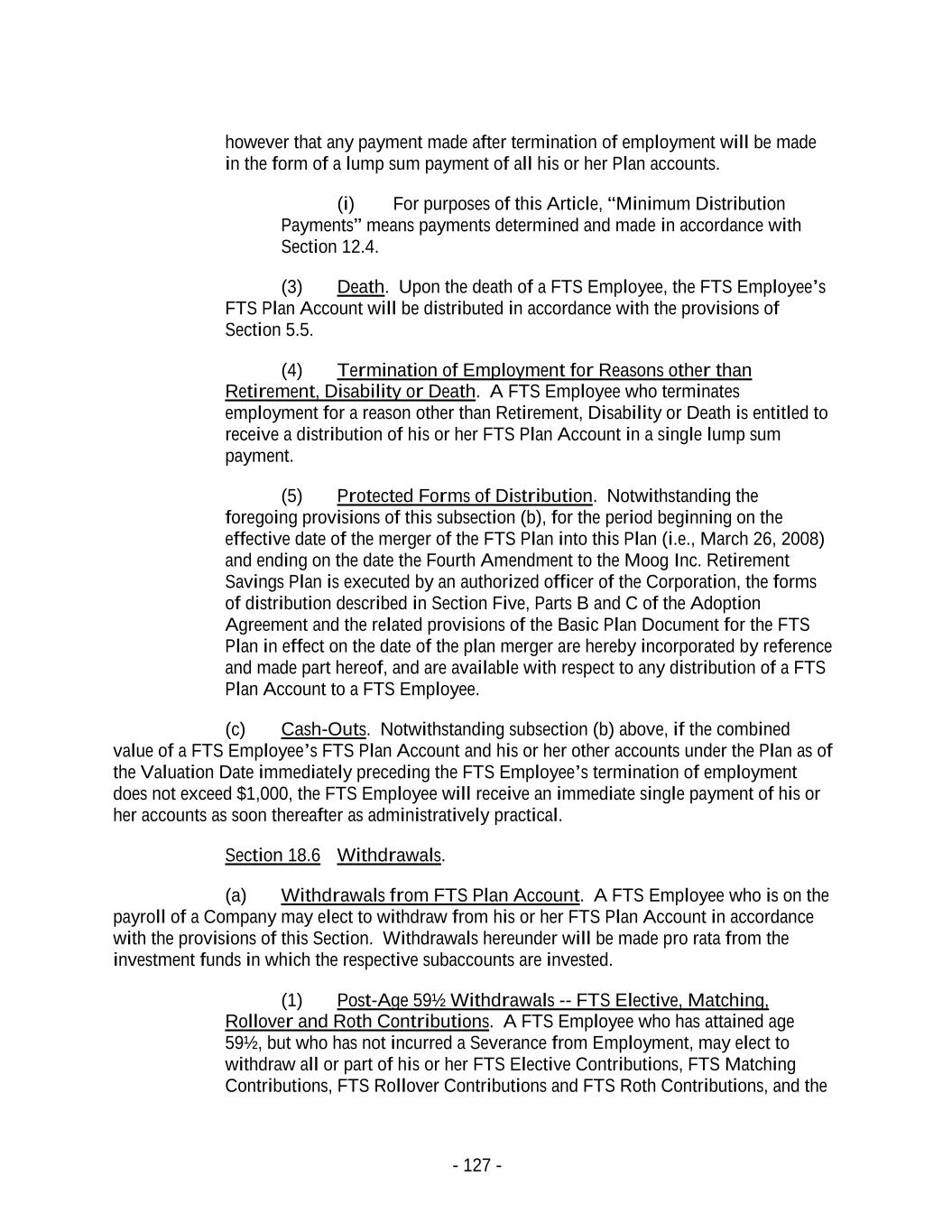
however that any payment made after termination of employment will be made in the form of a lump sum payment of all his or her Plan accounts. (i) For purposes of this Article, “Minimum Distribution Payments” means payments determined and made in accordance with Section 12.4. (3) Death. Upon the death of a FTS Employee, the FTS Employee’s FTS Plan Account will be distributed in accordance with the provisions of Section 5.5. (4) Termination of Employment for Reasons other than Retirement, Disability or Death. A FTS Employee who terminates employment for a reason other than Retirement, Disability or Death is entitled to receive a distribution of his or her FTS Plan Account in a single lump sum payment. (5) Protected Forms of Distribution. Notwithstanding the foregoing provisions of this subsection (b), for the period beginning on the effective date of the merger of the FTS Plan into this Plan (i.e., March 26, 2008) and ending on the date the Fourth Amendment to the Moog Inc. Retirement Savings Plan is executed by an authorized officer of the Corporation, the forms of distribution described in Section Five, Parts B and C of the Adoption Agreement and the related provisions of the Basic Plan Document for the FTS Plan in effect on the date of the plan merger are hereby incorporated by reference and made part hereof, and are available with respect to any distribution of a FTS Plan Account to a FTS Employee. (c) Cash-Outs. Notwithstanding subsection (b) above, if the combined value of a FTS Employee’s FTS Plan Account and his or her other accounts under the Plan as of the Valuation Date immediately preceding the FTS Employee’s termination of employment does not exceed $1,000, the FTS Employee will receive an immediate single payment of his or her accounts as soon thereafter as administratively practical. Section 18.6 Withdrawals. (a) Withdrawals from FTS Plan Account. A FTS Employee who is on the payroll of a Company may elect to withdraw from his or her FTS Plan Account in accordance with the provisions of this Section. Withdrawals hereunder will be made pro rata from the investment funds in which the respective subaccounts are invested. (1) Post-Age 59½ Withdrawals -- FTS Elective, Matching, Rollover and Roth Contributions. A FTS Employee who has attained age 59½, but who has not incurred a Severance from Employment, may elect to withdraw all or part of his or her FTS Elective Contributions, FTS Matching Contributions, FTS Rollover Contributions and FTS Roth Contributions, and the - 127 -
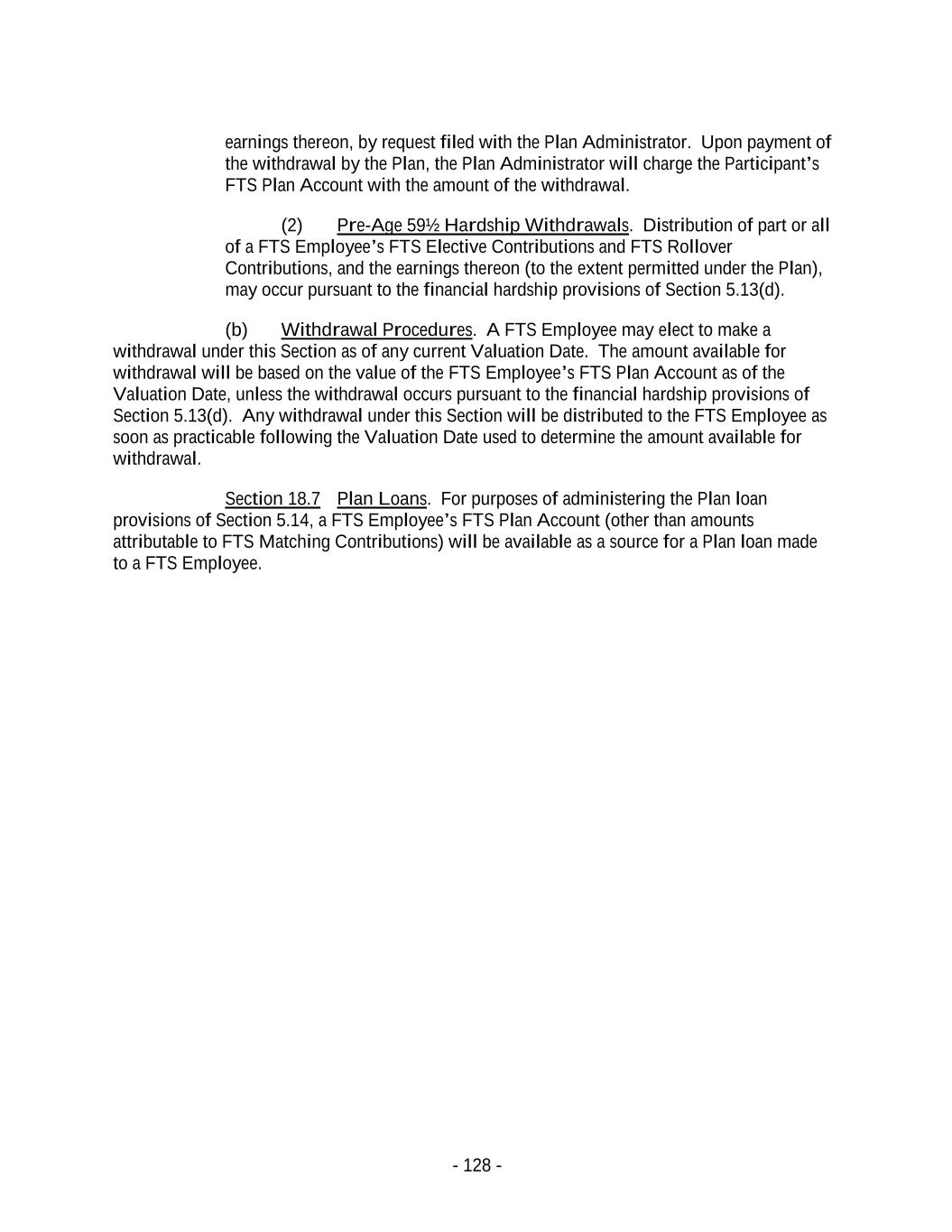
earnings thereon, by request filed with the Plan Administrator. Upon payment of the withdrawal by the Plan, the Plan Administrator will charge the Participant’s FTS Plan Account with the amount of the withdrawal. (2) Pre-Age 59½ Hardship Withdrawals. Distribution of part or all of a FTS Employee’s FTS Elective Contributions and FTS Rollover Contributions, and the earnings thereon (to the extent permitted under the Plan), may occur pursuant to the financial hardship provisions of Section 5.13(d). (b) Withdrawal Procedures. A FTS Employee may elect to make a withdrawal under this Section as of any current Valuation Date. The amount available for withdrawal will be based on the value of the FTS Employee’s FTS Plan Account as of the Valuation Date, unless the withdrawal occurs pursuant to the financial hardship provisions of Section 5.13(d). Any withdrawal under this Section will be distributed to the FTS Employee as soon as practicable following the Valuation Date used to determine the amount available for withdrawal. Section 18.7 Plan Loans. For purposes of administering the Plan loan provisions of Section 5.14, a FTS Employee’s FTS Plan Account (other than amounts attributable to FTS Matching Contributions) will be available as a source for a Plan loan made to a FTS Employee. - 128 -
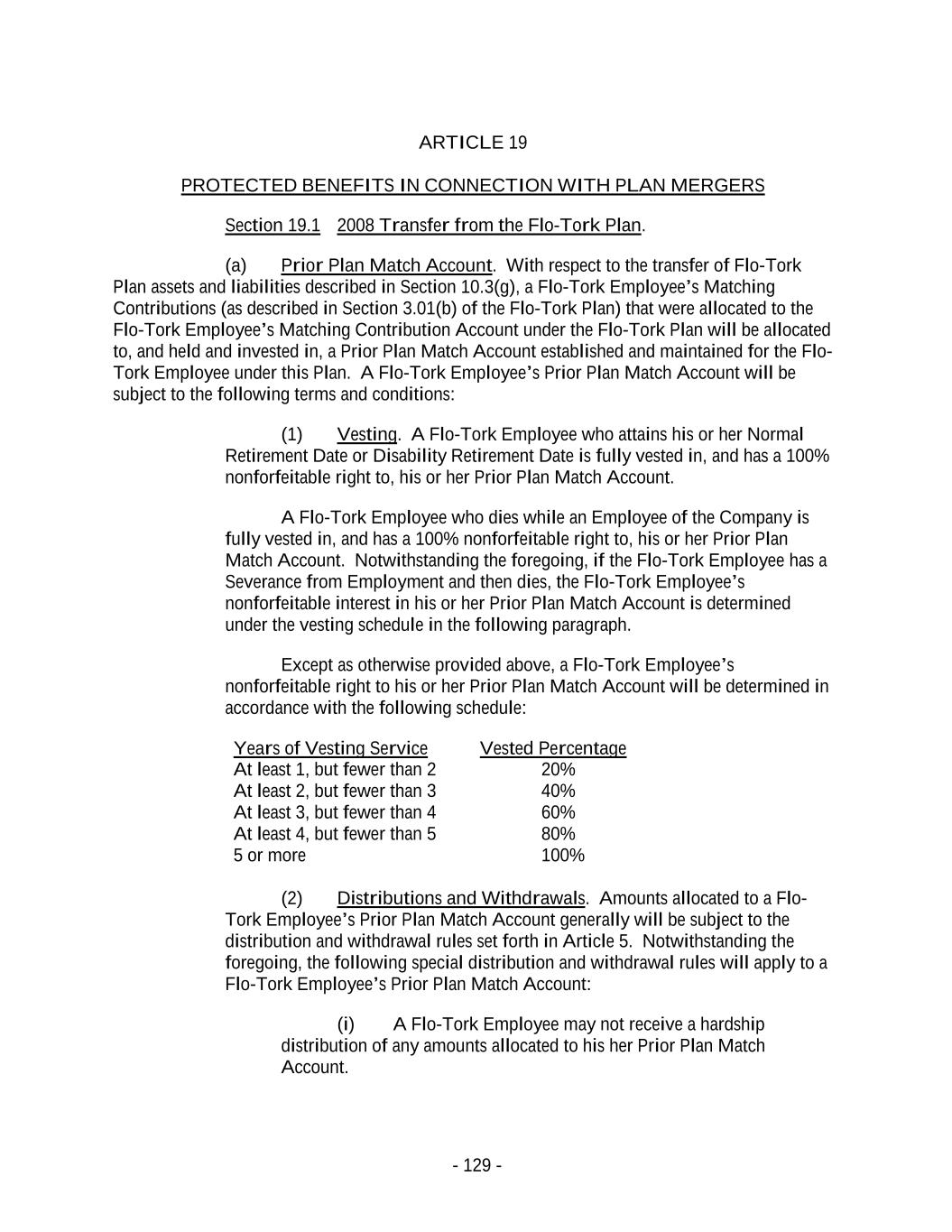
ARTICLE 19 PROTECTED BENEFITS IN CONNECTION WITH PLAN MERGERS Section 19.1 2008 Transfer from the Flo-Tork Plan. (a) Prior Plan Match Account. With respect to the transfer of Flo-Tork Plan assets and liabilities described in Section 10.3(g), a Flo-Tork Employee’s Matching Contributions (as described in Section 3.01(b) of the Flo-Tork Plan) that were allocated to the Flo-Tork Employee’s Matching Contribution Account under the Flo-Tork Plan will be allocated to, and held and invested in, a Prior Plan Match Account established and maintained for the Flo- Tork Employee under this Plan. A Flo-Tork Employee’s Prior Plan Match Account will be subject to the following terms and conditions: (1) Vesting. A Flo-Tork Employee who attains his or her Normal Retirement Date or Disability Retirement Date is fully vested in, and has a 100% nonforfeitable right to, his or her Prior Plan Match Account. A Flo-Tork Employee who dies while an Employee of the Company is fully vested in, and has a 100% nonforfeitable right to, his or her Prior Plan Match Account. Notwithstanding the foregoing, if the Flo-Tork Employee has a Severance from Employment and then dies, the Flo-Tork Employee’s nonforfeitable interest in his or her Prior Plan Match Account is determined under the vesting schedule in the following paragraph. Except as otherwise provided above, a Flo-Tork Employee’s nonforfeitable right to his or her Prior Plan Match Account will be determined in accordance with the following schedule: Years of Vesting Service Vested Percentage At least 1, but fewer than 2 20% At least 2, but fewer than 3 40% At least 3, but fewer than 4 60% At least 4, but fewer than 5 80% 5 or more 100% (2) Distributions and Withdrawals. Amounts allocated to a Flo- Tork Employee’s Prior Plan Match Account generally will be subject to the distribution and withdrawal rules set forth in Article 5. Notwithstanding the foregoing, the following special distribution and withdrawal rules will apply to a Flo-Tork Employee’s Prior Plan Match Account: (i) A Flo-Tork Employee may not receive a hardship distribution of any amounts allocated to his her Prior Plan Match Account. - 129 -
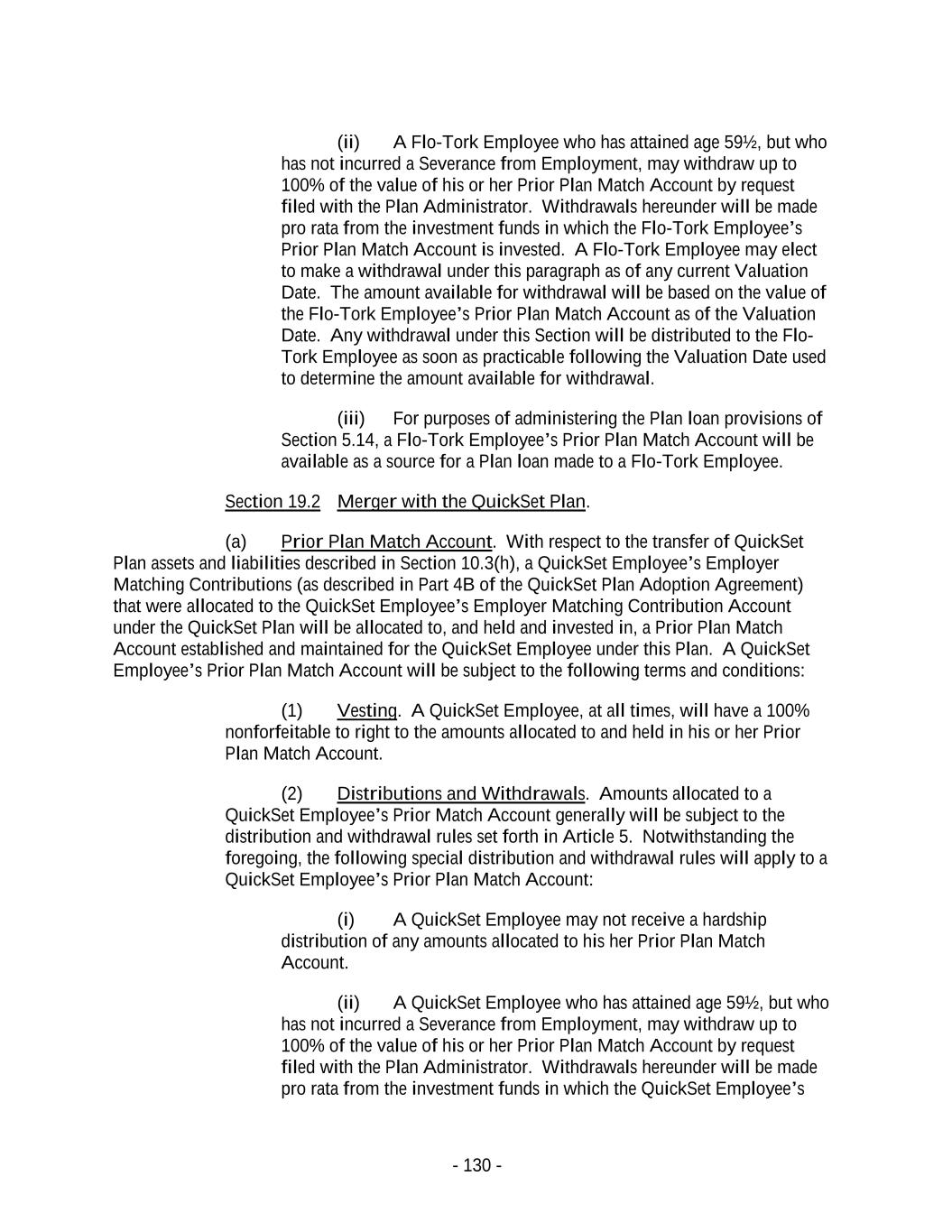
(ii) A Flo-Tork Employee who has attained age 59½, but who has not incurred a Severance from Employment, may withdraw up to 100% of the value of his or her Prior Plan Match Account by request filed with the Plan Administrator. Withdrawals hereunder will be made pro rata from the investment funds in which the Flo-Tork Employee’s Prior Plan Match Account is invested. A Flo-Tork Employee may elect to make a withdrawal under this paragraph as of any current Valuation Date. The amount available for withdrawal will be based on the value of the Flo-Tork Employee’s Prior Plan Match Account as of the Valuation Date. Any withdrawal under this Section will be distributed to the Flo- Tork Employee as soon as practicable following the Valuation Date used to determine the amount available for withdrawal. (iii) For purposes of administering the Plan loan provisions of Section 5.14, a Flo-Tork Employee’s Prior Plan Match Account will be available as a source for a Plan loan made to a Flo-Tork Employee. Section 19.2 Merger with the QuickSet Plan. (a) Prior Plan Match Account. With respect to the transfer of QuickSet Plan assets and liabilities described in Section 10.3(h), a QuickSet Employee’s Employer Matching Contributions (as described in Part 4B of the QuickSet Plan Adoption Agreement) that were allocated to the QuickSet Employee’s Employer Matching Contribution Account under the QuickSet Plan will be allocated to, and held and invested in, a Prior Plan Match Account established and maintained for the QuickSet Employee under this Plan. A QuickSet Employee’s Prior Plan Match Account will be subject to the following terms and conditions: (1) Vesting. A QuickSet Employee, at all times, will have a 100% nonforfeitable to right to the amounts allocated to and held in his or her Prior Plan Match Account. (2) Distributions and Withdrawals. Amounts allocated to a QuickSet Employee’s Prior Match Account generally will be subject to the distribution and withdrawal rules set forth in Article 5. Notwithstanding the foregoing, the following special distribution and withdrawal rules will apply to a QuickSet Employee’s Prior Plan Match Account: (i) A QuickSet Employee may not receive a hardship distribution of any amounts allocated to his her Prior Plan Match Account. (ii) A QuickSet Employee who has attained age 59½, but who has not incurred a Severance from Employment, may withdraw up to 100% of the value of his or her Prior Plan Match Account by request filed with the Plan Administrator. Withdrawals hereunder will be made pro rata from the investment funds in which the QuickSet Employee’s - 130 -
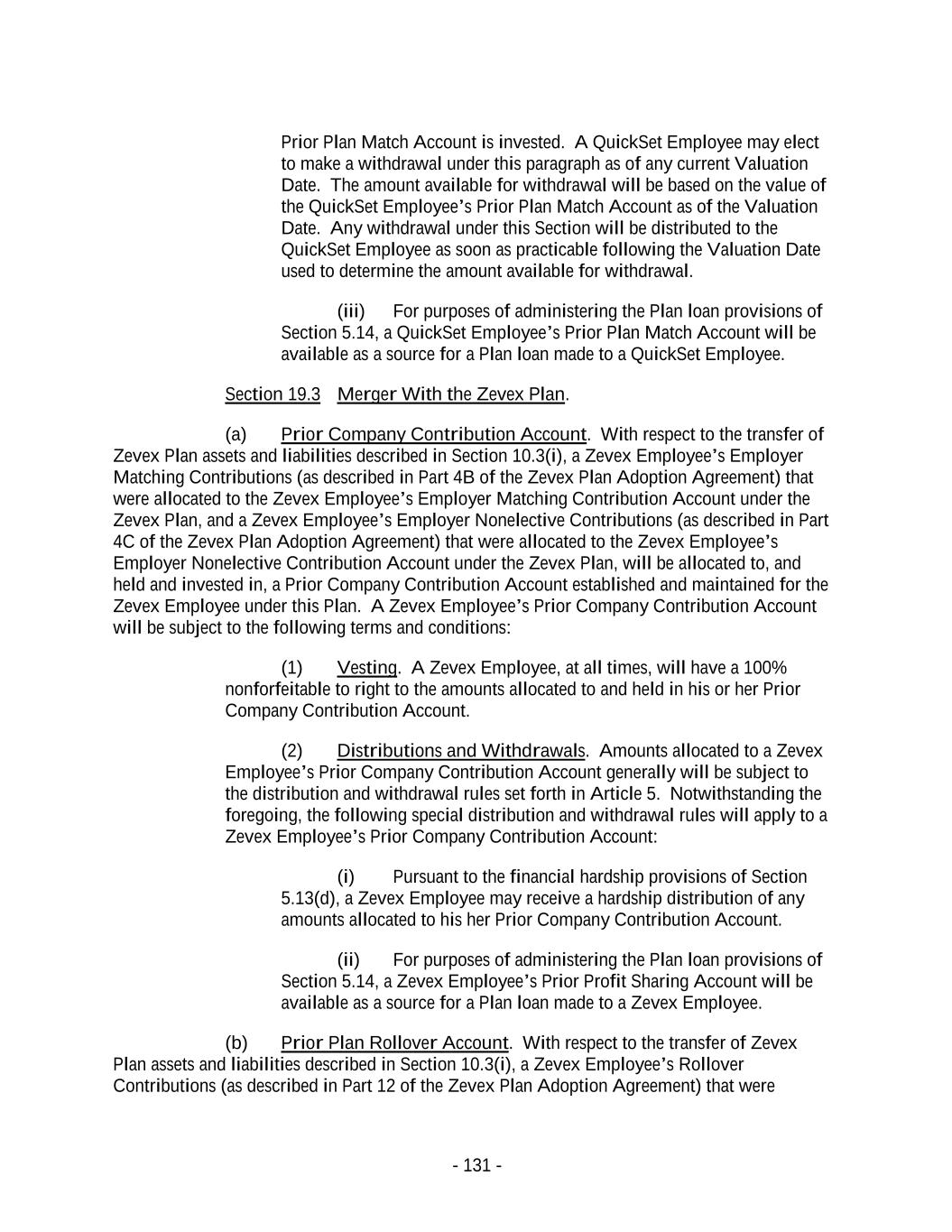
Prior Plan Match Account is invested. A QuickSet Employee may elect to make a withdrawal under this paragraph as of any current Valuation Date. The amount available for withdrawal will be based on the value of the QuickSet Employee’s Prior Plan Match Account as of the Valuation Date. Any withdrawal under this Section will be distributed to the QuickSet Employee as soon as practicable following the Valuation Date used to determine the amount available for withdrawal. (iii) For purposes of administering the Plan loan provisions of Section 5.14, a QuickSet Employee’s Prior Plan Match Account will be available as a source for a Plan loan made to a QuickSet Employee. Section 19.3 Merger With the Zevex Plan. (a) Prior Company Contribution Account. With respect to the transfer of Zevex Plan assets and liabilities described in Section 10.3(i), a Zevex Employee’s Employer Matching Contributions (as described in Part 4B of the Zevex Plan Adoption Agreement) that were allocated to the Zevex Employee’s Employer Matching Contribution Account under the Zevex Plan, and a Zevex Employee’s Employer Nonelective Contributions (as described in Part 4C of the Zevex Plan Adoption Agreement) that were allocated to the Zevex Employee’s Employer Nonelective Contribution Account under the Zevex Plan, will be allocated to, and held and invested in, a Prior Company Contribution Account established and maintained for the Zevex Employee under this Plan. A Zevex Employee’s Prior Company Contribution Account will be subject to the following terms and conditions: (1) Vesting. A Zevex Employee, at all times, will have a 100% nonforfeitable to right to the amounts allocated to and held in his or her Prior Company Contribution Account. (2) Distributions and Withdrawals. Amounts allocated to a Zevex Employee’s Prior Company Contribution Account generally will be subject to the distribution and withdrawal rules set forth in Article 5. Notwithstanding the foregoing, the following special distribution and withdrawal rules will apply to a Zevex Employee’s Prior Company Contribution Account: (i) Pursuant to the financial hardship provisions of Section 5.13(d), a Zevex Employee may receive a hardship distribution of any amounts allocated to his her Prior Company Contribution Account. (ii) For purposes of administering the Plan loan provisions of Section 5.14, a Zevex Employee’s Prior Profit Sharing Account will be available as a source for a Plan loan made to a Zevex Employee. (b) Prior Plan Rollover Account. With respect to the transfer of Zevex Plan assets and liabilities described in Section 10.3(i), a Zevex Employee’s Rollover Contributions (as described in Part 12 of the Zevex Plan Adoption Agreement) that were - 131 -
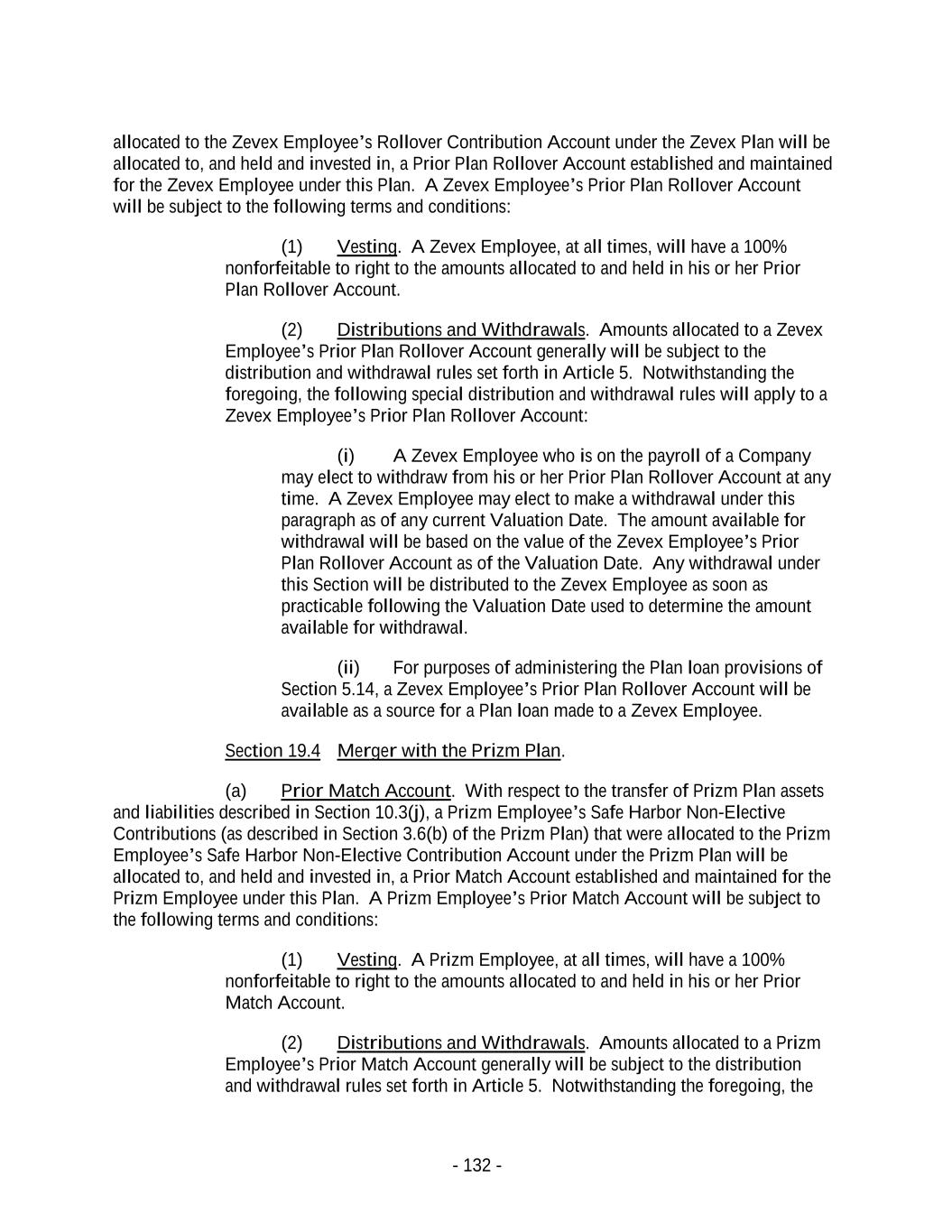
allocated to the Zevex Employee’s Rollover Contribution Account under the Zevex Plan will be allocated to, and held and invested in, a Prior Plan Rollover Account established and maintained for the Zevex Employee under this Plan. A Zevex Employee’s Prior Plan Rollover Account will be subject to the following terms and conditions: (1) Vesting. A Zevex Employee, at all times, will have a 100% nonforfeitable to right to the amounts allocated to and held in his or her Prior Plan Rollover Account. (2) Distributions and Withdrawals. Amounts allocated to a Zevex Employee’s Prior Plan Rollover Account generally will be subject to the distribution and withdrawal rules set forth in Article 5. Notwithstanding the foregoing, the following special distribution and withdrawal rules will apply to a Zevex Employee’s Prior Plan Rollover Account: (i) A Zevex Employee who is on the payroll of a Company may elect to withdraw from his or her Prior Plan Rollover Account at any time. A Zevex Employee may elect to make a withdrawal under this paragraph as of any current Valuation Date. The amount available for withdrawal will be based on the value of the Zevex Employee’s Prior Plan Rollover Account as of the Valuation Date. Any withdrawal under this Section will be distributed to the Zevex Employee as soon as practicable following the Valuation Date used to determine the amount available for withdrawal. (ii) For purposes of administering the Plan loan provisions of Section 5.14, a Zevex Employee’s Prior Plan Rollover Account will be available as a source for a Plan loan made to a Zevex Employee. Section 19.4 Merger with the Prizm Plan. (a) Prior Match Account. With respect to the transfer of Prizm Plan assets and liabilities described in Section 10.3(j), a Prizm Employee’s Safe Harbor Non-Elective Contributions (as described in Section 3.6(b) of the Prizm Plan) that were allocated to the Prizm Employee’s Safe Harbor Non-Elective Contribution Account under the Prizm Plan will be allocated to, and held and invested in, a Prior Match Account established and maintained for the Prizm Employee under this Plan. A Prizm Employee’s Prior Match Account will be subject to the following terms and conditions: (1) Vesting. A Prizm Employee, at all times, will have a 100% nonforfeitable to right to the amounts allocated to and held in his or her Prior Match Account. (2) Distributions and Withdrawals. Amounts allocated to a Prizm Employee’s Prior Match Account generally will be subject to the distribution and withdrawal rules set forth in Article 5. Notwithstanding the foregoing, the - 132 -
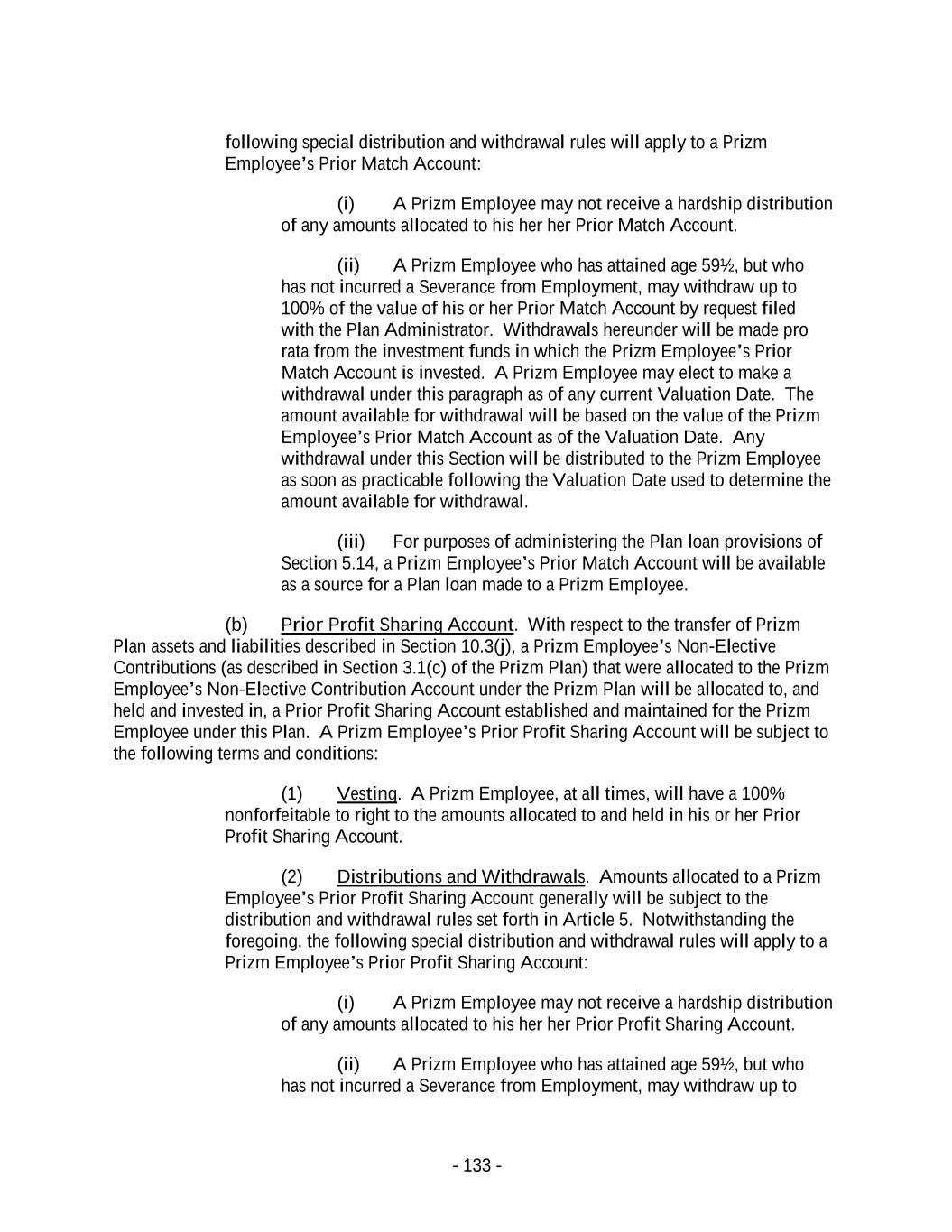
following special distribution and withdrawal rules will apply to a Prizm Employee’s Prior Match Account: (i) A Prizm Employee may not receive a hardship distribution of any amounts allocated to his her her Prior Match Account. (ii) A Prizm Employee who has attained age 59½, but who has not incurred a Severance from Employment, may withdraw up to 100% of the value of his or her Prior Match Account by request filed with the Plan Administrator. Withdrawals hereunder will be made pro rata from the investment funds in which the Prizm Employee’s Prior Match Account is invested. A Prizm Employee may elect to make a withdrawal under this paragraph as of any current Valuation Date. The amount available for withdrawal will be based on the value of the Prizm Employee’s Prior Match Account as of the Valuation Date. Any withdrawal under this Section will be distributed to the Prizm Employee as soon as practicable following the Valuation Date used to determine the amount available for withdrawal. (iii) For purposes of administering the Plan loan provisions of Section 5.14, a Prizm Employee’s Prior Match Account will be available as a source for a Plan loan made to a Prizm Employee. (b) Prior Profit Sharing Account. With respect to the transfer of Prizm Plan assets and liabilities described in Section 10.3(j), a Prizm Employee’s Non-Elective Contributions (as described in Section 3.1(c) of the Prizm Plan) that were allocated to the Prizm Employee’s Non-Elective Contribution Account under the Prizm Plan will be allocated to, and held and invested in, a Prior Profit Sharing Account established and maintained for the Prizm Employee under this Plan. A Prizm Employee’s Prior Profit Sharing Account will be subject to the following terms and conditions: (1) Vesting. A Prizm Employee, at all times, will have a 100% nonforfeitable to right to the amounts allocated to and held in his or her Prior Profit Sharing Account. (2) Distributions and Withdrawals. Amounts allocated to a Prizm Employee’s Prior Profit Sharing Account generally will be subject to the distribution and withdrawal rules set forth in Article 5. Notwithstanding the foregoing, the following special distribution and withdrawal rules will apply to a Prizm Employee’s Prior Profit Sharing Account: (i) A Prizm Employee may not receive a hardship distribution of any amounts allocated to his her her Prior Profit Sharing Account. (ii) A Prizm Employee who has attained age 59½, but who has not incurred a Severance from Employment, may withdraw up to - 133 -
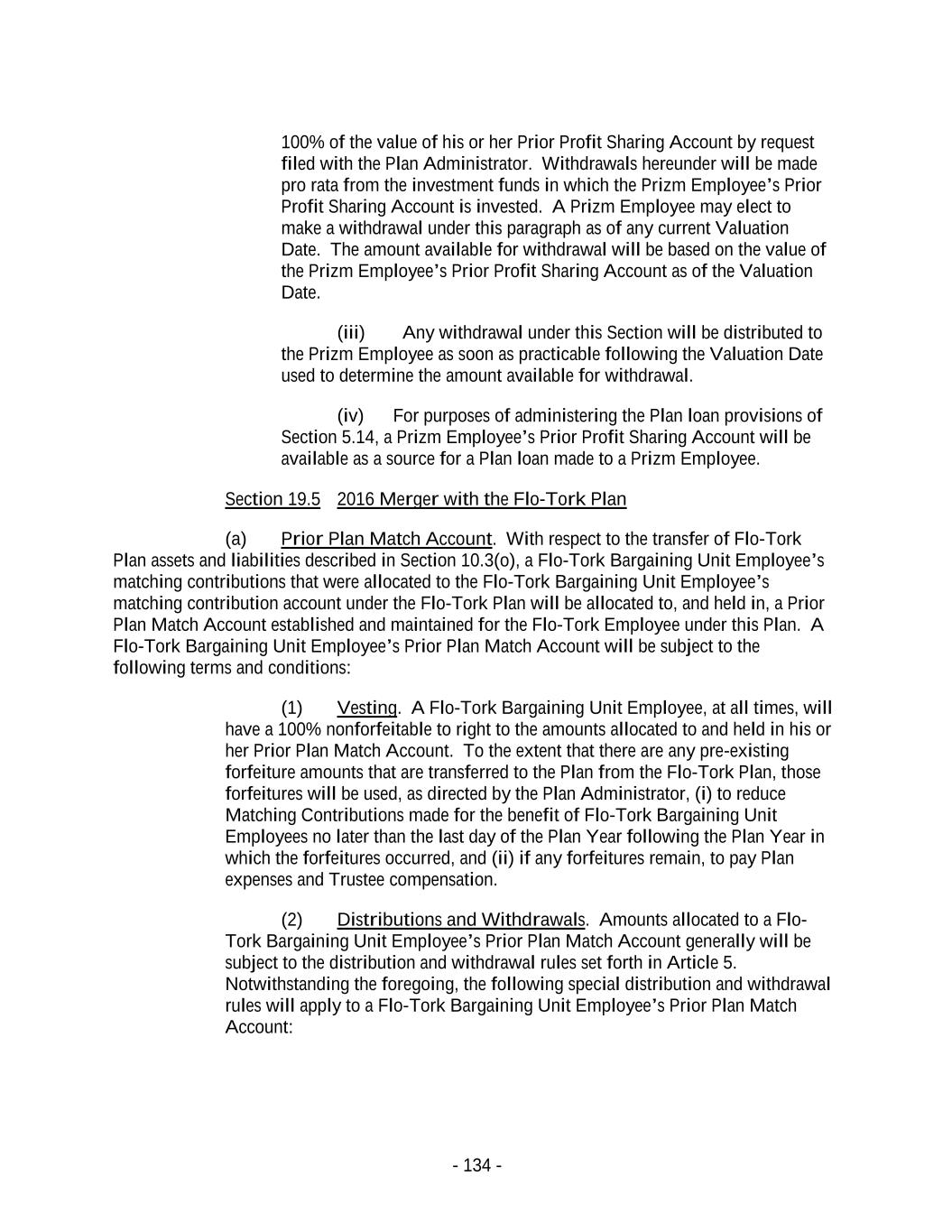
100% of the value of his or her Prior Profit Sharing Account by request filed with the Plan Administrator. Withdrawals hereunder will be made pro rata from the investment funds in which the Prizm Employee’s Prior Profit Sharing Account is invested. A Prizm Employee may elect to make a withdrawal under this paragraph as of any current Valuation Date. The amount available for withdrawal will be based on the value of the Prizm Employee’s Prior Profit Sharing Account as of the Valuation Date. (iii) Any withdrawal under this Section will be distributed to the Prizm Employee as soon as practicable following the Valuation Date used to determine the amount available for withdrawal. (iv) For purposes of administering the Plan loan provisions of Section 5.14, a Prizm Employee’s Prior Profit Sharing Account will be available as a source for a Plan loan made to a Prizm Employee. Section 19.5 2016 Merger with the Flo-Tork Plan (a) Prior Plan Match Account. With respect to the transfer of Flo-Tork Plan assets and liabilities described in Section 10.3(o), a Flo-Tork Bargaining Unit Employee’s matching contributions that were allocated to the Flo-Tork Bargaining Unit Employee’s matching contribution account under the Flo-Tork Plan will be allocated to, and held in, a Prior Plan Match Account established and maintained for the Flo-Tork Employee under this Plan. A Flo-Tork Bargaining Unit Employee’s Prior Plan Match Account will be subject to the following terms and conditions: (1) Vesting. A Flo-Tork Bargaining Unit Employee, at all times, will have a 100% nonforfeitable to right to the amounts allocated to and held in his or her Prior Plan Match Account. To the extent that there are any pre-existing forfeiture amounts that are transferred to the Plan from the Flo-Tork Plan, those forfeitures will be used, as directed by the Plan Administrator, (i) to reduce Matching Contributions made for the benefit of Flo-Tork Bargaining Unit Employees no later than the last day of the Plan Year following the Plan Year in which the forfeitures occurred, and (ii) if any forfeitures remain, to pay Plan expenses and Trustee compensation. (2) Distributions and Withdrawals. Amounts allocated to a Flo- Tork Bargaining Unit Employee’s Prior Plan Match Account generally will be subject to the distribution and withdrawal rules set forth in Article 5. Notwithstanding the foregoing, the following special distribution and withdrawal rules will apply to a Flo-Tork Bargaining Unit Employee’s Prior Plan Match Account: - 134 -
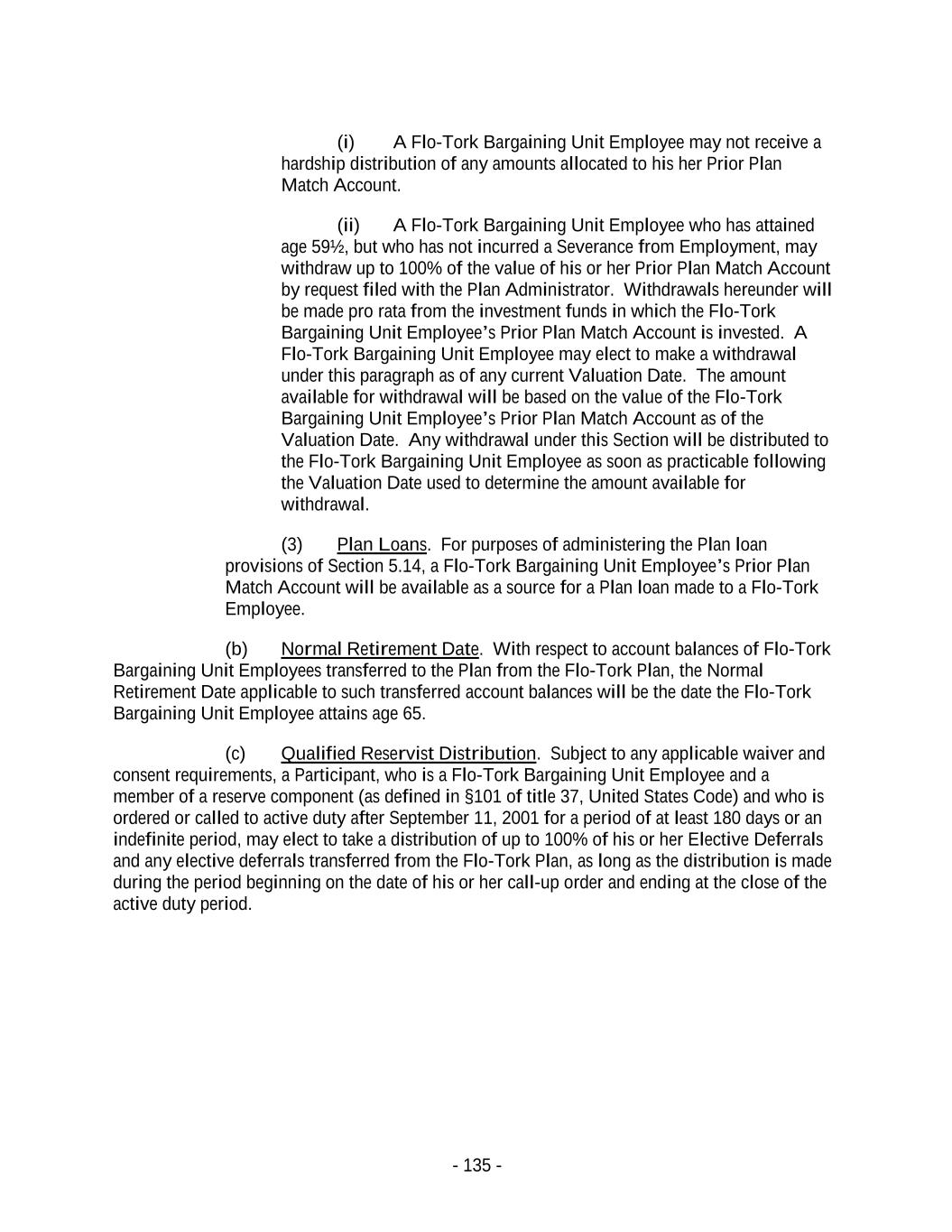
(i) A Flo-Tork Bargaining Unit Employee may not receive a hardship distribution of any amounts allocated to his her Prior Plan Match Account. (ii) A Flo-Tork Bargaining Unit Employee who has attained age 59½, but who has not incurred a Severance from Employment, may withdraw up to 100% of the value of his or her Prior Plan Match Account by request filed with the Plan Administrator. Withdrawals hereunder will be made pro rata from the investment funds in which the Flo-Tork Bargaining Unit Employee’s Prior Plan Match Account is invested. A Flo-Tork Bargaining Unit Employee may elect to make a withdrawal under this paragraph as of any current Valuation Date. The amount available for withdrawal will be based on the value of the Flo-Tork Bargaining Unit Employee’s Prior Plan Match Account as of the Valuation Date. Any withdrawal under this Section will be distributed to the Flo-Tork Bargaining Unit Employee as soon as practicable following the Valuation Date used to determine the amount available for withdrawal. (3) Plan Loans. For purposes of administering the Plan loan provisions of Section 5.14, a Flo-Tork Bargaining Unit Employee’s Prior Plan Match Account will be available as a source for a Plan loan made to a Flo-Tork Employee. (b) Normal Retirement Date. With respect to account balances of Flo-Tork Bargaining Unit Employees transferred to the Plan from the Flo-Tork Plan, the Normal Retirement Date applicable to such transferred account balances will be the date the Flo-Tork Bargaining Unit Employee attains age 65. (c) Qualified Reservist Distribution. Subject to any applicable waiver and consent requirements, a Participant, who is a Flo-Tork Bargaining Unit Employee and a member of a reserve component (as defined in §101 of title 37, United States Code) and who is ordered or called to active duty after September 11, 2001 for a period of at least 180 days or an indefinite period, may elect to take a distribution of up to 100% of his or her Elective Deferrals and any elective deferrals transferred from the Flo-Tork Plan, as long as the distribution is made during the period beginning on the date of his or her call-up order and ending at the close of the active duty period. - 135 -
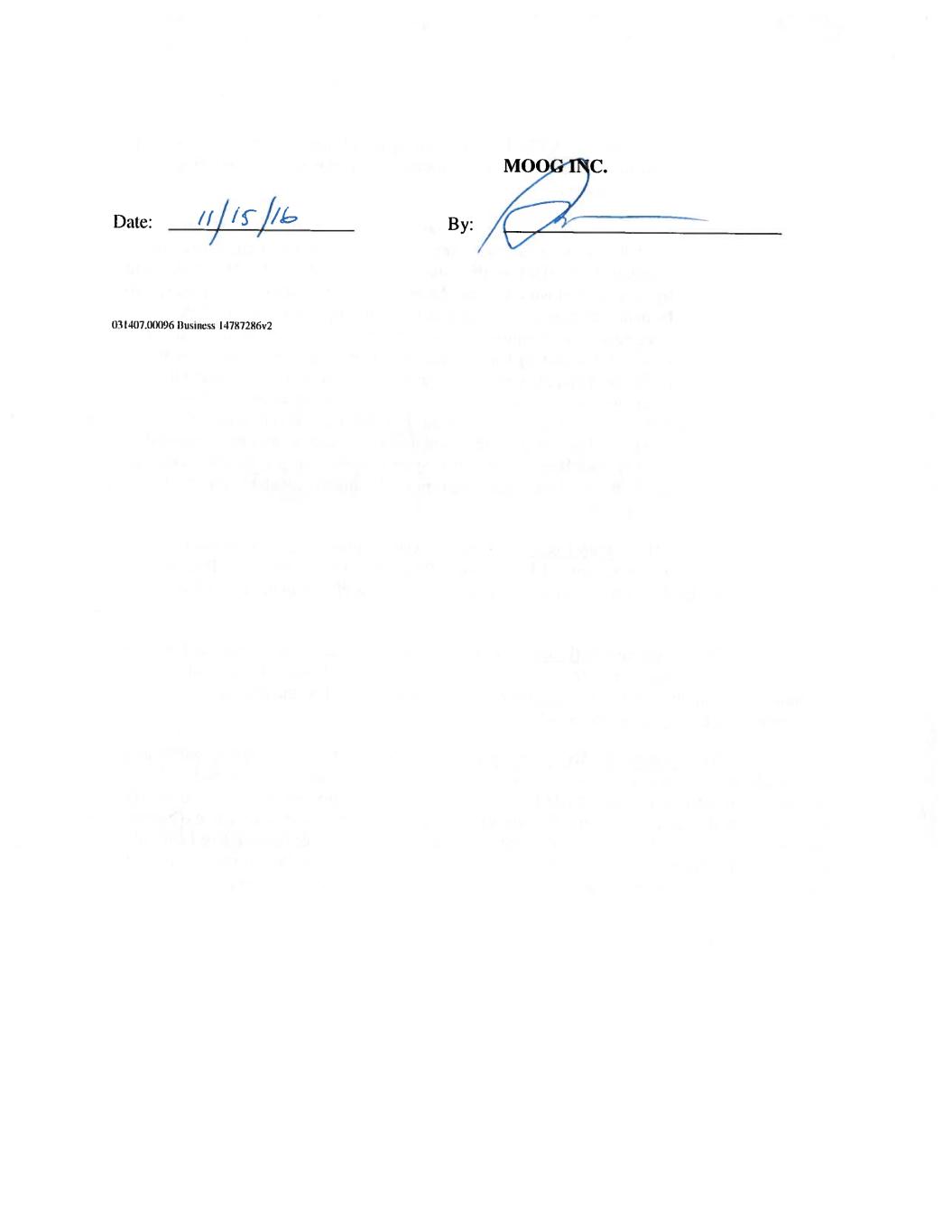
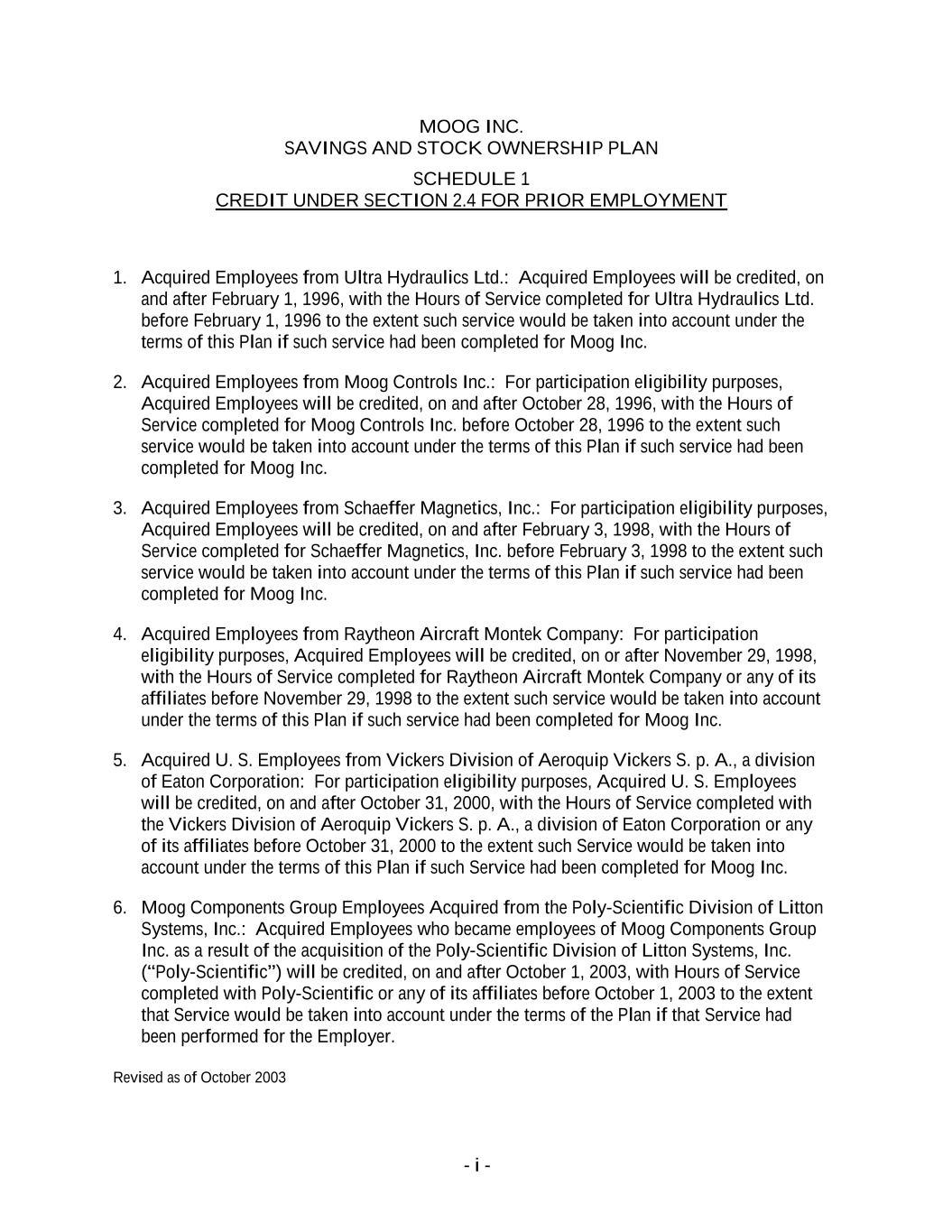
MOOG INC. SAVINGS AND STOCK OWNERSHIP PLAN SCHEDULE 1 CREDIT UNDER SECTION 2.4 FOR PRIOR EMPLOYMENT 1. Acquired Employees from Ultra Hydraulics Ltd.: Acquired Employees will be credited, on and after February 1, 1996, with the Hours of Service completed for Ultra Hydraulics Ltd. before February 1, 1996 to the extent such service would be taken into account under the terms of this Plan if such service had been completed for Moog Inc. 2. Acquired Employees from Moog Controls Inc.: For participation eligibility purposes, Acquired Employees will be credited, on and after October 28, 1996, with the Hours of Service completed for Moog Controls Inc. before October 28, 1996 to the extent such service would be taken into account under the terms of this Plan if such service had been completed for Moog Inc. 3. Acquired Employees from Schaeffer Magnetics, Inc.: For participation eligibility purposes, Acquired Employees will be credited, on and after February 3, 1998, with the Hours of Service completed for Schaeffer Magnetics, Inc. before February 3, 1998 to the extent such service would be taken into account under the terms of this Plan if such service had been completed for Moog Inc. 4. Acquired Employees from Raytheon Aircraft Montek Company: For participation eligibility purposes, Acquired Employees will be credited, on or after November 29, 1998, with the Hours of Service completed for Raytheon Aircraft Montek Company or any of its affiliates before November 29, 1998 to the extent such service would be taken into account under the terms of this Plan if such service had been completed for Moog Inc. 5. Acquired U. S. Employees from Vickers Division of Aeroquip Vickers S. p. A., a division of Eaton Corporation: For participation eligibility purposes, Acquired U. S. Employees will be credited, on and after October 31, 2000, with the Hours of Service completed with the Vickers Division of Aeroquip Vickers S. p. A., a division of Eaton Corporation or any of its affiliates before October 31, 2000 to the extent such Service would be taken into account under the terms of this Plan if such Service had been completed for Moog Inc. 6. Moog Components Group Employees Acquired from the Poly-Scientific Division of Litton Systems, Inc.: Acquired Employees who became employees of Moog Components Group Inc. as a result of the acquisition of the Poly-Scientific Division of Litton Systems, Inc. (“Poly-Scientific”) will be credited, on and after October 1, 2003, with Hours of Service completed with Poly-Scientific or any of its affiliates before October 1, 2003 to the extent that Service would be taken into account under the terms of the Plan if that Service had been performed for the Employer. Revised as of October 2003 - i -